Grandstream Networks UCM6208 IP PBX User Manual 1 UCM62xx usermanual ok
Grandstream Networks, Inc. IP PBX 1 UCM62xx usermanual ok
Contents
- 1. Users Manual Part One
- 2. Users Manual Part Two
Users Manual Part One
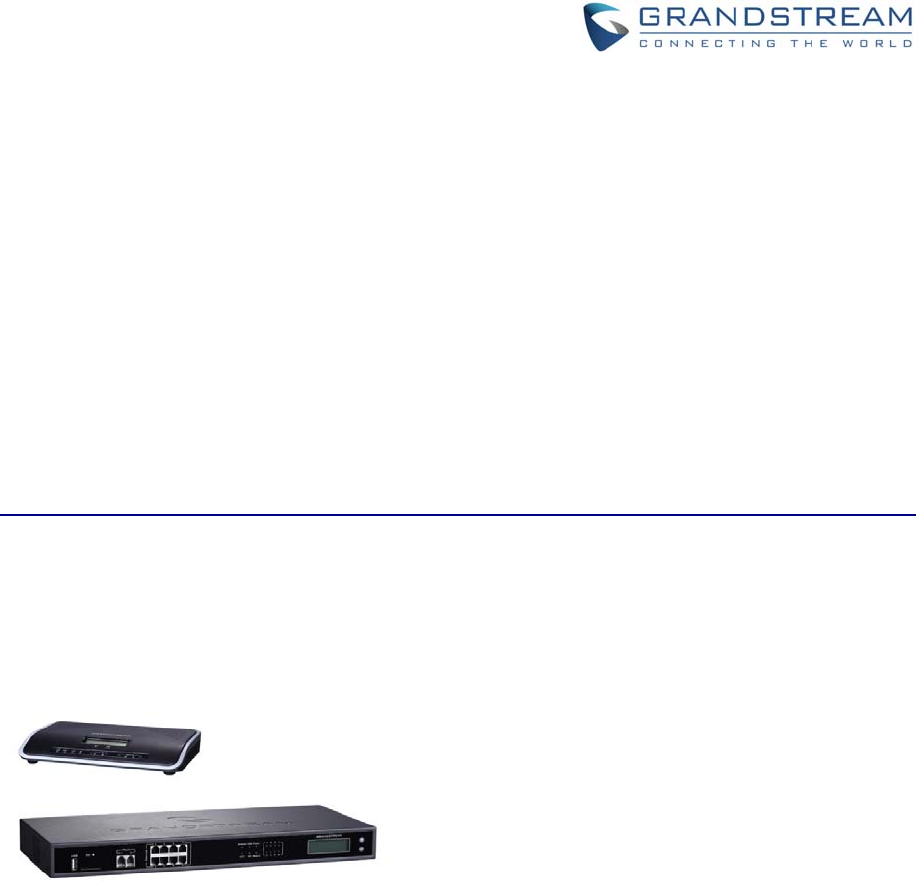
Grandstream Networks, Inc.
UCM6200 Series IP PBX
User Manual

Firmware Version 1.0.0.1 UCM6200 Series IP PBX User Manual Page 1 of 320
UCM6200 Series IP PBX User Manual
Table of Content
GNU GPL INFORMATION ......................................................................... 17
CHANGE LOG ........................................................................................... 18
FIRMWARE VERSION 1.0.0.1 ............................................................................................................ 18
WELCOME ................................................................................................ 19
PRODUCT OVERVIEW ............................................................................. 21
TECHNICAL SPECIFICATIONS ......................................................................................................... 21
INSTALLATION ......................................................................................... 25
EQUIPMENT PACKAGING ................................................................................................................. 25
CONNECT YOUR UCM6200 .............................................................................................................. 25
CONNECT THE UCM6202 ........................................................................................................... 25
CONNECT THE UCM6204 ........................................................................................................... 26
CONNECT THE UCM6208 ........................................................................................................... 27
SAFETY COMPLIANCES ................................................................................................................... 28
WARRANTY ........................................................................................................................................ 28
GETTING STARTED ................................................................................. 30
USE THE LCD MENU ......................................................................................................................... 30
USE THE LED INDICATORS .............................................................................................................. 32
USE THE WEB GUI ............................................................................................................................ 33
ACCESS WEB GUI ...................................................................................................................... 33
SETUP WIZARD ........................................................................................................................... 35
WEB GUI CONFIGURATIONS ..................................................................................................... 36
WEB GUI LANGUAGES ............................................................................................................... 36
SAVE AND APPLY CHANGES ..................................................................................................... 37
MAKE YOUR FIRST CALL .................................................................................................................. 37
SYSTEM SETTINGS ................................................................................. 38
USER MANAGEMENT ........................................................................................................................ 38
USER PRIVILEGES ..................................................................................................................... 38
CREATE NEW WEB UI USER ..................................................................................................... 39
USER PORTAL ............................................................................................................................. 41
CONCURRENT MULTI-USER LOGIN ......................................................................................... 42

Firmware Version 1.0.0.1 UCM6200 Series IP PBX User Manual Page 2 of 320
OPERATION LOG ........................................................................................................................ 42
CHANGE PASSWORD ....................................................................................................................... 44
CHANGE BINDNG EMAIL ........................................................................................................... 45
NETWORK SETTINGS ....................................................................................................................... 46
BASIC SETTINGS ........................................................................................................................ 46
802.1X .......................................................................................................................................... 51
STATIC ROUTES ......................................................................................................................... 52
PORT FORWORDING ................................................................................................................. 55
DDNS SETTINGS ......................................................................................................................... 57
FIREWALL ........................................................................................................................................... 59
STATIC DEFENSE ....................................................................................................................... 59
DYNAMIC DEFENSE ................................................................................................................... 62
FAIL2BAN ..................................................................................................................................... 63
LDAP SERVER .................................................................................................................................... 64
LDAP SERVER CONFIGURATIONS ........................................................................................... 65
LDAP PHONEBOOK .................................................................................................................... 66
LDAP CLIENT CONFIGURATIONS ............................................................................................. 69
HTTP SERVER .................................................................................................................................... 71
EMAIL SETTINGS ............................................................................................................................... 72
TIME SETTINGS ................................................................................................................................. 73
AUTO TIME UPDATING ............................................................................................................... 73
SET TIME MANUALLY ................................................................................................................. 75
OFFICE TIME ............................................................................................................................... 75
HOLIDAY ...................................................................................................................................... 77
NTP SERVER ...................................................................................................................................... 79
RECORDINGS STORAGE .................................................................................................................. 79
LOGIN TIMEOUT SETTINGS ............................................................................................................. 81
GOOGLE SERVICE SETTINGS SUPPORT ....................................................................................... 82
PROVISIONING ......................................................................................... 86
OVERVIEW ......................................................................................................................................... 86
CONFIGURATION ARCHITECTURE FOR END POINT DEVICE ...................................................... 86
AUTO PROVISIONING SETTINGS .................................................................................................... 87
DISCOVERY ........................................................................................................................................ 90
GLOBAL CONFIGURATION ............................................................................................................... 91
GLOBAL POLICY ......................................................................................................................... 91
GLOBAL TEMPLATES ................................................................................................................. 99
MODEL CONFIGURATION ............................................................................................................... 101
MODEL TEMPLATES ................................................................................................................. 101
MODEL UPDATE ........................................................................................................................ 103
DEVICE CONFIGURATION .............................................................................................................. 104

Firmware Version 1.0.0.1 UCM6200 Series IP PBX User Manual Page 3 of 320
CREATE NEW DEVICE .............................................................................................................. 104
MANAGE DEVICES ................................................................................................................... 105
SAMPLE APPLICATION .................................................................................................................... 112
EXTENSIONS .......................................................................................... 118
CREATE NEW USER ........................................................................................................................ 118
CREATE NEW SIP EXTENSION ............................................................................................... 118
CREATE NEW IAX EXTENSION ............................................................................................... 124
CREATE NEW FXS EXTENSION .............................................................................................. 128
BATCH ADD EXTENSIONS .............................................................................................................. 133
BATCH ADD SIP EXTENSIONS ................................................................................................ 133
BATCH ADD IAX EXTENSIONS ................................................................................................ 136
SEARCH AND EDIT EXTENSION .................................................................................................... 138
EXPORT EXTENSIONS .................................................................................................................... 140
IMPORT EXTENSIONS..................................................................................................................... 140
EMAIL TO USER ............................................................................................................................... 141
MULTIPLE REGISTRATIONS PER EXTENSION ............................................................................. 143
SMS MESSAGE SUPPORT .............................................................................................................. 144
TRUNKS .................................................................................................. 146
ANALOG TRUNKS ............................................................................................................................ 146
ANALOG TRUNK CONFIGURATION ........................................................................................ 146
PSTN DETECTION .................................................................................................................... 149
VOIP TRUNKS .................................................................................................................................. 152
DIRECT OUTWARD DIALING (DOD) ........................................................................................ 163
SLA STATION .......................................................................................... 166
CREATE/EDIT SLA STATION ........................................................................................................... 166
SAMPLE CONFIGURATION ............................................................................................................. 167
CALL ROUTES ........................................................................................ 170
OUTBOUND ROUTES ...................................................................................................................... 170
INBOUND ROUTES .......................................................................................................................... 172
INBOUND RULE CONFIGURATIONS ....................................................................................... 173
INBOUND ROUTE: PREPEND EXAMPLE ................................................................................ 174
INBOUND ROUTE: MULTIPLE MODE ...................................................................................... 175
FAX INTELLIGENT ROUTE ....................................................................................................... 176
FAX WITH TWO MEDIA ............................................................................................................. 177
BLACKLIST CONFIGURATIONS ............................................................................................... 177
CONFERENCE BRIDGE ......................................................................... 180

Firmware Version 1.0.0.1 UCM6200 Series IP PBX User Manual Page 4 of 320
CONFERENCE BRIDGE CONFIGURATIONS .......................................................................... 180
JOIN A CONFERENCE CALL .................................................................................................... 182
INVITE OTHER PARTIES TO JOIN CONFERENCE ................................................................. 182
DURING THE CONFERENCE ................................................................................................... 183
RECORD CONFERENCE .......................................................................................................... 184
CONFERENCE SCHEDULE ................................................................... 186
CONFERENCE SCHEUDLE CONFIGURATION .............................................................................. 186
IVR ........................................................................................................... 190
CONFIGURE IVR .............................................................................................................................. 190
CREATE CUSTOM PROMPT ........................................................................................................... 192
RECORD NEW CUSTOM PROMPT .......................................................................................... 192
UPLOAD CUSTOM PROMPT .................................................................................................... 193
LANGUAGE SETTINGS FOR VOICE PROMPT .................................... 194
DOWNLOAD AND INSTALL VOICE PROMPT PACKAGE ............................................................... 194
CUSTOMIZE SPECIFIC PROMPT ................................................................................................... 196
VOICEMAIL ............................................................................................. 198
CONFIGURE VOICEMAIL ................................................................................................................ 198
ACCESS VOICEMAIL ....................................................................................................................... 199
VOICEMAIL EMAIL SETTINGS ........................................................................................................ 200
CONFIGURE VOICEMAIL GROUP .................................................................................................. 201
RING GROUP .......................................................................................... 204
CONFIGURE RING GROUP ............................................................................................................. 204
REMOTE EXTENSION IN RING GROUP ........................................................................................ 206
PAGING AND INTERCOM GROUP ........................................................ 210
CONFIGURE PAGING/INTERCOM GROUP .................................................................................... 210
CALL QUEUE .......................................................................................... 212
CONFIGURE CALL QUEUE ............................................................................................................. 212
EXTENSION GROUPS ............................................................................ 216
CONFIGURE EXTENSION GROUPS .............................................................................................. 216
USING EXTENSION GROUPS ......................................................................................................... 217
PICKUP GROUPS ................................................................................... 218
CONFIGURE PICKUP GROUPS ...................................................................................................... 218

Firmware Version 1.0.0.1 UCM6200 Series IP PBX User Manual Page 5 of 320
CONFIGURE PICKUP FEATURE CODE .......................................................................................... 218
MUSIC ON HOLD .................................................................................... 220
FAX/T.38 .................................................................................................. 222
CONFIGURE FAX/T.38 ..................................................................................................................... 222
SAMPLE CONFIGURATION TO RECEIVE FAX FROM PSTN LINE ............................................... 223
SAMPLE CONFIGURATION FOR FAX-TO-EMAIL .......................................................................... 226
ASTERISK MANAGER INTERFACE (RESTRICTED ACCESS) ............ 228
BUSY CAMP-ON ..................................................................................... 230
FOLLOW ME ........................................................................................... 232
ONE-KEY DIAL ....................................................................................... 236
DISA ........................................................................................................ 238
CALLBACK FEATURE ........................................................................... 240
BLF AND EVENT LIST ............................................................................ 242
BLF .................................................................................................................................................... 242
EVENT LIST ...................................................................................................................................... 242
DIAL BY NAME ....................................................................................... 246
DIAL BY NAME CONFIGURATION................................................................................................... 246
ACTIVE CALLS AND MONITOR ............................................................ 250
ACTIVE CALLS STATUS .................................................................................................................. 250
HANG UP ACTIVE CALLS ................................................................................................................ 251
CALL MONITOR ................................................................................................................................ 251
CALL FEATURES ................................................................................... 254
FEATURE CODES ............................................................................................................................ 254
CALL RECORDING ........................................................................................................................... 258
CALL PARK ....................................................................................................................................... 259
PARK A CALL ............................................................................................................................. 259
RETRIEVE THE PARKED CALL ................................................................................................ 259
ENABLE SPY .................................................................................................................................... 259
INTERNAL OPTIONS .............................................................................. 262

Firmware Version 1.0.0.1 UCM6200 Series IP PBX User Manual Page 6 of 320
INTERNAL OPTIONS/GENERAL ..................................................................................................... 262
INTERNAL OPTIONS/JITTER BUFFER ........................................................................................... 264
INTERNAL OPTIONS/RTP SETTINGS ............................................................................................ 265
INTERNAL OPTIONS/PAYLOAD ...................................................................................................... 265
IAX SETTINGS ........................................................................................ 268
IAX SETTINGS/GENERAL................................................................................................................ 268
IAX SETTINGS/REGISTRATION ...................................................................................................... 268
IAX SETTINGS/STATIC DEFENSE .................................................................................................. 269
SIP SETTINGS ........................................................................................ 270
SIP SETTINGS/GENERAL ................................................................................................................ 270
SIP SETTINGS/MISC ........................................................................................................................ 270
SIP SETTINGS/SESSION TIMER ..................................................................................................... 271
SIP SETTINGS/TCP AND TLS .......................................................................................................... 271
SIP SETTINGS/NAT .......................................................................................................................... 272
SIP SETTINGS/TOS.......................................................................................................................... 273
PORTS CONFIG ...................................................................................... 276
VALUE-ADDED FEATURES ................................................................... 278
FAX SENDING .................................................................................................................................. 278
ANNOUNCEMENTS CENTER.......................................................................................................... 278
ANNOUNCEMENTS CENTER SETTINGS ............................................................................... 279
GROUP SETTINGS .................................................................................................................... 279
STATUS AND REPORTING .................................................................... 282
PBX STATUS ..................................................................................................................................... 282
TRUNKS ..................................................................................................................................... 282
EXTENSIONS ............................................................................................................................. 283
QUEUES ..................................................................................................................................... 284
CONFERENCE ROOMS ............................................................................................................ 285
INTERFACES STATUS .............................................................................................................. 286
PARKING LOT ............................................................................................................................ 287
SYSTEM STATUS ............................................................................................................................. 288
GENERAL ................................................................................................................................... 288
NETWORK ................................................................................................................................. 289
STORAGE USAGE ..................................................................................................................... 289
RESOURCE USAGE .................................................................................................................. 290
SYSTEM EVENTS ............................................................................................................................ 291
ALERT EVENTS LIST ................................................................................................................ 291

Firmware Version 1.0.0.1 UCM6200 Series IP PBX User Manual Page 7 of 320
ALERT LOG ................................................................................................................................ 293
ALERT CONTACT ...................................................................................................................... 294
CDR ................................................................................................................................................... 294
CDR IMPROVEMENT ................................................................................................................ 297
DOWNLOADED CDR FILE ........................................................................................................ 298
STATISTICS ................................................................................................................................ 300
RECORDING FILES ................................................................................................................... 300
API CONFIGURATION ............................................................................................................... 301
UPGRADING AND MAINTENANCE ....................................................... 304
UPGRADING ..................................................................................................................................... 304
UPGRADING VIA NETWORK .................................................................................................... 304
UPGRADING VIA LOCAL UPLOAD ........................................................................................... 305
NO LOCAL FIRMWARE SERVERS ........................................................................................... 307
BACKUP ............................................................................................................................................ 307
BACKUP/RESTORE ................................................................................................................... 307
DATA SYNC ................................................................................................................................ 310
RESTORE CONFIGURATION FROM BACKUP FILE ............................................................... 311
CLEANER .......................................................................................................................................... 312
RESET AND REBOOT ...................................................................................................................... 313
SYSLOG ............................................................................................................................................ 314
TROUBLESHOOTING ...................................................................................................................... 314
ETHERNET CAPTURE .............................................................................................................. 314
IP PING ....................................................................................................................................... 315
TRACEROUTE ........................................................................................................................... 316
ANALOG RECORD TRACE ....................................................................................................... 316
SERVICE CHECK ...................................................................................................................... 317
NETWORK STATUS ................................................................................................................... 317
REMOTE ACCESS ............................................................................................................................ 318
SSH ACCESS ............................................................................................................................. 318
EXPERIENCING THE UCM6200 SERIES IP PBX .................................. 320

Firmware Version 1.0.0.1 UCM6200 Series IP PBX User Manual Page 8 of 320
Table of Tables
UCM6200 Series IP PBX User Manual
Table 1: Technical Specifications ................................................................................................................ 21
Table 2: UCM6202/UCM6204 Equipment Packaging ................................................................................. 25
Table 3: LCD Menu Options ........................................................................................................................ 31
Table 4: UCM6202/UCM6204 LED INDICATORS ...................................................................................... 32
Table 5: UCM6208 LED INDICATORS ....................................................................................................... 33
Table 6: User Management->Create New User .......................................................................................... 40
Table 7: Operation Log Column Header ..................................................................................................... 43
Table 8: Change Binding Email option ........................................................................................................ 46
Table 9: UCM6202/UCM6204 Network Settings->Basic Settings .............................................................. 46
Table 10: UCM6208 Network Settings->Basic Settings .............................................................................. 48
Table 11: UCM6200 Network Settings->802.1X ......................................................................................... 52
Table 12: UCM6200 Network Settings->Static Routes ............................................................................... 53
Table 13: UCM6202/UCM6204 Network Settings->Port Forwarding .......................................................... 55
Table 14: UCM6200 Firewall->Static Defense->Current Service ................................................................ 60
Table 15: Typical Firewall Settings .............................................................................................................. 60
Table 16: Firewall Rule Settings .................................................................................................................. 61
Table 17: UCM6200 Firewall Dynamic Defense ......................................................................................... 62
Table 18: Fail2Ban Settings ........................................................................................................................ 63
Table 19: HTTP Server Settings .................................................................................................................. 72
Table 20: Email Settings .............................................................................................................................. 72
Table 21: Time Auto Updating ..................................................................................................................... 74
Table 22: Create New Office Time .............................................................................................................. 76
Table 23: Create New Holiday .................................................................................................................... 78
Table 24: Auto Provision Settings ............................................................................................................... 89
Table 25: Global Policy Parameters->Localization ..................................................................................... 92
Table 26: Global Policy Parameters->Phone Settings ................................................................................ 93
Table 27: Global Policy Parameters->Contact List ..................................................................................... 94
Table 28: Global Policy Parameters->Maintenance .................................................................................... 96
Table 29: Global Policy Parameters->Network Settings ............................................................................. 97
Table 30: Global Policy Parameters->Customization .................................................................................. 98
Table 31: Create New Template .................................................................................................................. 99
Table 32: Create New Model Template ..................................................................................................... 101
Table 33: SIP Extension Configuration Parameters->Basic Settings ....................................................... 119
Table 34: SIP Extension Configuration Parameters->Media ..................................................................... 120
Table 35: SIP Extension Configuration Parameters->Features ................................................................ 121
Table 36: SIP Extension Configuration Parameters->Specific Time ......................................................... 124
Table 37: IAX Extension Configuration Parameters->Basic Settings ....................................................... 124
Table 38: IAX Extension Configuration Parameters->Media .................................................................... 125

Firmware Version 1.0.0.1 UCM6200 Series IP PBX User Manual Page 9 of 320
Table 39: IAX Extension Configuration Parameters->Features ................................................................ 126
Table 40: IAX Extension Configuration Parameters->Specific Time ......................................................... 128
Table 41: FXS Extension Configuration Parameters->Basic Settings ...................................................... 129
Table 42: FXS Extension Configuration Parameters->Media ................................................................... 130
Table 43: FXS Extension Configuration Parameters->Features ............................................................... 131
Table 44: FXS Extension Configuration Parameters->Specific Time ........................................................ 133
Table 45: Batch Add SIP Extension Parameters ....................................................................................... 134
Table 46: Batch Add IAX Extension Parameters ....................................................................................... 136
Table 47: Analog Trunk Configuration Parameters ................................................................................... 146
Table 48: PSTN Detection for Analog Trunk ............................................................................................. 151
Table 49: Create New SIP Trunk ............................................................................................................... 153
Table 50: SIP Register Trunk Configuration Parameters .......................................................................... 154
Table 51: SIP Peer Trunk Configuration Parameters ................................................................................ 157
Table 52: Create New IAX Trunk ............................................................................................................... 160
Table 53: IAX Register Trunk Configuration Parameters .......................................................................... 160
Table 54: IAX Peer Trunk Configuration Parameters ................................................................................ 161
Table 55: SLA Station Configuration Parameters ...................................................................................... 166
Table 56: Outbound Route Configuration Parameters .............................................................................. 170
Table 57: Inbound Rule Configuration Parameters ................................................................................... 173
Table 58: Conference Bridge Configuration Parameters .......................................................................... 180
Table 59: Conference Caller IVR Menu .................................................................................................... 184
Table 60: Conference Schedule Parameters ............................................................................................ 186
Table 61: IVR Configuration Parameters .................................................................................................. 190
Table 62: Voicemail Settings ..................................................................................................................... 198
Table 63: Voicemail IVR Menu .................................................................................................................. 199
Table 64: Voicemail Email Settings ........................................................................................................... 200
Table 65: Voicemail Group Settings .......................................................................................................... 202
Table 66: Ring Group Parameters ............................................................................................................ 204
Table 67: Paging/Intercom Group Configuration Parameters ................................................................... 210
Table 68: Call Queue Configuration Parameters ...................................................................................... 212
Table 69: FAX/T.38 Settings ...................................................................................................................... 222
Table 70: Follow Me Settings .................................................................................................................... 233
Table 71: Follow Me Options ..................................................................................................................... 234
Table 72: DISA Settings ............................................................................................................................ 238
Table 73: Callback Configuration Parameters........................................................................................... 240
Table 74: Event List Settings ..................................................................................................................... 242
Table 75: UCM6200 Feature Codes ......................................................................................................... 254
Table 76: Internal Options/General ........................................................................................................... 262
Table 77: Internal Options/Jitter Buffer ...................................................................................................... 264
Table 78: Internal Options/RTP Settings ................................................................................................... 265
Table 79: Internal Options/Payload ........................................................................................................... 265

Firmware Version 1.0.0.1 UCM6200 Series IP PBX User Manual Page 10 of 320
Table 80: IAX Settings/General ................................................................................................................. 268
Table 81: IAX Settings/Registration .......................................................................................................... 268
Table 82: IAX Settings/Static Defense ...................................................................................................... 269
Table 83: SIP Settings/General ................................................................................................................. 270
Table 84: SIP Settings/Misc ...................................................................................................................... 270
Table 85: SIP Settings/Session Timer ....................................................................................................... 271
Table 86: SIP Settings/TCP and TLS ........................................................................................................ 271
Table 87: SIP Settings/NAT ....................................................................................................................... 272
Table 88: SIP Settings/ToS ........................................................................................................................ 273
Table 89: Internal Options/Ports Config .................................................................................................... 276
Table 90: Announcements Center Settings ............................................................................................... 279
Table 91: Group Settings ........................................................................................................................... 279
Table 92: Trunk Status ............................................................................................................................... 282
Table 93: Extension Status ........................................................................................................................ 284
Table 94: Agent Status .............................................................................................................................. 285
Table 95: Interface Status Indicators ......................................................................................................... 286
Table 96: Parking Lot Status ..................................................................................................................... 287
Table 97: System Status->General ........................................................................................................... 288
Table 98: System Status->Network ........................................................................................................... 289
Table 99: CDR Filter Criteria ..................................................................................................................... 295
Table 100: CDR Statistics Filter Criteria .................................................................................................... 300
Table 101: API Configuration Files ............................................................................................................ 301
Table 102: Network Upgrade Configuration .............................................................................................. 305
Table 103: Data Sync Configuration ......................................................................................................... 310
Table 104: Cleaner Configuration ............................................................................................................. 312

Firmware Version 1.0.0.1 UCM6200 Series IP PBX User Manual Page 11 of 320
Table of Figures
UCM6200 Series IP PBX User Manual
Figure 1: UCM6202 Front View ................................................................................................................... 25
Figure 2: UCM6202 Back View ................................................................................................................... 26
Figure 3: UCM6204 Front View ................................................................................................................... 26
Figure 4: UCM6204 Back View ................................................................................................................... 27
Figure 5: UCM6208 Front View ................................................................................................................... 28
Figure 6: UCM6208 Back View ................................................................................................................... 28
Figure 7: UCM6204 Web GUI Login Page .................................................................................................. 33
Figure 8: UCM6200 Setup Wizard .............................................................................................................. 35
Figure 9: UCM6200 Web GUI Language .................................................................................................... 36
Figure 10: User Management Page Display ............................................................................................... 38
Figure 11: Create New User ........................................................................................................................ 40
Figure 12: User Management – New Users ................................................................................................ 40
Figure 13: Edit User Information by Super Admin ...................................................................................... 41
Figure 14: User Portal Login ....................................................................................................................... 41
Figure 15: User Portal Layout ..................................................................................................................... 42
Figure 16: Multiple User Operation Error Prompt ....................................................................................... 42
Figure 17: Operation Logs .......................................................................................................................... 43
Figure 18: Operation Logs Filter ................................................................................................................. 44
Figure 19 : Change Password .................................................................................................................... 45
Figure 20: Change Binding Email ............................................................................................................... 45
Figure 21: UCM6200 Network Interface Method: Route ............................................................................. 49
Figure 22: UCM6200 Network Interface Method: Switch ............................................................................ 50
Figure 23: UCM6200 Network Interface Method: Dual ............................................................................... 51
Figure 24: UCM6200 Using 802.1X as Client ............................................................................................. 51
Figure 25: UCM6200 Using 802.1X EAP-MD5 ........................................................................................... 52
Figure 26: UCM6204 Static Route Sample ................................................................................................. 54
Figure 27: UCM6204 Static Route Configuration ........................................................................................ 54
Figure 28: UCM6202/UCM6204 Port Forwarding Configuration ................................................................ 56
Figure 29: GXP2160 Web Access Using UCM6202 Port Forwarding ........................................................ 57
Figure 30: Register Domain Name on noip.com ......................................................................................... 58
Figure 31: UCM6200 DDNS Setting ........................................................................................................... 58
Figure 32: Using Domain Name to Connect to UCM6200 .......................................................................... 59
Figure 33: Create New Firewall Rule .......................................................................................................... 61
Figure 34: Configure Dynamic Defense ...................................................................................................... 63
Figure 35: LDAP Server Configurations ...................................................................................................... 65
Figure 36: Default LDAP Phonebook DN .................................................................................................... 65
Figure 37: Default LDAP Phonebook Attributes .......................................................................................... 66
Figure 38: LDAP Server->LDAP Phonebook .............................................................................................. 66

Firmware Version 1.0.0.1 UCM6200 Series IP PBX User Manual Page 12 of 320
Figure 39: Add LDAP Phonebook ............................................................................................................... 67
Figure 40: Edit LDAP Phonebook ............................................................................................................... 67
Figure 41: Import Phonebook ..................................................................................................................... 68
Figure 42: Phonebook CSV File Format ..................................................................................................... 68
Figure 43: LDAP Phonebook After Import ................................................................................................... 69
Figure 44: Export Selected LDAP Phonebook ............................................................................................ 69
Figure 45: LDAP Client Configurations ....................................................................................................... 70
Figure 46: GXP2200 LDAP Phonebook Configuration ............................................................................... 71
Figure 47: UCM6200 Email Settings ........................................................................................................... 73
Figure 48: Set Time Manually ..................................................................................................................... 75
Figure 49: Create New Office Time ............................................................................................................. 76
Figure 50: Settings->Time Settings->Office Time ....................................................................................... 77
Figure 51: Create New Holiday ................................................................................................................... 77
Figure 52: Settings->Time Settings->Holiday ............................................................................................. 78
Figure 53: Settings->Recordings Storage ................................................................................................... 79
Figure 54: Recordings Storage Prompt Information ................................................................................... 80
Figure 55: Recording Storage Category ..................................................................................................... 80
Figure 56: Login Timeout Settings .............................................................................................................. 81
Figure 57: Google Service Settings->OAuth2.0 Authentication .................................................................. 82
Figure 58: Google Service->New Project ................................................................................................... 83
Figure 59: Google Service->Create New Credential .................................................................................. 83
Figure 60: Google Service->OAuth2.0 Login .............................................................................................. 84
Figure 61: Zero Config Configuration Architecture for End Point Device ................................................... 87
Figure 62: UCM6200 Zero Config ............................................................................................................... 88
Figure 63: Auto Provision Settings .............................................................................................................. 89
Figure 64: Auto Discover ............................................................................................................................. 91
Figure 65: Discovered Devices ................................................................................................................... 91
Figure 66: Global Policy Categories ........................................................................................................... 92
Figure 67: Edit Global Template ................................................................................................................ 100
Figure 68: Edit Model Template ................................................................................................................ 102
Figure 69: Template Management ............................................................................................................ 103
Figure 70: Upload Model Template Manually ............................................................................................ 104
Figure 71: Create New Device .................................................................................................................. 105
Figure 72: Manage Devices ...................................................................................................................... 105
Figure 73: Edit Device ............................................................................................................................... 106
Figure 74: Edit Customize Device Settings ............................................................................................... 108
Figure 75: Add P Value in Customize Device Settings ............................................................................. 109
Figure 76: Modify Selected Devices - Same Model .................................................................................. 110
Figure 77: Modify Selected Devices - Different Models ............................................................................ 111
Figure 78: Device List in Zero Config ........................................................................................................ 112
Figure 79: Zero Config Sample - Global Policy ......................................................................................... 113

Firmware Version 1.0.0.1 UCM6200 Series IP PBX User Manual Page 13 of 320
Figure 80: Zero Config Sample - Device Preview 1 .................................................................................. 114
Figure 81: Zero Config Sample - Device Preview 2 .................................................................................. 115
Figure 82: Zero Config Sample - Device Preview 3 .................................................................................. 116
Figure 83: Create New Device .................................................................................................................. 118
Figure 84: Manage Extensions ................................................................................................................. 139
Figure 85: Export Extensions .................................................................................................................... 140
Figure 86: Import Extensions .................................................................................................................... 140
Figure 87: Email To User - Prompt Information ......................................................................................... 141
Figure 88: Account Registration Information and QR Code ...................................................................... 142
Figure 89: LDAP Client Information and QR Code ................................................................................... 142
Figure 90: Multiple Registrations per Extension ....................................................................................... 143
Figure 91: Extension - Concurrent Registration ........................................................................................ 143
Figure 92: SMS Message Support ............................................................................................................ 144
Figure 93: UCM6200 FXO Tone Settings ................................................................................................. 149
Figure 94: UCM6200 PSTN Detection ...................................................................................................... 150
Figure 95: UCM6200 PSTN Detection: Auto Detect ................................................................................. 150
Figure 96: UCM6200 PSTN Detection: Semi-Auto Detect ....................................................................... 151
Figure 97: DOD extension selection ......................................................................................................... 163
Figure 98: Edit DOD .................................................................................................................................. 164
Figure 99: SLA Station .............................................................................................................................. 166
Figure 100: Enable SLA Mode for Analog Trunk ....................................................................................... 168
Figure 101: Analog Trunk with SLA Mode Enabled .................................................................................. 168
Figure 102: SLA Example - SLA Station ................................................................................................... 168
Figure 103: SLA Example - MPK Configuration ........................................................................................ 169
Figure 104: Inbound Route feature: Prepend ........................................................................................... 175
Figure 105: Inbound Route - Multiple Mode .............................................................................................. 176
Figure 106: Blacklist Configuration Parameters........................................................................................ 177
Figure 107: Blacklist csv File .................................................................................................................... 178
Figure 108: Conference Invitation From Web GUI .................................................................................... 182
Figure 109: Conference Recording ........................................................................................................... 185
Figure 110: Conference Schedule ............................................................................................................. 189
Figure 111: Click on Prompt to Create IVR Prompt .................................................................................. 192
Figure 112: Record New Custom Prompt ................................................................................................. 193
Figure 113: Upload Custom Prompt .......................................................................................................... 193
Figure 114: Language Settings for Voice Prompt ..................................................................................... 194
Figure 115: Voice Prompt Package List .................................................................................................... 195
Figure 116: New Voice Prompt Language Added ..................................................................................... 195
Figure 117: Upload Single Voice Prompt for Entire Language Pack ........................................................ 196
Figure 118: Voicemail Email Settings ........................................................................................................ 201
Figure 119: Voicemail Group ..................................................................................................................... 202
Figure 120: Ring Group ............................................................................................................................. 204

Firmware Version 1.0.0.1 UCM6200 Series IP PBX User Manual Page 14 of 320
Figure 121: Ring Group Configuration ...................................................................................................... 206
Figure 122: Sync LDAP Server option ...................................................................................................... 207
Figure 123: Manually Sync LDAP Server ................................................................................................. 207
Figure 124: Ring Group Remote Extension .............................................................................................. 208
Figure 125: Paging/Intercom Group .......................................................................................................... 210
Figure 126: Page/Intercom Group Settings .............................................................................................. 211
Figure 127: Call Queue ............................................................................................................................. 212
Figure 128: Agent Login Settings .............................................................................................................. 215
Figure 129: Edit Extension Group ............................................................................................................. 216
Figure 130: Select Extension Group in Outbound Route .......................................................................... 217
Figure 131: Edit Pickup Group .................................................................................................................. 218
Figure 132: Edit Pickup Feature Code ...................................................................................................... 219
Figure 133: Music On Hold Default Class ................................................................................................. 220
Figure 134: Configure Analog Trunk without Fax Detection ..................................................................... 224
Figure 135: Configure Extension for Fax Machine: FXS Extension ......................................................... 224
Figure 136: Configure Extension for Fax Machine: Analog Settings ........................................................ 225
Figure 137: Configure Inbound Rule for Fax ............................................................................................. 225
Figure 138: Create Fax Extension ............................................................................................................ 226
Figure 139: Inbound Route to Fax Extension ........................................................................................... 227
Figure 140: Create Follow Me ................................................................................................................... 232
Figure 141: Edit Follow Me ....................................................................................................................... 232
Figure 142: Configure One-Key Dial ......................................................................................................... 236
Figure 143: One-Key Dial Destinations ..................................................................................................... 237
Figure 144: Create New DISA .................................................................................................................. 238
Figure 145: Create New Event List ........................................................................................................... 243
Figure 146: Create Dial By Name Group .................................................................................................. 246
Figure 147: Dial By Name Group In IVR Key Pressing Events ................................................................ 247
Figure 148: Dial By Name Group In Inbound Rule ................................................................................... 248
Figure 149: Configure Extension First Name and Last Name .................................................................. 249
Figure 150: Status->PBX Status->Active Calls - Ringing .......................................................................... 250
Figure 151: Status->PBX Status->Active Calls – Call Established ........................................................... 250
Figure 152: Configure to Monitor an Active Call ....................................................................................... 251
Figure 153: Download Recording File from CDR Page ............................................................................ 258
Figure 154: Download Recording File from Recording Files Page ........................................................... 259
Figure 155: FXS Ports Signaling Preference ............................................................................................ 276
Figure 156: FXO Ports ACIM Settings ...................................................................................................... 276
Figure 157: Fax Sending in Web UI .......................................................................................................... 278
Figure 158: Announcements Center ......................................................................................................... 279
Figure 159: Announcements Center Group Configuration ........................................................................ 280
Figure 160: Announcements Center Code Configuration ......................................................................... 281
Figure 161: Announcements Center Example .......................................................................................... 281

Firmware Version 1.0.0.1 UCM6200 Series IP PBX User Manual Page 15 of 320
Figure 162: Status->PBX Status ............................................................................................................... 282
Figure 163: Trunk Status ........................................................................................................................... 282
Figure 164: Extension Status .................................................................................................................... 283
Figure 165: Queue Status ......................................................................................................................... 285
Figure 166: Conference Room Status ....................................................................................................... 286
Figure 167: UCM6204 Interfaces Status ................................................................................................... 286
Figure 168: Parking Lot Status .................................................................................................................. 287
Figure 169: System Status->Storage Usage ............................................................................................. 290
Figure 170: System Status->Resource Usage .......................................................................................... 290
Figure 171: System Events->Alert Events Lists: Disk Usage ................................................................... 291
Figure 172: System Events->Alert Events Lists: Memory Usage ............................................................. 292
Figure 173: System Events->Alert Events Lists: System Reboot ............................................................. 292
Figure 174: System Events->Alert Events Lists: System Crash ............................................................... 292
Figure 175: System Events->Alert Log ..................................................................................................... 293
Figure 176: Filter for Alert Log................................................................................................................... 294
Figure 177: CDR Filter .............................................................................................................................. 295
Figure 178: Call Report ............................................................................................................................. 296
Figure 179: Call Report Entry with Audio Recording File .......................................................................... 296
Figure 180: Automatic Download Settings ................................................................................................ 297
Figure 181: CDR Report ........................................................................................................................... 297
Figure 182: Detailed CDR Information ...................................................................................................... 298
Figure 183: Downloaded CDR File Sample - Call To Shows "s" .............................................................. 298
Figure 184: Downloaded CDR File Sample - Source Channel and Dest Channel 1 ................................ 299
Figure 185: Downloaded CDR File Sample - Source Channel and Dest Channel 2 ................................ 299
Figure 186: Downloaded CDR File Sample - Source Channel and Dest Channel 3 ................................ 299
Figure 187: CDR Statistics ........................................................................................................................ 300
Figure 188: CDR->Recording Files ........................................................................................................... 301
Figure 189: Network Upgrade ................................................................................................................... 304
Figure 190: Local Upgrade ........................................................................................................................ 305
Figure 191: Upgrading Firmware Files ...................................................................................................... 306
Figure 192: Reboot UCM6200 .................................................................................................................. 306
Figure 193: Create New Backup ............................................................................................................... 308
Figure 194: Backup / Restore ................................................................................................................... 309
Figure 195: Local Backup ......................................................................................................................... 309
Figure 196: Data Sync .............................................................................................................................. 310
Figure 197: Restore UCM6200 from Backup File ..................................................................................... 311
Figure 198: Cleaner .................................................................................................................................. 312
Figure 199: Reset and Reboot .................................................................................................................. 313
Figure 200: Ethernet Capture ................................................................................................................... 315
Figure 201: PING ...................................................................................................................................... 315
Figure 202: Traceroute .............................................................................................................................. 316

Firmware Version 1.0.0.1 UCM6200 Series IP PBX User Manual Page 16 of 320
Figure 203: Troubleshooting Analog Trunks ............................................................................................. 317
Figure 204: Service Check ........................................................................................................................ 317
Figure 205: Network Status ....................................................................................................................... 318
Figure 206: SSH Access ........................................................................................................................... 319

Firmware Version 1.0.0.1 UCM6200 Series IP PBX User Manual Page 17 of 320
GNUGPLINFORMATION
UCM6200 firmware contains third-party software licensed under the GNU General Public License (GPL).
Grandstream uses software under the specific terms of the GPL. Please see the GNU General Public
License (GPL) for the exact terms and conditions of the license.
Grandstream GNU GPL related source code can be downloaded from Grandstream web site from:
http://www.grandstream.com/support/faq/gnu-general-public-license/gnu-gpl-information-download

Firmware Version 1.0.0.1 UCM6200 Series IP PBX User Manual Page 18 of 320
CHANGELOG
This section documents significant changes from previous versions of the UCM6200 user manuals. Only
major new features or major document updates are listed here. Minor updates for corrections or editing are
not documented here.
FIRMWAREVERSION1.0.0.1
This is the initial version.
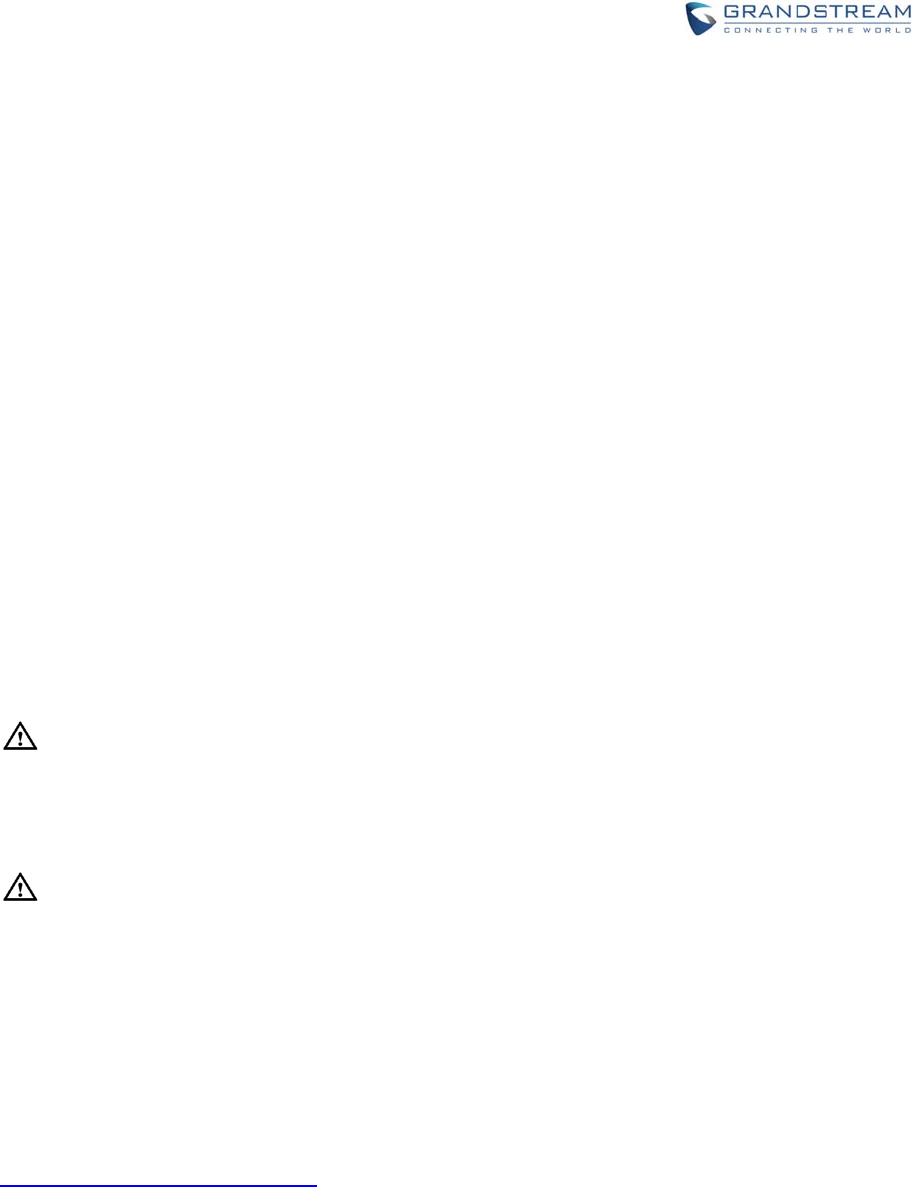
Firmware Version 1.0.0.1 UCM6200 Series IP PBX User Manual Page 19 of 320
WELCOME
Thank you for purchasing Grandstream UCM6200 series IP PBX appliance. The UCM6200 series IP PBX
appliance is designed to bring enterprise-grade voice, video, data, and mobility features to
small-to-medium businesses (SMBs) in an easy-to-manage fashion. This IP PBX series allows businesses
to unify multiple communication technologies, such comprehensive voice, video calling, video
conferencing, video surveillance, data tools and facility access management onto one common network
that that can be managed and/or accessed remotely. The UCM6200 series supports a dual core 1GHz
ARM CortexTM A9 and 400Mhz VINETICTM A8 processors, 1GB RAM and 4GB flash. The secure and
reliable UCM6200 series delivers enterprise-grade features without any licensing fees, costs-per-feature
or recurring fees.
--------------------------------------------------------------------------------------------------------------------------------------------
Caution:
Changes or modifications to this product not expressly approved by Grandstream, or operation of this
product in any way other than as detailed by this User Manual, could void your manufacturer warranty.
Warning:
Please do not use a different power adaptor with the UCM6200 as it may cause damage to the products
and void the manufacturer warranty.
--------------------------------------------------------------------------------------------------------------------------------------------
This document is subject to change without notice. The latest electronic version of this user manual is
available for download here:
http://www.grandstream.com/support
Reproduction or transmittal of the entire or any part, in any form or by any means, electronic or print, for
any purpose without the express written permission of Grandstream Networks, Inc. is not permitted.

Firmware Version 1.0.0.1 UCM6200 Series IP PBX User Manual Page 20 of 320
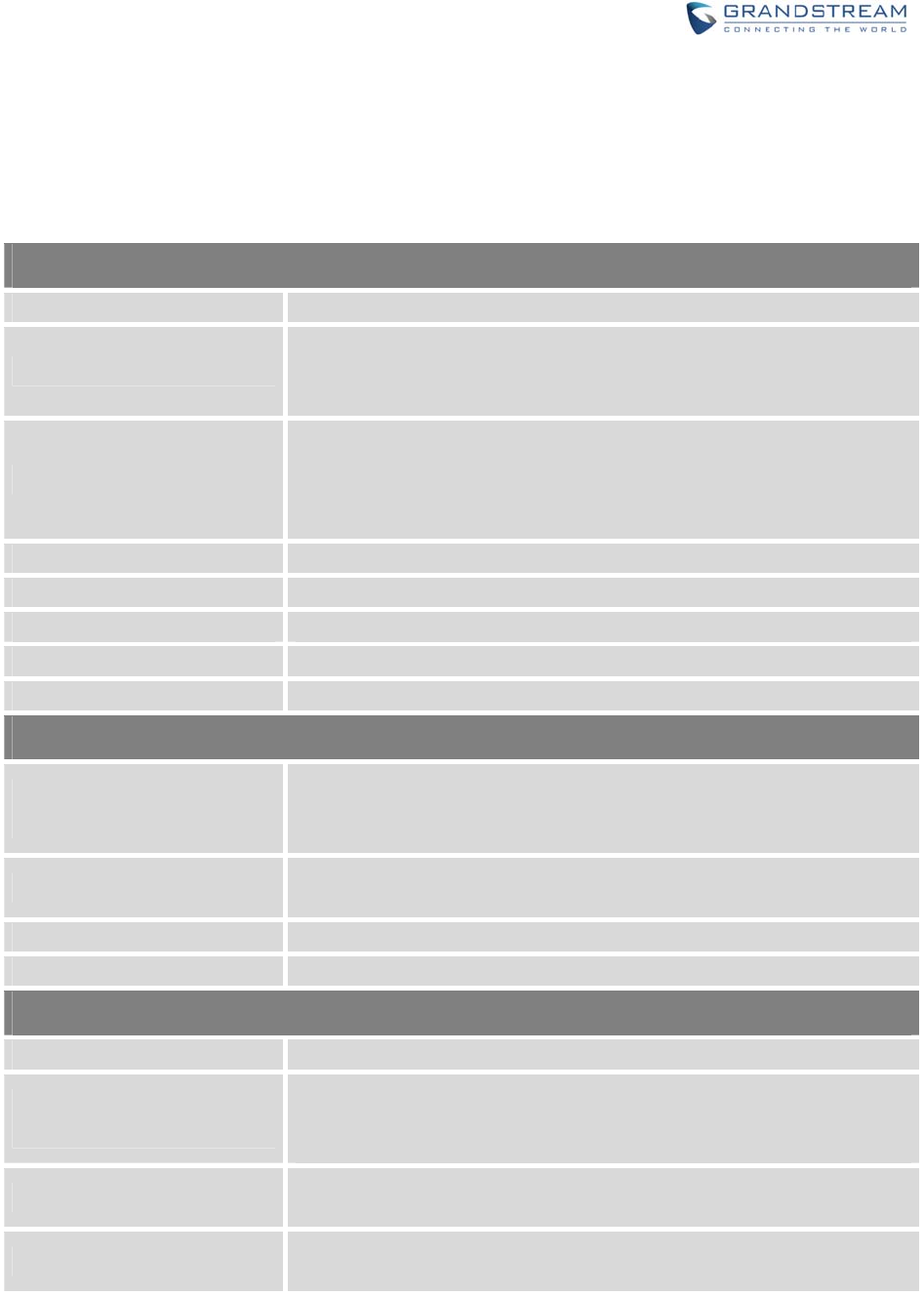
Firmware Version 1.0.0.1 UCM6200 Series IP PBX User Manual Page 21 of 320
PRODUCTOVERVIEW
TECHNICALSPECIFICATIONS
Table 1: Technical Specifications
Interfaces
Analog Telephone FXS Ports 2 ports (both with lifeline capability in case of power outage)
PSTN Line FXO Ports
UCM6202: 2 ports
UCM6204: 4 ports
UCM6208: 8 ports
Network Interfaces
UCM6202/6204: Dual Gigabit RJ45 ports with integrated PoE Plus
(IEEE 802.3at-2009)
UCM6208: Single Gigabit RJ45 port with integrated PoE Plus (IEEE
802.3at-2009)
NAT Router Yes, UCM6204/UCM6208 only
Peripheral Ports USB, SD
LED Indicators Power/Ready, Network, PSTN Line, USB, SD
LCD Display 128x32 graphic LCD with DOWN and OK button
Reset Switch Yes
Voice/Video Capabilities
Voice-over-Packet
Capabilities
LEC with NLP Packetized Voice Protocol Unit, 128ms-tail-length carrier
grade Line Echo Cancellation, Dynamic Jitter Buffer, Modem detection
and auto-switch to G.711
Voice and Fax Codecs G.711 A-law/U-law, G.722, G.723.1 5.3K/6.3K, G.726, G.729A/B, iLBC
(30ms only), GSM, AAL2-G.726-32, ADPCM; T.38
Video Codecs H.264, H.263, H.263+, VP8
QoS Layer 3 QoS, Layer 2 QoS
Signaling and Control
DTMF Methods In Audio, RFC2833, and SIP INFO
Provisioning Protocol and
Plug-and-Play
TFTP/HTTP/HTTPS, auto-discovery and auto-provisioning of
Grandstream IP endpoints via ZeroConfig (DHCP Option 66/multicast SIP
SUBSCRIBE/mDNS), eventlist between local and remote trunk
Network Protocols TCP/UDP/IP, RTP/RTCP, ICMP, ARP, DNS, DDNS, DHCP, NTP, TFTP,
SSH, HTTP/HTTPS, PPPoE, SIP (RFC3261), STUN, SRTP, TLS
Disconnect Methods Call Progress Tone, Polarity Reversal, Hook Flash Timing, Loop Current
Disconnect, Busy Tone
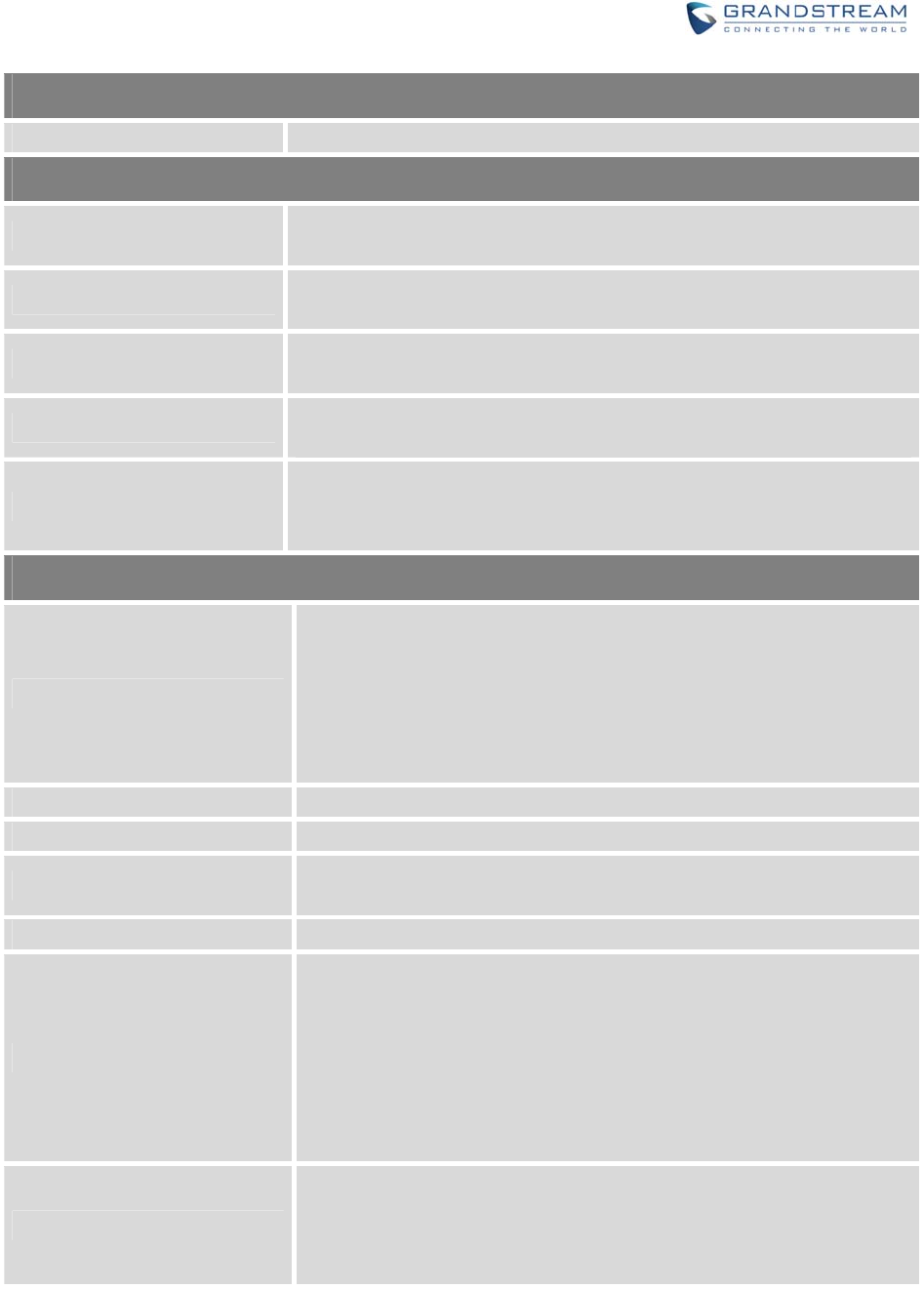
Firmware Version 1.0.0.1 UCM6200 Series IP PBX User Manual Page 22 of 320
Security
Media SRTP, TLS, HTTPS, SSH
Physical
Universal Power Supply Output: 12VDC, 1.5A
Input: 100-240VAC, 50-60Hz
Dimensions UCM6202/6204: 226mm (L) x 155mm (W) x 34.5mm (H)
UCM6208: 440mm (L) x 185mm (W) x 44mm (H)
Environmental Operating: 32 - 104oF / 0 - 40oC, 10-90% (non-condensing)
Storage: 14 - 140oF / -10 - 60oC
Mounting UCM6202/6204: Wall mount and Desktop
UCM6208: Rack mount and Desktop
Weight
UCM6202: Unit weight 0.51kg, Package weight 0.94kg
UCM6204: Unit weight 0.51kg, Package weight 0.94kg
UCM6208: Unit weight 2.23kg, Package weight 3.09kg
Additional Features
Multi-language Support
English/Simplified Chinese/Traditional Chinese/Spanish/French/
Portuguese/German/Russian/Italian/Polish/Czech for Web UI;
Customizable IVR/voice prompts for English, Chinese, British English,
German, Spanish, Greek, French, Italian, Dutch, Polish, Portuguese,
Russian, Swedish, Turkish, Hebrew, Arabic;
Customizable language pack to support any other languages
Caller ID Bellcore/Telcordia, ETSI-FSK, ETSI-DTMF, SIN 227 - BT
Polarity Reversal/ Wink Yes, with enable/disable option upon call establishment and termination
Call Center Multiple configurable call queues, automatic call distribution (ACD)
based on agent skills/availability busy level, in-queue announcement
Customizable Auto Attendant Up to 5 layers of IVR (Interactive Voice Response)
Maximum Call Capacity
UCM6202: Concurrent audio calls up to 50, concurrent WebRTC
calls up to 25
UCM6204: Concurrent audio calls up to 75, concurrent WebRTC
calls up to 35
UCM6208: Concurrent audio calls up to 100, concurrent WebRTC
calls up to 50
Or up to 66% performance if calls are SRTP encrypted
Conference Bridges
UCM6202/6204: Up to 3 password-protected conference bridges
allowing up to 25 simultaneous PSTN or IP participants
UCM6208: Up to 6 password-protected conference bridges allowing
up to 32 simultaneous PSTN or IP participants
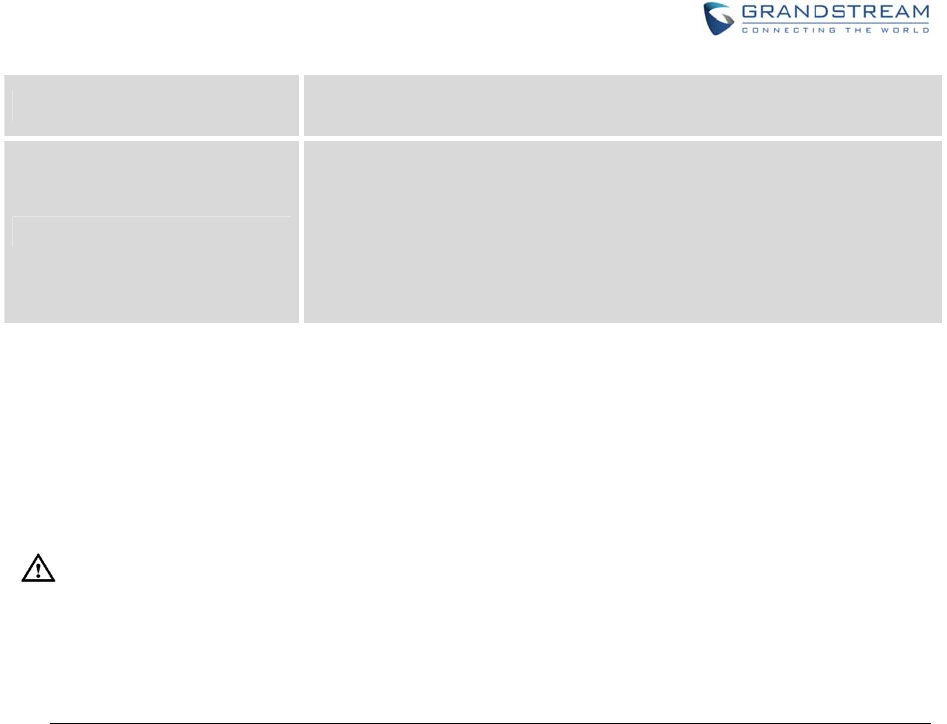
Firmware Version 1.0.0.1 UCM6200 Series IP PBX User Manual Page 23 of 320
Call Features Call park, call forward, call transfer, DND, ring/hunt group,
paging/intercom and etc
Compliance
FCC: Part 15 (CFR 47) Class B, Part 68
CE: EN55022 Class B, EN55024, EN61000-3-2, EN61000-3-3,
EN60950-1, TBR21, RoHS
A-TICK: AS/NZS CISPR 22 Class B, AS/NZS CISPR 24, AS/NZS
60950, AS/ACIF S002 and ITU-T K.21 (Basic Level)
UL 60950 (power adapter)
--------------------------------------------------------------------------------------------------------------------------------------------
Note:
UCM6200 FXS ports lifeline functionality:
The UCM6200 FXS interfaces are metallic through to the FXO interfaces. If there is power outage,
FXS1 port will fail over to FXO 1 port, FXS 2 port will fail over to FXO 2 port. The user can still access
the PSTN connected with the FXO interfaces from FXS interfaces.

Firmware Version 1.0.0.1 UCM6200 Series IP PBX User Manual Page 24 of 320
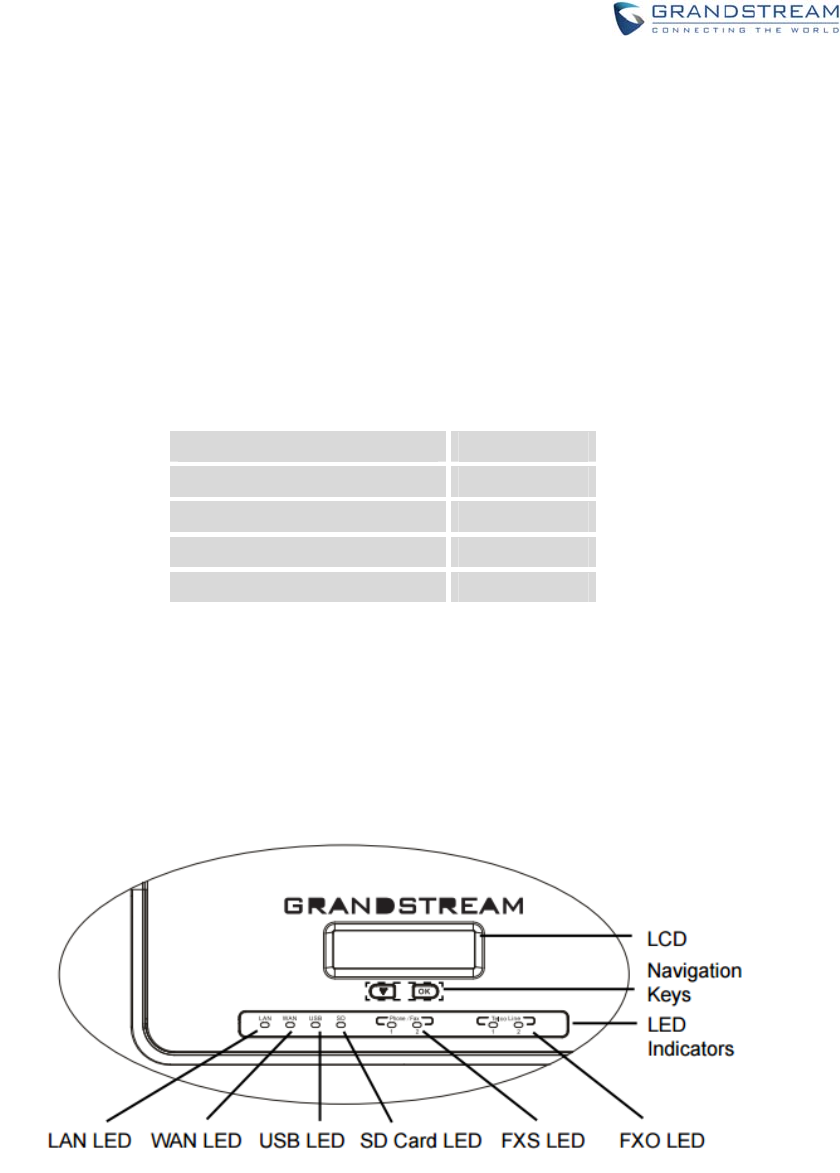
Firmware Version 1.0.0.1 UCM6200 Series IP PBX User Manual Page 25 of 320
INSTALLATION
Before deploying and configuring the UCM6200 series, the device needs to be properly powered up and
connected to network. This section describes detailed information on installation, connection and warranty
policy of the UCM6200 series.
EQUIPMENTPACKAGING
Table 2: UCM6202/UCM6204 Equipment Packaging
Main Case Yes (1)
Power Adaptor Yes (1)
Ethernet Cable Yes (1)
Quick Installation Guide Yes (1)
GPL License Yes (1)
CONNECTYOURUCM6200
CONNECTTHEUCM6202
Figure 1: UCM6202 Front View
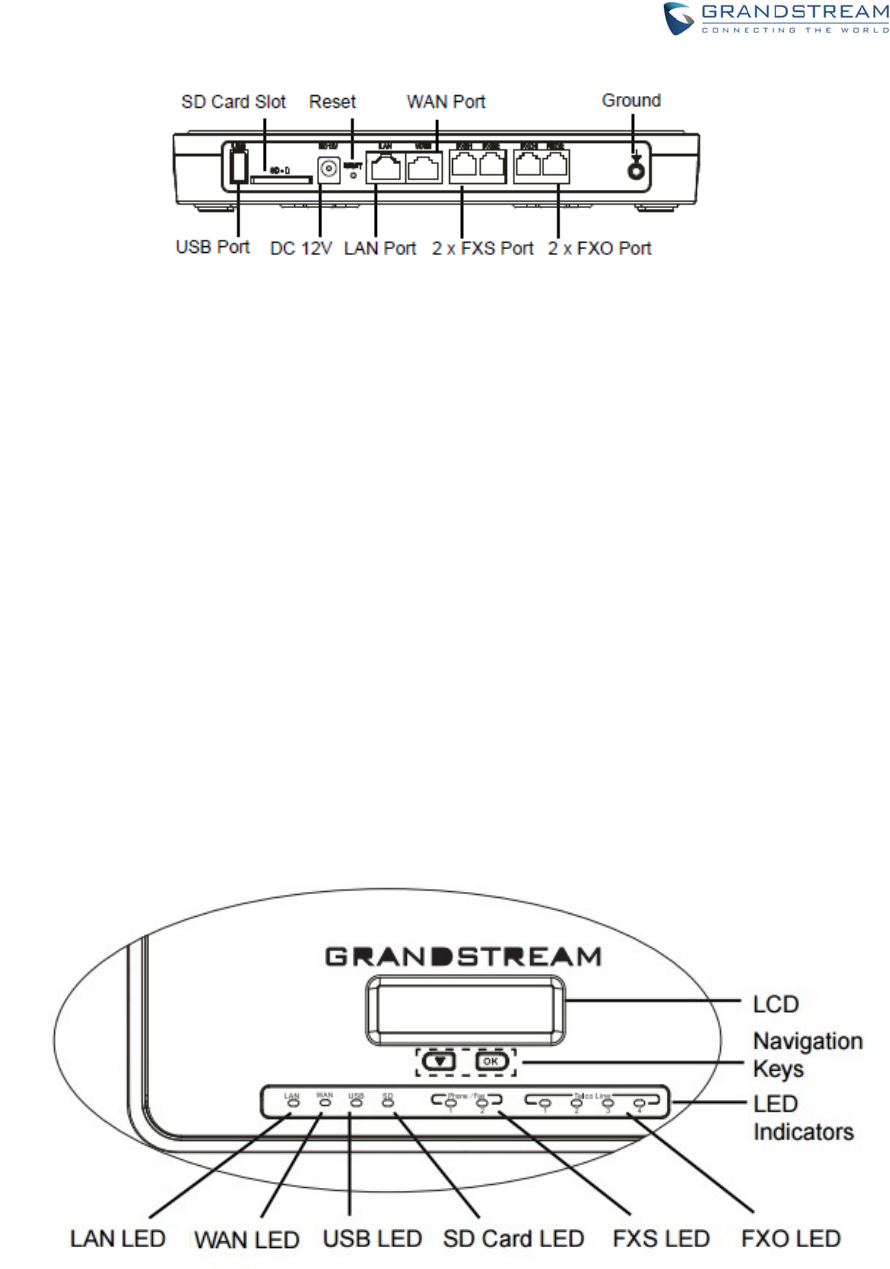
Firmware Version 1.0.0.1 UCM6200 Series IP PBX User Manual Page 26 of 320
Figure 2: UCM6202 Back View
To set up the UCM6202, follow the steps below:
1. Connect one end of an RJ-45 Ethernet cable into the WAN port of the UCM6202.
2. Connect the other end of the Ethernet cable into the uplink port of an Ethernet switch/hub.
3. Connect the 12V DC power adapter into the 12V DC power jack on the back of the UCM6202. Insert
the main plug of the power adapter into a surge-protected power outlet.
4. Wait for the UCM6202 to boot up. The LCD in the front will show the device hardware information
when the boot process is done.
5. Once the UCM6202 is successfully connected to network, the LED indicator for WAN in the front will
be in solid green and the LCD shows up the IP address.
6. (Optional) Connect PSTN lines from the wall jack to the FXO ports; connect analog lines (phone and
Fax) to the FXS ports.
CONNECTTHEUCM6204
Figure 3: UCM6204 Front View

Firmware Version 1.0.0.1 UCM6200 Series IP PBX User Manual Page 27 of 320
Figure 4: UCM6204 Back View
To set up the UCM6204, follow the steps below:
1. Connect one end of an RJ-45 Ethernet cable into the WAN port of the UCM6204.
2. Connect the other end of the Ethernet cable into the uplink port of an Ethernet switch/hub.
3. Connect the 12V DC power adapter into the 12V DC power jack on the back of the UCM6204.
Insert the main plug of the power adapter into a surge-protected power outlet.
4. Wait for the UCM6204 to boot up. The LCD in the front will show the device hardware information
when the boot process is done.
5. Once the UCM6204 is successfully connected to network, the LED indicator for WAN in the front
will be in solid green and the LCD shows up the IP address.
6. (Optional) Connect PSTN lines from the wall jack to the FXO ports; connect analog lines (phone
and Fax) to the FXS ports.
CONNECTTHEUCM6208
To set up the UCM6208, follow the steps below:
1. Connect one end of an RJ-45 Ethernet cable into the LAN port of the UCM6208.
2. Connect the other end of the Ethernet cable into the uplink port of an Ethernet switch/hub.
3. Connect the 12V DC power adapter into the 12V DC power jack on the back of the UCM6208. Insert
the main plug of the power adapter into a surge-protected power outlet.
4. Wait for the UCM6208 to boot up. The LCD in the front will show the device hardware information
when the boot process is done.
5. Once the UCM6208 is successfully connected to network, the LED indicator for NETWORK in the front
will be in solid green and the LCD shows up the IP address.
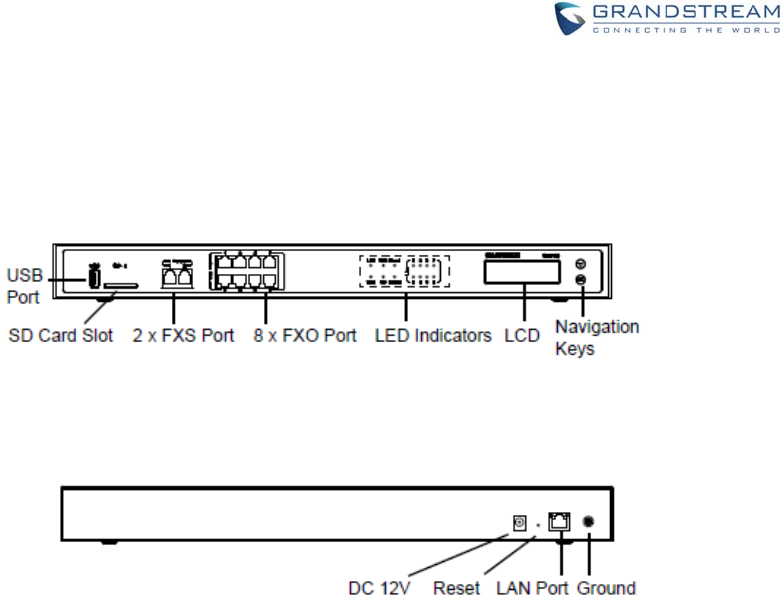
Firmware Version 1.0.0.1 UCM6200 Series IP PBX User Manual Page 28 of 320
6. (Optional) Connect PSTN lines from the wall jack to the FXO ports; connect analog lines (phone and
Fax) to the FXS ports.
Figure 5: UCM6208 Front View
Figure 6: UCM6208 Back View
SAFETYCOMPLIANCES
The UCM6200 series IP PBX complies with FCC/CE and various safety standards. The UCM6200 power
adapter is compliant with the UL standard. Use the universal power adapter provided with the UCM6200
package only. The manufacturer’s warranty does not cover damages to the device caused by unsupported
power adapters.
WARRANTY
If the UCM6200 series IP PBX was purchased from a reseller, please contact the company where the
device was purchased for replacement, repair or refund. If the device was purchased directly from
Grandstream, contact our Technical Support Team for a RMA (Return Materials Authorization) number
before the product is returned. Grandstream reserves the right to remedy warranty policy without prior
notification.
--------------------------------------------------------------------------------------------------------------------------------------------

Firmware Version 1.0.0.1 UCM6200 Series IP PBX User Manual Page 29 of 320
Warning:
Use the power adapter provided with the UCM6200 series IP PBX. Do not use a different power adapter as
this may damage the device. This type of damage is not covered under warranty.
--------------------------------------------------------------------------------------------------------------------------------------------

Firmware Version 1.0.0.1 UCM6200 Series IP PBX User Manual Page 30 of 320
GETTINGSTARTED
The UCM6200 series provides LCD interface, LED indication and web GUI configuration interface.
The LCD displays hardware, software and network information. Users could also navigate in the LCD
menu for device information and basic network configuration.
The LED indication at the front of the device provides interface connection and activity status.
The web GUI gives users access to all the configurations and options for UCM6200 series setup.
This section provides step-by-step instructions on how to use the LCD menu, LED indicators and Web GUI
of the UCM6200 series. Once the basic settings are done, users could start making calls from UCM6200
extension registered on a SIP phone as described at the end of this section.
USETHELCDMENU
Default LCD Display
When the device is powered up, the LCD will show device model (e.g., UCM6204), hardware version
(e.g., V1.0A) and IP address. Press "Down" button and the system time will be displayed as well.
Menu Access
Press "OK" button to start browsing menu options. Please see menu options in [Table 3: LCD Menu
Options].
Menu Navigation
Press the "Down" arrow key to browser different menu options. Press the "OK" button to select an
entry.
Exit
If "Back" option is available in the menu, select it to go back to the previous menu. For "Device Info"
"Network Info" and "Web Info" which do not have "Back" option, simply press the "OK" button to go
back to the previous menu. Also, the LCD will display default idle screen after staying in menu option
for 15 seconds.
LCD Backlight
The LCD backlight will be on upon key pressing. The backlight will go off after the LCD stays in idle for
30 seconds.

Firmware Version 1.0.0.1 UCM6200 Series IP PBX User Manual Page 31 of 320
Table 3: LCD Menu Options
View Events Critical Events
Other Events
Device Info
Hardware: Hardware version number
Software: Software version number
P/N: Part number
WAN MAC: WAN side MAC address (UCM6202/UCM6204 only)
LAN MAC: LAN side MAC address
Uptime: System up time
Network Info
For UCM6208:
LAN Mode: DHCP, Static IP, or PPPoE
LAN IP: IP address
LAN Subnet Mask
For UCM6202/UCM6204:
WAN Mode: DHCP, Static IP, or PPPoE
WAN IP: IP address
WAN Subnet Mask
LAN IP: IP address
LAN Subnet Mask
Network Menu
For UCM6208:
LAN Mode: Select LAN mode as DHCP, Static IP or PPPoE
Static Route Reset: Click to reset the static route setting
For UCM6202/UCM6204:
WAN Mode: Select WAN mode as DHCP, Static IP or PPPoE
Static Route Reset: Click to reset the static route setting
Factory Menu
Reboot
Factory Reset
LCD Test Patterns
Press "OK" to start. Then press "Down" button to test different LCD
patterns. When done, press "OK" button to exit.
Fan Mode
Select "Auto" or "On".
LED Test Patterns
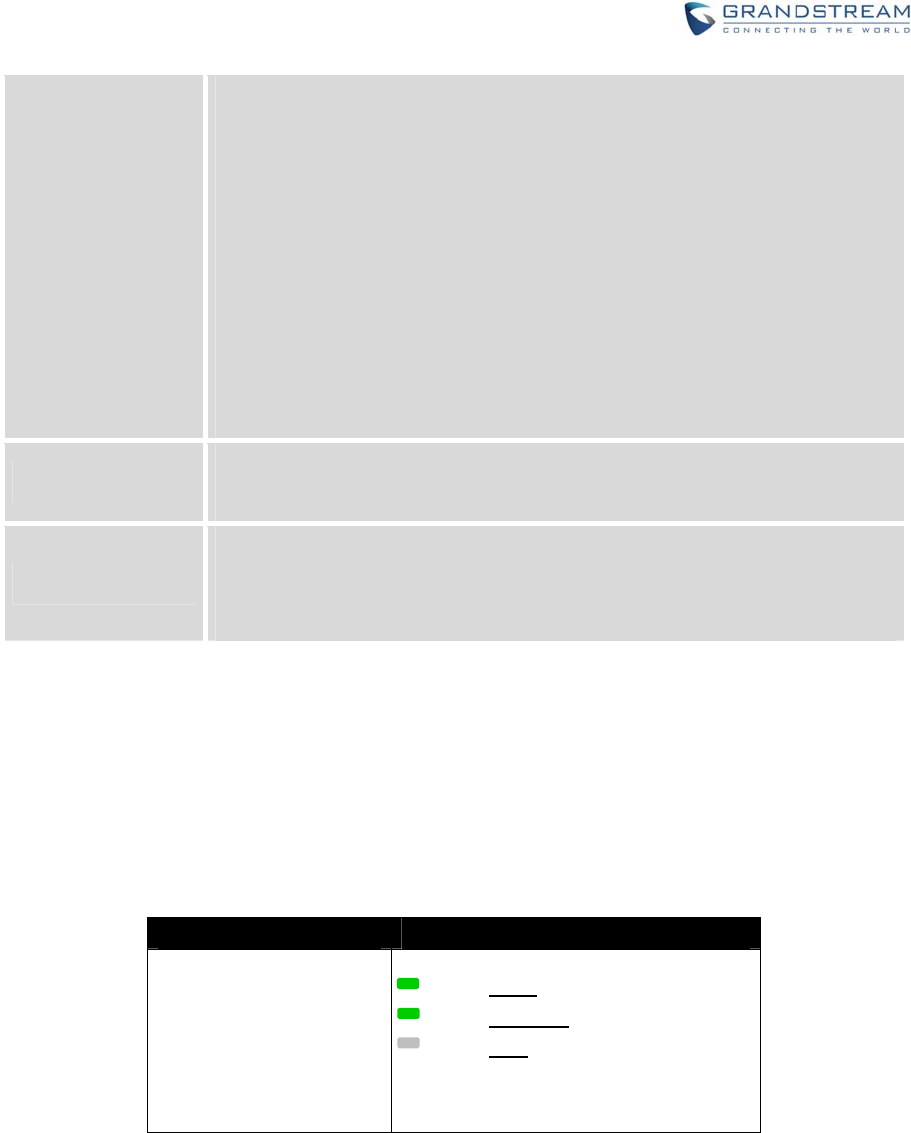
Firmware Version 1.0.0.1 UCM6200 Series IP PBX User Manual Page 32 of 320
Select "All On" "All Off" or "Blinking" and check LED status.
RTC Test Patterns
Select "2022-02-22 22:22" or "2011-01-11 11:11" to start the RTC
(Real-Time Clock) test pattern. Then check the system time from LCD idle
screen by pressing "DOWN" button, or from web GUI->System
Status->General page. Reboot the device manually after the RTC test is
done.
Hardware Testing
Select "Test SVIP" to perform SVIP test on the device. This is mainly for
factory testing purpose which verifies the hardware connection inside the
device. The diagnostic result will display in the LCD after the test is done.
Web Info Protocol: Web access protocol. HTTP or HTTPS. By default it's HTTPS
Port: Web access port number. By default it's 8089
SSH Switch
Enable SSH: Enable SSH access.
Disable SSH: Disable SSH access.
By default the SSH access is disabled.
USETHELEDINDICATORS
The UCM6200 has LED indicators in the front to display connection status. The following table shows the
status definitions.
Table 4: UCM6202/UCM6204 LED INDICATORS
LED Indicator LED Status
LAN
WAN
USB
SD
FXS (Phone/Fax)
FXO (Telco Line)
Solid: Connected
Flashing: Data Transferring
OFF: Not Connected
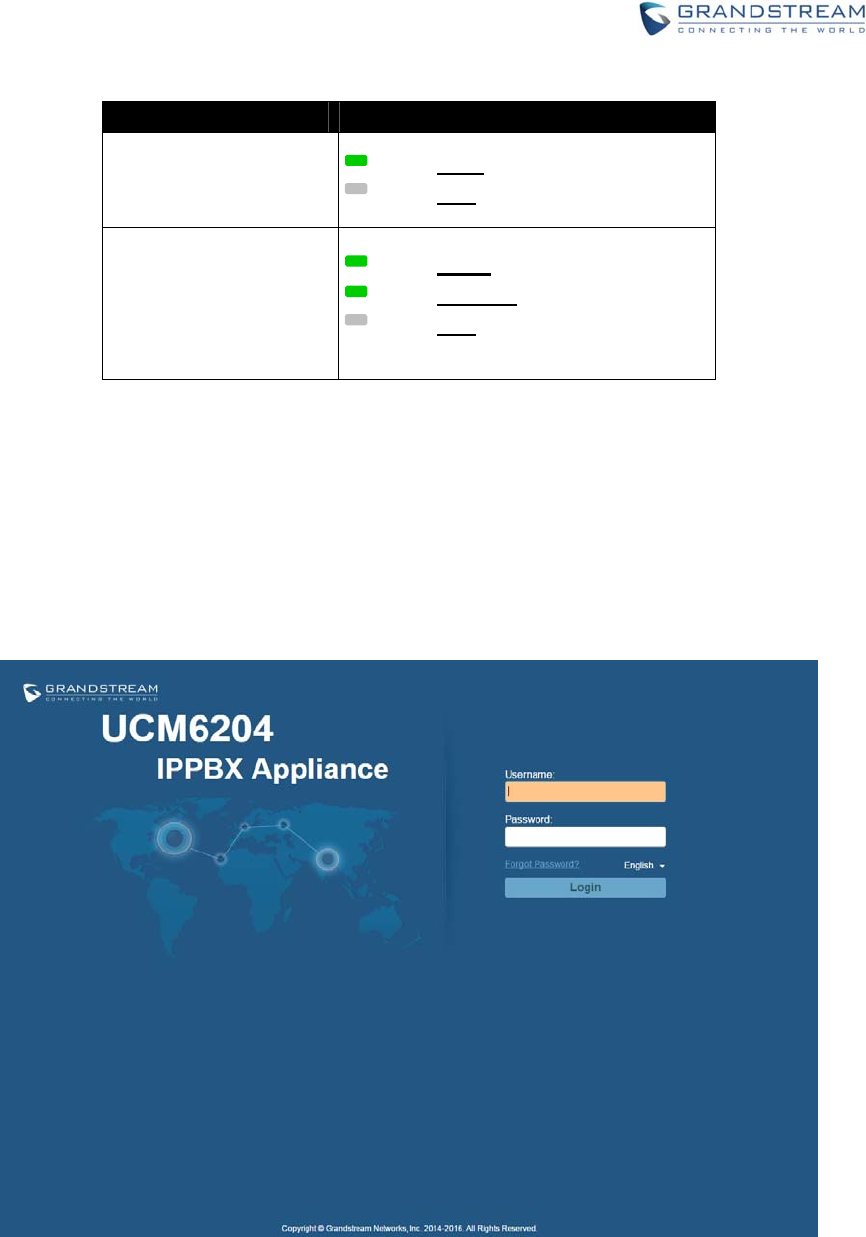
Firmware Version 1.0.0.1 UCM6200 Series IP PBX User Manual Page 33 of 320
Table 5: UCM6208 LED INDICATORS
LED LED Status
NETWORK Solid: Connected
OFF: Not Connected
ACT
USB
SD
Phone (FXS)
Line (FXO)
Solid: Connected
Flashing: Data Transferring
OFF: Not Connected
USETHEWEBGUI
ACCESSWEBGUI
The UCM6200 embedded Web server responds to HTTP/HTTPS GET/POST requests. Embedded HTML
pages allow users to configure the device through a Web browser such as Microsoft IE, Mozilla Firefox,
Google Chrome and etc.
Figure 7: UCM6204 Web GUI Login Page

Firmware Version 1.0.0.1 UCM6200 Series IP PBX User Manual Page 34 of 320
To access the Web GUI:
1. Connect the computer to the same network as the UCM6200.
2. Ensure the device is properly powered up and shows its IP address on the LCD.
3. Open a Web browser on the computer and enter the web GUI URL in the following format:
http(s)://IP-Address:Port
where the IP-Address is the IP address displayed on the UCM6200 LCD.
By default, the protocol is HTTPS and the Port number is 8089.
For example, if the LCD shows 192.168.40.167, please enter the following in your web browser:
https://192.168.40.167:8089
4. Enter the administrator’s login and password to access the Web Configuration Menu. The default
administrator's username and password is "admin" and "admin". It is highly recommended to change
the default password after login for the first time.
--------------------------------------------------------------------------------------------------------------------------------------------
Note:
By default, the UCM6200 has "Redirect From Port 80" enabled. Therefore, if users type in the UCM6200 IP
address in the web browser, the web page will be automatically redirected to the page using HTTPS and
port 8089. For example, if the LCD shows 192.168.40.167, please enter 192.168.40.167 in your web
browser and the web page will be redirected to:
https://192.168.40.167:8089
The option "Redirect From Port 80" can be configured under the UCM6200 web GUI->Settings->HTTP
Server.
--------------------------------------------------------------------------------------------------------------------------------------------
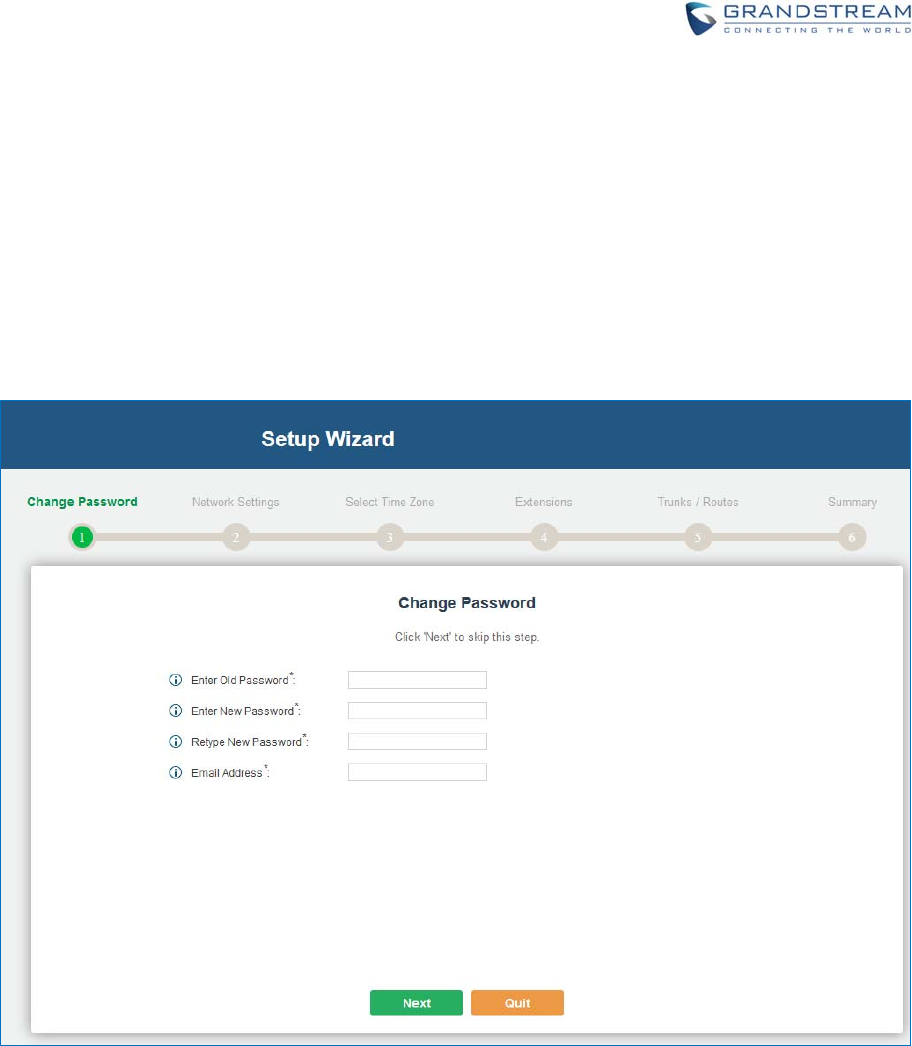
Firmware Version 1.0.0.1 UCM6200 Series IP PBX User Manual Page 35 of 320
SETUPWIZARD
When the user logs in the UCM6200 web UI for the first time, a setup wizard will guide the user to set up basic
configuration. Configurations in setup wizard includes: Time zone, Change password, Network settings,
Extensions, Trunk and routes.
Figure 8: UCM6200 Setup Wizard
During the wizard, the user can quit the setup wizard at any time to start over with manual configuration. At
the last step of the wizard, the user will be provided with summary for review, before the configuration is
loaded. Once the setup is completed, the system is ready to go.
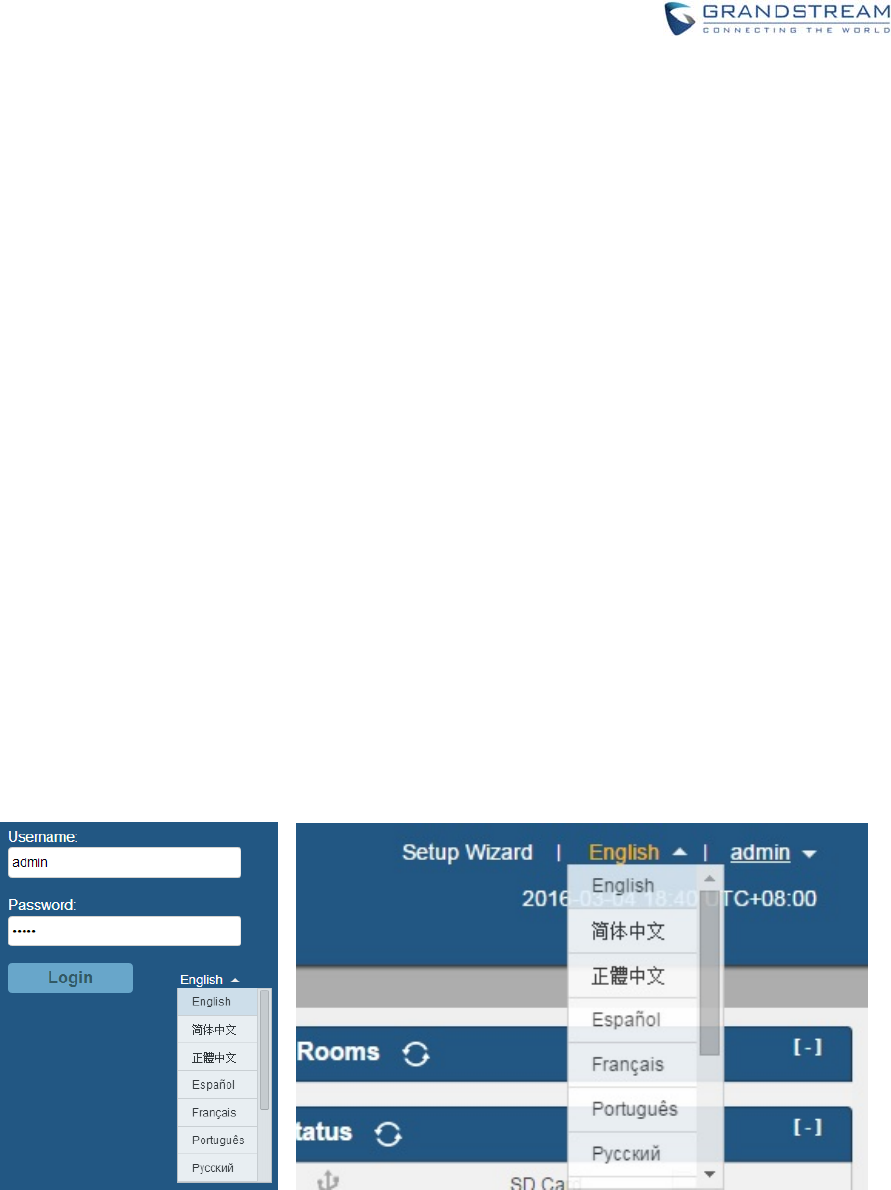
Firmware Version 1.0.0.1 UCM6200 Series IP PBX User Manual Page 36 of 320
WEBGUICONFIGURATIONS
There are four main sections in the Web GUI for users to view the PBX status, configure and manage the
PBX.
Status: Displays PBX status, System Status, System Events and CDR.
PBX: To configure extensions, trunks, call routes, zero config for auto provisioning, call features,
internal options, IAX settings and SIP settings.
Settings: To configure user management, network settings, firewall settings, change password,
LDAP Server, HTTP Server, Email Settings, Time Settings, NTP server, recording storage and login
timeout.
Maintenance: To perform firmware upgrade, backup configurations, cleaner setup, reset/reboot,
syslog setup and troubleshooting.
WEBGUILANGUAGES
Currently the UCM6200 series web GUI supports English, Simplified Chinese, Traditional Chinese,
Spanish, French, Portuguese, Russian, Italian, Polish, German and etc.
Users can select the displayed language in web GUI login page, or at the upper right of the web GUI after
logging in.
Figure 9: UCM6200 Web GUI Language

Firmware Version 1.0.0.1 UCM6200 Series IP PBX User Manual Page 37 of 320
SAVEANDAPPLYCHANGES
Click on "Save" button after configuring the web GUI options in one page. After saving all the changes,
make sure click on "Apply Changes" button on the upper right of the web page to submit all the changes. If
the change requires reboot to take effect, a prompted message will pop up for you to reboot the device.
MAKEYOURFIRSTCALL
Power up the UCM6200 and your SIP end point phone. Connect both devices to the network. Then follow
the steps below to make your first call.
1. Log in the UCM6200 web GUI, go to PBX->Basic/Call Routes->Extensions.
2. Click on "Create New SIP Extension" to create a new extension. You will need User ID, Password and
Voicemail Password information to register and use the extension later.
3. Register the extension on your phone with the SIP User ID, SIP server and SIP Password information.
The SIP server address is the UCM6200 IP address.
4. When your phone is registered with the extension, dial *97 to access the voicemail box. Enter the
Voicemail Password once you hear "Password" voice prompt.
5. Once successfully logged in to the voicemail, you will be prompted with the Voice Mail Main menu.
6. You are successfully connected to the PBX system now.
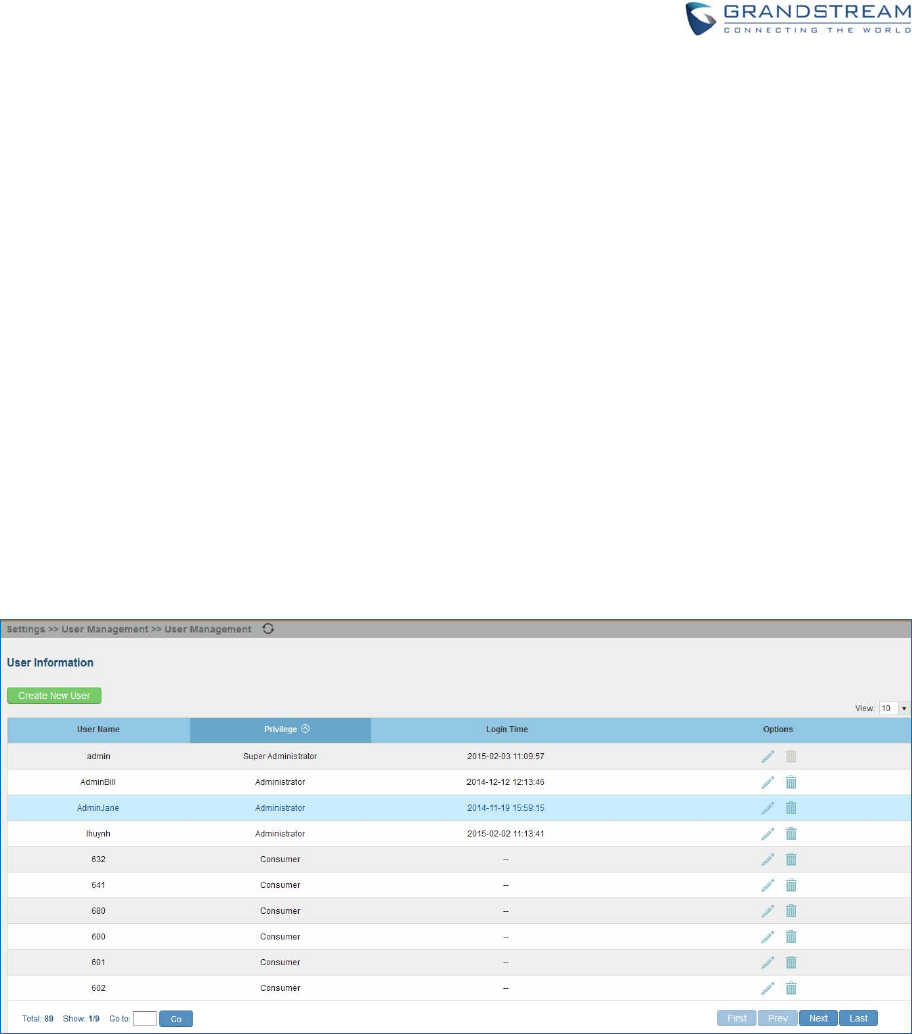
Firmware Version 1.0.0.1 UCM6200 Series IP PBX User Manual Page 38 of 320
SYSTEMSETTINGS
This section explains configurations for system-wide parameters on the UCM6200. System settings are
under “Settings” tag on UCM6200 web GUI. System settings include User Management, Network Settings,
Firewall, Change Password, LDAP server, HTTP server, Email settings, Time Settings, NTP Server,
Recordings Storage and Login Timeout settings.
USERMANAGEMENT
User management is on web GUI->Settings->User Management page. User could create multiple
accounts for different administrators to log in the UCM6200 web GUI. Additionally, the system will
automatically create user accounts along with creating new extensions for extension users to login to the
web UI using their extension number and password. All existing user accounts for web UI login will be
displayed on User Management page as shown in the following figure.
Figure 10: User Management Page Display
USERPRIVILEGES
Three privilege levels are supported:
Super Admin

Firmware Version 1.0.0.1 UCM6200 Series IP PBX User Manual Page 39 of 320
- This is the highest privilege. Super Admin can access all pages on UCM6200 web GUI, change
configuration for all options and execute all the operations.
- Super Admin can create, edit and delete one or more users with “Admin” privilege
- Super Admin can edit and delete one or more users with “Consumer” privilege
- Super Admin can view operation logs generated by all users.
- By default, the user account “admin” is configured with “Super Admin” privilege and it’s the only
user with “Super Admin” privilege. The User Name and Privilege level cannot be changed or
deleted.
- Super Admin could change its own login password on web UI->Settings->Change Password
page.
- Super Admin could view operations done by all the users in web UI->Settings->User
Management->Operation Log.
Admin
- Users with “Admin” privilege can only be created by “Super Admin” user.
- “Admin” privilege users are not allowed to access the following pages:
Maintenance->Upgrade
Maintenance->Backup
Maintenance->Cleaner
Maintenance->Reset/Reboot
Settings->User Management->Operation Log
- “Admin” privilege users cannot create new users for login.
Consumer
- A user account for web UI login is created automatically by the system when a new extension is
created.
- The user could log in the web UI with the extension number and password to access user
information, extension configuration and CDR of that extension.
CREATENEWWEBUIUSER
When logged in as Super Admin, click on to create a new account for web UI user. The
following dialog will prompt. Configure the parameters as shown in below table.
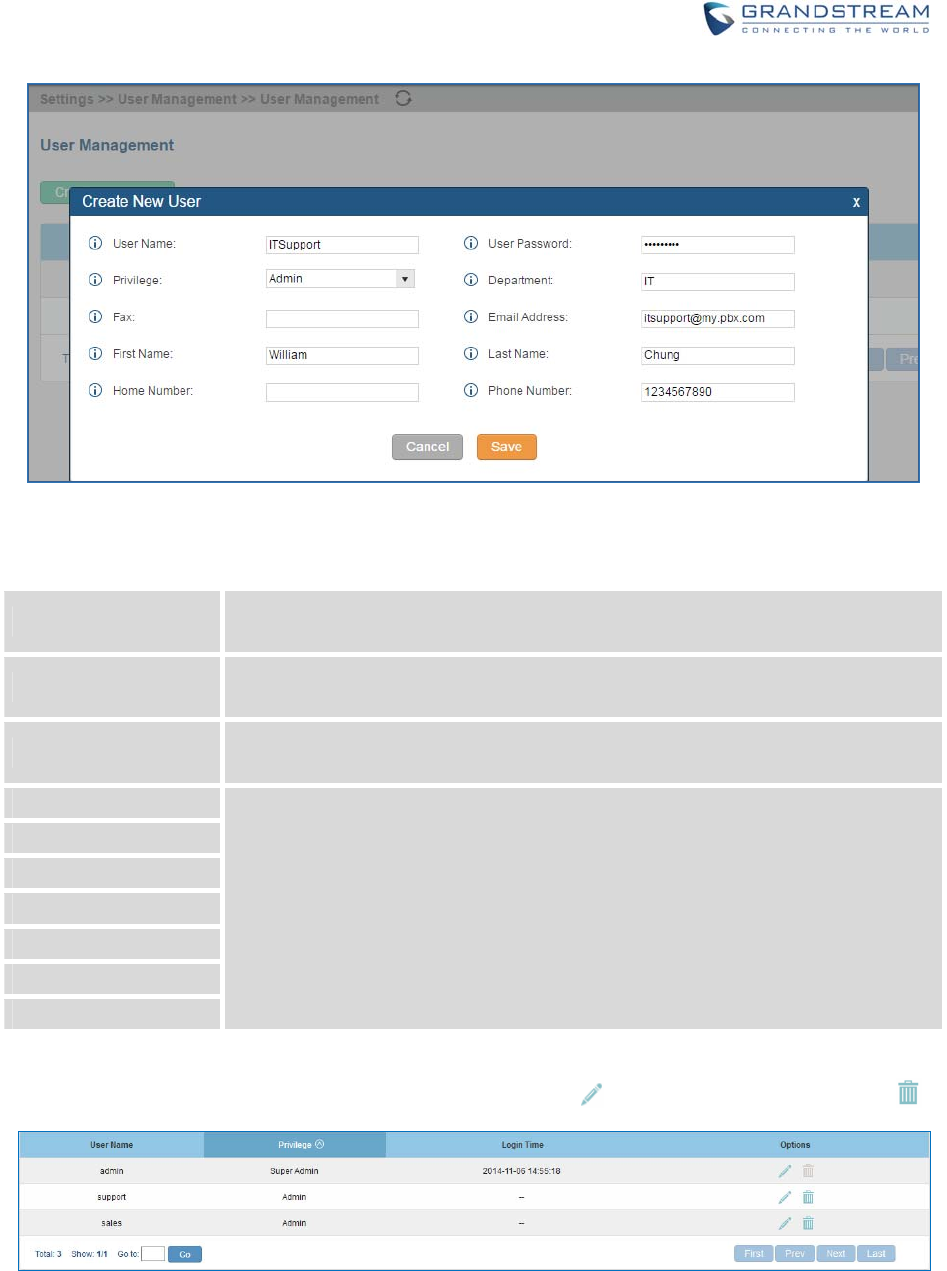
Firmware Version 1.0.0.1 UCM6200 Series IP PBX User Manual Page 40 of 320
Figure 11: Create New User
Table 6: User Management->Create New User
User Name Configure a username to identify the user which will be required in web UI login.
Letters, digits and underscore are allowed in the user name.
User Password Configure a password for this user which will be required in web UI login. Letters,
digits and underscore are allowed.
Privilege This is the role of the web UI user. Currently only “Admin” is supported when
Super Admin creates a new user.
Department
Enter the necessary information to keep a record for this user.
Fax
Email Address
First Name
Last Name
Home Number
Phone Number
Once created, the Super Admin can edit the users by clicking on or delete the user by clicking on .
Figure 12: User Management – New Users
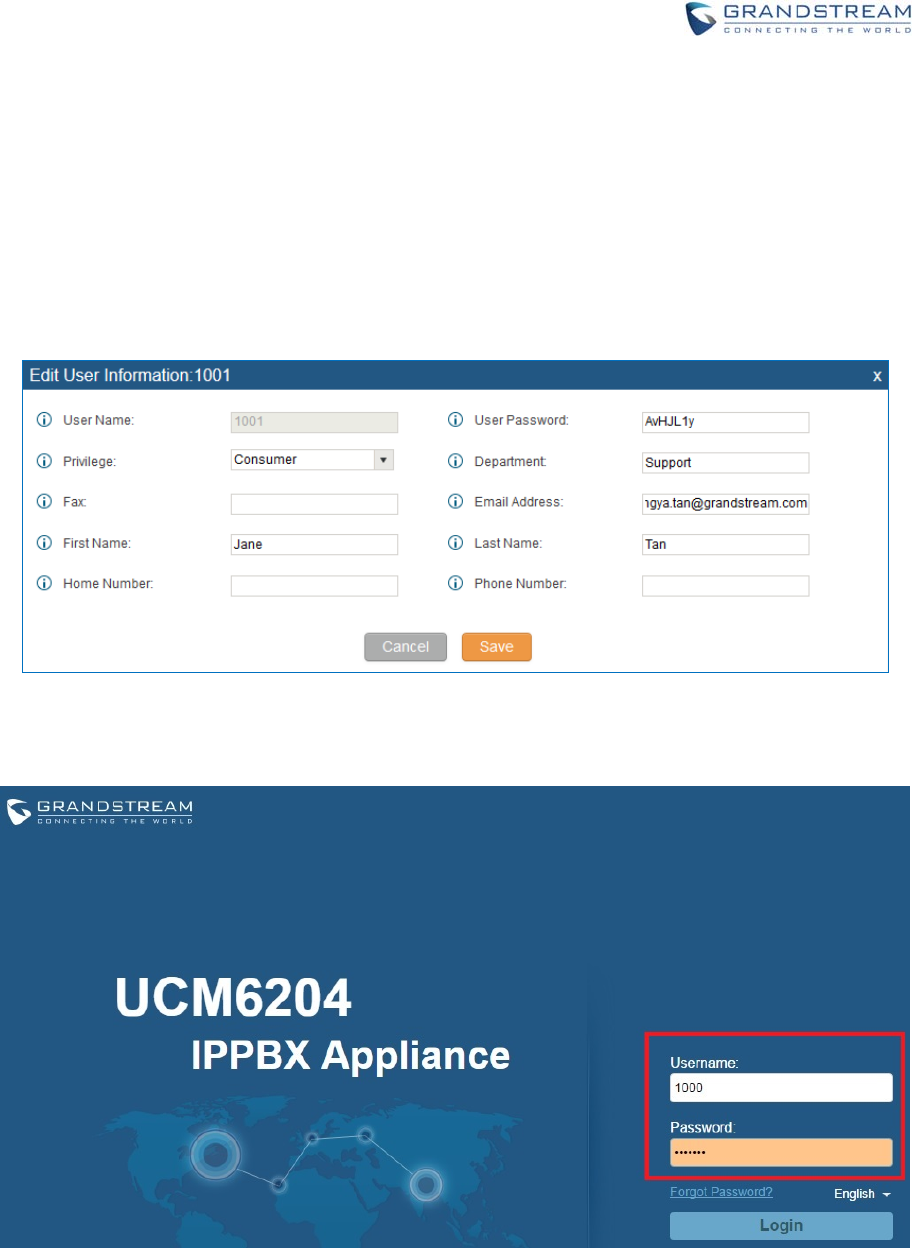
Firmware Version 1.0.0.1 UCM6200 Series IP PBX User Manual Page 41 of 320
USERPORTAL
The user could log in web UI user portal using the extension number and password. When there is an
extension created in the UCM6200, the corresponding user account for the extension is automatically
created. The user portal allows limited access including user information, extension configuration and CDR
information of the extension. The login username is the extension number and the password is configured
by Super Admin. The following figure shows the dialog of editing the account information by Super Admin.
The User Name must be the extension number and it’s not configurable.
Figure 13: Edit User Information by Super Admin
The following figure shows an example of login page using extension number 1000 as the username.
Figure 14: User Portal Login
After login, the web UI displays is shown as below.
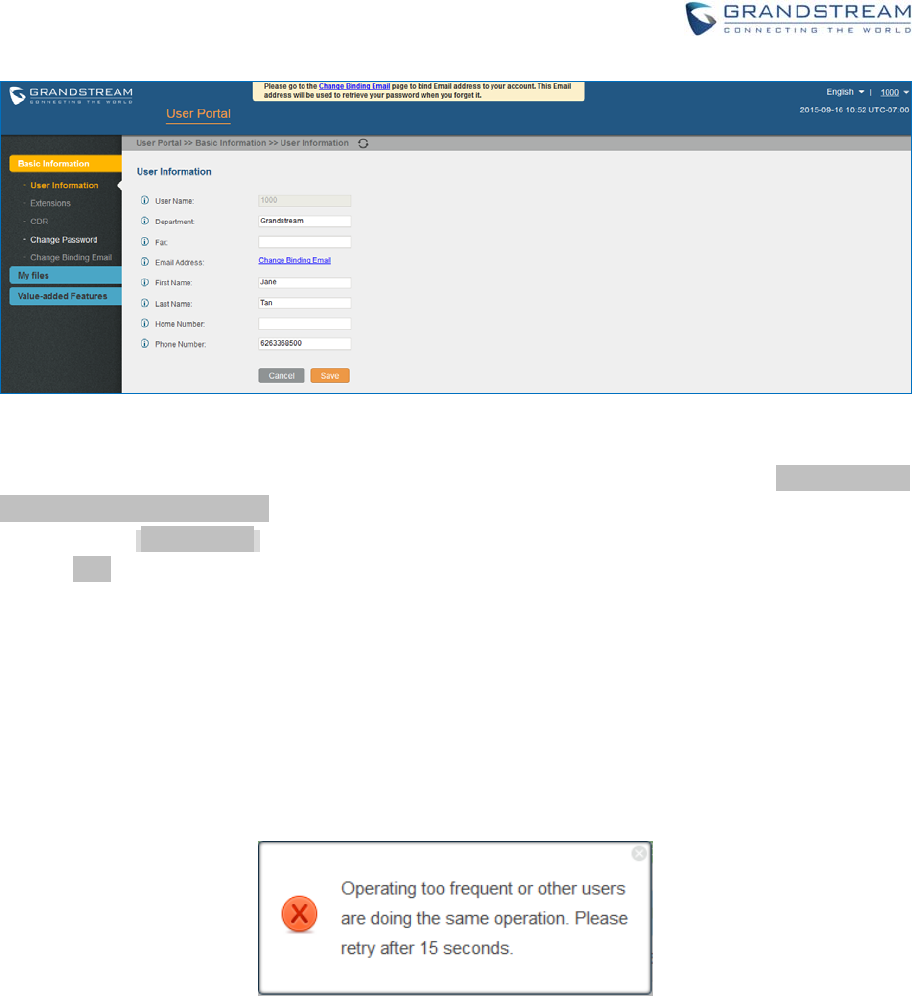
Firmware Version 1.0.0.1 UCM6200 Series IP PBX User Manual Page 42 of 320
Figure 15: User Portal Layout
For the configuration parameter information in each page, please refer to [Table 6: User
Management->Create New User] for options in User Portal->Basic Information->User Information page;
please refer to [EXTENSIONS] for options in User Portal->Basic Information->Extension page; please
refer to [CDR] for User Portal->Basic Information->CDR page.
CONCURRENTMULTI‐USERLOGIN
When there are multiple web UI users created, concurrent multi-user login is supported on the UCM6200.
Multiple users could edit options and have configurations take effect simultaneously. However, if different
users are editing the same option or making the same operation (by clicking on “Apply Changes”), a
prompt will pop up as shown in the following figure.
Figure 16: Multiple User Operation Error Prompt
OPERATIONLOG
Super Admin has the authority to view operation logs on UCM6200 web GUI->Settings->User
Management->Operation Log page. Operation logs list operations done by all the web UI users, for
example, web UI login, creating trunk, creating outbound rule and etc. There are 6 columns to record the
operation details “Date”, “User Name”, “IP Address”, “Results”, “Page Operation” and “Specific Operation”.
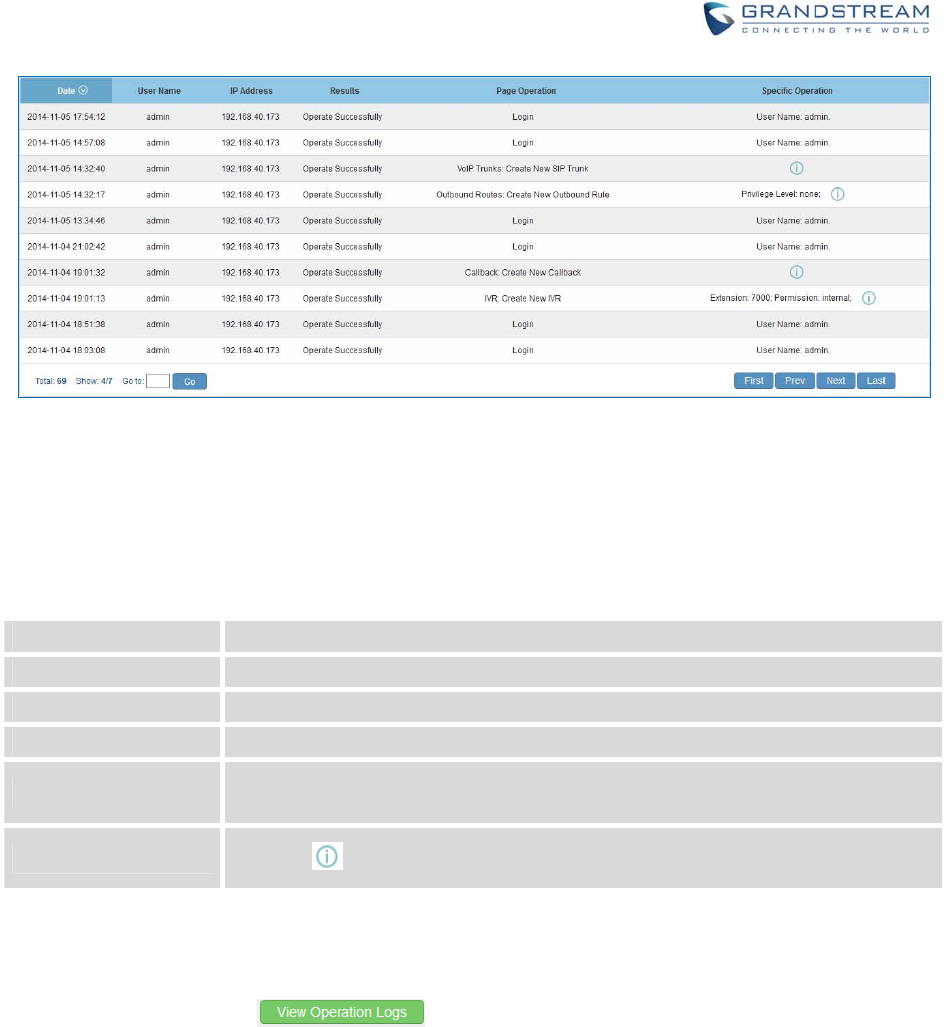
Firmware Version 1.0.0.1 UCM6200 Series IP PBX User Manual Page 43 of 320
Figure 17: Operation Logs
The operation log can be sorted and filtered for easy access. Click on the header of each column to sort.
For example, clicking on "Date" will sort the logs according to operation date and time. Clicking on "Date"
again will reverse the order.
Table 7: Operation Log Column Header
Date The date and time when the operation is executed.
User Name The username of the user who performed the operation.
IP Address The IP address from which the operation is made.
Results The result of the operation.
Page Operation The page where the operation is made. For example, login, logout, delete user,
create trunk and etc.
Specific Operation Click on to view the options and values configured by this operation.
User could also filter the operation logs by time condition, IP address and/or username. Configure these
conditions and then click on .
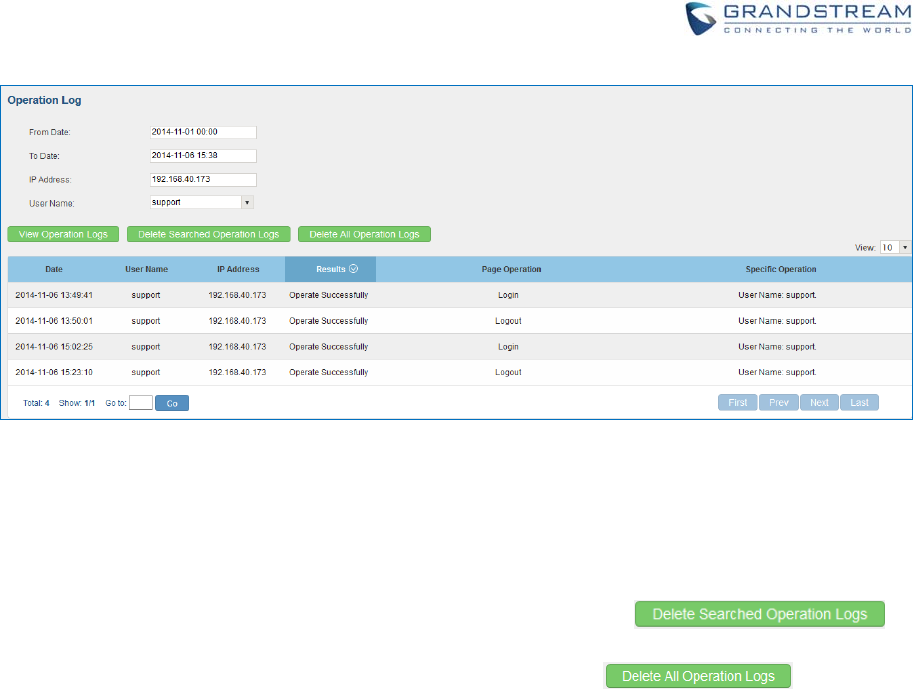
Firmware Version 1.0.0.1 UCM6200 Series IP PBX User Manual Page 44 of 320
Figure 18: Operation Logs Filter
The above figure shows an example that operations made by user “support” on device with IP
192.168.40.173 from 2014-11-01 00:00 to 2014-11-06 15:38 are filtered out and displayed.
To delete operation logs, users can perform filtering first and then click on to
delete the filtered result of operation logs. Or users can click on to delete all
operation logs at once.
CHANGEPASSWORD
After logging in the UCM6200 web UI for the first time, it is highly recommended for users to change the
default password "admin" to a more complicated password for security purpose. Follow the steps below to
change the Web UI access password.
1. Go to Web UI->Settings->User Management-> Change Password page.
2. Enter the old password first.
3. Enter the new password and re-type the new password to confirm. The new password has to be at
least 4 characters. The maximum length of the password is 30 characters.
4. Configure the Email Address that is used when login credential is lost.
5. Click on "Save" and the user will be automatically logged out.
6. Once the web page comes back to the login page again, enter the username "admin" and the new
password to login.
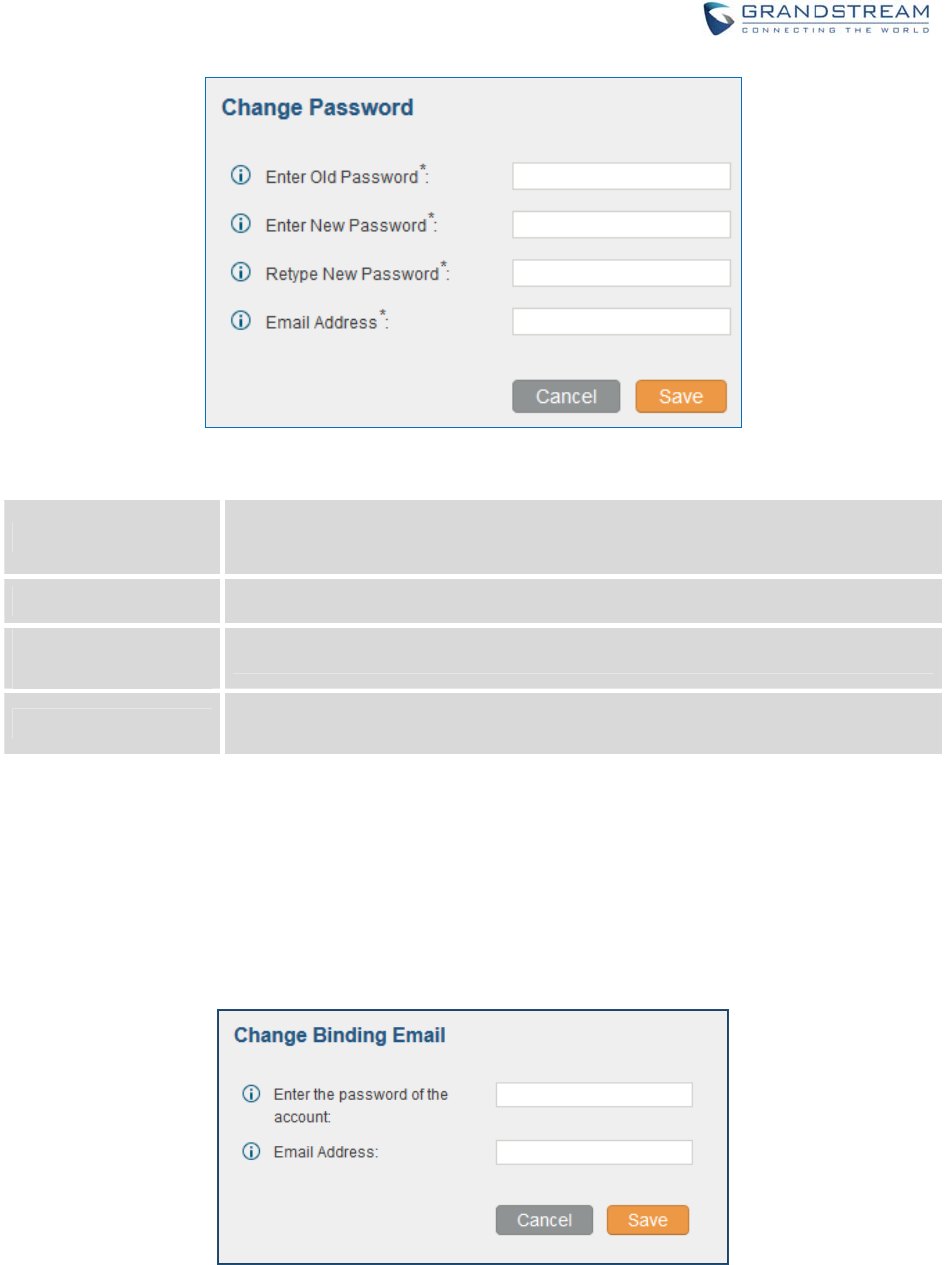
Firmware Version 1.0.0.1 UCM6200 Series IP PBX User Manual Page 45 of 320
Figure 19 : Change Password
Enter Old Password Enter the Old Password for UCM6200
Enter New Password Enter the New Password for UCM6200
Retype New
Password Retype the New Password for UCM6200
Email Address Configure the Email address for UCM6200. In case login credential is lost, Email
address is used to retrieve login credential
CHANGEBINDNGEMAIL
UCM6200 allows user to configure binding email in case login password is lost. UCM6200 login credential
will be sent to the designated email address. The feature can be found under web UI->Settings->User
Management->Change Binding Email.
Figure 20: Change Binding Email

Firmware Version 1.0.0.1 UCM6200 Series IP PBX User Manual Page 46 of 320
Table 8: Change Binding Email option
Enter the password
of the account Enter the current login user credential for UCM6200
Email Address Email Address is used to retrieve password when password is lost
NETWORKSETTINGS
After successfully connecting the UCM6200 to the network for the first time, users could login the Web GUI
and go to Settings->Network Settings to configure the network parameters for the device.
Additional network functions and settings are available for UCM6202 and UCM6204:
UCM6202/UCM6204 supports Route/Switch/Dual mode functions.
In this section, all the available network setting options are listed for all models. Select each tab in web
GUI->Settings->Network Settings page to configure LAN settings, WAN settings (UCM6202/UCM6204
only), 802.1X and Port Forwarding (UCM6202/UCM6204 only).
BASICSETTINGS
Please refer to the following tables for basic network configuration parameters on UCM6202/UCM6204,
and UCM6208 respectively.
Table 9: UCM6202/UCM6204 Network Settings->Basic Settings
Method
Select "Route", "Switch" or "Dual" mode on the network interface of UCM6200.
The default setting is "Route".
Route
WAN port interface will be used for uplink connection. LAN port interface will
be used to serve as router.
Switch
WAN port interface will be used for uplink connection. LAN port interface will
be used as bridge for PC connection.
Dual
Both ports can be used for uplink connection. Users will need assign LAN 1 or
LAN 2 as the default interface in option "Default Interface" and configure
"Gateway IP" for this interface.
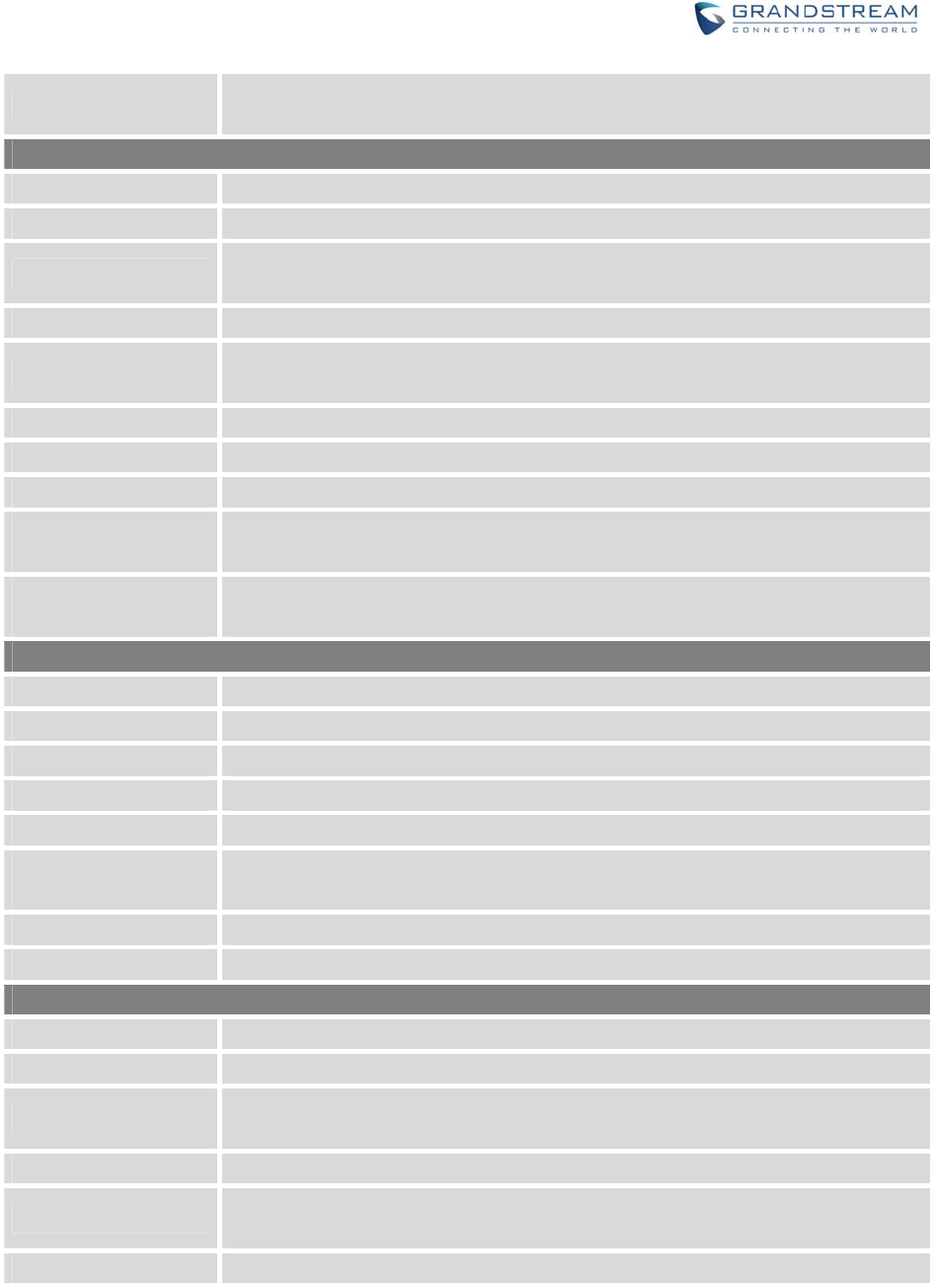
Firmware Version 1.0.0.1 UCM6200 Series IP PBX User Manual Page 47 of 320
Preferred DNS Server Enter the preferred DNS server address. If Preferred DNS is used, UCM will try to
use it as Primary DNS server.
WAN (when "Method" is set to "Route")
IP Method Select DHCP, Static IP, or PPPoE. The default setting is DHCP.
IP Address Enter the IP address for static IP settings. The default setting is 192.168.0.160.
Subnet Mask Enter the subnet mask address for static IP settings. The default setting is
255.255.0.0.
Gateway IP Enter the gateway IP address for static IP settings. The default setting is 0.0.0.0.
DNS Server 1 Enter the DNS server 1 address for static IP settings. The default setting is
0.0.0.0.
DNS Server 2 Enter the DNS server 2 address for static IP settings.
User Name Enter the user name to connect via PPPoE.
Password Enter the password to connect via PPPoE.
Layer 2 QoS
802.1Q/VLAN Tag
Assign the VLAN tag of the layer 2 QoS packets for WAN port. The default value
is 0.
Layer 2 QoS 802.1p
Priority Value
Assign the priority value of the layer 2 QoS packets for WAN port. The default
value is 0.
LAN (when Method is set to "Route")
IP Address Enter the IP address assigned to LAN port. The default setting is 192.168.2.1.
Subnet Mask Enter the subnet mask. The default setting is 255.255.255.0.
DHCP Server Enable Enable or disable DHCP server capability. The default setting is "Yes".
DNS Server 1 Enter DNS server address 1. The default setting is 8.8.8.8.
DNS Server 2 Enter DNS server address 2. The default setting is 208.67.222.222.
Allow IP Address
From Enter the DHCP IP Pool starting address. The default setting is 192.168.2.100.
Allow IP Address To Enter the DHCP IP Pool ending address. The default setting is 192.168.2.254.
Default IP Lease Time Enter the IP lease time (in seconds). The default setting is 43200.
LAN (when Method is set to "Switch")
IP Method Select DHCP, Static IP, or PPPoE. The default setting is DHCP.
IP Address Enter the IP address for static IP settings. The default setting is 192.168.0.160.
Subnet Mask Enter the subnet mask address for static IP settings. The default setting is
255.255.0.0.
Gateway IP Enter the gateway IP address for static IP settings. The default setting is 0.0.0.0.
DNS Server 1 Enter the DNS server 1 address for static IP settings. The default setting is
0.0.0.0.
DNS Server 2 Enter the DNS server 2 address for static IP settings.
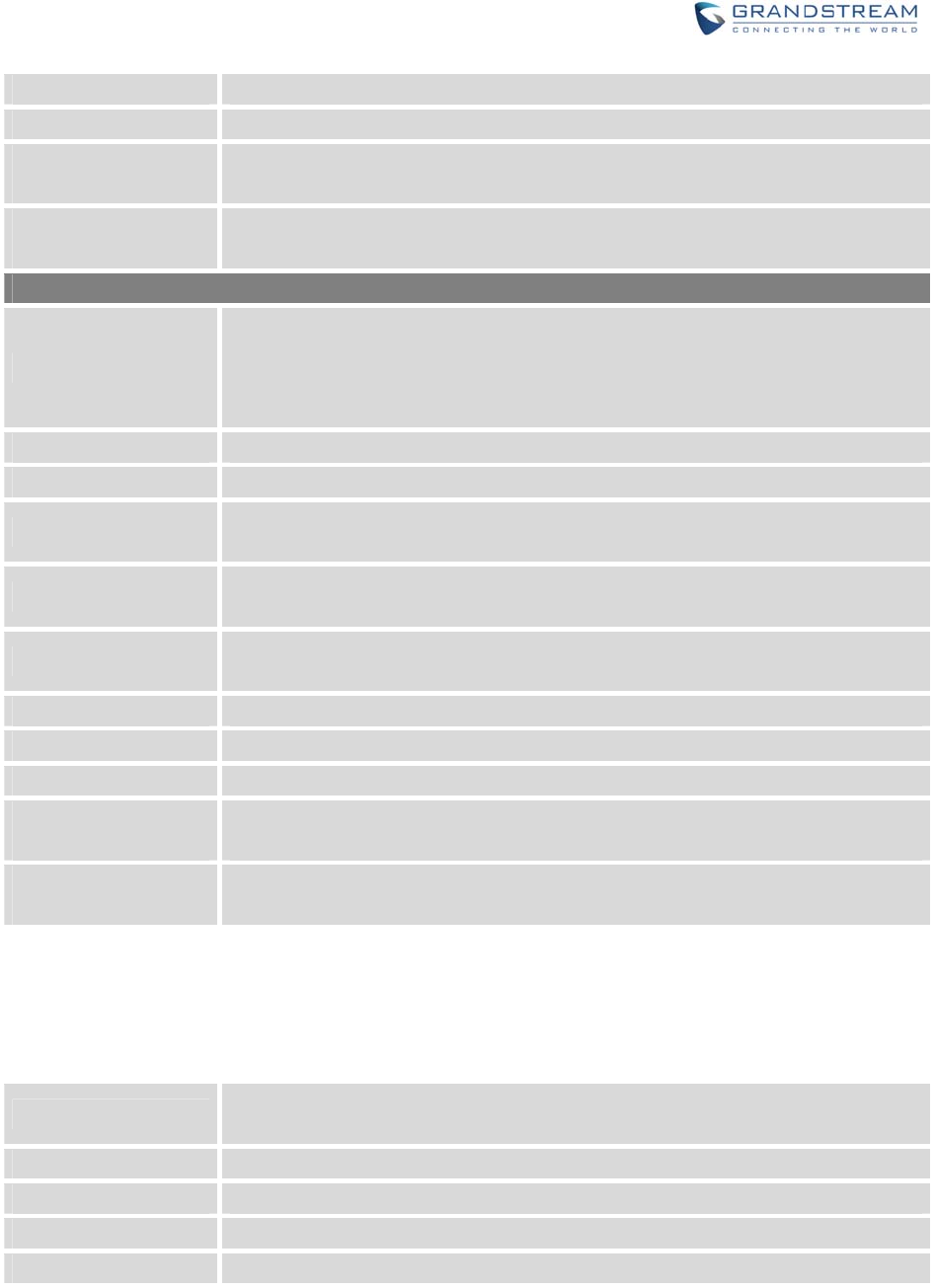
Firmware Version 1.0.0.1 UCM6200 Series IP PBX User Manual Page 48 of 320
User Name Enter the user name to connect via PPPoE.
Password Enter the password to connect via PPPoE.
Layer 2 QoS
802.1Q/VLAN Tag
Assign the VLAN tag of the layer 2 QoS packets for LAN port. The default value is
0.
Layer 2 QoS 802.1p
Priority Value
Assign the priority value of the layer 2 QoS packets for LAN port. The default
value is 0.
LAN 1 / LAN 2 (when Method is set to "Dual")
Default Interface
If "Dual" is selected as "Method", users will need assign the default interface to be
LAN 1 (mapped to UCM6202 WAN port) or LAN 2 (mapped to UCM6202 LAN
port) and then configure network settings for LAN 1/LAN 2. The default interface is
LAN 2.
IP Method Select DHCP, Static IP, or PPPoE. The default setting is DHCP.
IP Address Enter the IP address for static IP settings. The default setting is 192.168.0.160.
Subnet Mask Enter the subnet mask address for static IP settings. The default setting is
255.255.0.0.
Gateway IP Enter the gateway IP address for static IP settings when the port is assigned as
default interface. The default setting is 0.0.0.0.
DNS Server 1 Enter the DNS server 1 address for static IP settings. The default setting is
0.0.0.0.
DNS Server 2 Enter the DNS server 2 address for static IP settings.
User Name Enter the user name to connect via PPPoE.
Password Enter the password to connect via PPPoE.
Layer 2 QoS
802.1Q/VLAN Tag
Assign the VLAN tag of the layer 2 QoS packets for LAN port. The default value is
0.
Layer 2 QoS 802.1p
Priority Value
Assign the priority value of the layer 2 QoS packets for LAN port. The default
value is 0.
Table 10: UCM6208 Network Settings->Basic Settings
Preferred DNS Server Enter the preferred DNS server address. If Preferred DNS is used, UCM will try to
use it as Primary DNS server.
IP Method Select DHCP, Static IP, or PPPoE. The default setting is DHCP.
IP Address Enter the IP address for static IP settings.
Subnet Mask Enter the subnet mask address for static IP settings.
Gateway IP Enter the gateway IP address for static IP settings.
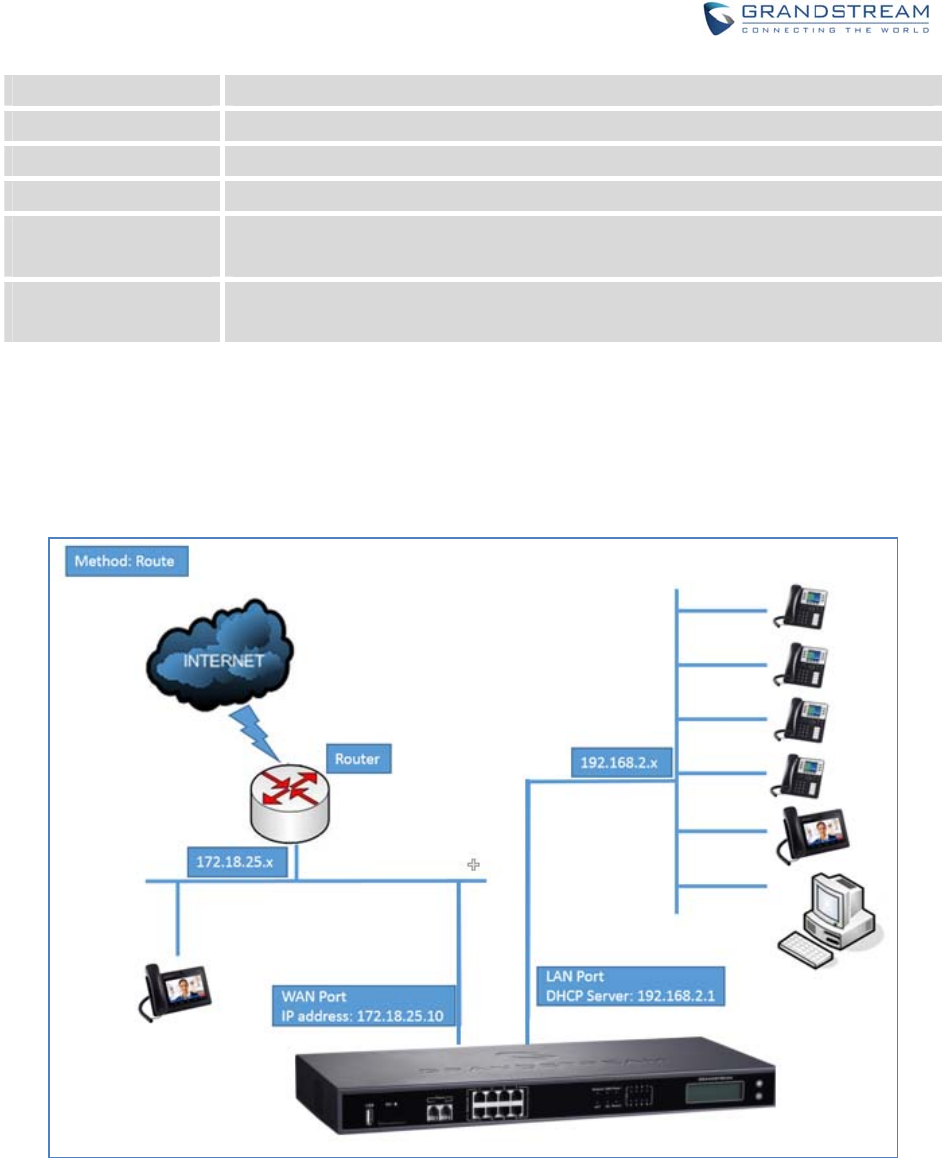
Firmware Version 1.0.0.1 UCM6200 Series IP PBX User Manual Page 49 of 320
DNS Server 1 Enter the DNS server 1 address for static IP settings.
DNS Server 2 Enter the DNS server 2 address for static IP settings.
User Name Enter the user name to connect via PPPoE.
Password Enter the password to connect via PPPoE.
Layer 2 QoS
802.1Q/VLAN Tag
Assign the VLAN tag of the layer 2 QoS packets for LAN port. The default value is
0.
Layer 2 QoS 802.1p
Priority Value
Assign the priority value of the layer 2 QoS packets for LAN port. The default
value is 0.
Method: Route
When the UCM6200 has method set to Route in network settings, WAN port interface is used for
uplink connection and LAN port interface is used as a router. Please see a sample diagram below.
Figure 21: UCM6200 Network Interface Method: Route
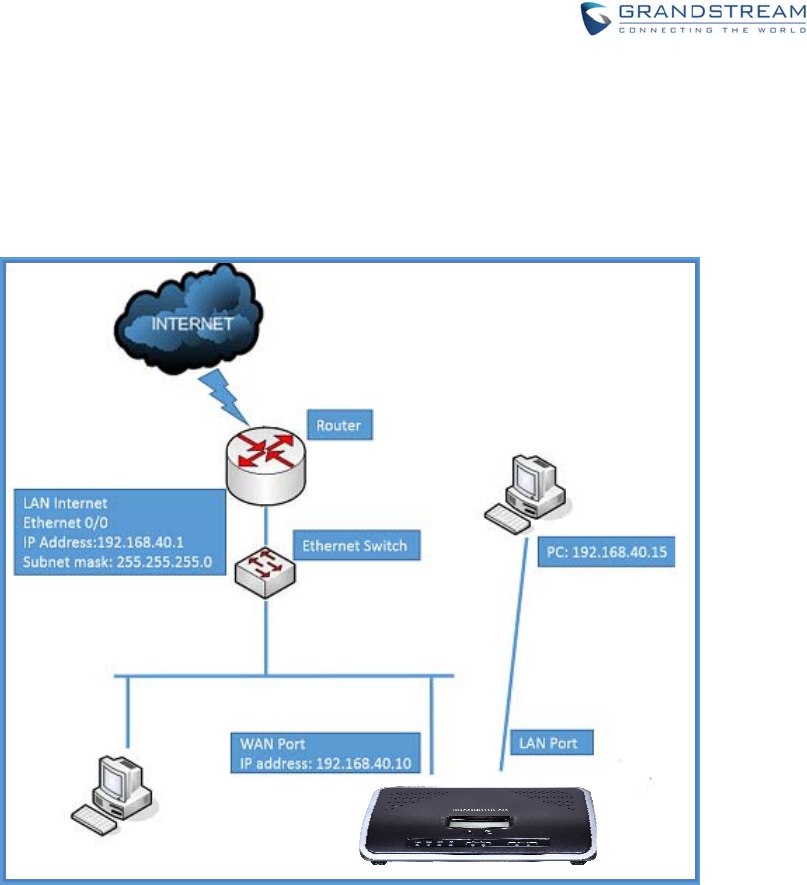
Firmware Version 1.0.0.1 UCM6200 Series IP PBX User Manual Page 50 of 320
Method: Switch
WAN port interface is used for uplink connection; LAN port interface is used as bridge for PC
connection.
Figure 22: UCM6200 Network Interface Method: Switch
Method: Dual
Both WAN port and LAN port are used for uplink connection. Users will need assign LAN 1 or LAN 2 as
the default interface in option "Default Interface" and configure "Gateway IP" if static IP is used for this
interface.
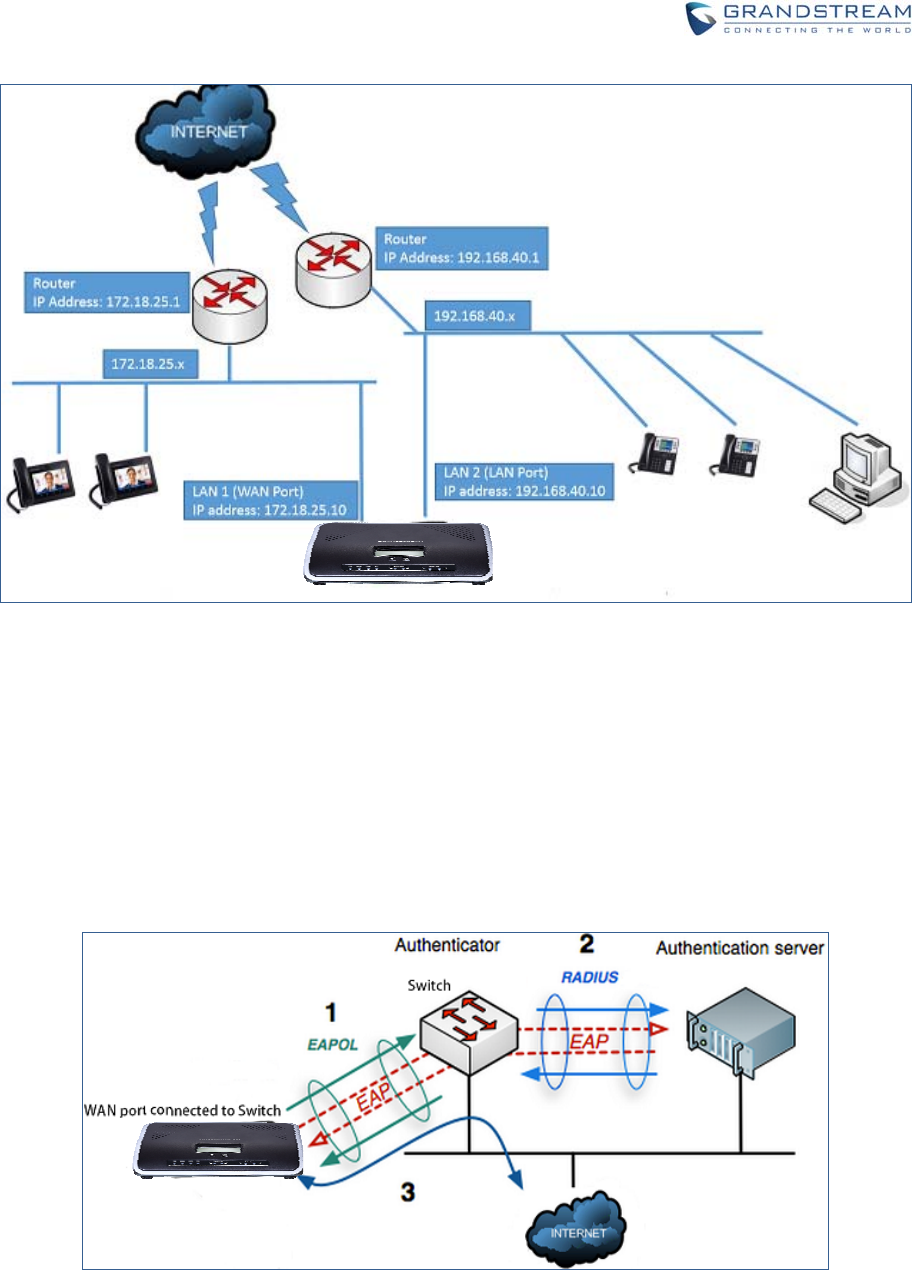
Firmware Version 1.0.0.1 UCM6200 Series IP PBX User Manual Page 51 of 320
Figure 23: UCM6200 Network Interface Method: Dual
802.1X
IEEE 802.1X is an IEEE standard for port-based network access control. It provides an authentication
mechanism to device before the device is allowed to access Internet or other LAN resources. The
UCM6200 supports 802.1X as a supplicant/client to be authenticated. The following diagram and figure
show UCM6200 uses 802.1X mode “EAP-MD5” on WAN port as client in the network to access Internet.
Figure 24: UCM6200 Using 802.1X as Client
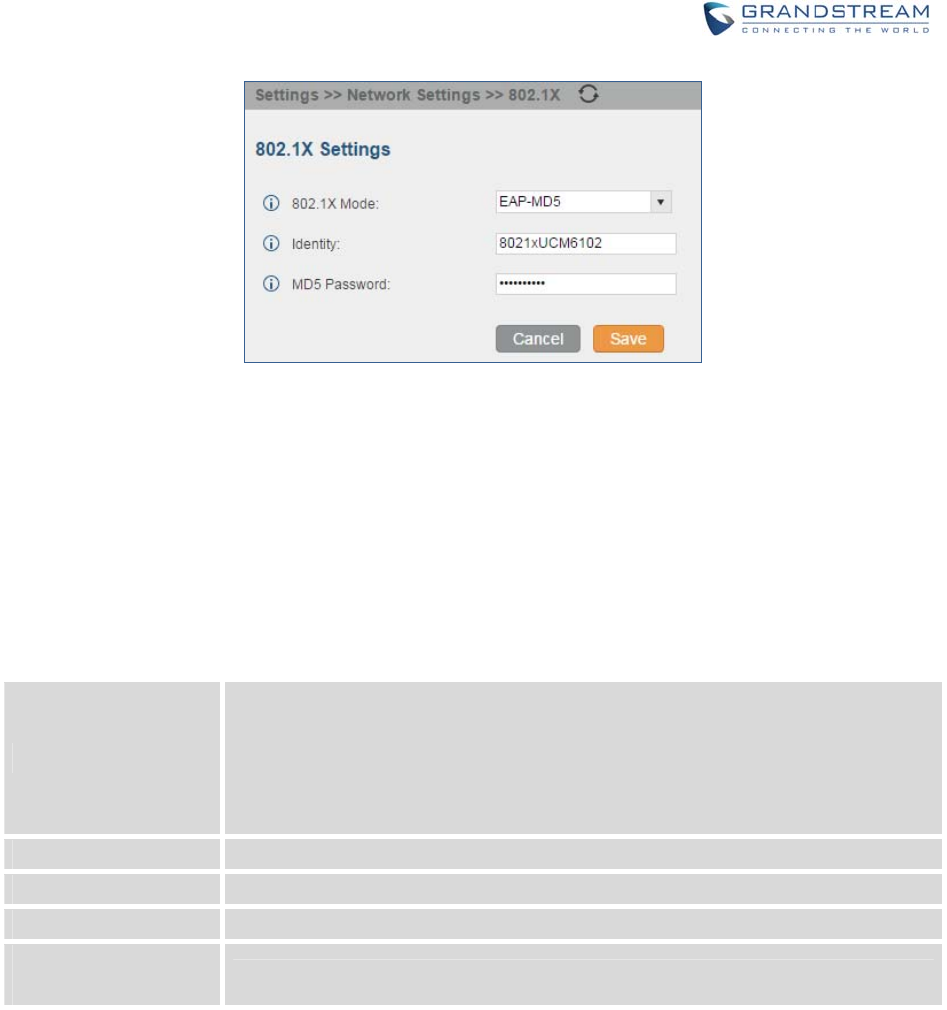
Firmware Version 1.0.0.1 UCM6200 Series IP PBX User Manual Page 52 of 320
Figure 25: UCM6200 Using 802.1X EAP-MD5
The following table shows the configuration parameters for 802.1X on UCM6200. Identity and MD5
password are required for authentication, which should be provided by the network administrator obtained
from the RADIUS server. If “EAP-TLS” or “EAP-PEAPv0/MSCHAPv2” is used as the 802.1X mode, users
will also need upload 802.1X CA Certificate and 802.1X Client Certificate, which should be also generated
from the RADIUS server.
Table 11: UCM6200 Network Settings->802.1X
802.1X Mode
Select 802.1X mode. The default setting is "Disable". The supported 802.1X
mode are:
EAP-MD5
EAP-TLS
EAP-PEAPv0/MSCHAPv2
Identity Enter 802.1X mode identity information.
MD5 Password Enter 802.1X mode MD5 password information.
802.1X Certificate Select 802.1X certificate from local PC and then upload.
802.1X Client
Certificate Select 802.1X client certificate from local PC and then upload.
STATICROUTES
The UCM6200 provides users static routing capability that allows the device to use manually configured
routes, rather than information only from dynamic routing or gateway configured in the UCM6200 web
GUI->Network Settings->Basic Settings to forward traffic. It can be used to define a route when no other
routes are available or necessary, or used in complementary with existing routing on the UCM6200 as a
failover backup, and etc.
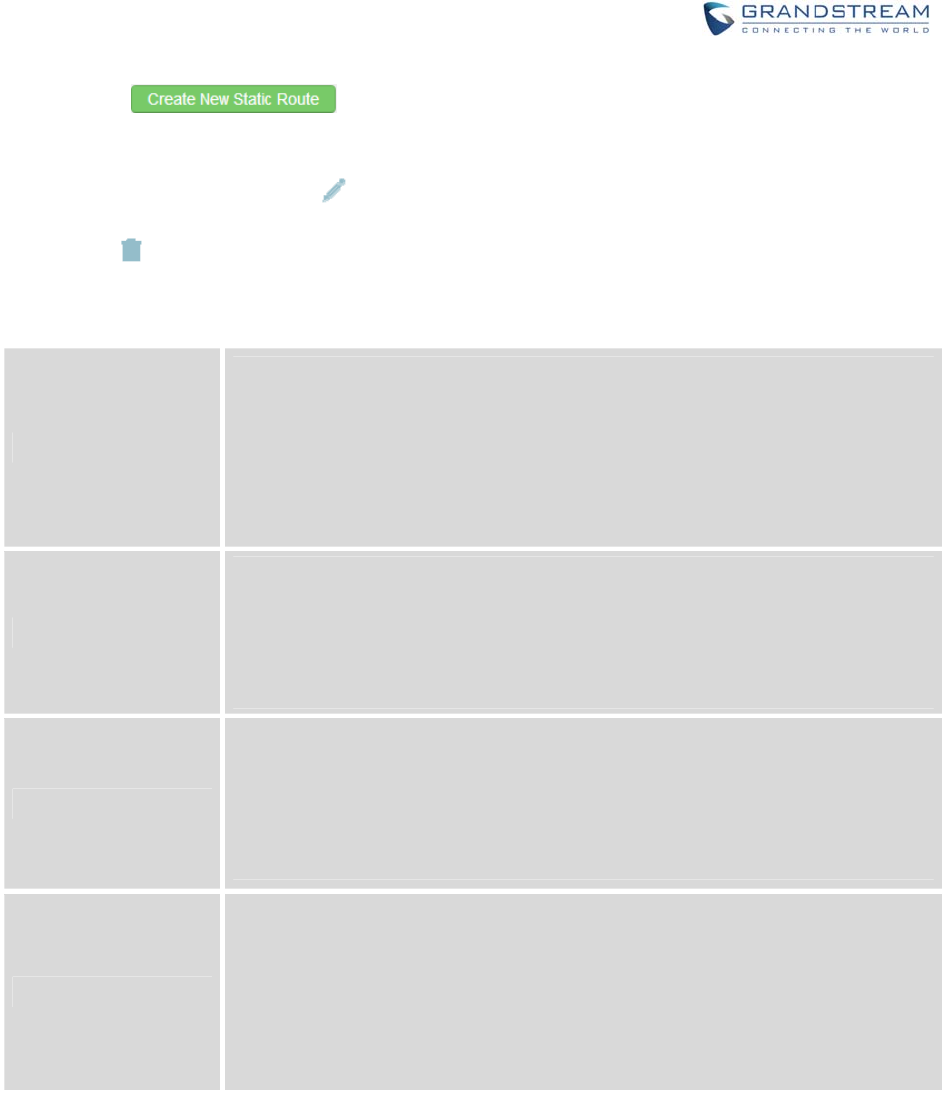
Firmware Version 1.0.0.1 UCM6200 Series IP PBX User Manual Page 53 of 320
Click on to create a new static route. The configuration parameters are listed
in the table below.
Once added, users can select to edit the static route.
Select to delete the static route.
Table 12: UCM6200 Network Settings->Static Routes
Destination
Configure the destination IP address or the destination IP subnet for the
UCM6200 to reach using the static route.
Example:
IP address - 192.168.66.4
IP subnet - 192.168.66.0
Netmask
Configure the subnet mask for the above destination address. If left blank, the
default value is 255.255.255.255.
Example:
255.255.255.0
Gateway
Configure the gateway address so that the UCM6200 can reach the destination
via this gateway. Gateway address is optional.
Example:
192.168.40.5
Interface
Specify the network interface on the UCM6200 to reach the destination using the
static route.
LAN interface is eth0; WAN interface is eth1.
Static routes configuration can be reset from LCD menu->Network Menu.
The following diagram shows a sample application of static route usage on UCM6204.
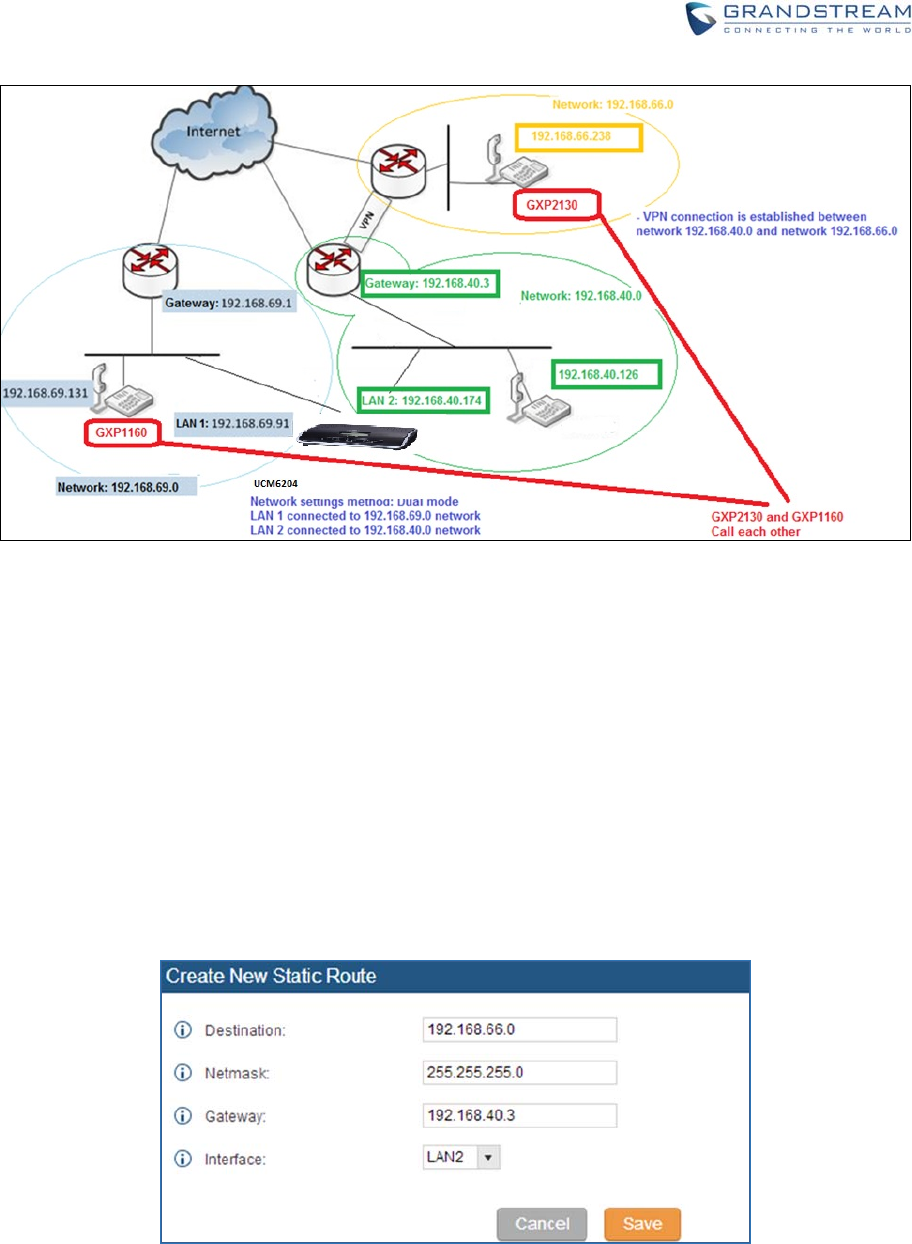
Firmware Version 1.0.0.1 UCM6200 Series IP PBX User Manual Page 54 of 320
Figure 26: UCM6204 Static Route Sample
The network topology of the above diagram is as below:
Network 192.168.69.0 has IP phones registered to UCM6204 LAN 1 address
Network 192.168.40.0 has IP phones registered to UCM6204 LAN 2 address
Network 192.168.66.0 has IP phones registered to UCM6204 via VPN
Network 192.168.40.0 has VPN connection established with network 192.168.66.0
In this network, by default the IP phones in network 192.168.69.0 are unable to call IP phones in network
192.168.66.0 when registered on different interfaces on the UCM6204. Therefore, we need configure a
static route on the UCM6204 so that the phones in isolated networks can make calls between each other.
Figure 27: UCM6204 Static Route Configuration

Firmware Version 1.0.0.1 UCM6200 Series IP PBX User Manual Page 55 of 320
PORTFORWORDING
The UCM network interface supports router function which provides users the ability to do port forwarding.
If the UCM6202/UCM6204 LAN mode is set to "Route" under web GUI->Settings->Network
Settings->Basic Settings page, port forwarding is available for configuration.
The port forwarding configuration is under web GUI->Settings->Network Settings->Port Forwarding
page. Please see related settings in the table below.
Table 13: UCM6202/UCM6204 Network Settings->Port Forwarding
WAN Port
Specify the WAN port number or a range of WAN ports. Up to 8 ports can be
configured.
Note:
When it is set to a range, WAN port and LAN port must be configured with the
same range, such as WAN port: 1000-1005 and LAN port: 1000-1005, and access
from WAN port will be forwarded to the LAN port with the same port number, for
example, WAN port 1000 will be port forwarding to LAN port 1000.
LAN IP Specify the LAN IP address.
LAN Port
Specify the LAN port number or a range of LAN ports.
Note:
When it is set to a range, WAN port and LAN port must be configured with the
same range, such as WAN port: 1000-1005 and LAN port: 1000-1005, and access
from WAN port will be forwarded to the LAN port with the same port number, for
example, WAN port 1000 will be port forwarding to LAN port 1000.
Protocol Type Select protocol type "UDP Only", "TCP Only" or "TCP/UDP" for the forwarding in
the selected port. The default setting is "UDP Only".
The following figures demonstrate a port forwarding example to provide phone’s web UI access to public
side.
The UCM6202/UCM6204 network mode is set to “Route”
The UCM6202/UCM6204 WAN port is connected to uplink switch, with a public IP address configured,
e.g. 1.1.1.1.
The UCM6202/UCM6204 LAN port provides DHCP pool that connects to multiple phone devices in the
LAN network 192.168.2.x. The UCM6202/UCM6204 is used as a router, with gateway address
192.168.2.1
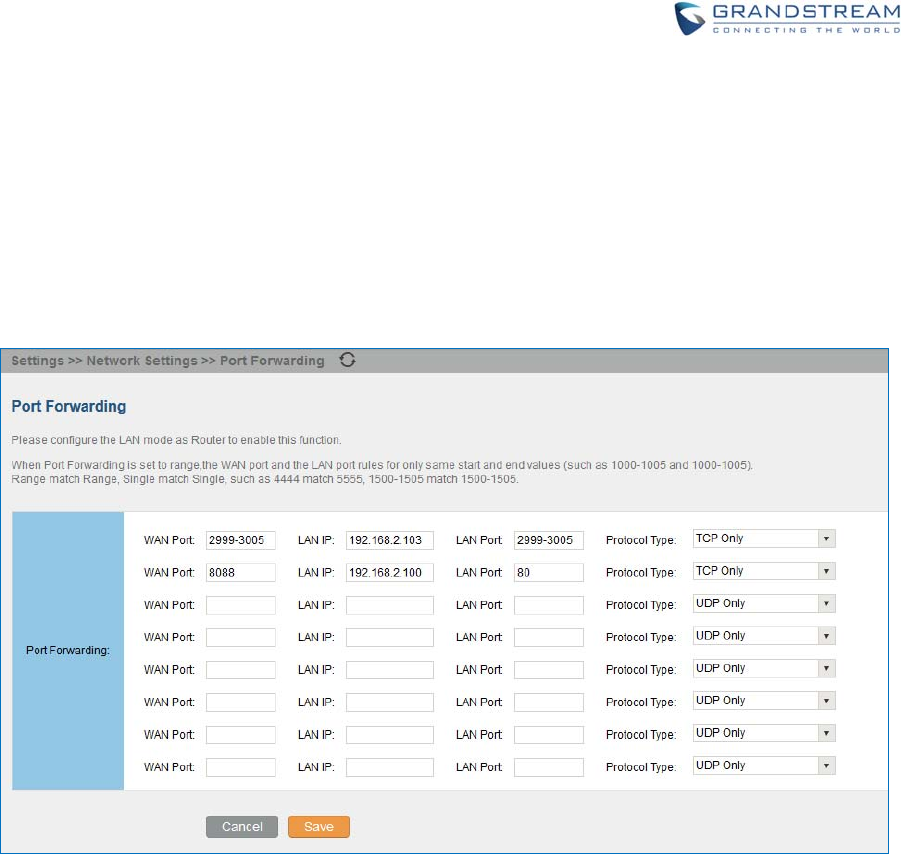
Firmware Version 1.0.0.1 UCM6200 Series IP PBX User Manual Page 56 of 320
There is a GXP2160 connected under the LAN interface network of the UCM6202/UCM6204. It
obtains IP address 192.168.2.100 from UCM6200 DHCP pool
On the UCM6202/UCM6204 web UI->Settings->Network Settings->Port Forwarding, configure a
port forwarding entry as the figure shows below.
WAN Port: This is the port opened up on the WAN side for access purpose.
LAN IP: This is the GXP2160 IP address, under the LAN interface network of the
UCM6202/UCM6204.
Protocol Type: We select TCP here for web UI access using HTTP.
Figure 28: UCM6202/UCM6204 Port Forwarding Configuration
This will allow users to access the GXP2160 web UI from public side, by typing in address “1.1.1.1:8088”.
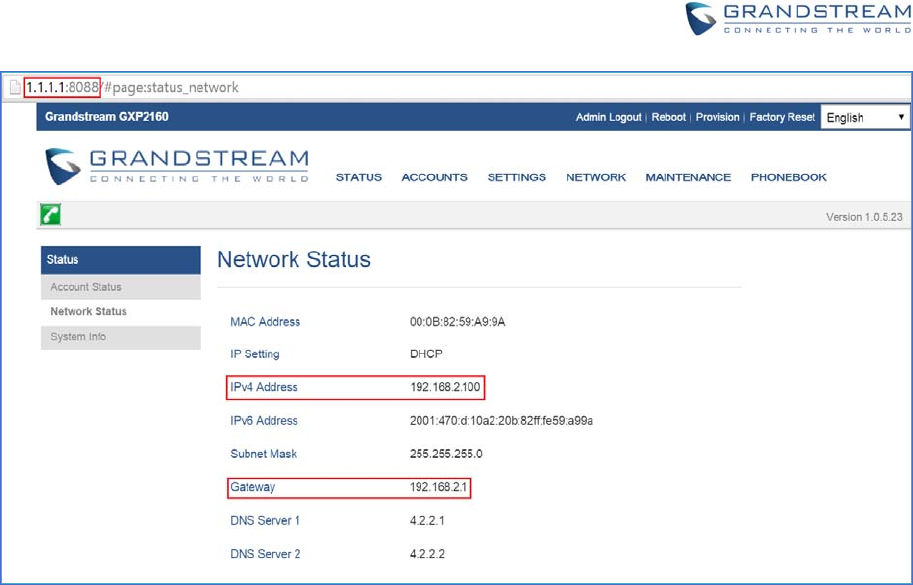
Firmware Version 1.0.0.1 UCM6200 Series IP PBX User Manual Page 57 of 320
Figure 29: GXP2160 Web Access Using UCM6202 Port Forwarding
DDNSSETTINGS
DDNS setting allows user to access UCM6200 via domain name instead of IP address.
The UCM supports DDNS service from the following DDNS provider:
dydns.org
noip.com
freedns.afraid.org
zoneedit.com
oray.net
Here is an example of using noip.com for DDNS.
1. Register domain in DDNS service provider. Please note the UCM6200 needs to have public IP access.
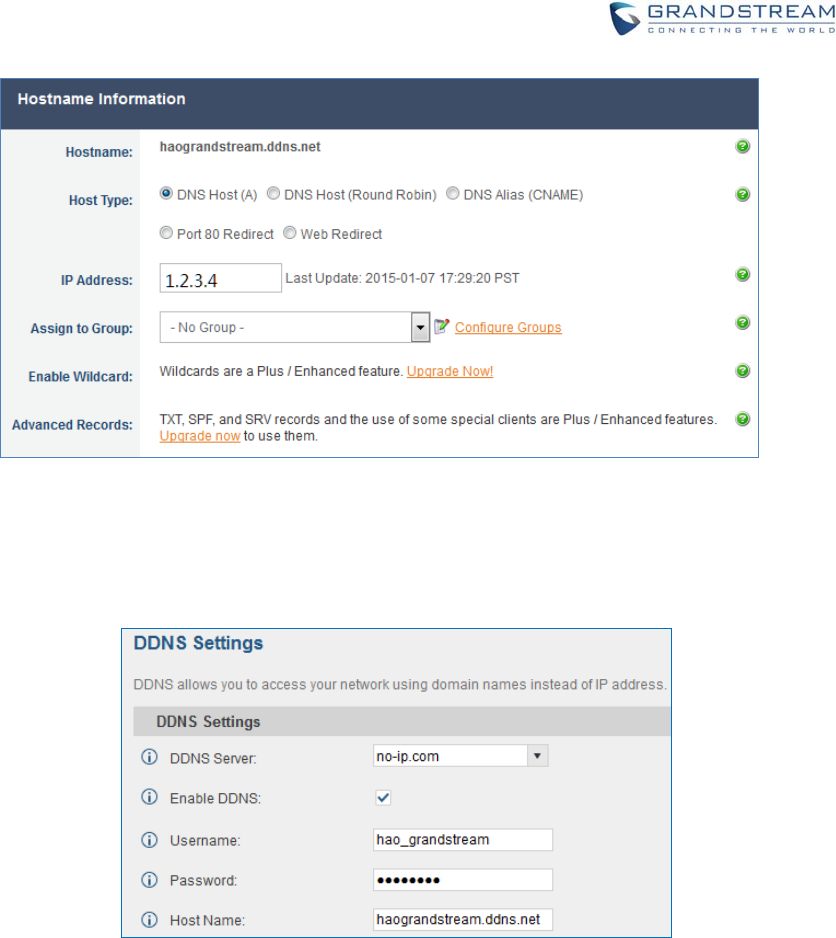
Firmware Version 1.0.0.1 UCM6200 Series IP PBX User Manual Page 58 of 320
Figure 30: Register Domain Name on noip.com
2. On web UI->Settings->Network Settings->DDNS Settings, enable DDNS service and configure
username, password and host name.
Figure 31: UCM6200 DDNS Setting
3. Now you can use domain name instead of IP address to connect to the UCM6200 web UI.
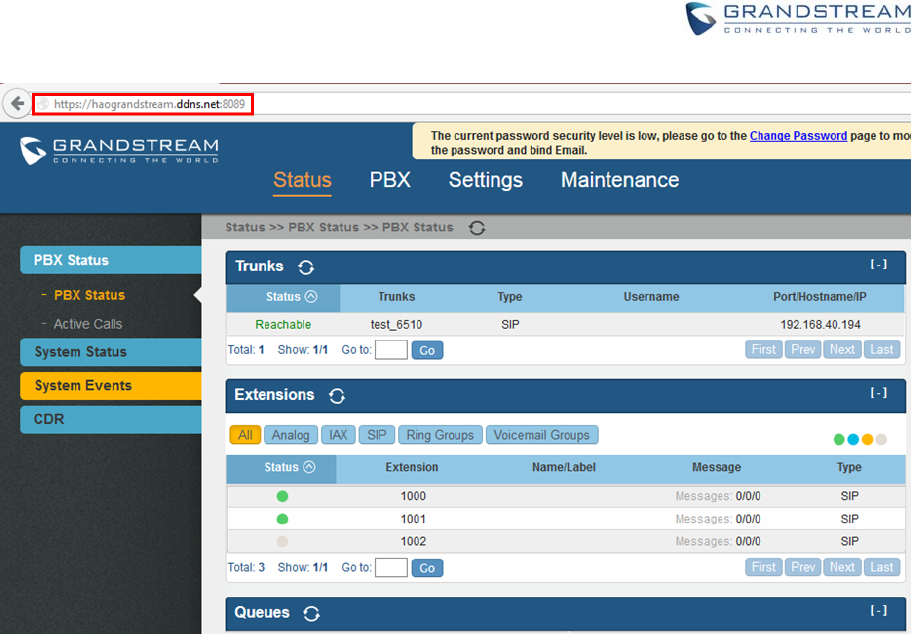
Firmware Version 1.0.0.1 UCM6200 Series IP PBX User Manual Page 59 of 320
Figure 32: Using Domain Name to Connect to UCM6200
FIREWALL
The UCM6200 provides users firewall configurations to prevent certain malicious attack to the UCM6200
system. Users could configure to allow, restrict or reject specific traffic through the device for security and
bandwidth purpose. The UCM6200 also provides Fail2ban feature for authentication errors in SIP
REGISTER, INVITE and SUBSCRIBE. To configure firewall settings in the UCM6200, go to Web
UI->Settings->Firewall page.
STATICDEFENSE
Under Web GUI->Settings->Firewall->Static Defense page, users will see the following information:
Current service information with port, process and type.
Typical firewall settings.
Custom firewall settings.
The following table shows a sample current service status running on the UCM6200.

Firmware Version 1.0.0.1 UCM6200 Series IP PBX User Manual Page 60 of 320
Table 14: UCM6200 Firewall->Static Defense->Current Service
Port Process Type Protocol or Service
7777 Asterisk tcp/IPv4 SIP
389 Slapd tcp/IPv4 LDAP
22 Dropbear tcp/IPv4 SSH
80 Lighthttpd tcp/IPv4 HTTP
8089 Lighthttpd tcp/IPv4 HTTPS
69 Opentftpd udp/IPv4 TFTP
9090 Asterisk udp/IPv4 SIP
6060 zero_config udp/IPv4 UCM6200 zero_config service
5060 Asterisk udp/IPv4 SIP
4569 Asterisk udp/IPv4 SIP
5353 zero_config udp/IPv4 UCM6200 zero_config service
37435 Syslogd udp/IPv4 Syslog
For typical firewall settings, users could configure the following options on the UCM6200.
Table 15: Typical Firewall Settings
Ping Defense
Enable
If enabled, ICMP response will not be allowed for Ping request. The default
setting is disabled. To enable or disable it, click on the check box for the LAN or
WAN (UCM6202/UCM6204) interface.
Ping-of-Death
Defense Enable
Enable to prevent Ping-of-Death attack to the device. The default setting is
disabled. To enable or disable it, click on the check box for the LAN or WAN
(UCM6202/UCM6204) interface.
Under "Custom Firewall Settings", users could create new rules to accept, reject or drop certain traffic
going through the UCM6200. To create new rule, click on "Create New Rule" button and a new window will
pop up for users to specify rule options.
Right next to "Create New Rule" button, there is a checkbox for option "Reject Rules". If it’s checked, all
the rules will be rejected except the firewall rules listed below. In the firewall rules, only when there is a rule
that meets all the following requirements, the option "Reject Rules" will be allowed to check:
Action: "Accept"
Type "In"
Destination port is set to the system login port (e.g., by default 8089)
Protocol is not UDP
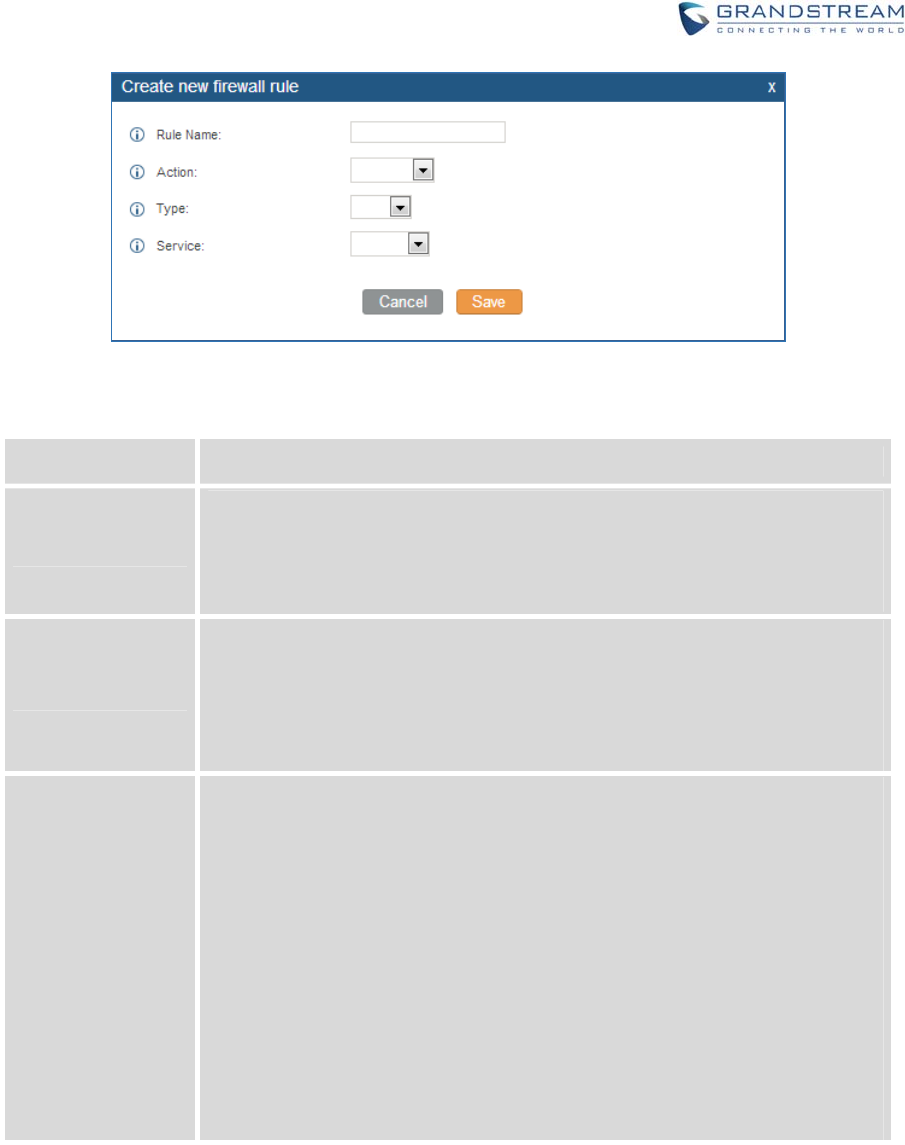
Firmware Version 1.0.0.1 UCM6200 Series IP PBX User Manual Page 61 of 320
Figure 33: Create New Firewall Rule
Table 16: Firewall Rule Settings
Rule Name Specify the Firewall rule name to identify the firewall rule.
Action
Select the action for the Firewall to perform.
ACCEPT
REJECT
DROP
Type
Select the traffic type.
IN
If selected, users will need specify the network interface "LAN" or "WAN"
(for UCM6202/UCM6204) for the incoming traffic.
OUT
Service
Select the service type.
FTP
SSH
Telnet
TFTP
HTTP
LDAP
Custom
If "Custom" is selected, users will need specify Source (IP and port),
Destination (IP and port) and Protocol (TCP, UDP or Both) for the service.
Please note if the source or the destination field is left blank, it will be used
as "Anywhere".
Save the change and click on "Apply" button. Then submit the configuration by clicking on "Apply
Changes" on the upper right of the web page. The new rule will be listed at the bottom of the page with
sequence number, rule name, action, protocol, type, source, destination and operation. More operations
below:
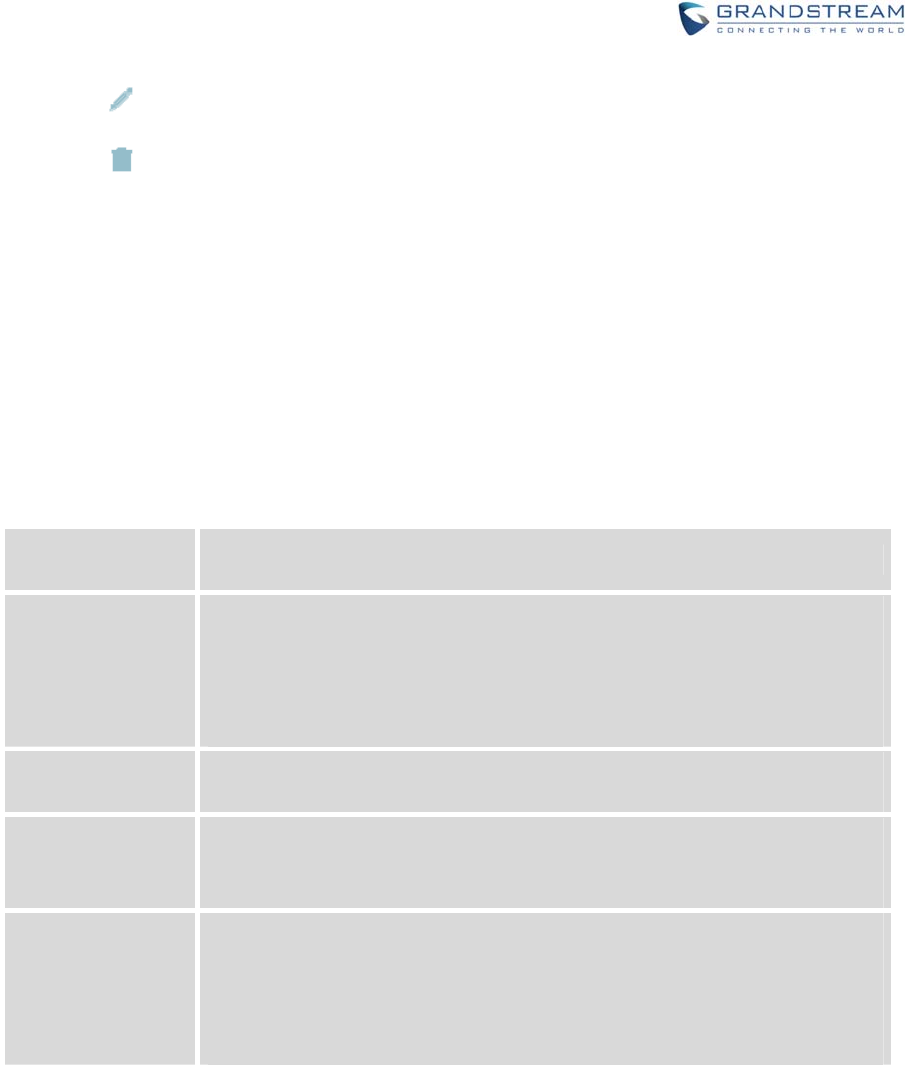
Firmware Version 1.0.0.1 UCM6200 Series IP PBX User Manual Page 62 of 320
Click on to edit the rule
Click on to delete the rule
DYNAMICDEFENSE
Dynamic defense is supported on the UCM6200 series. It can blacklist hosts dynamically when the LAN
mode is set to "Route" under web GUI->Settings->Network Settings->Basic Settings page. If enabled,
the traffic coming into the UCM6200 can be monitored, which helps prevent massive connection attempts
or brute force attacks to the device. The blacklist can be created and updated by the UCM6200 firewall,
which will then be displayed in the web page. Please refer to the following table for dynamic defense
options on the UCM6200.
Table 17: UCM6200 Firewall Dynamic Defense
Dynamic Defense
Enable Enable dynamic defense. The default setting is disabled.
Periodical Time
Interval
Configure the dynamic defense periodic time interval (in minutes). If the
number of TCP connections from a host exceeds the connection threshold
within this period, this host will be added into Blacklist. The valid value is
between 1 and 59 when dynamic defense is turned on. The default setting is
59.
Blacklist Update
Interval
Configure the blacklist update time interval (in seconds). The default setting is
120.
Connection
Threshold
Configure the connection threshold. Once the number of connections from the
same host reaches the threshold, it will be added into the blacklist. The default
setting is 100.
Dynamic Defense
Whitelist
Configure the dynamic defense whitelist.
For example,
192.168.1.3
192.168.1.4
The following figure shows a configuration example like this:
If a host at IP address 192.168.40.7 initiates more than 20 TCP connections to the UCM6200 within 1
minute, it will be added into UCM6200 blacklist.
This host 192.168.40.7 will be blocked by the UCM6200 for 300 seconds.
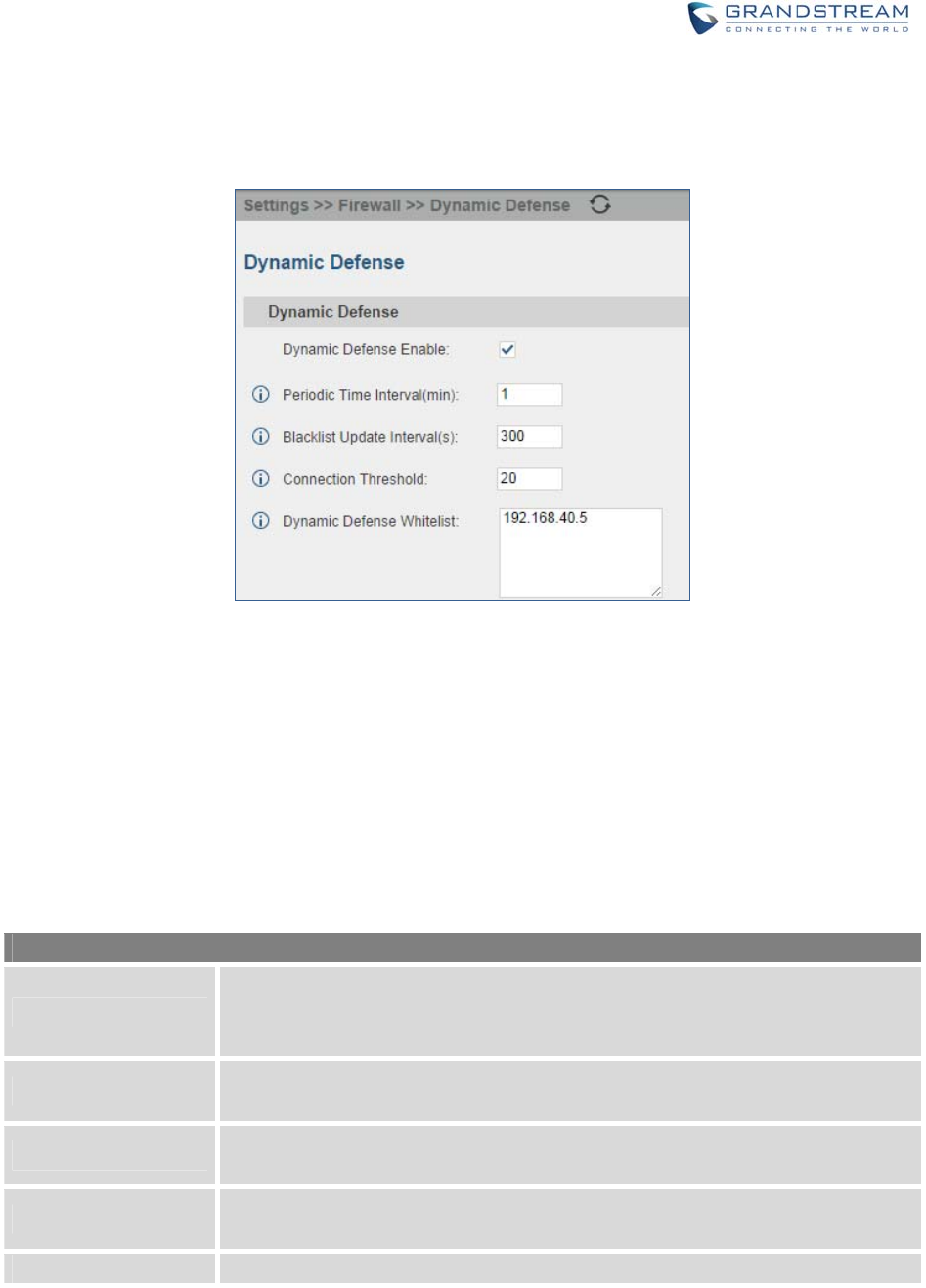
Firmware Version 1.0.0.1 UCM6200 Series IP PBX User Manual Page 63 of 320
Since IP address 192.168.40.5 is in whitelist, if the host at IP address 192.168.40.5 initiates more than
20 TCP connections to the UCM6200 within 1 minute, it will not be added into UCM6200 blacklist. It
can still establish TCP connection with the UCM6200.
Figure 34: Configure Dynamic Defense
FAIL2BAN
Fail2Ban feature on the UCM6200 provides intrusion detection and prevention for authentication errors in
SIP REGISTER, INVITE and SUBSCRIBE. Once the entry is detected within "Max Retry Duration", the
UCM6200 will take action to forbid the host for certain period as defined in "Banned Duration". This feature
helps prevent SIP brute force attacks to the PBX system.
Table 18: Fail2Ban Settings
Global Settings
Enable Fail2Ban
Enable Fail2Ban. The default setting is disabled. Please make sure both "Enable
Fail2Ban" and "Asterisk Service" are turned on in order to use Fail2Ban for SIP
authentication on the UCM6200.
Banned Duration Configure the duration (in seconds) for the detected host to be banned. The
default setting is 300. If set to -1, the host will be always banned.
Max Retry Duration Within this duration (in seconds), if a host exceeds the max times of retry as
defined in "MaxRetry", the host will be banned. The default setting is 5.
MaxRetry Configure the number of authentication failures during "Max Retry Duration"
before the host is banned. The default setting is 10.
Fail2Ban Whitelist Configure IP address, CIDR mask or DNS host in the whiltelist. Fail2Ban will not
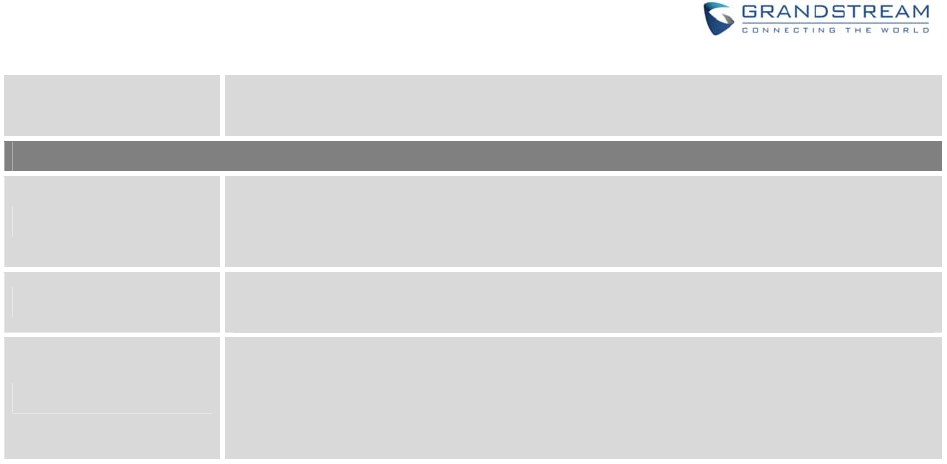
Firmware Version 1.0.0.1 UCM6200 Series IP PBX User Manual Page 64 of 320
ban the host with matching address in this list. Up to 5 addresses can be added
into the list.
Local Settings
Asterisk Service
Enable Asterisk service for Fail2Ban. The default setting is disabled. Please make
sure both "Enable Fail2Ban" and "Asterisk Service" are turned on in order to use
Fail2Ban for SIP authentication on the UCM6200.
Protocol Configure the listening port number for the service. Currently only 5060 (for UDP)
is supported.
MaxRetry
Configure the number of authentication failures during "Max Retry Duration"
before the host is banned. The default setting is 10. Please make sure this option
is properly configured as it will override the "MaxRetry" value under "Global
Settings".
LDAPSERVER
The UCM6200 has an embedded LDAP server for users to manage corporate phonebook in a centralized
manner.
By default, the LDAP server has generated the first phonebook with PBX DN
"ou=pbx,dc=pbx,dc=com" based on the UCM6200 user extensions already.
Users could add new phonebook with a different Phonebook DN for other external contacts. For
example, "ou=people,dc=pbx,dc=com".
All the phonebooks in the UCM6200 LDAP server have the same Base DN "dc=pbx,dc=com".
Term Explanation:
cn= Common Name
ou= Organization Unit
dc= Domain Component
These are all parts of the LDAP data Interchange Format, according to RFC 2849, which is how the LDAP
tree is filtered.
If users have the Grandstream phone provisioned by the UCM6200, the LDAP directory will be set up on
the phone and can be used right away for users to access all phonebooks.
Additionally, users could manually configure the LDAP client settings to manipulate the built-in LDAP
server on the UCM6200. If the UCM6200 has multiple LDAP phonebooks created, in the LDAP client
configuration, users could use "dc=pbx,dc=com" as Base DN to have access to all phonebooks on the
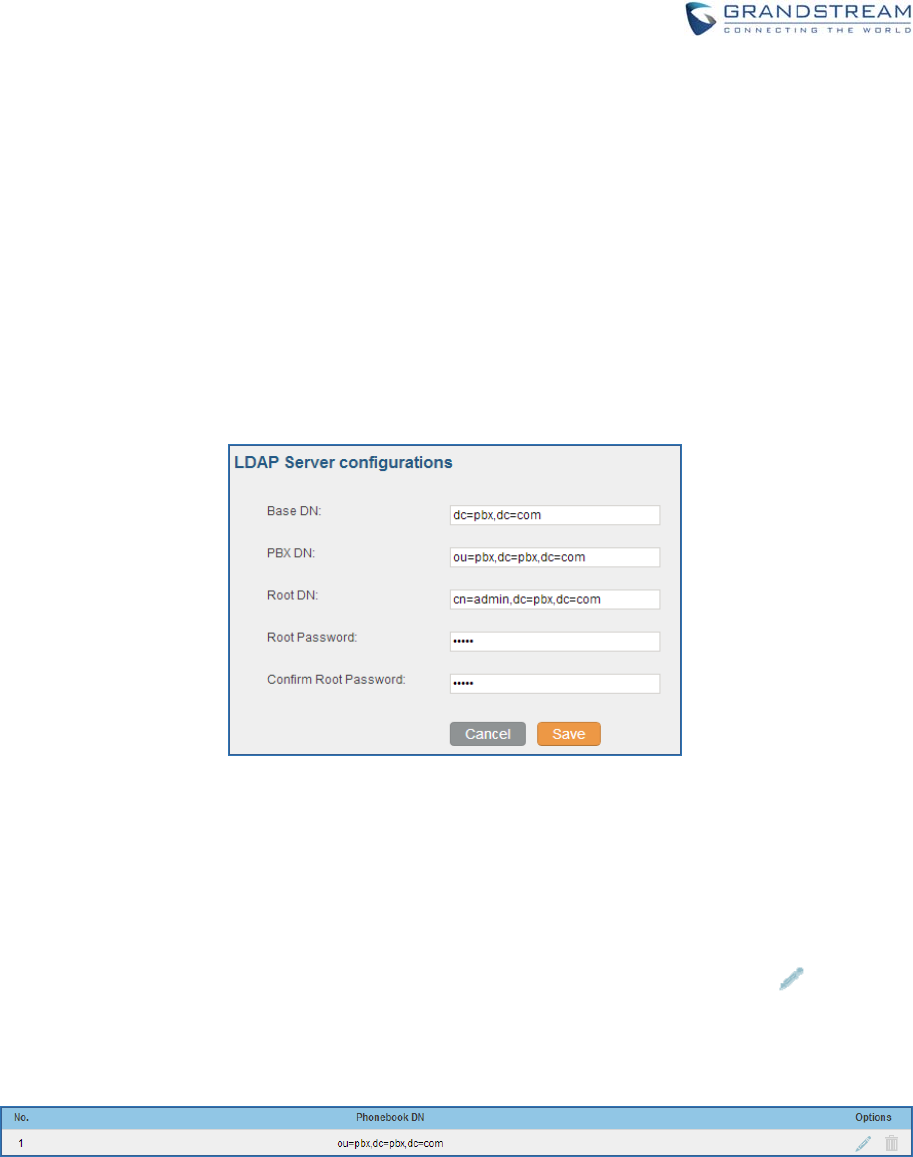
Firmware Version 1.0.0.1 UCM6200 Series IP PBX User Manual Page 65 of 320
UCM6200 LDAP server, or use a specific phonebook DN, for example "ou=people,dc=pbx,dc=com", to
access to phonebook with Phonebook DN "ou=people,dc=pbx,dc=com " only.
UCM can also act as a LDAP client to download phonebook entries from other LDAP server.
To access LDAP server and client settings, go to Web GUI->Settings->LDAP Server.
LDAPSERVERCONFIGURATIONS
The following figure shows the default LDAP server configurations on the UCM6200.
Figure 35: LDAP Server Configurations
The UCM6200 LDAP server supports anonymous access (read-only) by default. Therefore the LDAP client
doesn't have to configure username and password to access the phonebook directory. The "Root DN" and
"Root Password" here are for LDAP management and configuration where users will need provide for
authentication purpose before modifying the LDAP information.
The default phonebook list in this LDAP server can be viewed and edited by clicking on for the first
phonebook under LDAP Phonebook.
Figure 36: Default LDAP Phonebook DN
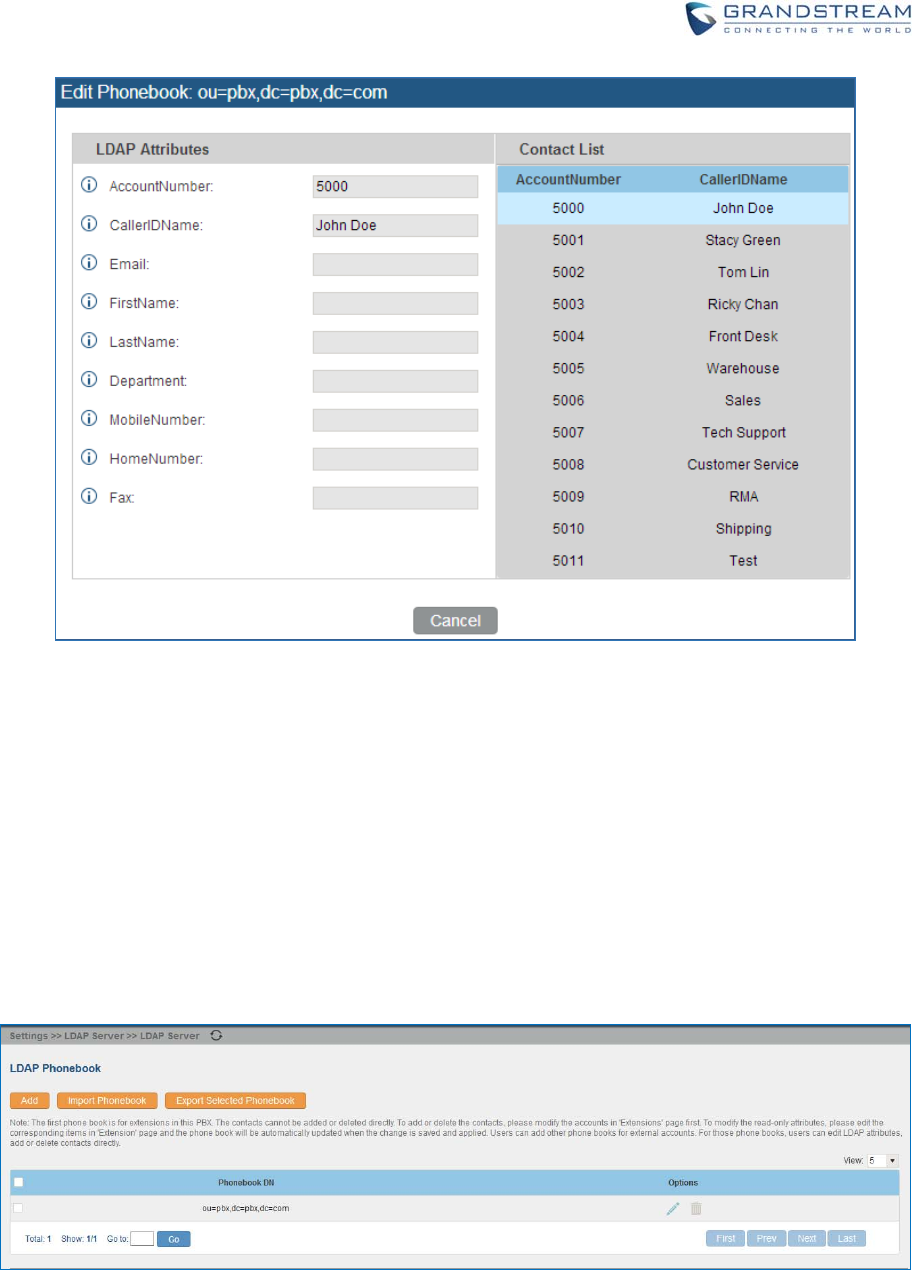
Firmware Version 1.0.0.1 UCM6200 Series IP PBX User Manual Page 66 of 320
Figure 37: Default LDAP Phonebook Attributes
LDAPPHONEBOOK
Users could use the default phonebook, edit the default phonebook, add new phonebook, import
phonebook on the LDAP server as well as export phonebook from the LDAP server. The first phonebook
with default phonebook dn "ou=pbx,dc=pbx,dc=com" displayed on the LDAP server page is for extensions
in this PBX. Users cannot add or delete contacts directly. The contacts information will need to be modified
via Web GUI->PBX->Basic/Call Routes->Extensions first. The default LDAP phonebook will then be
updated automatically.
Figure 38: LDAP Server->LDAP Phonebook
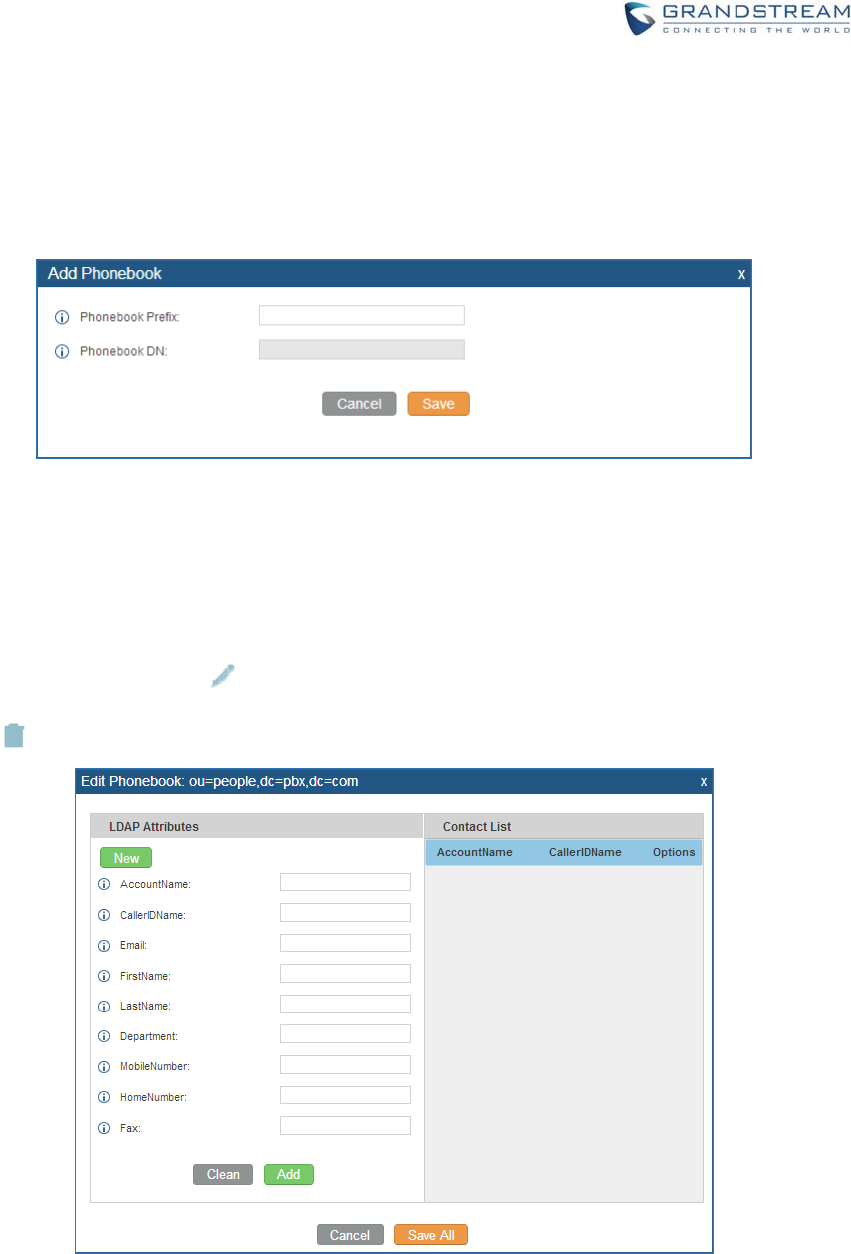
Firmware Version 1.0.0.1 UCM6200 Series IP PBX User Manual Page 67 of 320
Add new phonebook
A new sibling phonebook of the default PBX phonebook can be added by clicking on "Add" under
"LDAP Phonebook" section.
Figure 39: Add LDAP Phonebook
Configure the "Phonebook Prefix" first. The "Phonebook DN" will be automatically filled in. For example, if
configuring "Phonebook Prefix" as "people", the "Phonebook DN" will be filled with
"ou=people,dc=pbx,dc=com".
Once added, users can select to edit the phonebook attributes and contact list (see figure below), or
select to delete the phonebook.
Figure 40: Edit LDAP Phonebook
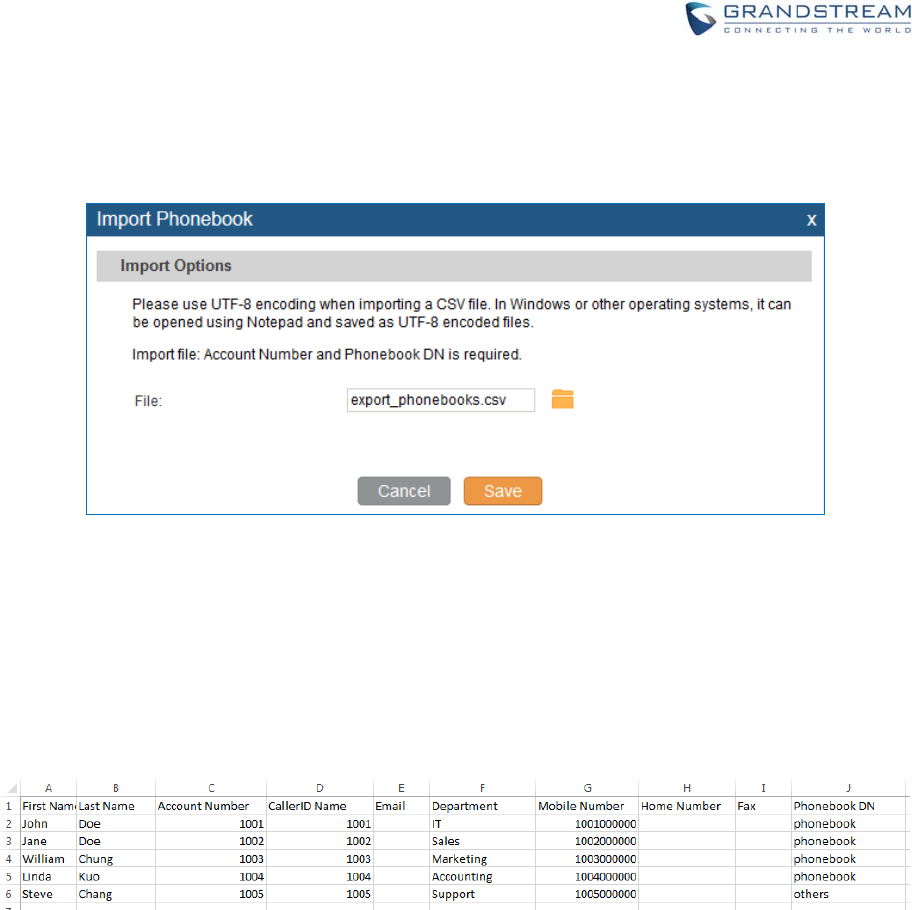
Firmware Version 1.0.0.1 UCM6200 Series IP PBX User Manual Page 68 of 320
Import phonebook from your computer to LDAP server
Click on “Import Phonebook” and a dialog will prompt as shown in the figure below.
Figure 41: Import Phonebook
The file to be imported must be a CSV file with UTF-8 encoding. Users can open the CSV file with
Notepad and save it with UTF-8 encoding.
Here is how a sample file looks like. Please note “Account Number” and “Phonebook DN” fields are
required. Users could export a phonebook file from the UCM6200 LDAP phonebook section first and
use it as a sample to start with.
Figure 42: Phonebook CSV File Format
The Phonebook DN field is the same “Phonebook Prefix” entry as when the user clicks on “Add” to
create a new phonebook. Therefore, if the user enters “phonebook” in “Phonebook DN” field in the
CSV file, the actual phonebook DN “ou=phonebook,dc=pbx,dc=com” will be automatically created by
the UCM6200 once the CSV file is imported.
In the CSV file, users can specify different phonebook DN fields for different contacts. If the phonebook
DN already exists on the UCM6200 LDAP Phonebook, the contacts in the CSV file will be added into
the existing phonebook. If the phonebook DN doesn’t exist on the UCM6200 LDAP Phonebook, a new
phonebook with this phonebook DN will be created.
The sample phonebook CSV file in above picture will result in the following LDAP phonebook in the
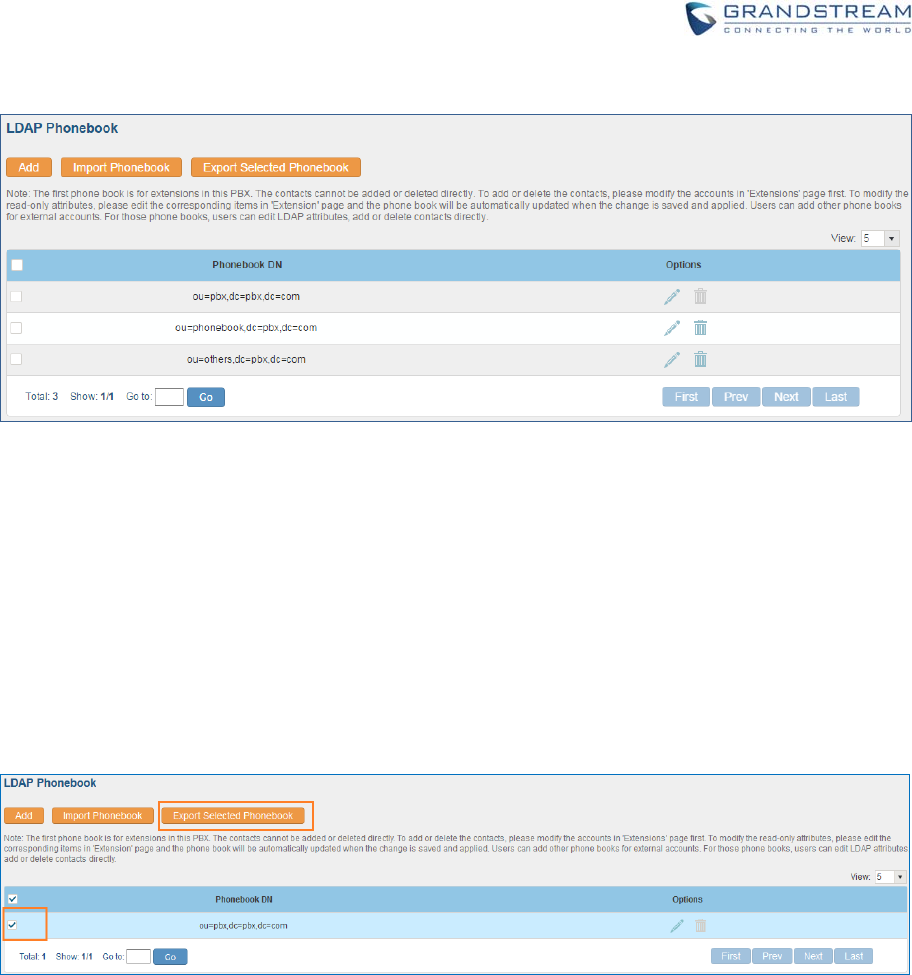
Firmware Version 1.0.0.1 UCM6200 Series IP PBX User Manual Page 69 of 320
UCM6200.
Figure 43: LDAP Phonebook After Import
As the default LDAP phonebook with DN “ou=pbx,dc=pbx,dc=com” cannot be edited or deleted in
LDAP phonebook section, users cannot import contacts with Phonebook DN field “pbx” if existed in the
CSV file.
Export phonebook to your computer from UCM6200 LDAP server
Select the checkbox for the LDAP phonebook and then click on “Export Selected Phonebook” to
export the selected phonebook. The exported phonebook can be used as a record or a sample CSV
file for the users to add more contacts in it and import to the UCM6200 again.
Figure 44: Export Selected LDAP Phonebook
LDAPCLIENTCONFIGURATIONS
The configuration on LDAP client is similar when you use other LDAP servers. Here we provide an
example on how to configure the LDAP client on the SIP end points to use the default PBX phonebook.
Assuming the server base dn is "dc=pbx,dc=com", configure the LDAP clients as follows (case
insensitive):
Server Address: LDAP server IP address
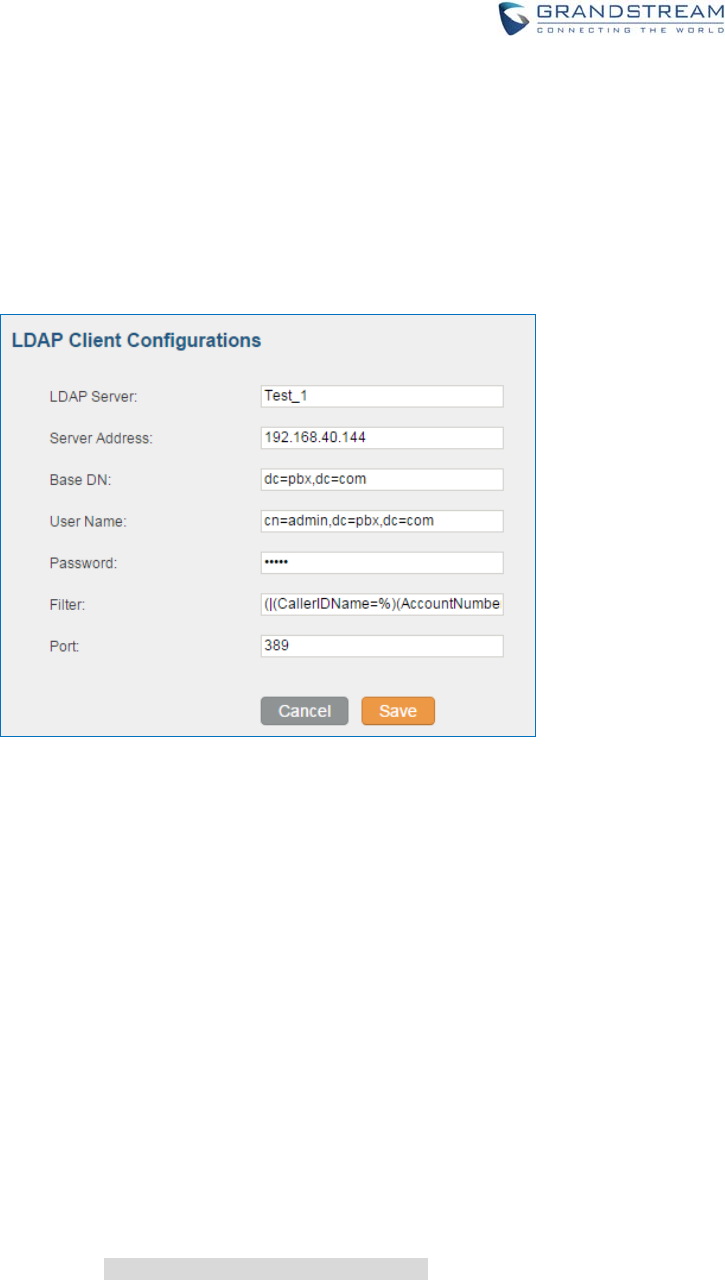
Firmware Version 1.0.0.1 UCM6200 Series IP PBX User Manual Page 70 of 320
Base DN: dc=pbx,dc=com
User Name: cn= “LDAP server login name”, dc=pbx, dc=com [matching LDAP server format]
Password: “LDAP server login password”
Filter: (|(CallerIDName=%)(AccountNumber=%))
Port: 389
The following figure gives a sample configurations for UCM6200 acting as a LDAP client.
Figure 45: LDAP Client Configurations
To configure Grandstream IP phones as the LDAP client, please refer to the following example:
Server Address: The IP address or domain name of the UCM6200
Base DN: dc=pbx,dc=com
User Name: Please leave this field empty
Password: Please leave this field empty
LDAP Name Attribute: CallerIDName Email Department FirstName LastName
LDAP Number Attribute: AccountNumber MobileNumber HomeNumber Fax
LDAP Number Filter: (AccountNumber=%)
LDAP Name Filter: (CallerIDName=%)
LDAP Display Name: AccountNumber CallerIDName
LDAP Version: If existed, please select LDAP Version 3
Port: 389
The following figure shows the configuration information on a Grandstream GXP2200 to successfully use
the LDAP server as configured in Figure 35: LDAP Server Configurations.
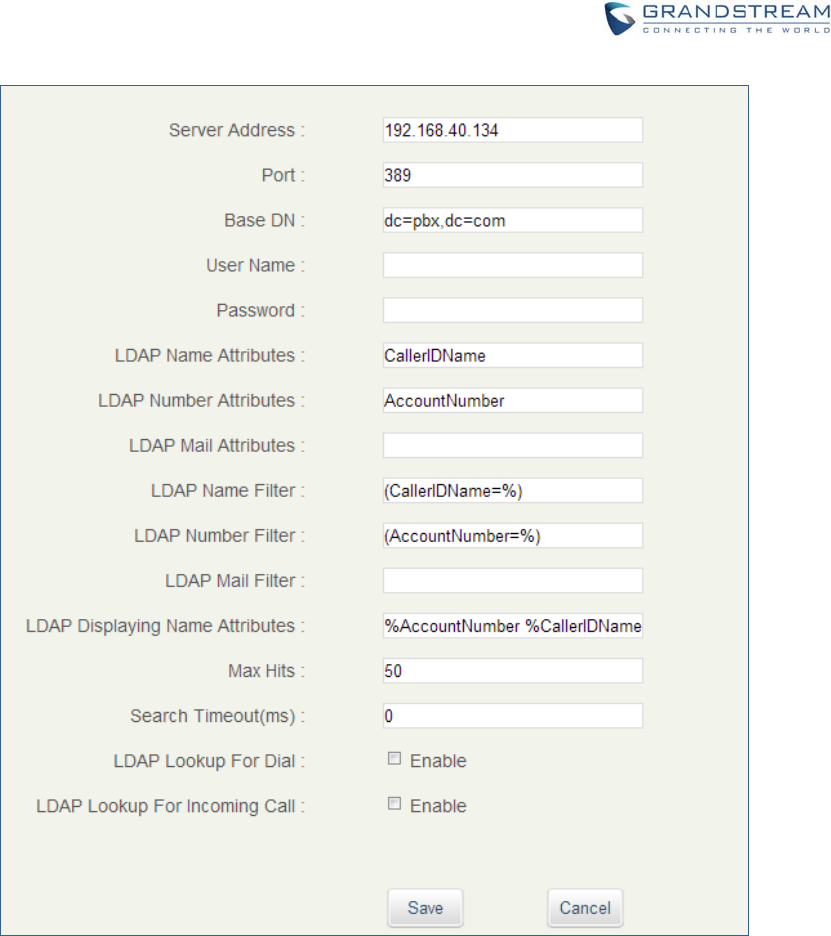
Firmware Version 1.0.0.1 UCM6200 Series IP PBX User Manual Page 71 of 320
Figure 46: GXP2200 LDAP Phonebook Configuration
HTTPSERVER
The UCM6200 embedded web server responds to HTTP/HTTPS GET/POST requests. Embedded HTML
pages allow the users to configure the PBX through a Web browser such as Microsoft IE, Mozilla Firefox
and Google Chrome. By default, the PBX can be accessed via HTTPS using Port 8089 (e.g.,
https://192.168.40.50:8089). Users could also change the access protocol and port as preferred under
Web GUI->Settings->HTTP Server.
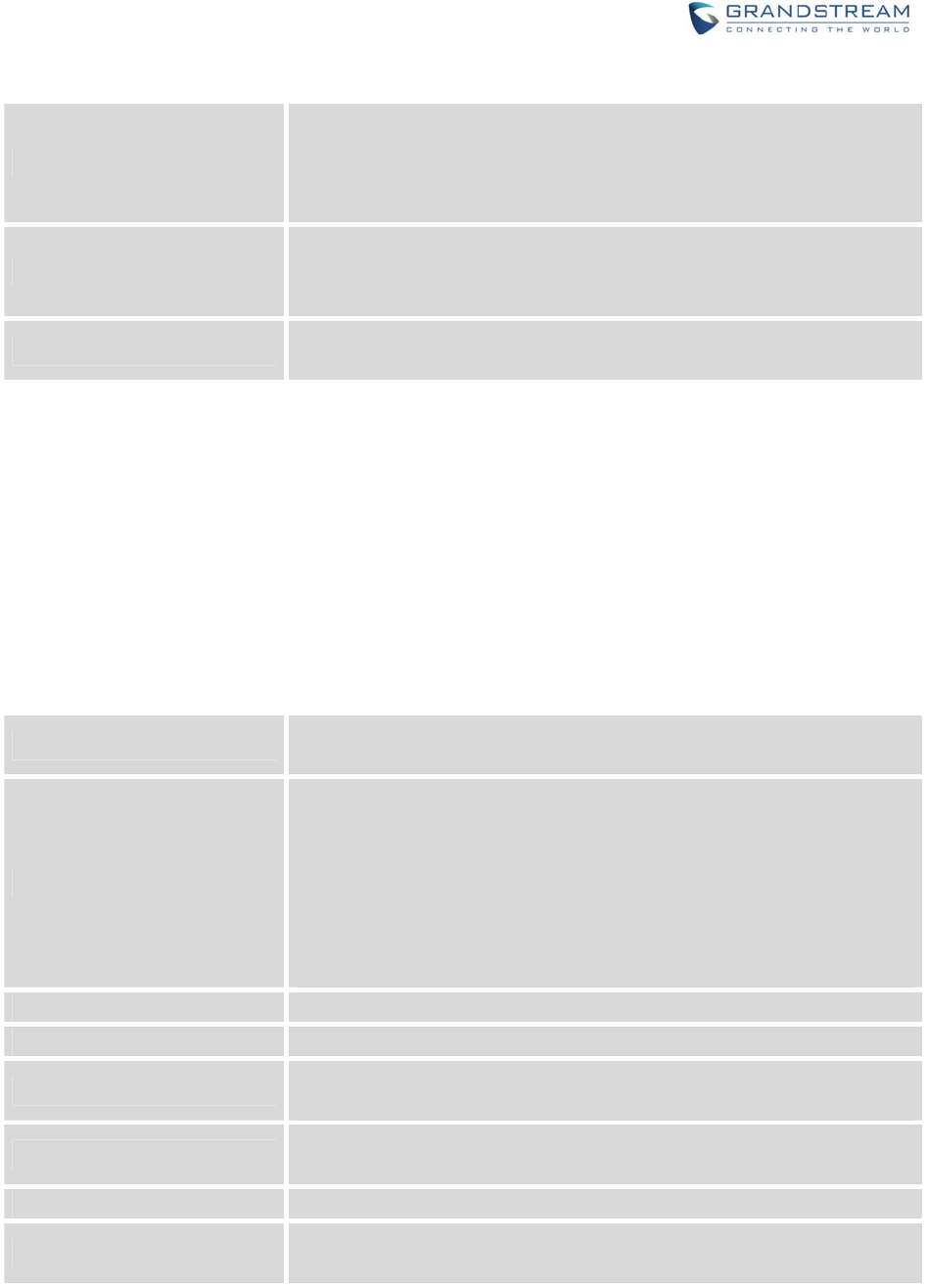
Firmware Version 1.0.0.1 UCM6200 Series IP PBX User Manual Page 72 of 320
Table 19: HTTP Server Settings
Redirect From Port 80
Enable or disable redirect from port 80. On the PBX, the default access
protocol is HTTPS and the default port number is 8089. When this option
is enabled, the access using HTTP with Port 80 will be redirected to
HTTPS with Port 8089. The default setting is "Enable".
Protocol Type
Select HTTP or HTTPS. The default setting is "HTTPS". This is also the
protocol used for zero config when the end point device downloads the
config file from the UCM6200.
Port Specify port number to access the HTTP server. The default port number
is 8089.
Once the change is saved, the web page will be redirected to the login page using the new URL. Enter the
username and password to login again.
EMAILSETTINGS
The Email application on the UCM6200 can be used to send out alert event Emails, Fax (Fax-To-Email),
Voicemail (Voicemail-To-Email) and etc. The configuration parameters can be accessed via Web
GUI->Settings->Email Settings.
Table 20: Email Settings
TLS Enable Enable or disable TLS during transferring/submitting your Email to other
SMTP server. The default setting is "Yes".
Type
Select Email type.
MTA: Mail Transfer Agent. The Email will be sent from the configured
domain. When MTA is selected, there is no need to set up SMTP
server for it or no user login is required. However, the Emails sent
from MTA might be considered as spam by the target SMTP server.
Client: Submit Emails to the SMTP server. A SMTP server is required
and users need login with correct credentials.
Domain Specify the domain name to be used in the Email when using type "MTA".
Server Specify the SMTP server when using type "Client".
Username Username is required when using type "Client". Normally it's the Email
address.
Password Password to login for the above Username (Email address) is required
when using type "Client".
Display Name Specify the display name in the FROM header in the Email.
Sender Specify the sender's Email address.
For example, pbx@example.mycompany.com.
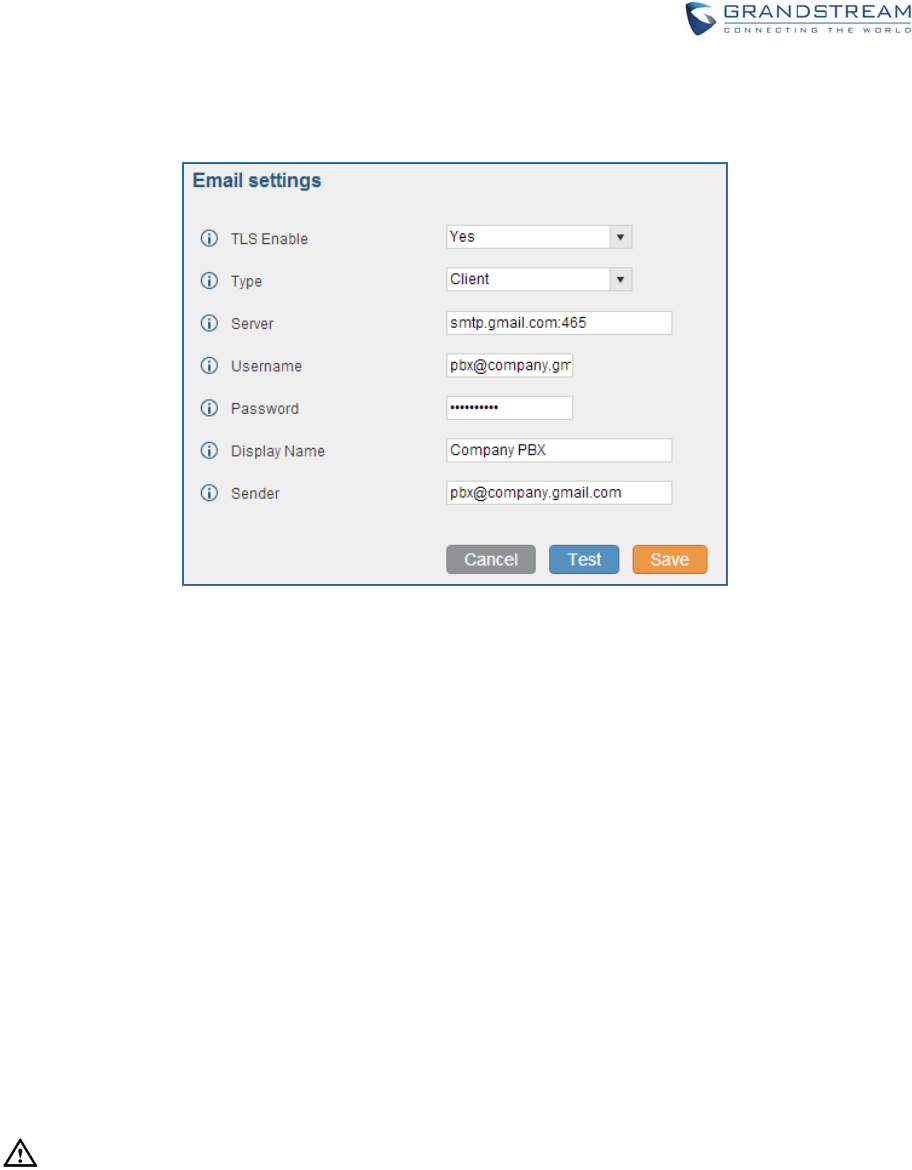
Firmware Version 1.0.0.1 UCM6200 Series IP PBX User Manual Page 73 of 320
The following figure shows a sample Email settings on the UCM6200, assuming the Email is using
smtp.gmail.com as the SMTP server.
Figure 47: UCM6200 Email Settings
Once the configuration is finished, click on "Test". In the prompt, fill in a valid Email address to send a test
Email to verify the Email settings on the UCM6200.
TIMESETTINGS
AUTOTIMEUPDATING
The current system time on the UCM6200 is displayed on the upper right of the web page. It can also be
found under Web GUI->Status->System Status->General.
To configure the UCM6200 to update time automatically, go to Web GUI->Settings->Time
Settings->Time Auto Updating.
--------------------------------------------------------------------------------------------------------------------------------------------
Note:
The configurations under Web GUI->Settings->Time Settings->Time Auto Updating page require
reboot to take effect. Please consider configuring auto time updating related changes when setting up the
UCM6200 for the first time to avoid service interrupt after installation and deployment in production.
--------------------------------------------------------------------------------------------------------------------------------------------

Firmware Version 1.0.0.1 UCM6200 Series IP PBX User Manual Page 74 of 320
Table 21: Time Auto Updating
Remote NTP Server
Specify the URL or IP address of the NTP server for the UCM6200 to
synchronize the date and time. The default NTP server is
ntp.ipvideotalk.com.
Enable DHCP Option 2
If set to "Yes", the UCM6200 is allowed to get provisioned for Time Zone
from DHCP Option 2 in the local server automatically. The default setting
is "Yes".
Enable DHCP Option 42
If set to "Yes", the UCM6200 is allowed to get provisioned for NTP Server
from DHCP Option 42 in the local server automatically. This will override
the manually configured NTP Server. The default setting is "Yes".
Time Zone
Select the proper time zone option so the UCM6200 can display correct
time accordingly.
If "Self-Defined Tome Zone" is selected, please specify the time zone
parameters in "Self-Defined Time Zone" field as described in below
option.
Self-Defined Time Zone
If "Self-Defined Time Zone" is selected in "Time Zone" option, users will
need define their own time zone following the format below.
The syntax is: std offset dst [offset], start [/time], end [/time]
Default is set to: MTZ+6MDT+5,M4.1.0,M11.1.0
MTZ+6MDT+5
This indicates a time zone with 6 hours offset and 1 hour ahead for DST,
which is U.S central time. If it is positive (+), the local time zone is west of
the Prime Meridian (A.K.A: International or Greenwich Meridian); If it is
negative (-), the local time zone is east.
M4.1.0,M11.1.0
The 1st number indicates Month: 1,2,3.., 12 (for Jan, Feb, .., Dec).
The 2nd number indicates the nth iteration of the weekday: (1st Sunday,
3rd Tuesday…). Normally 1, 2, 3, 4 are used. If 5 is used, it means the
last iteration of the weekday.
The 3rd number indicates weekday: 0,1,2,..,6 ( for Sun, Mon,
Tues, ... ,Sat).
Therefore, this example is the DST which starts from the First Sunday of
April to the 1st Sunday of November.
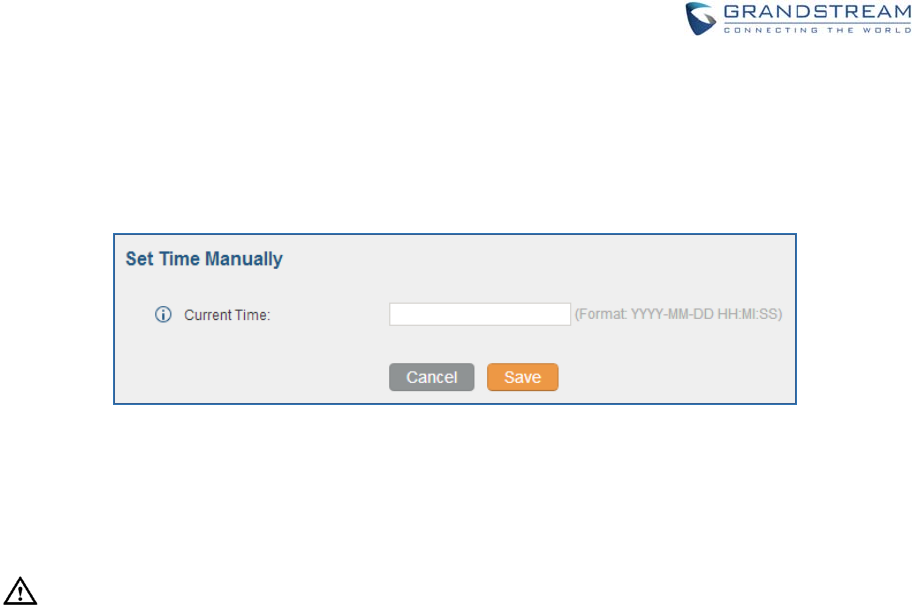
Firmware Version 1.0.0.1 UCM6200 Series IP PBX User Manual Page 75 of 320
SETTIMEMANUALLY
To manually set the time on the UCM6200, go to Web UI->Settings->Time Settings->Set Time Manually.
The format is YYYY-MM-DD HH:MI:SS.
Figure 48: Set Time Manually
--------------------------------------------------------------------------------------------------------------------------------------------
Note:
Manually setup time will take effect immediately after saving and applying change in the web UI. If users
would like to reboot the UCM6200 and keep the manually setup time setting, please make sure "Remote
NTP Server", "Enable DHCP Option 2" and "Enable DHCP Option 42" options under Web
GUI->Settings->Time Settings->Time Auto Updating page are unchecked or set to empty. Otherwise,
time auto updating settings in this page will take effect after reboot.
--------------------------------------------------------------------------------------------------------------------------------------------
OFFICETIME
On the UCM6200, the system administrator can define "office time", which can be used to configure time
condition for extension call forwarding schedule and inbound rule schedule. To configure office time, go to
Web UI->Settings->Time Settings->Office Time. Click on "Create New Office Time" to create an office
time.
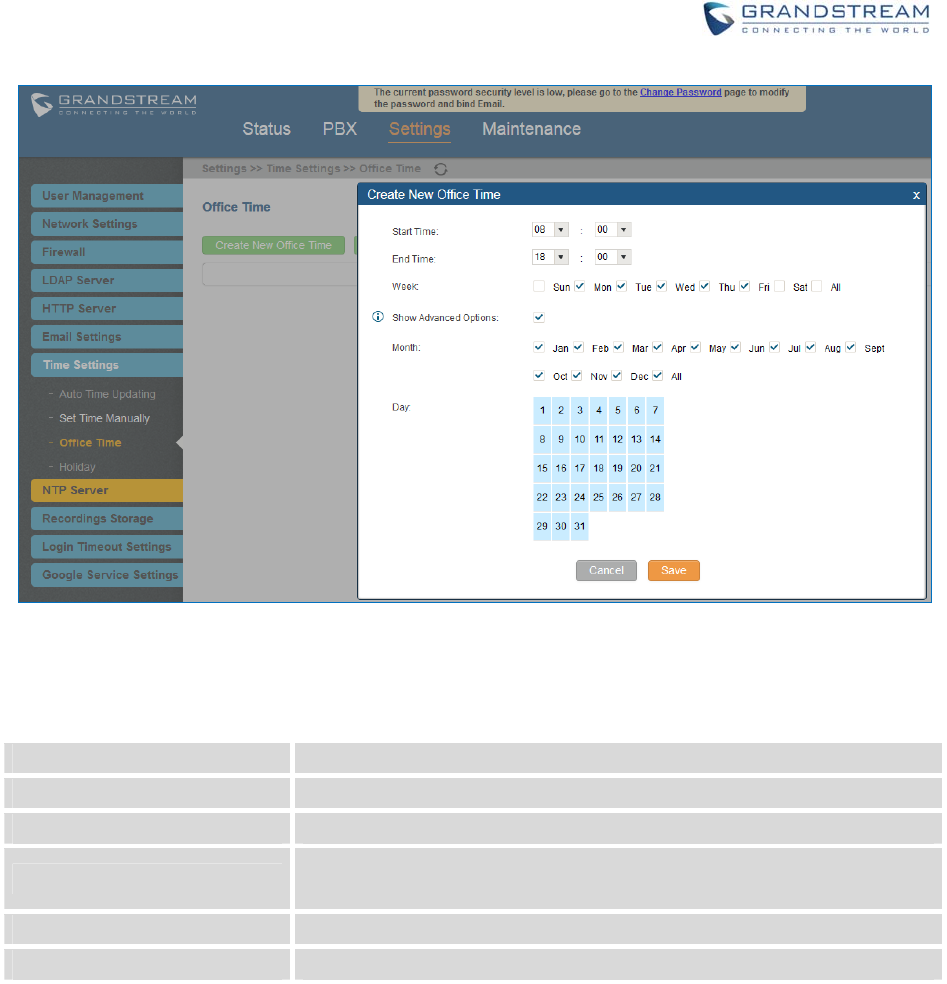
Firmware Version 1.0.0.1 UCM6200 Series IP PBX User Manual Page 76 of 320
Figure 49: Create New Office Time
Table 22: Create New Office Time
Start Time Configure the start time for office hour.
End Time Configure the end time for office hour
Week Select the work days in one week.
Show Advanced Options Check this options to show advanced options. Once selected, please
specify "Month" and "Day" below.
Month Select the months for office time.
Day Select the work days in one month.
Select "Start Time", "End Time" and the day for the "Week" for the office time. The system administrator
can also define month and day of the month as advanced options. Once done, click on "Save" and then
"Apply Change" for the office time to take effect. The office time will be listed in the web page as the figure
shows below.
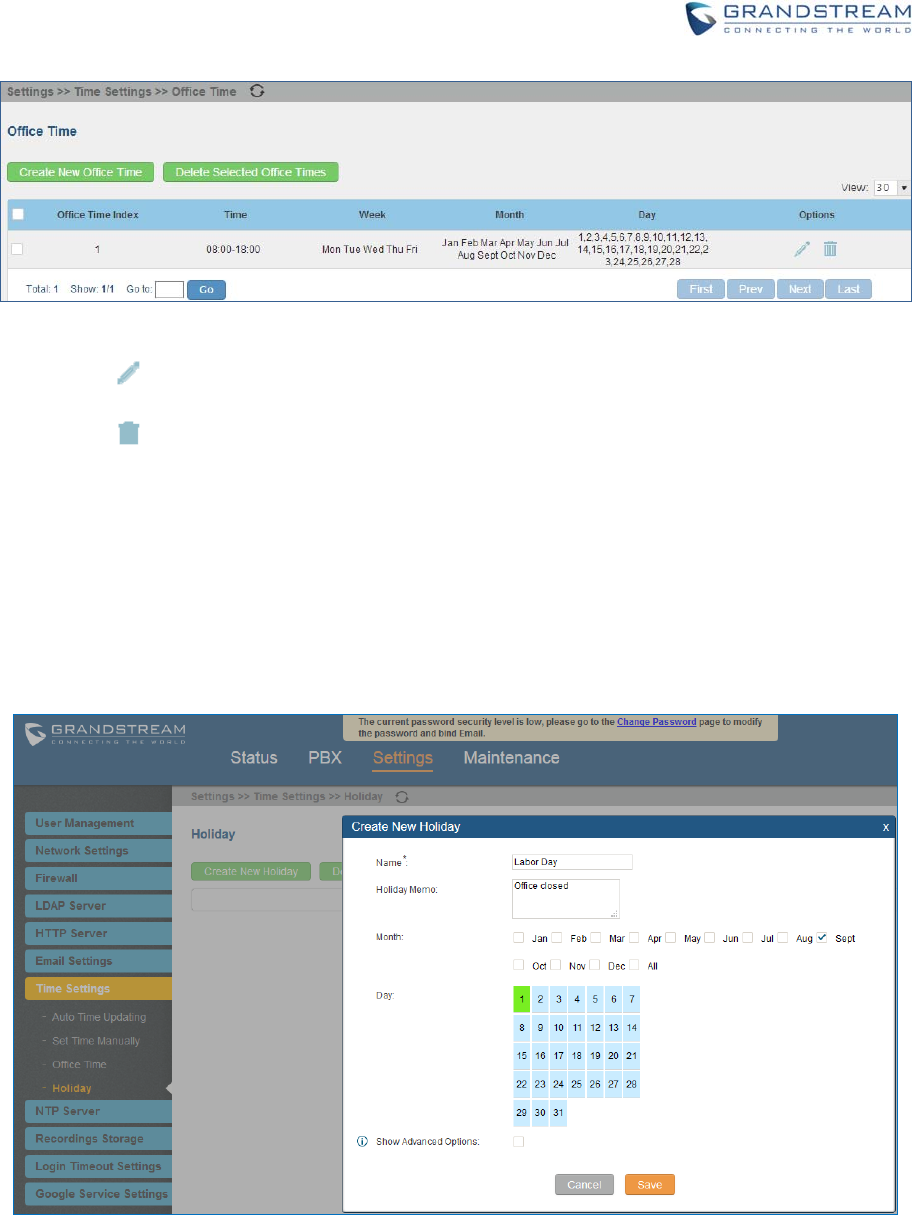
Firmware Version 1.0.0.1 UCM6200 Series IP PBX User Manual Page 77 of 320
Figure 50: Settings->Time Settings->Office Time
Click on to edit the office time.
Click on to delete the office time.
Click on "Delete Selected Office Times" to delete multiple selected office times at once.
HOLIDAY
On the UCM6200, the system administrator can define "holiday", which can be used to configure time
condition for extension call forwarding schedule and inbound rule schedule. To configure holiday, go to
Web UI->Settings->Time Settings->Holiday. Click on "Create New Holiday" to create holiday time.
Figure 51: Create New Holiday
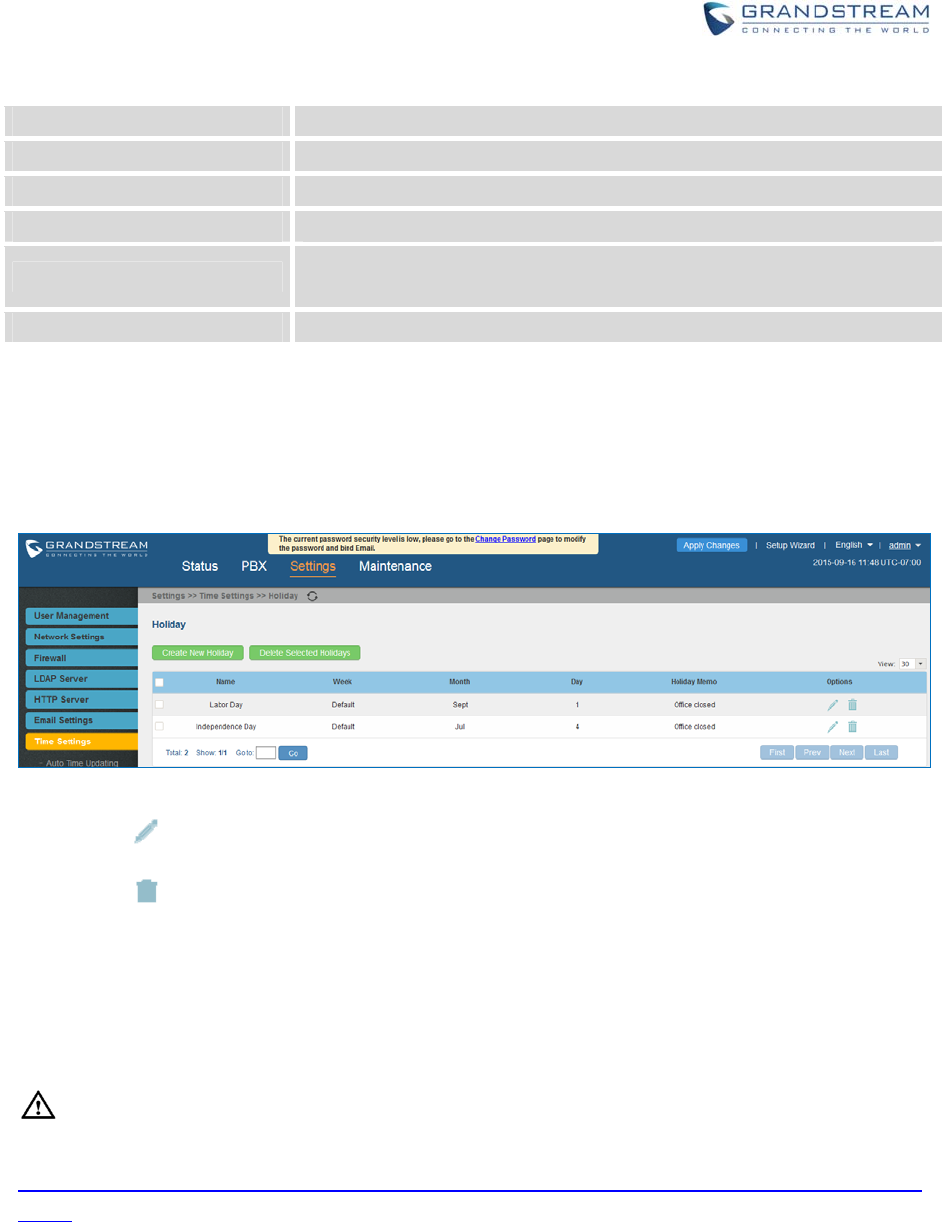
Firmware Version 1.0.0.1 UCM6200 Series IP PBX User Manual Page 78 of 320
Table 23: Create New Holiday
Name Specify the holiday name to identify this holiday.
Holiday Memo Create a note for the holiday.
Month Select the month for the holiday.
Day Select the day for the holiday.
Show Advanced Options Check this option to show advanced options. If selected, please specify
the days as holiday in one week below.
Week Select the days as holiday in one week.
Enter holiday "Name" and "Holiday Memo" for the new holiday. Then select "Month" and "Day". The
system administrator can also define days in one week as advanced options. Once done, click on "Save"
and then "Apply Change" for the holiday to take effect. The holiday will be listed in the web page as the
figure shows below.
Figure 52: Settings->Time Settings->Holiday
Click on to edit the holiday.
Click on to delete the holiday.
Click on "Delete Selected Holidays" to delete multiple selected holidays at once.
--------------------------------------------------------------------------------------------------------------------------------------------
Note:
For more details on how to use office time and holiday, please refer to the link below:
http://www.grandstream.com/sites/default/files/Resources/How_to_use_office_time_and_holiday_UCM62
00.pdf
--------------------------------------------------------------------------------------------------------------------------------------------
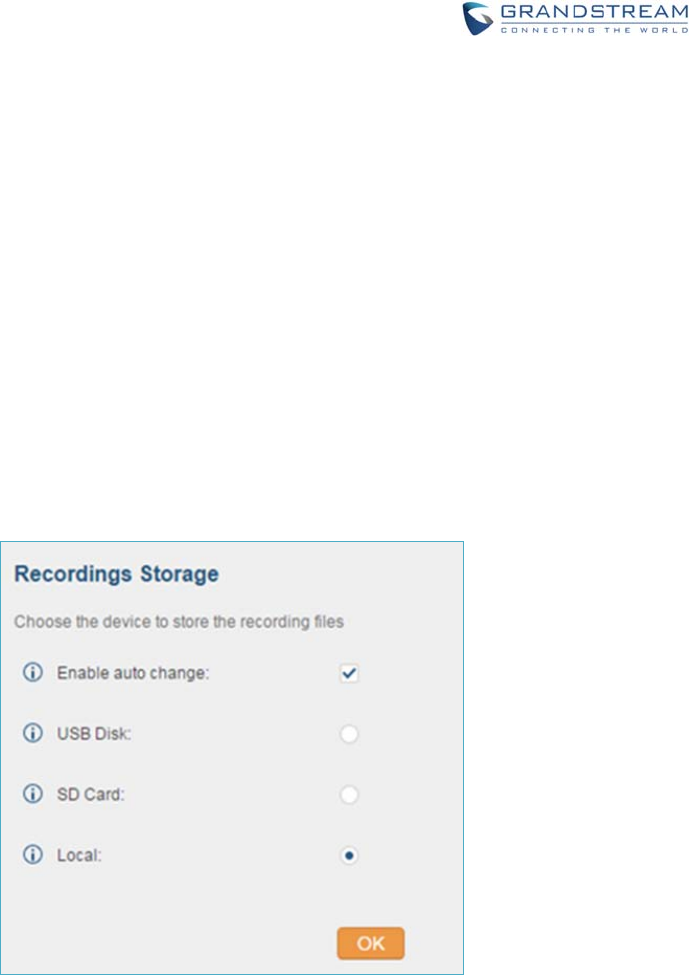
Firmware Version 1.0.0.1 UCM6200 Series IP PBX User Manual Page 79 of 320
NTPSERVER
The UCM6200 can be used as a NTP server for the NTP clients to synchronize their time with. To
configure the UCM6200 as the NTP server, set "Enable NTP server" to "Yes" under web
GUI->Settings->NTP Server. On the client side, point the NTP server address to the UCM6200 IP
address or host name to use the UCM6200 as the NTP server.
RECORDINGSSTORAGE
The UCM6200 supports call recordings automatically or manually and the recording files can be saved in
external storage plugged in the UCM6200 or on the UCM6200 locally. To manage the recording storage,
users can go to UCM6200 web GUI->Settings->Recordings Storage page and select whether to store
the recording files in USB Disk, SD card or locally on the UCM6200.
Figure 53: Settings->Recordings Storage
If “Enable Auto Change” is selected, the recording files will be automatically saved in the available
USB Disk or SD card plugged into the UCM6200. If both USB Disk and SD card are plugged in, the
recording files will be always saved in the USB Disk.
If “Local” is selected, the recordings will be stored in UCM6200 internal storage.
If “USB Disk” or “SD Card” is selected, the recordings will be stored in the corresponding plugged in
external storage device. Please note the options “USB Disk” and “SD Card” will be displayed only if
they are plugged into the UCM6200.
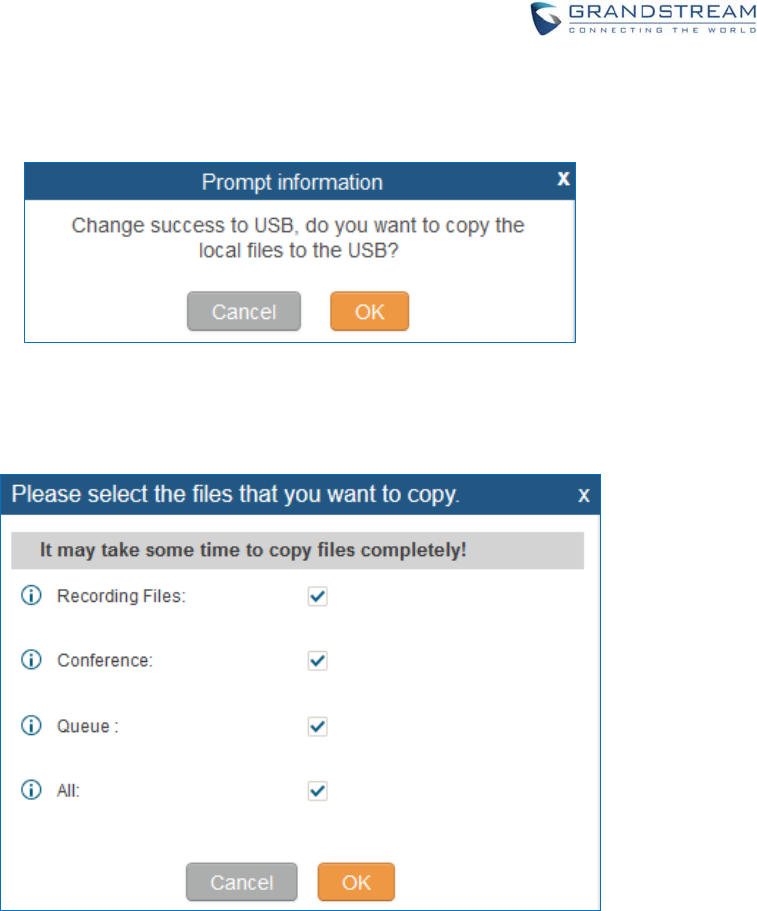
Firmware Version 1.0.0.1 UCM6200 Series IP PBX User Manual Page 80 of 320
Once “USB Disk” or “SD Card” is selected, click on “OK”. The user will be prompted to confirm to copy
the local files to the external storage device.
Figure 54: Recordings Storage Prompt Information
Click on “OK” to continue. The users will be prompted a new dialog to select the categories for the files
to be copied over.
Figure 55: Recording Storage Category
On the UCM6200, recording files are generated and exist in 3 categories: normal call recording files,
conference recording files, and call queue recording files. Therefore users have the following options
when select the categories to copy the files to the external device:
- Recording Files: Copy the normal recording files to the external device.
- Conference: Copy the conference recording files to the external device.
- Queue: Copy the call queue recording files to the external device.
- All: Copy all recording files to the external device.
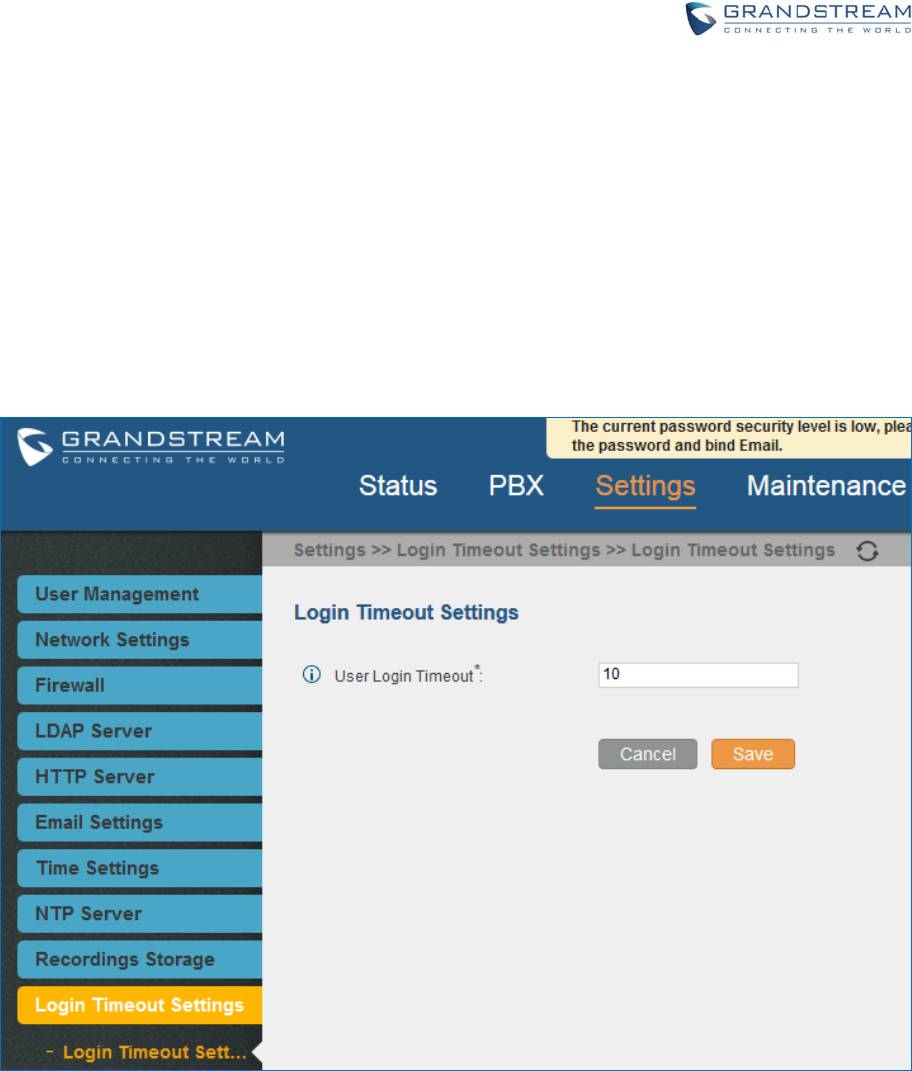
Firmware Version 1.0.0.1 UCM6200 Series IP PBX User Manual Page 81 of 320
LOGINTIMEOUTSETTINGS
After the user logs in the UCM6200 web UI, the user will be automatically logged out after certain timeout.
This timeout value can be specified under UCM100 web GUI->Settings->Login Timeout Settings page.
The “User Login Timeout” value is in minute and the default setting is 10 minutes. If the user doesn’t make
any operation on web UI within the timeout, the user will be logged out automatically. After that, the web UI
will be redirected to the login page and the user will need to enter username and password to log in.
If set to 0, there is no timeout for the web UI login session and the user will not be automatically logged out.
Figure 56: Login Timeout Settings
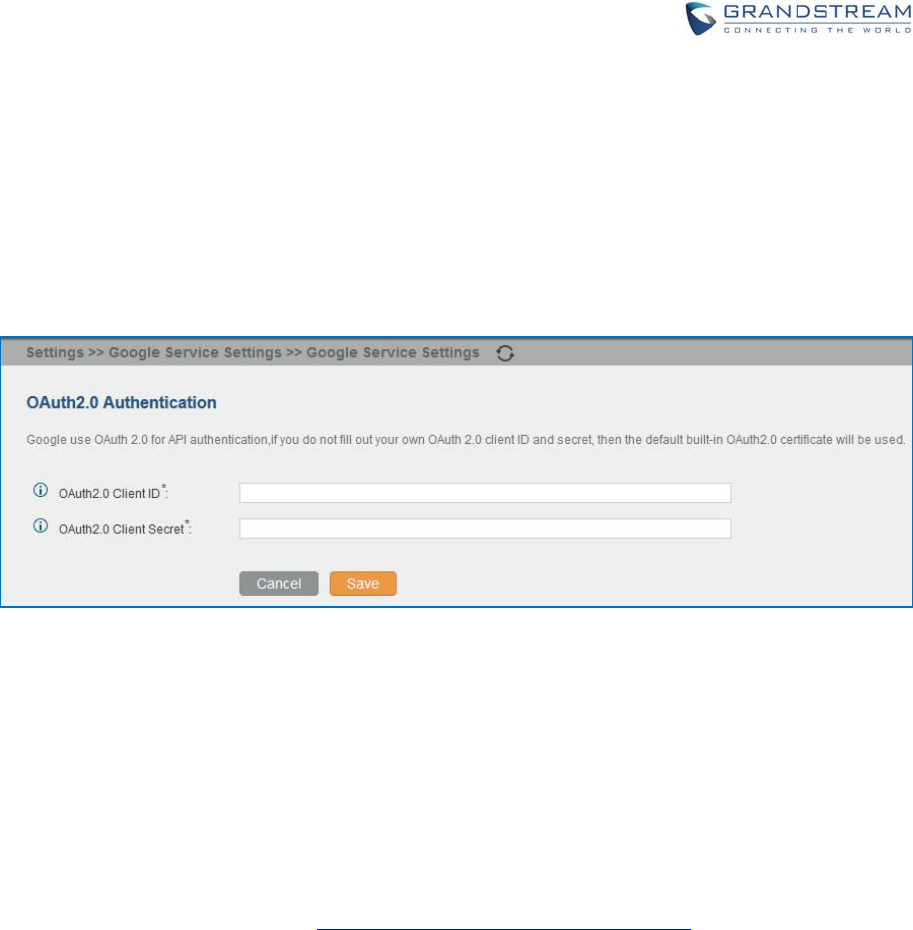
Firmware Version 1.0.0.1 UCM6200 Series IP PBX User Manual Page 82 of 320
GOOGLESERVICESETTINGSSUPPORT
UCM6200 now supports Google OAuth 2.0 authentication. This feature is used for supporting UCM6200
conference scheduling system. Once OAuth 2.0 is enabled, UCM6200 conference system can access Google
calendar to schedule or update conference.
Google Service Settings can be found under web GUI-> Settings-> Google Service Settings-> Google
Service Settings.
Figure 57: Google Service Settings->OAuth2.0 Authentication
If you already have OAuth2.0 project set up on Google Developers web page, please use your existing
login credential for “OAuth2.0 Client ID” and “OAuth2.0 Client Secret” in the above figure for the UCM6200
to access Google Service.
If you do not have OAuth2.0 project set up yet, please following the steps below to create new project and
obtain credentials:
1. Go to Google Developers page https://console.developers.google.com/start Create a New Project in
Google Developers page.
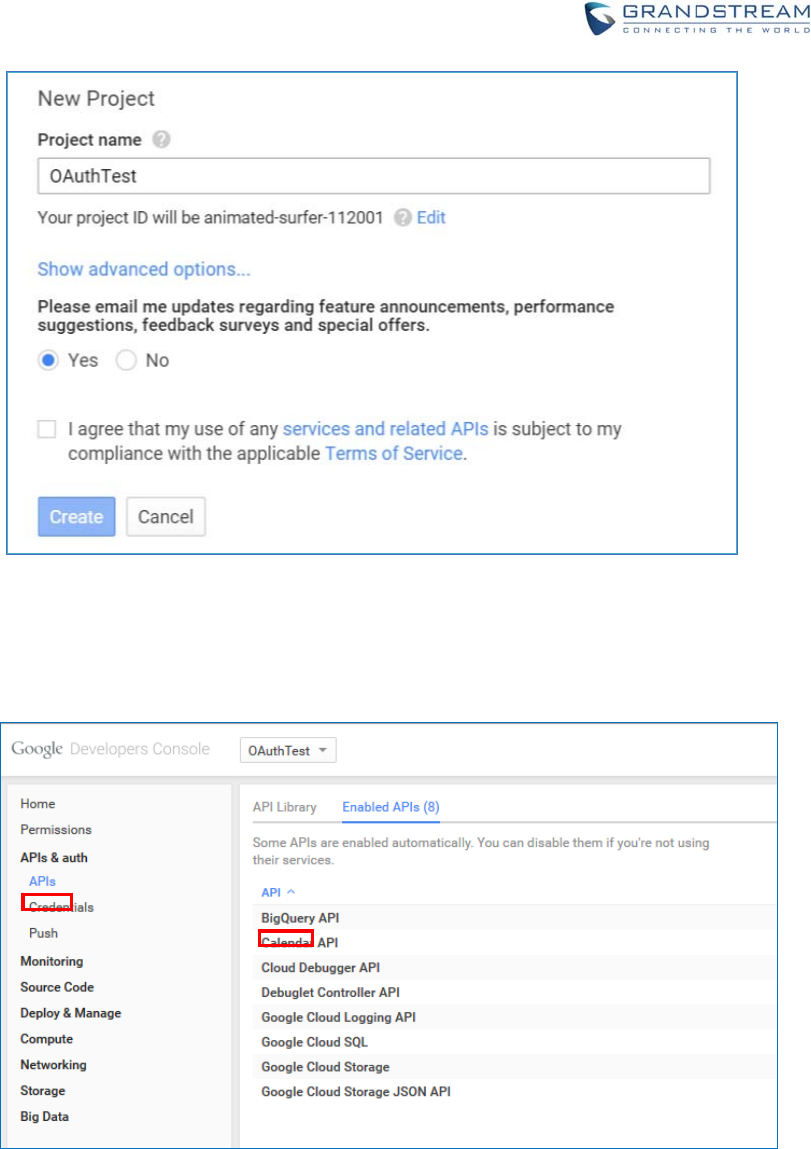
Firmware Version 1.0.0.1 UCM6200 Series IP PBX User Manual Page 83 of 320
Figure 58: Google Service->New Project
2. Enable Calendar API from API Library.
3. Click “Credentials” on the left drop down menu to create new OAuth2.0 login credentials.
Figure 59: Google Service->Create New Credential
4. Use the newly created login credential to fill in “OAuth2.0 Client ID” and “OAuth2.0 Client Secret”.
5. Click “Get Authentication Code” to obtain authentication code from Google Service.
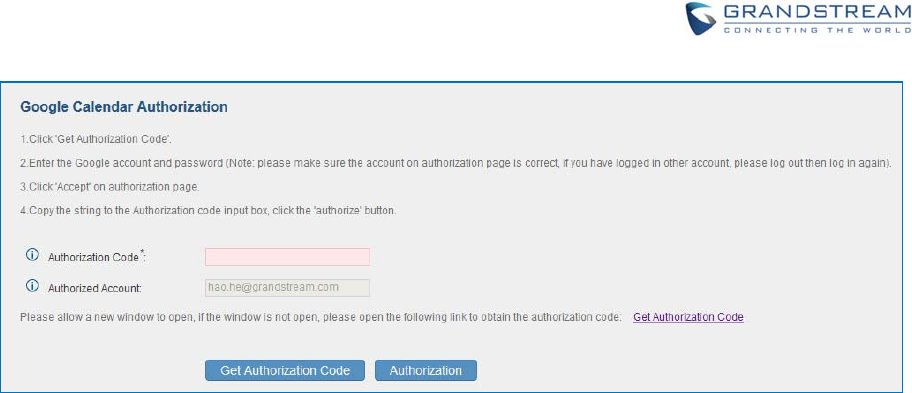
Firmware Version 1.0.0.1 UCM6200 Series IP PBX User Manual Page 84 of 320
Figure 60: Google Service->OAuth2.0 Login
6. Now UCM6200 is connected with Google Service.

Firmware Version 1.0.0.1 UCM6200 Series IP PBX User Manual Page 85 of 320

Firmware Version 1.0.0.1 UCM6200 Series IP PBX User Manual Page 86 of 320
PROVISIONING
OVERVIEW
Grandstream SIP Devices can be configured via Web interface as well as via configuration file through
TFTP/HTTP/HTTPS download. All Grandstream SIP devices support a proprietary binary format
configuration file and XML format configuration file. The UCM6200 provides a Plug and Play mechanism to
auto-provision the Grandstream SIP devices in a zero configuration manner by generating XML config file
and having the phone to download it within LAN area. This allows users to finish the installation with ease
and start using the SIP devices in a managed way.
To provision a phone, three steps are involved, i.e., discovery, configuration and provisioning. This section
explains how Zero Config works on the UCM6200. The settings for this feature can be accessed via Web
UI->PBX->Zero Config.
CONFIGURATIONARCHITECTUREFORENDPOINTDEVICE
Started from firmware version 1.0.7.10, the end point device configuration in zero config is divided into the
following three layers with priority from the lowest to the highest:
Global
This is the lowest layer. Users can configure the most basic options that could apply to all
Grandstream SIP devices during provisioning via Zero config.
Model
In this layer, users can define model-specific options for the configuration template.
Device
This is the highest layer. Users can configure device-specific options for the configuration for individual
device here.
Each layer also has its own structure in different levels. Please see figure below. The details for each layer
are explained in sections [GLOBAL CONFIGURATION], [MODEL CONFIGURATION] and [DEVICE
CONFIGURATION].
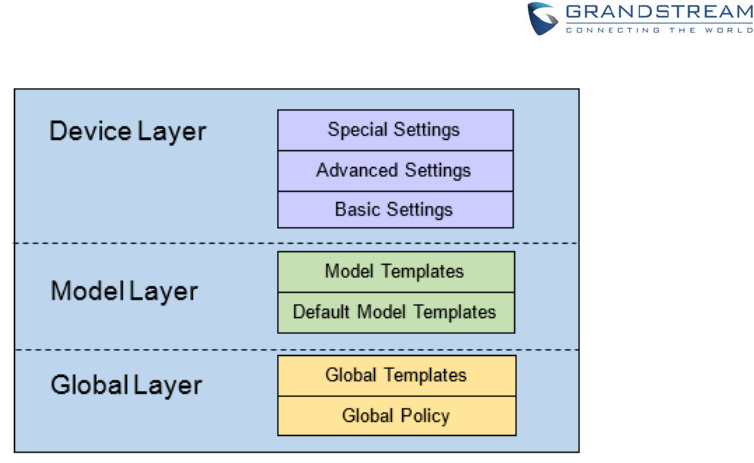
Firmware Version 1.0.0.1 UCM6200 Series IP PBX User Manual Page 87 of 320
Figure 61: Zero Config Configuration Architecture for End Point Device
The configuration options in model layer and device layer have all the option in global layers already, i.e.,
the options in global layer is a subset of the options in model layer and device layer. If an option is set in all
three layers with different values, the highest layer value will override the value in lower layer. For example,
if the user selects English for Language setting in Global Policy and Spanish for Language setting in
Default Model Template, the language setting on the device to be provisioned will use Spanish as model
layer has higher priority than global layer. To sum up, configurations in higher layer will always
override the configurations for the same options/fields in the lower layer when presented at the
same time.
After understanding the zero config configuration architecture, users could configure the available options
for end point devices to be provisioned by the UCM6200 by going through the three layers. This
configuration architecture allows users to set up and manage the Grandstream end point devices in the
same LAN area in a centralized way.
AUTOPROVISIONINGSETTINGS
By default, the Zero Config feature is enabled on the UCM6200 for auto provisioning. Three methods of
auto provisioning are used.
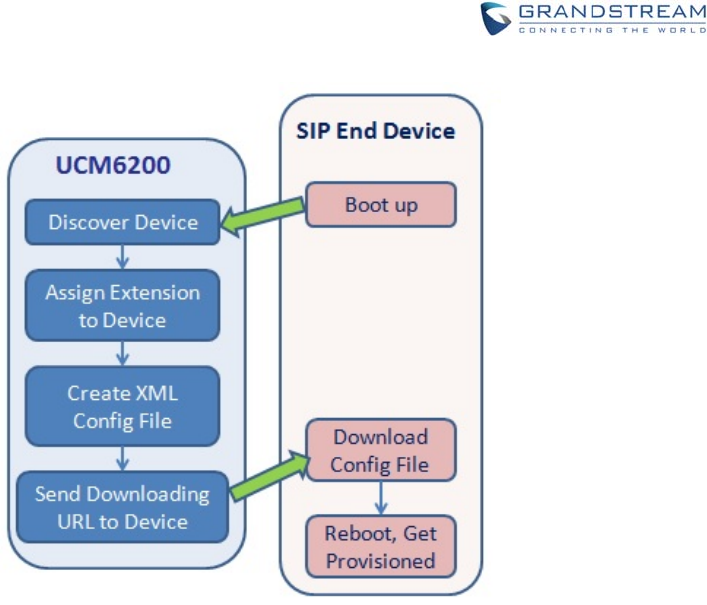
Firmware Version 1.0.0.1 UCM6200 Series IP PBX User Manual Page 88 of 320
Figure 62: UCM6200 Zero Config
SIP SUBSCRIBE
When the phone boots up, it sends out SUBSCRIBE to a multicast IP address in the LAN. The
UCM6200 discovers it and then sends a NOTIFY with the XML config file URL in the message body.
The phone will then use the path to download the config file generated in the UCM6200 and take the
new configuration.
DHCP OPTION 66
This method should be used on the UCM6202/UCM6204 because only the UCM6202/UCM6204 have
WAN and LAN port with LAN port supporting the router function. When the phone restarts (by default
DHCP Option 66 is turned on), it will send out a DHCP DISCOVER request. The UCM6202 receives it
and returns DHCP OFFER with the config server path URL in Option 66, for example,
https://192.168.2.1:8089/zccgi/. The phone will then use the path to download the config file generated
in the UCM6200.
mDNS
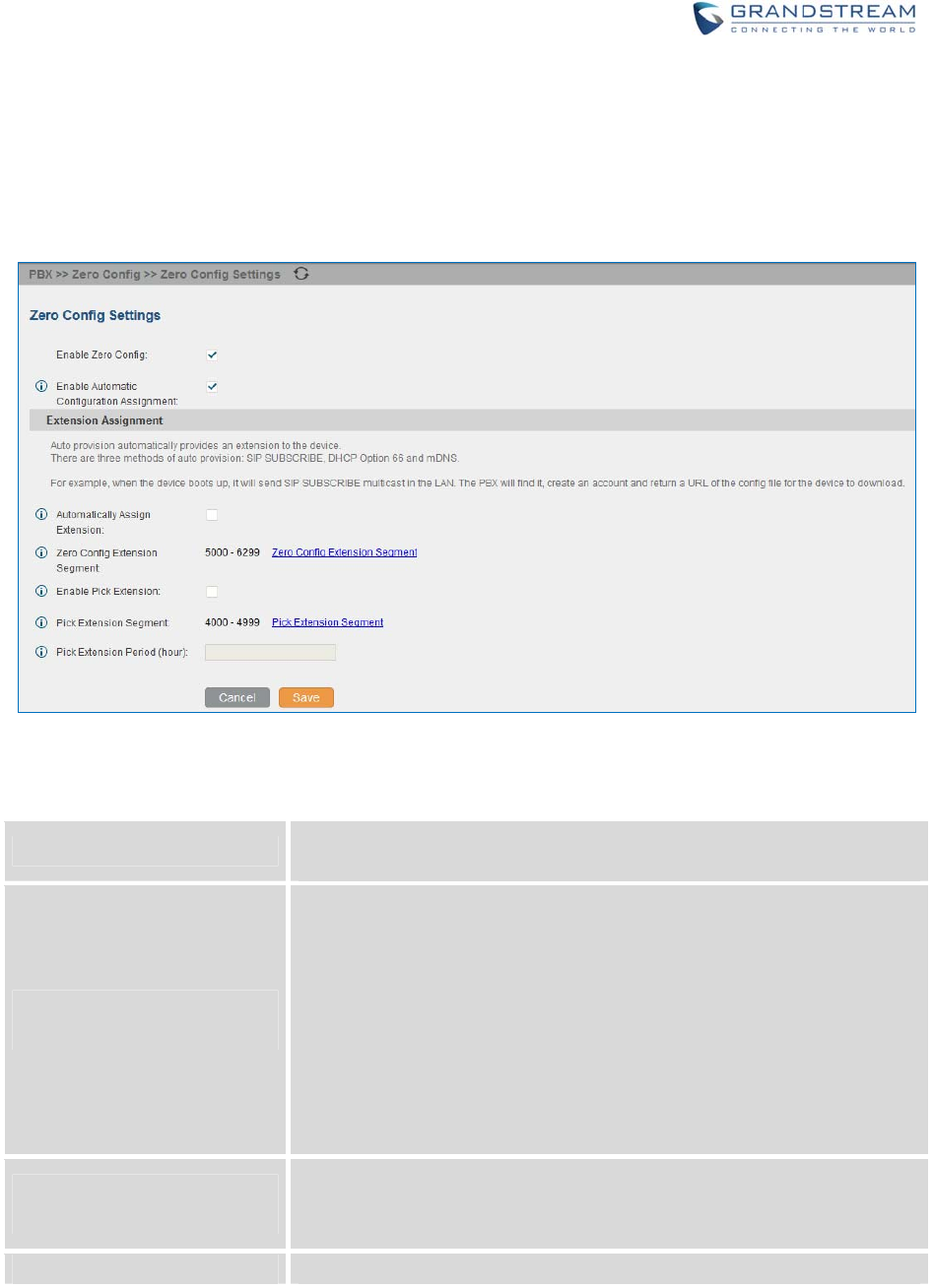
Firmware Version 1.0.0.1 UCM6200 Series IP PBX User Manual Page 89 of 320
When the phone boots up, it sends out mDNS query to get the TFTP server address. The UCM6200
will respond with its own address. The phone will then send TFTP request to download the XML config
file from the UCM6200.
To start the auto provisioning process, under Web GUI->PBX->Zero Config->Zero Config Settings, fill in
the auto provision information.
Figure 63: Auto Provision Settings
Table 24: Auto Provision Settings
Enable Zero Config Enable or disable the zero config feature on the PBX. The default setting
is enabled.
Enable Automatic
Configuration Assignment
By default, this is disabled. If disabled, when SIP device boots up, the
UCM6200 will not send the SIP device the URL to download the config file
and therefore the SIP device will not be automatically provisioned by the
UCM6200.
Note:
When disabled, SIP devices can still be provisioned by manually sending
NOTIFY from the UCM6200 which will include the XML config file URL for
the SIP device to download.
Automatically Assign
Extension
If enabled, when the device is discovered, the PBX will automatically
assign an extension within the range defined in "Zero Config Extension
Segment" to the device. The default setting is disabled.
Zero Config Extension Click on the link "Zero Config Extension Segment" to specify the
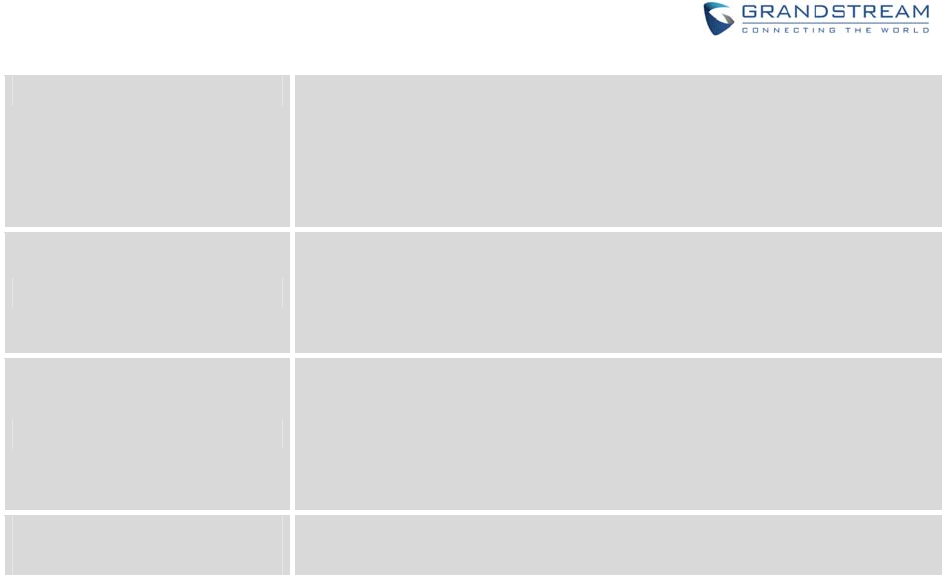
Firmware Version 1.0.0.1 UCM6200 Series IP PBX User Manual Page 90 of 320
Segment extension range to be assigned if "Automatically Assign Extension" is
enabled. The default range is 5000-6299. Zero Config Extension
Segment range can be defined in web UI->PBX->Internal
Options->General page->Extension Preference section: "Auto Provision
Extensions".
Enable Pick Extension
If enabled, the extension list will be sent out to the device after receiving
the device's request. This feature is for the GXP series phones that
support selecting extension to be provisioned via phone's LCD. The
default setting is disabled.
Pick Extension Segment
Click on the link "Pick Extension Segment" to specify the extension list to
be sent to the device. The default range is 4000 to 4999. Pick Extension
Segment range can be defined in web UI->PBX->Internal
Options->General page->Extension Preference section: "Pick
Extensions".
Pick Extension Period
(hour):
Specify the number of minutes to allow the phones being provisioned to
pick extensions.
Please make sure an extension is manually assigned to the phone or "Automatically Assign Extension" is
enabled during provisioning. After the configuration on the UCM6200 web GUI, click on "Save" and "Apply
Changes". Once the phone boots up and picks up the config file from the UCM6200, it will take the
configuration right away.
DISCOVERY
Users could manually discover the device by specifying the IP address or scanning the entire LAN network.
Three methods are supported to scan the devices.
PING
ARP
SIP Message (NOTIFY)
Click on "Auto Discover" under web UI-> PBX-> Zero Config->Zero Config, fill in the "Scan Method" and
"Scan IP". The IP address segment will be automatically filled in based on the network mask detected on
the UCM6200. If users need scan the entire network segment, enter 255 (for example, 192.168.40.255)
instead of a specific IP address. Then click on "Save" to start discovering the devices within the same
network. To successfully discover the devices, "Zero Config" needs to be enabled on the UCM6200 web
GUI->PBX->Zero Config->Auto Provisioning Settings.
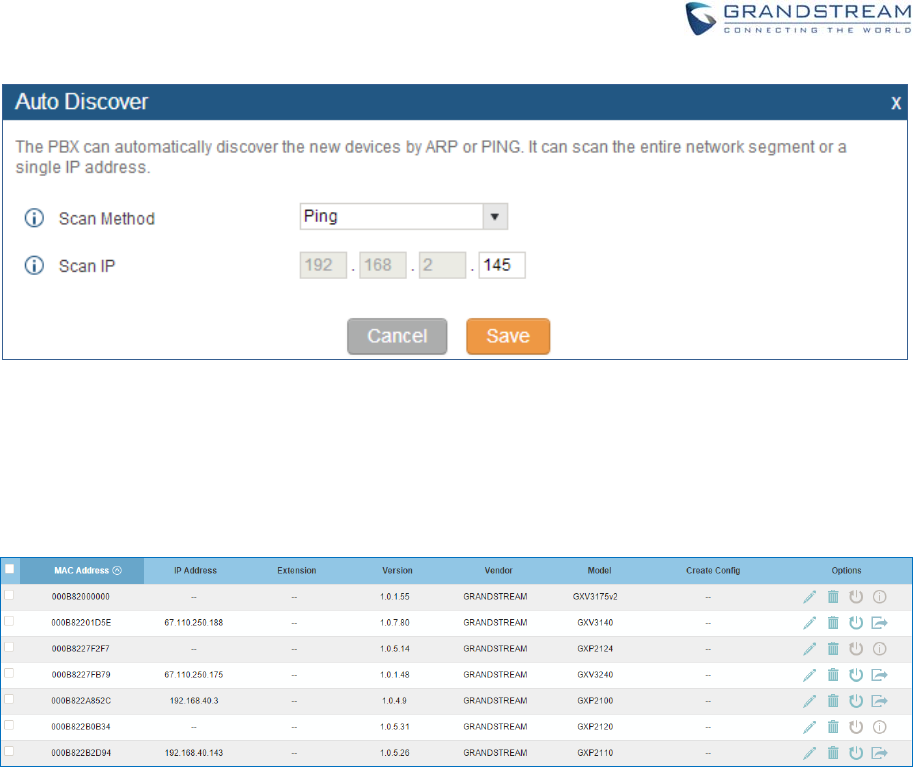
Firmware Version 1.0.0.1 UCM6200 Series IP PBX User Manual Page 91 of 320
Figure 64: Auto Discover
The following figure shows a list of discovered phones. The MAC address, IP Address, Extension (if
assigned), Version, Vendor, Model, Connection Status, Create Config, Options (Edit/Delete/Update) are
displayed in the list.
Figure 65: Discovered Devices
GLOBALCONFIGURATION
GLOBALPOLICY
Global configuration will apply to all the connected Grandstream SIP end point devices in the same LAN
with the UCM6200 no matter what the Grandstream device model it is. It is divided into two levels:
Web UI->PBX->Zero Config->Global Policy
Web UI->PBX->Zero Config->Global Templates.
Global Templates configuration has higher priority to Global Policy configuration.
Global Policy can be accessed in web GUI->PBX->Zero Config->Global Policy page. On the top of the
configuration table, users can select category in the "Options" dropdown list to quickly navigate to the
category. The categories are:
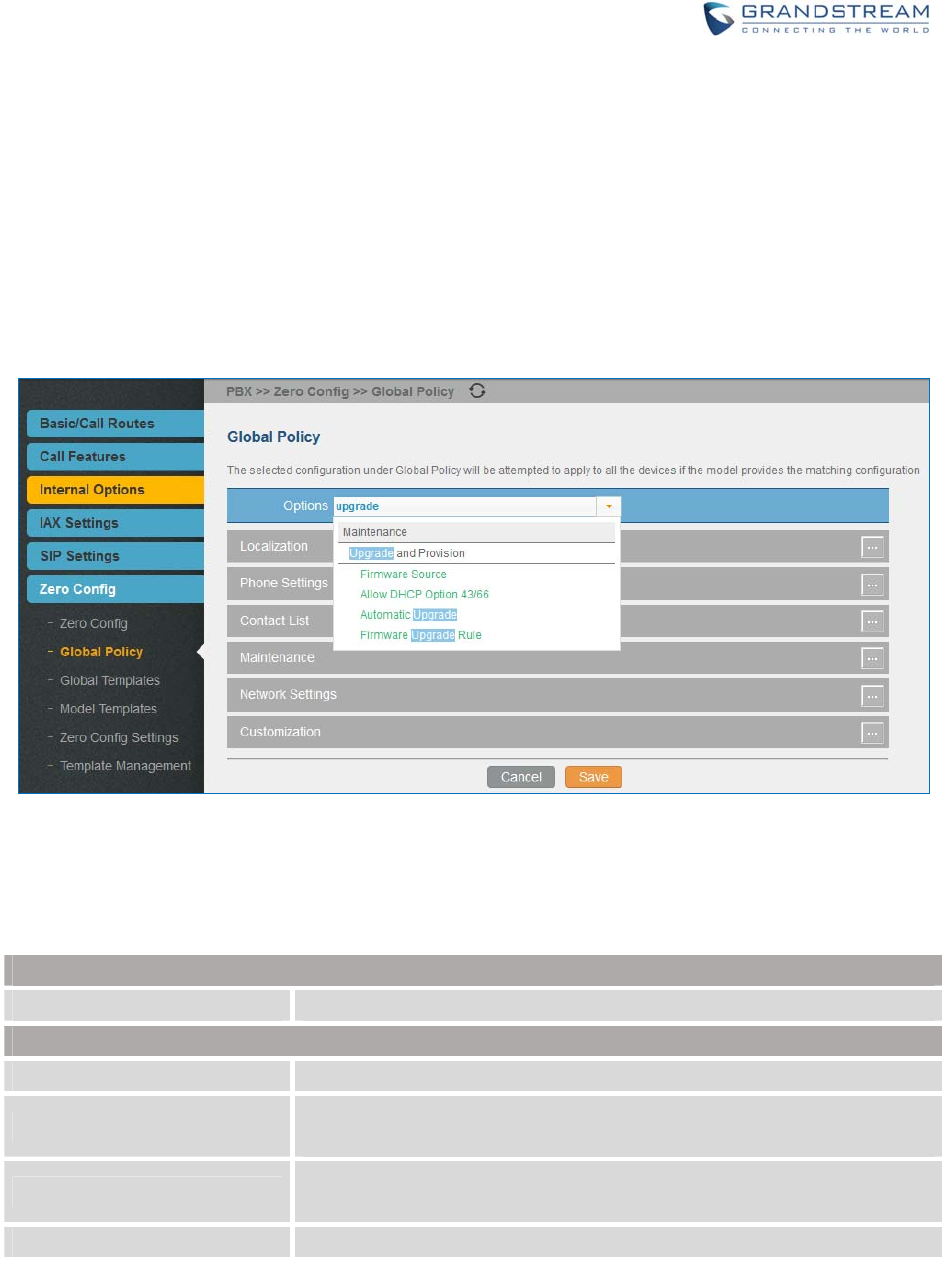
Firmware Version 1.0.0.1 UCM6200 Series IP PBX User Manual Page 92 of 320
Localization: configure display language, data and time.
Phone Settings: configure dial plan, call features, NAT, call progress tones and etc.
Contact List: configure LDAP and XML phonebook download.
Maintenance: configure upgrading, web access, Telnet/SSH access and syslog.
Network Settings: configure IP address, QoS and STUN settings.
Customization: customize LCD screen wallpaper for the supported models.
Select the checkbox on the left of the parameter you would like to configure to active the dropdown list for
this parameter.
Figure 66: Global Policy Categories
The following tables list the Global Policy configuration parameters for the SIP end device.
Table 25: Global Policy Parameters->Localization
Language settings
Language Select the LCD display language on the SIP end device.
Date and Time
Date Format Configure the date display format on the SIP end device’s LCD.
Time Format Configure the time display in 12-hour or 24-hour format on the SIP end
device’s LCD.
NTP Server Configure the URL or IP address of the NTP server. The SIP end device
may obtain the date and time from the server.
Time Zone Configure the time zone used on the SIP end device.

Firmware Version 1.0.0.1 UCM6200 Series IP PBX User Manual Page 93 of 320
Table 26: Global Policy Parameters->Phone Settings
Default Call Settings
Dial Plan Configure the default dial plan rule. For syntax and examples, please
refer to user manual of the SIP devices to be provisioned for more details.
Enable Call Features
When enabled, “Do Not Disturb”, “Call Forward” and other call features
can be used via the local feature code on the phone. Otherwise, the ITSP
feature code will be used.
Use # as Dial Key If set to “Yes”, pressing the number key “#” will immediately dial out the
input digits.
Auto Answer by Call-info
If set to "Yes", the phone will automatically turn on the speaker phone to
answer incoming calls after a short reminding beep, based on the SIP
Call-Info header sent from the server/proxy.
The default setting is enabled.
NAT Traversal
Configure which NAT traversal mechanism will be enabled on the
endpoint device.
If set to "STUN" and STUN server is configured, the phone system will
periodically send STUN message to the SUTN server to get the public IP
address of its NAT environment and keep the NAT port open. STUN will
not work if the NAT is symmetric type.
If set to “Keep-alive”, the phone system will send the STUN packets to
maintain the connection that is first established during registration of the
phone. The “Keep-alive” packets will fool the NAT device into keeping the
connection open and this allows the host server to send SIP requests
directly to the registered phone.
If it needs to use OpenVPN to connect host server, it needs to set it to
“VPN”.
If the firewall and the SIP device behind the firewall are both able to use
UPNP, it can be set to “UPNP”. The both parties will negotiate to use
which port to allow SIP through.
The default setting is "Keep-alive".
Use Random Port
Configure whether to allow the endpoint device to use random ports for
both SIP and RTP messages. This is usually necessary when multiple
phones are behind the same full cone NAT. The default setting is "No".
Note: This parameter must be set to "No" for Direct IP Calling to work.
General Settings
Call Progress Tones
Configure call progress tones including ring tone, dial tone, second dial
tone, message waiting tone, ring back tone, call waiting tone, busy tone
and reorder tone using the following syntax:
f1=val, f2=val[, c=on1/ off1[- on2/ off2[- on3/ off3]]];
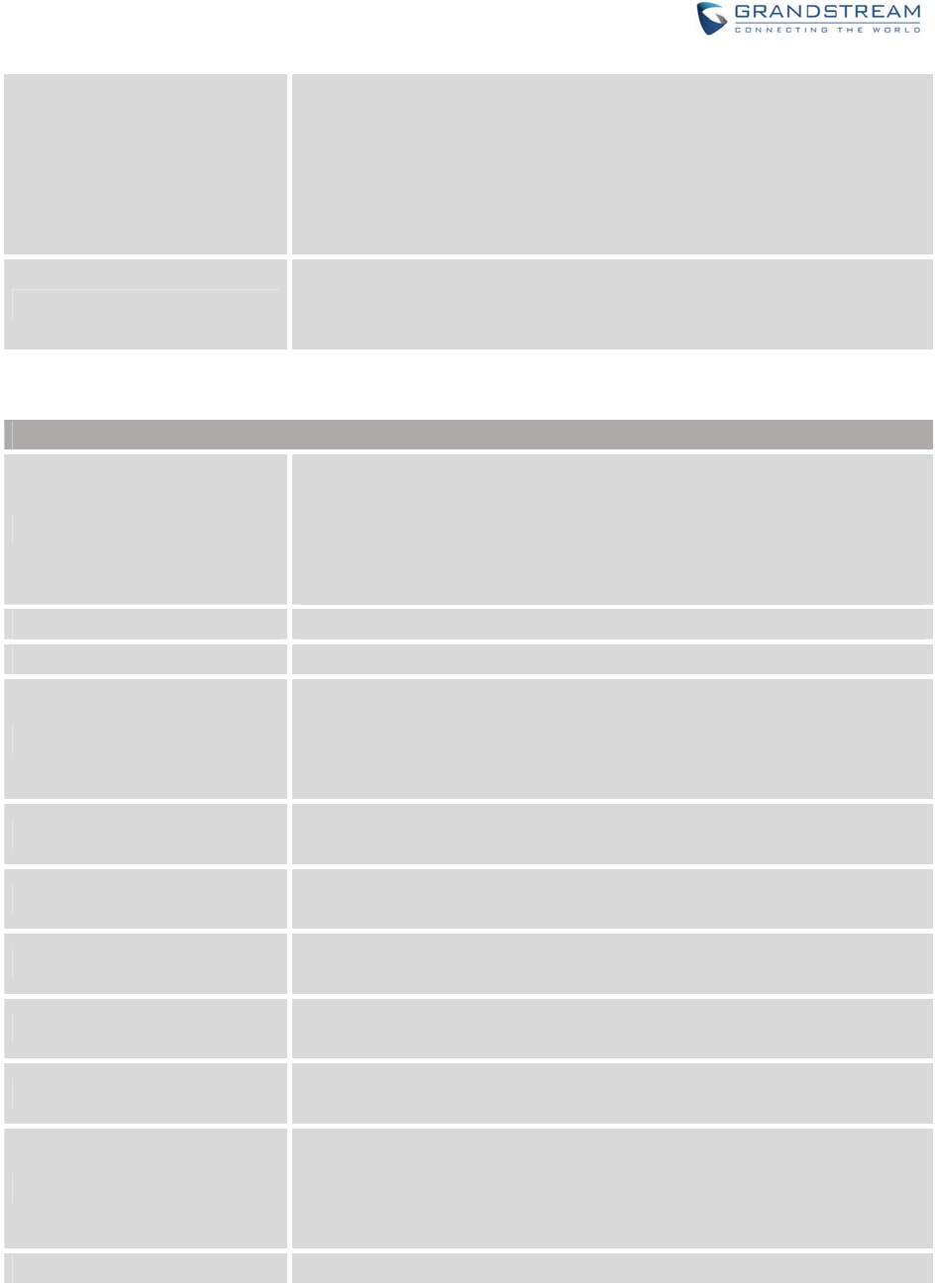
Firmware Version 1.0.0.1 UCM6200 Series IP PBX User Manual Page 94 of 320
Frequencies are in Hz and cadence on and off are in 10ms).
“on” is the period (in ms) of ringing while “off” is the period of silence.
Up to three cadences are supported.
Please refer to user manual of the SIP devices to be provisioned for
more details
HEADSET Key Mode
Select “Default Mode” or “Toggle Headset/Speaker” for the Headset key.
Please refer to user manual of the SIP devices to be provisioned for more
details.
Table 27: Global Policy Parameters->Contact List
LDAP Phonebook
Source
Select "Manual" or "PBX" as the LDAP configuration source.
If "Manual" is selected, the LDAP configuration below will be applied
to the SIP end device.
If "PBX" is selected, the LDAP configuration built-in from UCM6200
web UI->Settings->LDAP Server will be applied.
Address Configure the IP address or DNS name of the LDAP server.
Port Configure the LDAP server port. The default value is 389.
Base DN
This is the location in the directory where the search is requested to
begin. Example:
dc=grandstream, dc=com
ou=Boston, dc=grandstream, dc=com
User Name Configure the bind "Username" for querying LDAP servers. The field can
be left blank if the LDAP server allows anonymous binds.
Password Configure the bind "Password" for querying LDAP servers. The field can
be left blank if the LDAP server allows anonymous binds.
Number Filter Configure the filter used for number lookups. Please refer to user manual
for more details.
Name Filter Configure the filter used for name lookups. Please refer to user manual
for more details.
Version Select the protocol version for the phone to send the bind requests. The
default value is 3.
Name Attribute
Specify the "name" attributes of each record which are returned in the
LDAP search result. Example:
gn
cn sn description
Number Attribute Specify the "number" attributes of each record which are returned in the
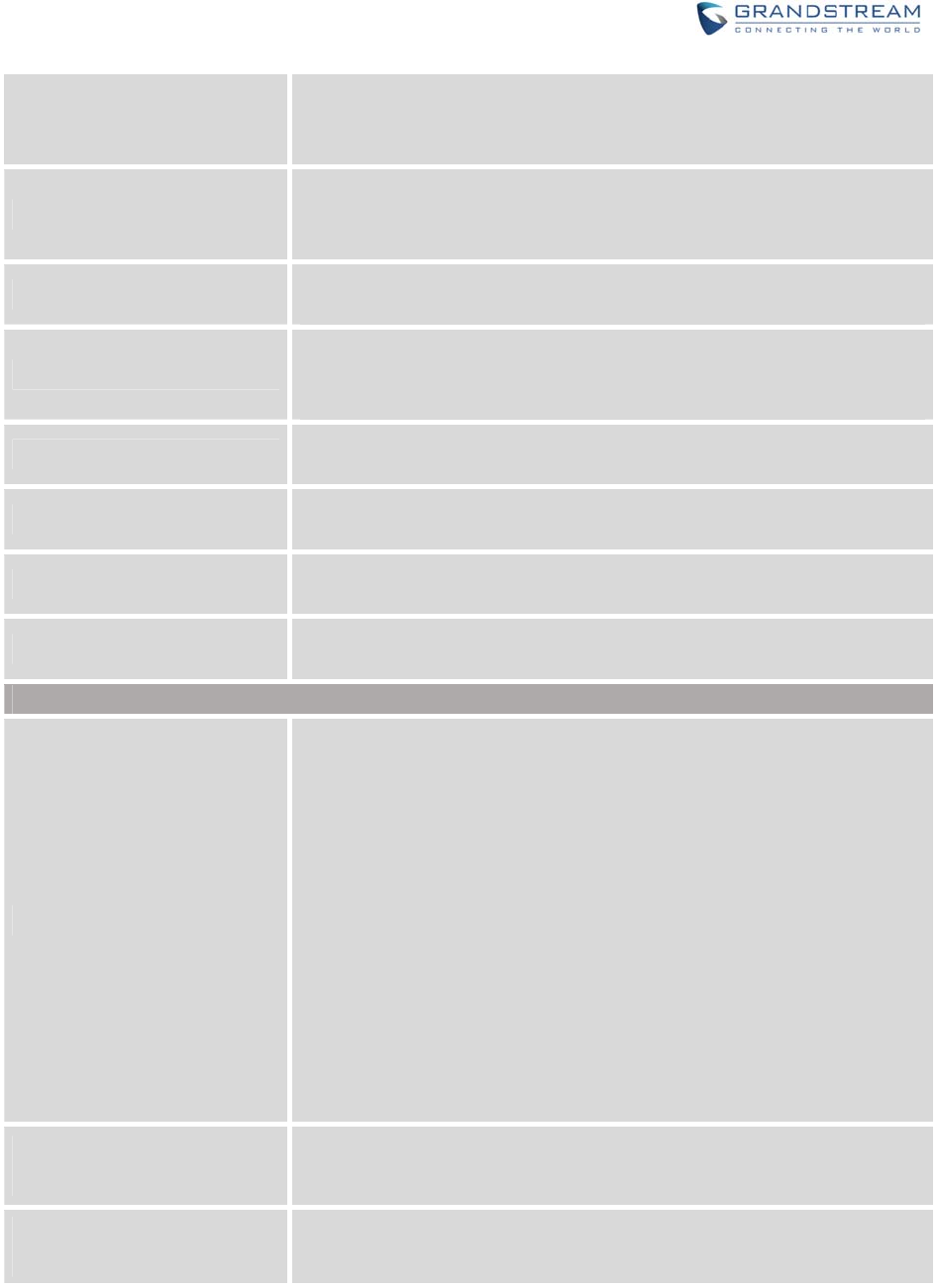
Firmware Version 1.0.0.1 UCM6200 Series IP PBX User Manual Page 95 of 320
LDAP search result. Example:
telephoneNumber
telephoneNumber Mobile
Display Name
Configure the entry information to be shown on phone's LCD. Up to 3
fields can be displayed. Example:
%cn %sn %telephoneNumber
Max Hits Specify the maximum number of results to be returned by the LDAP
server. Valid range is 1 to 3000. The default value is 50.
Search Timeout
Specify the interval (in seconds) for the server to process the request and
client waits for server to return. Valid range is 0 to 180. The default value
is 30.
Sort Results Specify whether the searching result is sorted or not. The default setting is
No.
Incoming Calls Configure to enable LDAP number searching when receiving calls. The
default setting is No.
Outgoing Calls Configure to enable LDAP number searching when making calls. The
default setting is No.
Lookup Display Name Configures the display name when LDAP looks up the name for incoming
call or outgoing call. It must be a subset of the LDAP Name Attributes.
XML Phonebook
Phonebook XML Server
Select the source of the phonebook XML server.
Disable
Disable phonebook XML downloading.
Manual
Once selected, users need specify downloading protocol HTTP,
HTTPS or TFTP and the server path to download the phonebook
XML file. The server path could be IP address or URL, with up to 256
characters.
Local UCM Server
Once selected, click on the Server Path field to upload the phonebook
XML file. Please note: after uploading the phonebook XML file to the
server, the original file name will be used as the directory name and
the file will be renamed as phonebook.xml under that directory.
Phonebook Download
Interval
Configure the phonebook download interval (in Minute). If set to 0,
automatic download will be disabled. Valid range is 5 to 720.
Remove manually-edited
entries on download
If set to "Yes", when XML phonebook is downloaded, the entries added
manually will be automatically removed.

Firmware Version 1.0.0.1 UCM6200 Series IP PBX User Manual Page 96 of 320
Table 28: Global Policy Parameters->Maintenance
Upgrade and Provision
Firmware Source
Firmware source via ZeroConfig provisioning could a URL for external
server address, local UCM directory or USB media if plugged in to the
UCM6200.
Select a source to get the firmware file:
URL
If select to use URL to upgrade, complete the configuration for the
following four parameters: “Upgrade Via”, “Server Path”, “File Prefix”
and “File Postfix”.
Local UCM Server
Firmware can be uploaded to the UCM6200 internal storage for
firmware upgrade. If selected, click on “Manage Storage” icon next to
“Directory” option, upload firmware file and select directory for the
end device to retrieve the firmware file.
Local USB Media
If selected, the USB storage device needs to be plugged into the
UCM6200 and the firmware file must be put under a folder named
“ZC_firmware” in the USB storage root directory.
Local SD Card Media
If selected, an SD card needs to be plugged into the UCM6200 and
the firmware file must be put under a folder named “ZC_firmware” in
the USB storage root directory.
Upgrade via When URL is selected as firmware source, configure upgrade via TFTP,
HTTP or HTTPS.
Server Path When URL is selected as firmware source, configure the firmware
upgrading server path.
File Prefix
When URL is selected as firmware source, configure the firmware file
prefix. If configured, only the firmware with the matching encrypted prefix
will be downloaded and flashed into the phone, if URL is selected as
firmware source.
File Postfix
When URL is selected as firmware source, configure the firmware file
postfix. If configured, only the configuration file with the matching
encrypted postfix will be downloaded and flashed into the phone.
Allow DHCP Option 43/66 If DHCP option 43 or 66 is enabled on the LAN side, the TFTP server can
be redirected.
Automatic Upgrade
If enabled, the endpoint device will automatically upgrade if a new
firmware is detected. Users can select automatic upgrading by day, by
week or by minute.
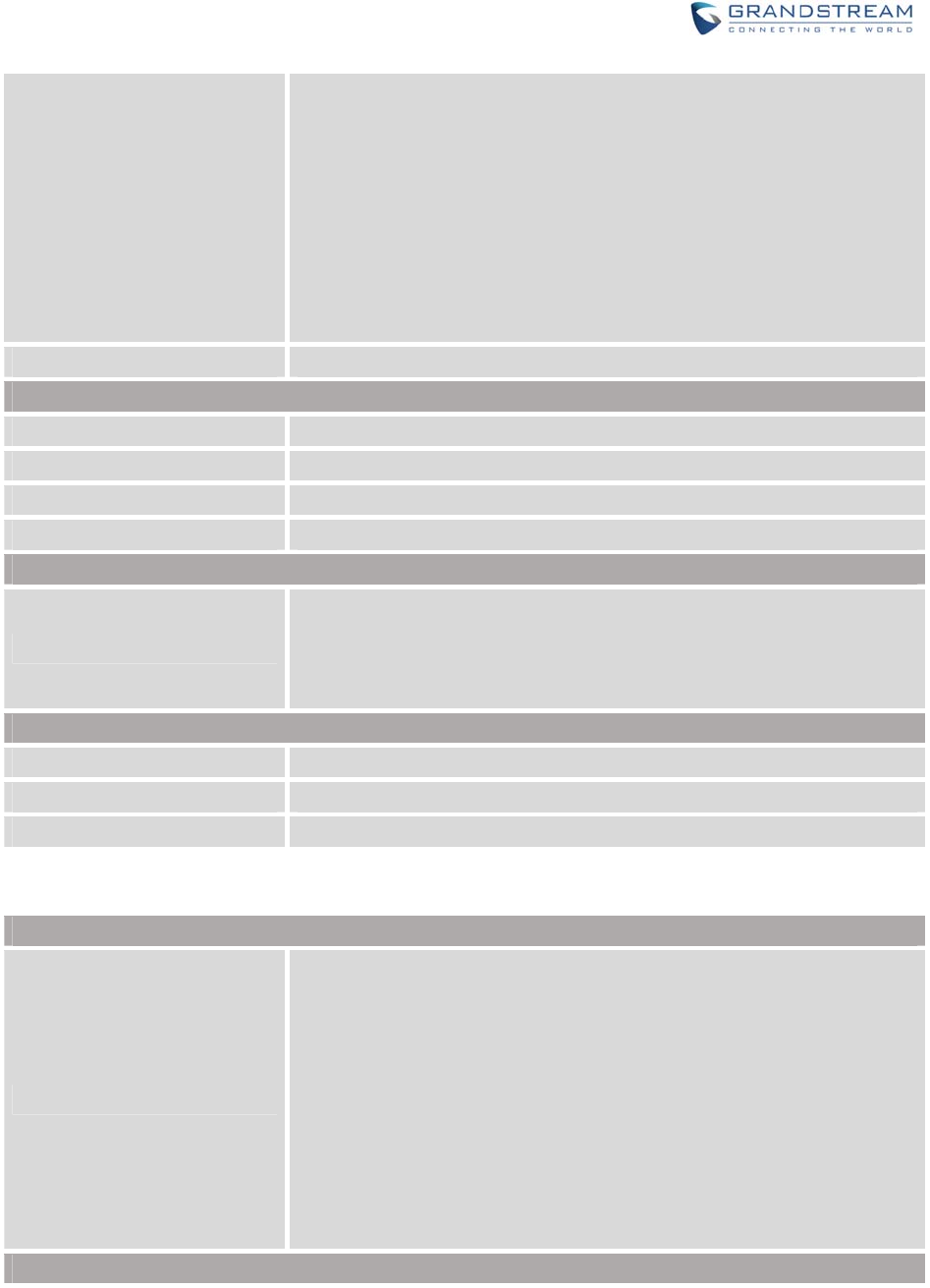
Firmware Version 1.0.0.1 UCM6200 Series IP PBX User Manual Page 97 of 320
By week
Once selected, specify the day of the week to check HTTP/TFTP
server for firmware upgrades or configuration files changes.
By day
Once selected, specify the hour of the day to check the HTTP/TFTP
server for firmware upgrades or configuration files changes.
By minute
Once selected, specify the interval X that the SIP end device will
request for new firmware every X minutes.
Firmware Upgrade Rule Specify how firmware upgrading and provisioning request to be sent.
Web Access
Admin Password Configure the administrator password for admin level login.
End-User Password Configure the end-user password for the end user level login.
Web Access Mode Select HTTP or HTTPS as the web access protocol.
Web Server Port Configure the port for web access. The valid range is 1 to 65535.
Security
Disable Telnet/SSH
Enable Telnet/SSH access for the SIP end device. If the SIP end device
supports Telnet access, this option controls the Telnet access of the
device; if the SIP end device supports SSH access, this option controls
the SSH access of the device.
Syslog
Syslog Server Configure the URL/IP address for the syslog server.
Syslog Level Select the level of logging for syslog.
Send SIP Log Configure whether the SIP log will be included in the syslog message.
Table 29: Global Policy Parameters->Network Settings
Basic Settings
IP Address
Configure how the SIP end device shall obtain the IP address. DHCP or
PPPoE can be selected.
DHCP
Once selected, users can specify the Host Name (option 12) of the
SIP end device as DHCP client, and Vendor Class ID (option 60)
used by the client and server to exchange vendor class ID
information.
PPPoE
Once selected, users need specify the Account ID, Password and
Service Name for PPPoE.
Advanced Setting
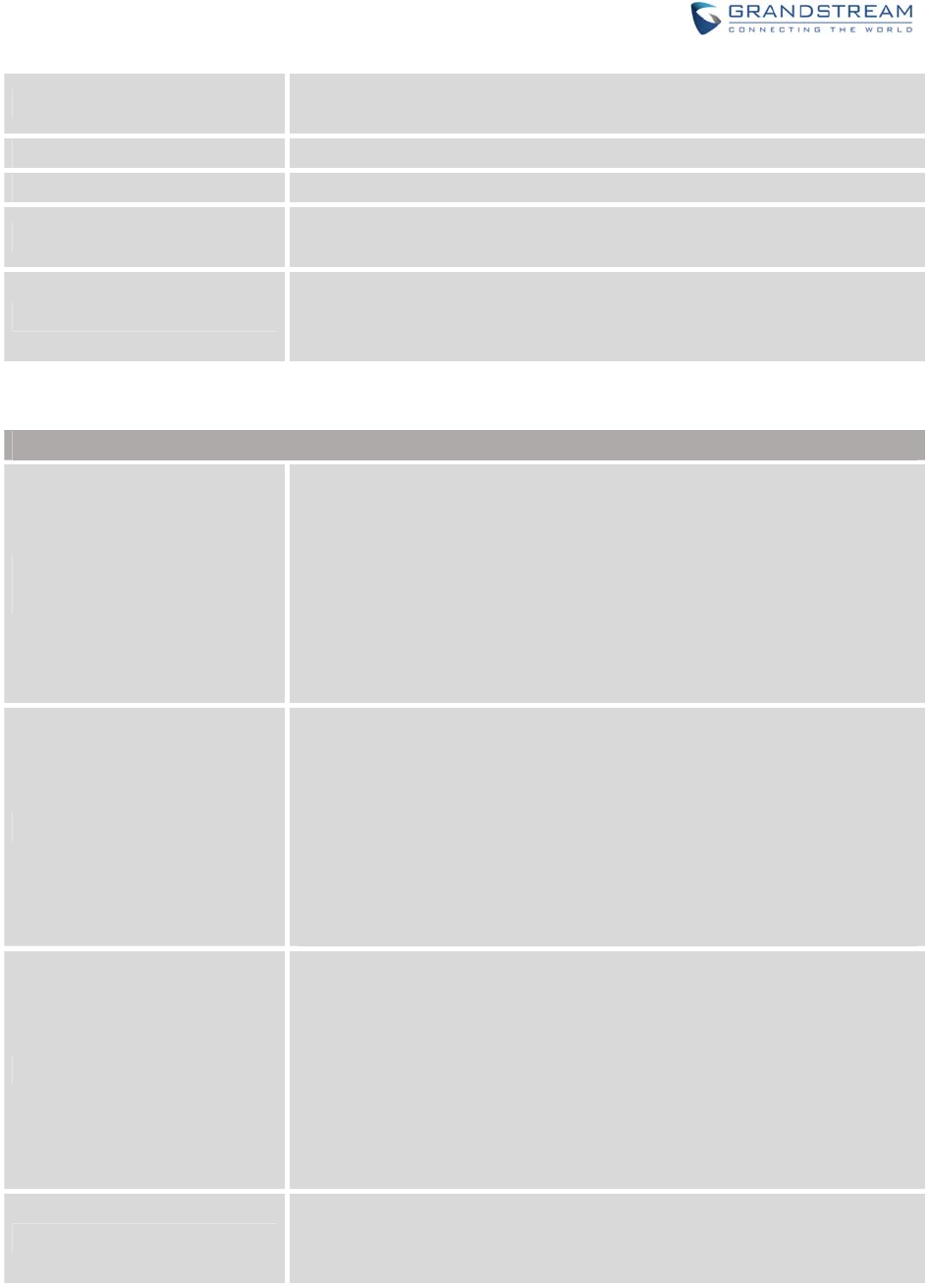
Firmware Version 1.0.0.1 UCM6200 Series IP PBX User Manual Page 98 of 320
Layer 3 QoS Define the Layer 3 QoS parameter. This value is used for IP Precedence,
Diff-Serv or MPLS. Valid range is 0-63.
Layer 2 QoS Tag Assign the VLAN Tag of the Layer 2 QoS packets. Valid range is 0 -4095.
Layer 2 QoS Priority Value Assign the priority value of the Layer 2 QoS packets. Valid range is 0-7.
STUN Server Configure the IP address or Domain name of the STUN server. Only
non-symmetric NAT routers work with STUN.
Keep Alive Interval
Specify how often the phone will send a blank UDP packet to the SIP
server in order to keep the "ping hole" on the NAT router to open. Valid
range is 10-160.
Table 30: Global Policy Parameters->Customization
Wallpaper
Screen Resolution 1024 x
600
Check this option if the SIP end device shall use 1024 x 600 resolution for
the LCD screen wallpaper.
Source
Configure the location where wallpapers are stored.
File
If "URL" is selected as source, specify the URL of the wallpaper file. If
"Local UCM Server" is selected as source, click to upload wallpaper
file to the UCM6200.
Screen Resolution 800 x 400
Check this option if the SIP end device shall use 800 x 400 resolution for
the LCD screen wallpaper.
Source
Configure the location where wallpapers are stored.
File
If "URL" is selected as source, specify the URL of the wallpaper file. If
"Local UCM Server" is selected as source, click to upload wallpaper
file to the UCM6200.
Screen Resolution 480 x 272
Check this option if the SIP end device shall use 480 x 272 resolution for
the LCD screen wallpaper.
Source
Configure the location where wallpapers are stored.
File
If "URL" is selected as source, specify the URL of the wallpaper file. If
"Local UCM Server" is selected as source, click to upload wallpaper
file to the UCM6200.
Screen Resolution 320 x 240
Check this option if the SIP end device supports 320 x 240 resolution for
the LCD screen wallpaper.
Source

Firmware Version 1.0.0.1 UCM6200 Series IP PBX User Manual Page 99 of 320
Configure the location where wallpapers are stored.
File
If "URL" is selected as source, specify the URL of the wallpaper file. If
"Local UCM Server" is selected as source, click to upload wallpaper
file to the UCM6200.
GLOBALTEMPLATES
Global Templates can be accessed in web GUI->PBX->Zero Config->Global Templates. Users can
create multiple global templates with different sets of configurations and save the templates. Later on,
when the user configures the device in Edit Device dialog->Advanced Settings, the user can select to use
one of the global template for the device. Please refer to section [MANAGE DEVICES] for more details on
using the global templates.
When creating global template, users can select the categories and the parameters under each category
to be used in the template. The global policy and the selected global template will both take effect when
generating the config file. However, the selected global template has higher priority to the global policy
when it comes to the same setting option/field. If the same option/field has different value configured in the
global policy and the selected global template, the value for this option/field in the selected global template
will override the value in global policy.
Click on "Create New Template" to add a global template. Users will see the following configurations.
Table 31: Create New Template
Template Name Create a name to identify this global template.
Description Provide a description for the global template. This is optional.
Active Check this option to enable the global template.
Click on to edit the global template.
The window for editing global template is shown in the following figure. In the “Options” field, after
entering the option name key word, the options containing the key word will be listed. Users could then
select the options to be modified and click on “Add Option” to add it into the global template.
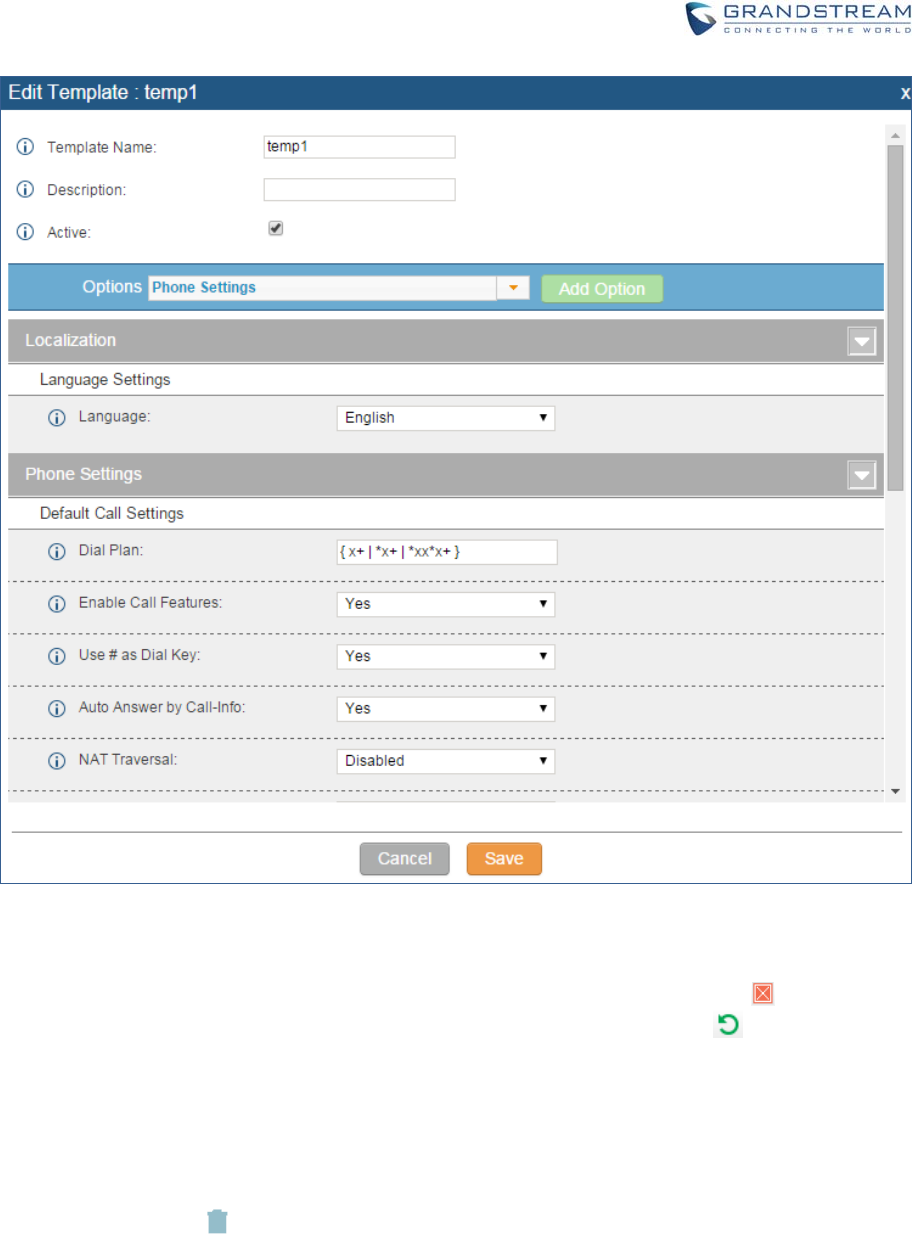
Firmware Version 1.0.0.1 UCM6200 Series IP PBX User Manual Page 100 of 320
Figure 67: Edit Global Template
The added options will show in the list. Users can then enter or select value for each option to be used
in the global template. On the left side of each added option, users can click on to remove this
option from the template. On the right side of each option, users can click on to reset the option
value to the default value.
Click on “Save” to save this global template.
The created global templates will show in the web UI->PBX->Zero Config->Global Templates page.
Users can click on to delete the global template or click on “Delete Selected Templates” to delete
multiple selected templates at once.

Firmware Version 1.0.0.1 UCM6200 Series IP PBX User Manual Page 101 of 320
Click on “Toggle Selected Template(s)” to toggle the status between enabled/disabled for the selected
templates.
MODELCONFIGURATION
MODELTEMPLATES
Model layer configuration allows users to apply model-specific configurations to different devices. Users
could create/edit/delete a model template by accessing web GUI, page PBX->Zero Config->Model
Templates. If multiple model templates are created and enabled, when the user configures the device in
Edit Device dialog->Advanced Settings, the user can select to use one of the model template for the
device. Please refer to section [MANAGE DEVICES] for more details on using the model template.
For each created model template, users can assign it as default model template. If assigned as default
model template, the values in this model template will be applied to all the devices of this model. There is
always only one default model template that can be assigned at one time on the UCM6200.
The selected model template and the default model template will both take effect when generating the
config file for the device. However, the model template has higher priority to default model template when it
comes to the same setting option/field. If the same option/field has different value configured in the default
model template and the selected model template, the value for this option/field in the selected model
template will override the value in default model template.
Click on “Create New Template” to add a model template.
Table 32: Create New Model Template
Model Select a model to apply this template. The supported Grandstream
models are listed in the dropdown list for selection.
Template Name Create a name for the model template.
Description Enter a description for the model template. This is optional.
Default Model Template
Select to assign this model template as the default model template. The
value of the option in default model template will be overridden if other
selected model template has a different value for the same option.
Active Check this option to enable the model template.
Click on to edit the model template.
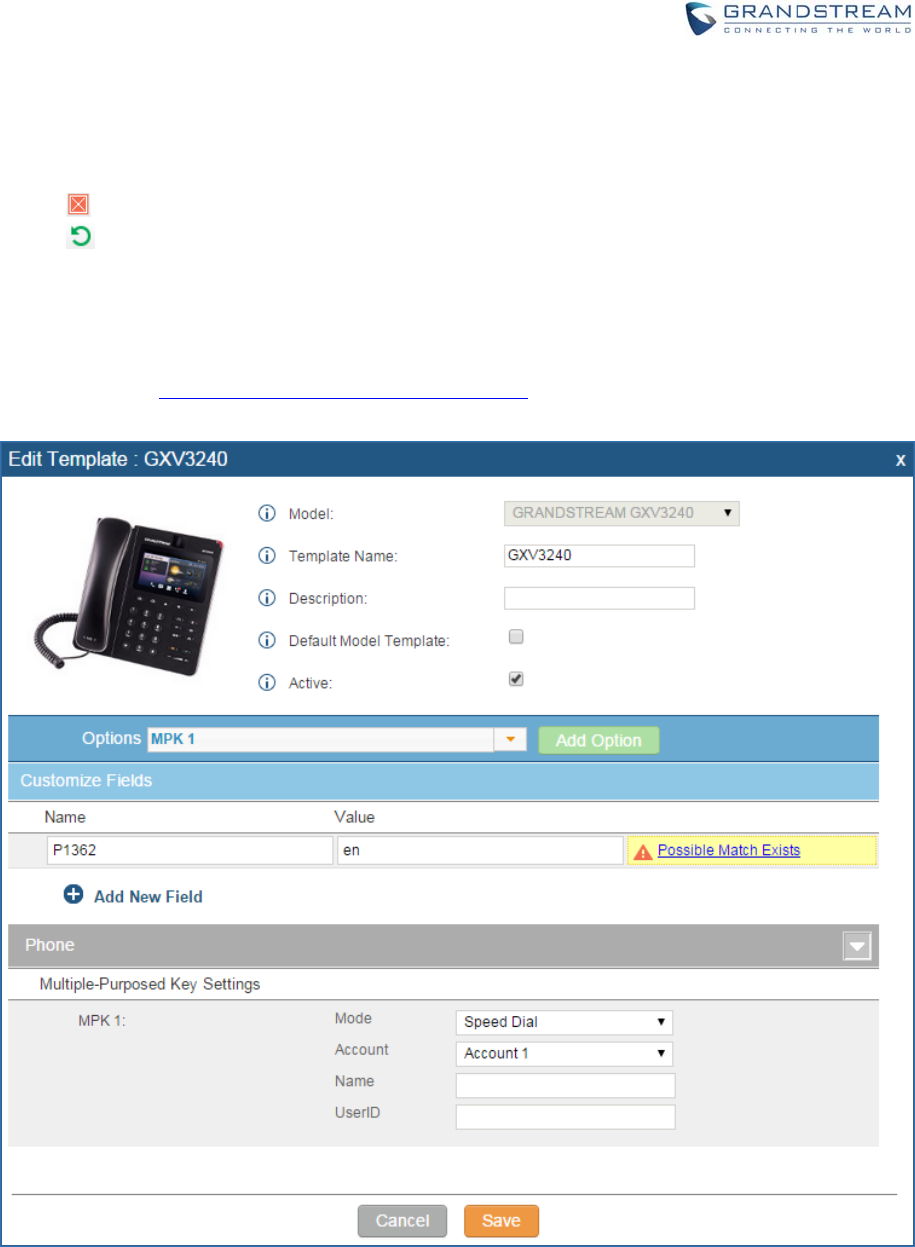
Firmware Version 1.0.0.1 UCM6200 Series IP PBX User Manual Page 102 of 320
The editing window for model template is shown in the following figure. In the “Options” field, enter the
option name key word, the option that contains the key word will be listed. User could then select the
option and click on “Add Option” to add it into the model template.
Once added, the option will be shown in the list below. On the left side of each option, users can click
on to remove this option from the model template. On the right side of each option, users can click
on to reset the option to the default value.
User could also click on “Add New Field” to add a P value number and the value to the configuration.
The following figure shows setting P value “P1362” to “en”, which means the display language on the
LCD is set to English. For P value information of different models, please refer to configuration
template here http://www.grandstream.com/support/tools.
Figure 68: Edit Model Template
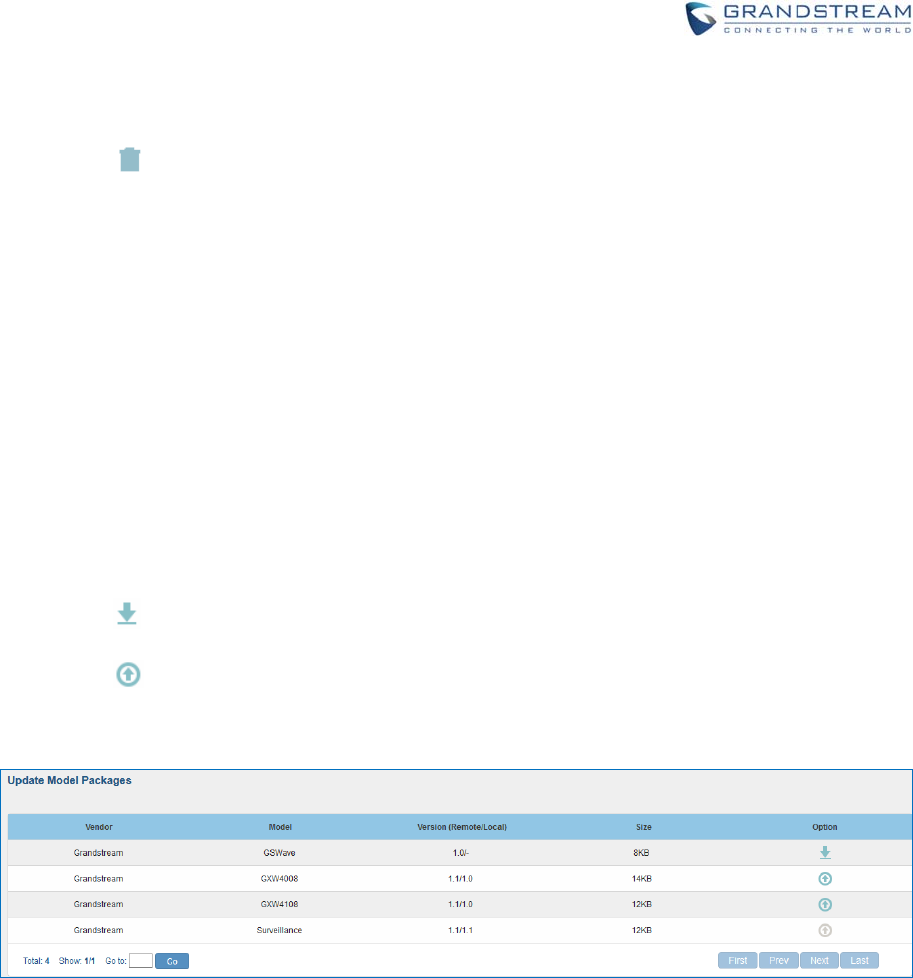
Firmware Version 1.0.0.1 UCM6200 Series IP PBX User Manual Page 103 of 320
Click on Save when done. The model template will be displayed on web UI->PBX->Zero
Config->Model Templates page.
Click on to delete the model template or click on “Delete Selected Templates” to delete multiple
selected templates at once.
Click on “Toggle Selected Template(s)” to toggle the status between enabled/disabled for the selected
model templates.
MODELUPDATE
UCM6200 zero config feature supports provisioning all models of Grandstream SIP end devices.
Templates for most of the Grandstream models are built in with the UCM6200 already. Templates for GS
Wave and Grandstream surveillance products require users to download and install under web
UI->PBX->Zero Config->Model Update first before they are available in the UCM6200 for selection. After
downloading and installing the model template to the UCM6200, it will show in the dropdown list for
“Model” selection when editing the model template.
Click on to download the template.
Click on to upgrade the model template. Users will see this icon available if the device model has
template updated in the UCM6200.
Figure 69: Template Management
In case the UCM6200 is placed in the private network and Internet access is restricted, users will not be
able to get packages by downloading and installing from the remote server. Model template package can
be manually uploaded from local device through web UI. Please contact Grandstream customer support if
the model package is needed for manual uploading.

Firmware Version 1.0.0.1 UCM6200 Series IP PBX User Manual Page 104 of 320
Figure 70: Upload Model Template Manually
DEVICECONFIGURATION
On web GUI, page PBX->Zero Config->Zero Config, users could create new device, delete existing
device(s), make special configuration for a single device, or send NOTIFY to existing device(s).
CREATENEWDEVICE
Besides configuring the device after the device is discovered, users could also directly create a new device
and configure basic settings before the device is discovered by the UCM6200. Once the device is plugged
in, it can then be discovered and provisioned. This gives the system administrator adequate time to set up
each device beforehand.
Click on "Create New Device" and the following dialog will show. Follow the steps below to create the
configurations for the new device.
1. Firstly, select a model for the device to be created and enter its MAC address, IP address and firmware
version (optional) in the corresponding field.
2. Basic settings will show a list of settings based on the model selected in step 1. Users could assign
extensions to accounts, assign functions to Line Keys and Multiple-Purposed Keys if supported on the
selected model.
3. Click on “Create New Device” to save the configuration for this device.
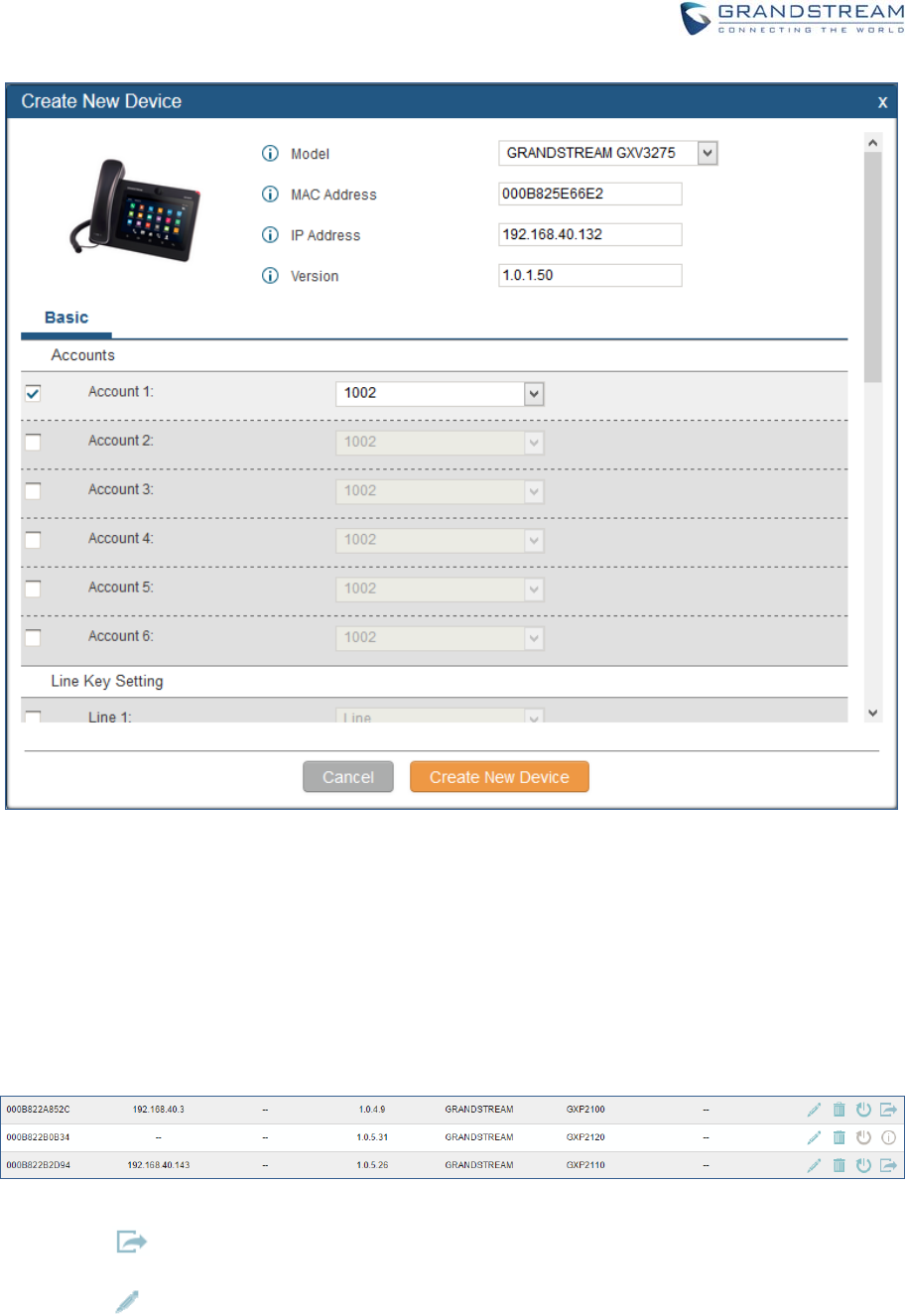
Firmware Version 1.0.0.1 UCM6200 Series IP PBX User Manual Page 105 of 320
Figure 71: Create New Device
MANAGEDEVICES
The device manually created or discovered from Auto Discover will be listed in the web UI->PBX->Zero
Config->Zero Config page. Users can see the devices with their MAC address, IP address, vendor,
model and etc.
Figure 72: Manage Devices
Click on to access the web UI of the phone.
Click on to edit the device configuration.
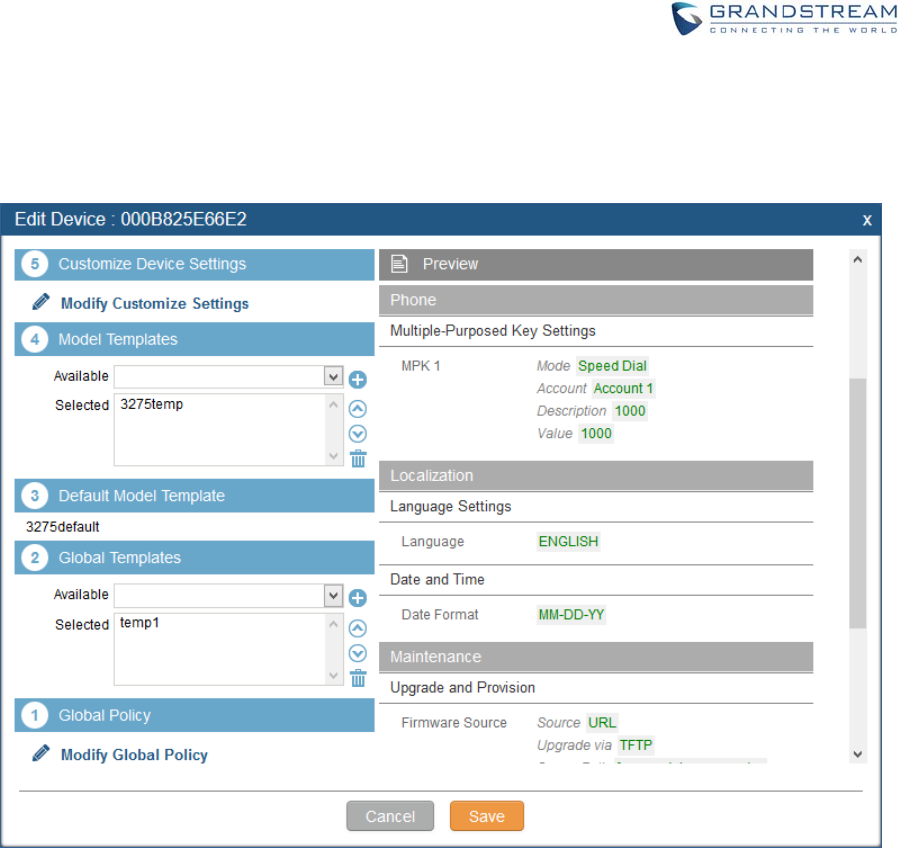
Firmware Version 1.0.0.1 UCM6200 Series IP PBX User Manual Page 106 of 320
A new dialog will be displayed for the users to configure “Basic” settings and “Advanced” settings.
“Basic” settings have the same configurations as displayed when manually creating a new device, i.e.,
account, line key and MPK settings; “Advanced” settings allow users to configure more details in a
five-level structure.
Figure 73: Edit Device
A preview of the “Advanced” settings is shown in the above figure. There are five levels configurations
as described in (1) (2) (3) (4) (5) below, with priority from the lowest to the highest. The configurations
in all levels will take effect for the device. If there are same options existing in different level
configurations with different value configured, the higher level configuration will override the lower level
configuration.
(1) Global Policy
This is the lowest level configuration. The global policy configured in web UI->PBX->Zero
Config->Global Policy will be applied here. Clicking on “Modify Global Policy” to redirect to page
PBX->Zero Config->Global Policy.
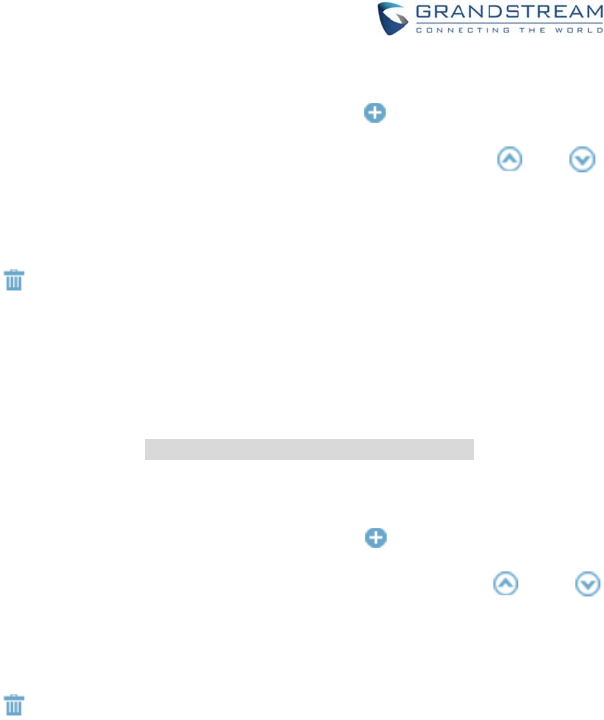
Firmware Version 1.0.0.1 UCM6200 Series IP PBX User Manual Page 107 of 320
(2) Global Templates
Select a global template to be used for the device and click on to add. Multiple global
templates can be selected and users can arrange the priority by adjusting orders via and .
All the selected global templates will take effect. If the same option exists on multiple selected
global templates, the value in the template with higher priority will override the one in the template
with lower priority. Click on to remove the global template from the selected list.
(3) Default Model Template
Default Model Template will be applied to the devices of this model. Default model template can be
configured in model template under web UI->PBX->Zero Config->Model Templates page.
Please see default model template option in [Table 32: Create New Model Template].
(4) Model Templates
Select a model template to be used for the device and click on to add. Multiple global
templates can be selected and users can arrange the priority by adjusting orders via and .
All the selected model templates will take effect. If the same option exists on multiple selected
model templates, the value in the template with higher priority will override the one in the template
with lower priority. Click on to remove the model template from the selected list.
(5) Customize Device Settings
This is the highest level configuration for the device. Click on “Modify Customize Device Settings”
and following dialog will show.
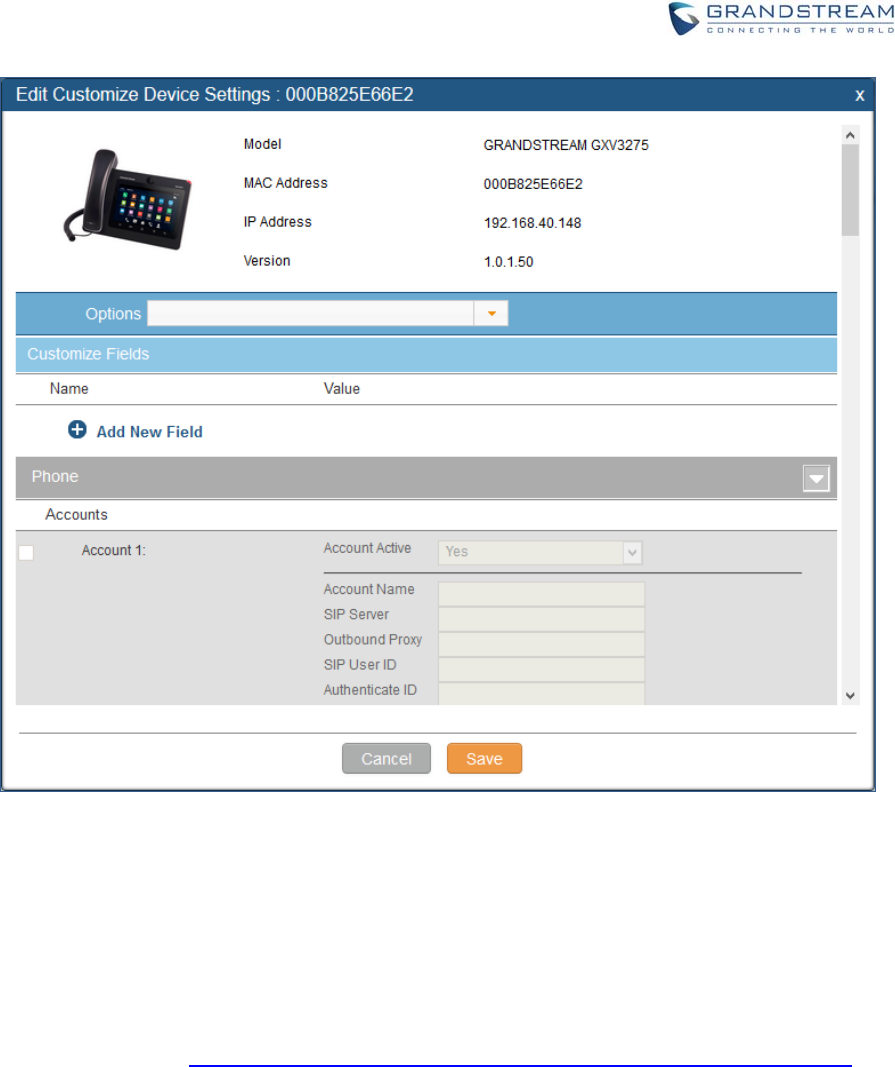
Firmware Version 1.0.0.1 UCM6200 Series IP PBX User Manual Page 108 of 320
Figure 74: Edit Customize Device Settings
Scroll down in the dialog to view and edit the device-specific options. If the users would like to
add more options which are not in the pre-defined list, click on “Add New Field” to add a P value
number and the value to the configuration. The following figure shows setting P value “P1362” to
“en”, which means the display language on the LCD is set to English. The warning information on
right tells that the option matching the P value number exists and clicking on it will lead to the
matching option. For P value information of different models, please refer to configuration
template here http://www.grandstream.com/sites/default/files/Resources/config-template.zip.
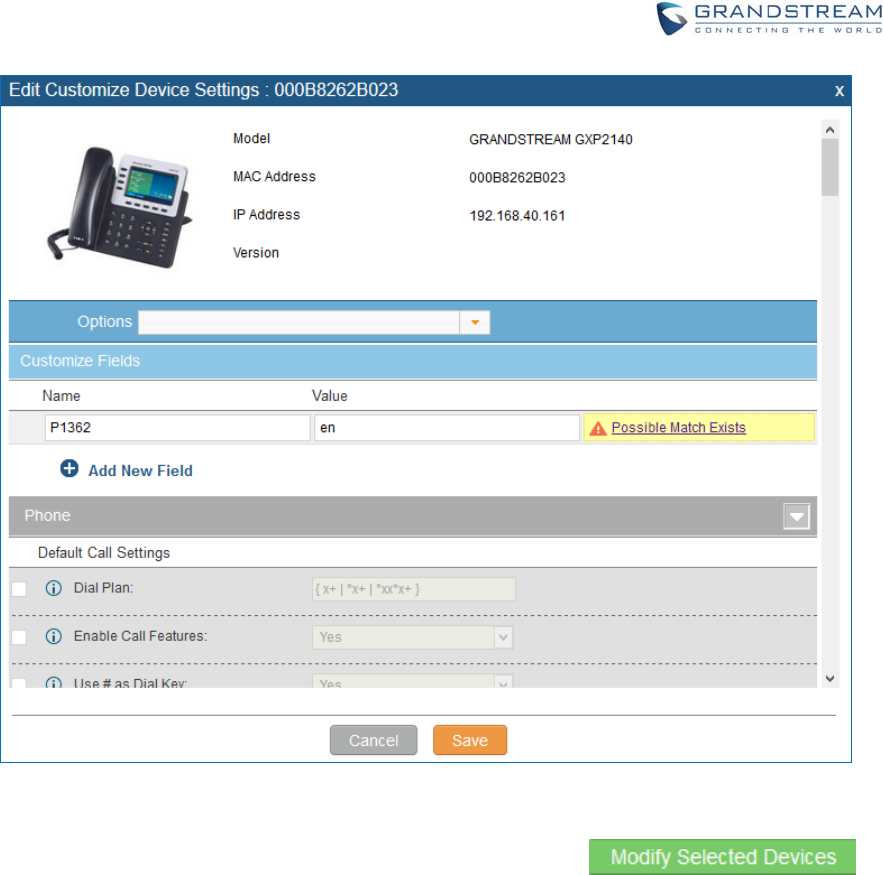
Firmware Version 1.0.0.1 UCM6200 Series IP PBX User Manual Page 109 of 320
Figure 75: Add P Value in Customize Device Settings
Select multiple devices that need to be modified and then click on to
batch modify devices.
If selected devices are of the same model, the configuration dialog is like the following figure.
Configurations in five levels are all available for users to modify.
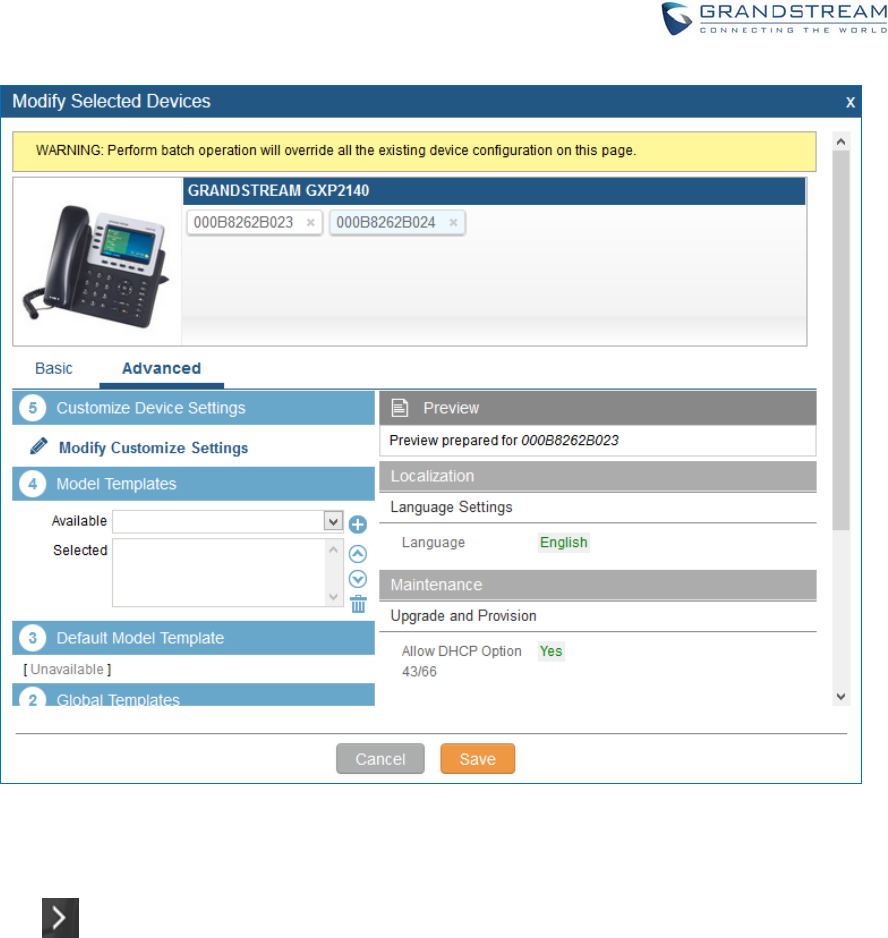
Firmware Version 1.0.0.1 UCM6200 Series IP PBX User Manual Page 110 of 320
Figure 76: Modify Selected Devices - Same Model
If selected devices are of different models, the configuration dialog is like the following figure. Click
on to view more devices of other models. Users are only allowed to make modifications in Global
Templates and Global Policy level.
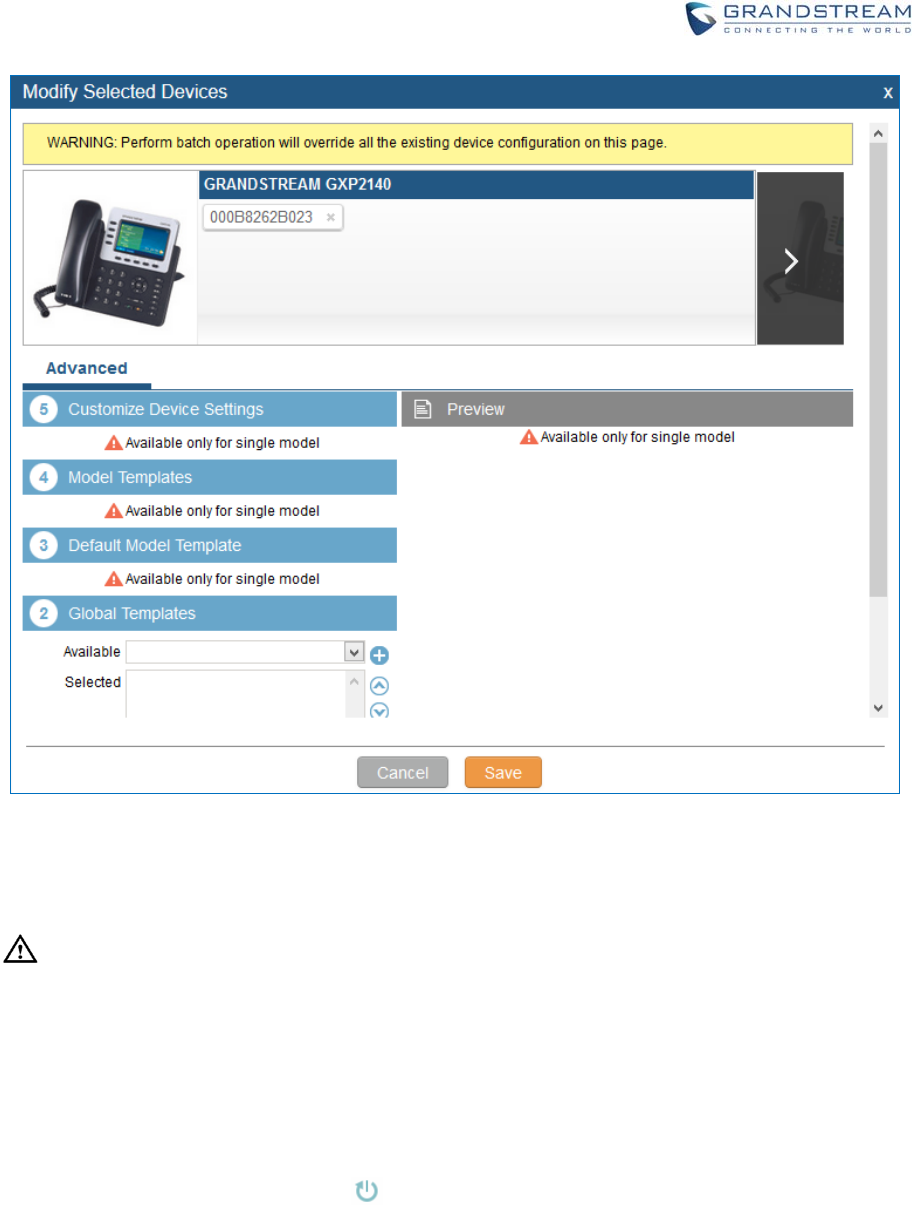
Firmware Version 1.0.0.1 UCM6200 Series IP PBX User Manual Page 111 of 320
Figure 77: Modify Selected Devices - Different Models
--------------------------------------------------------------------------------------------------------------------------------------------
Note:
Performing batch operation will override all the existing device configuration on the page.
--------------------------------------------------------------------------------------------------------------------------------------------
After the above configurations, save the changes and go back to web UI->PBX->Zero Config->Zero
Config page. Users could then click on to send NOTIFY to the SIP end point device and trigger the
provisioning process. The device will start downloading the generated configuration file from the URL
contained in the NOTIFY message.
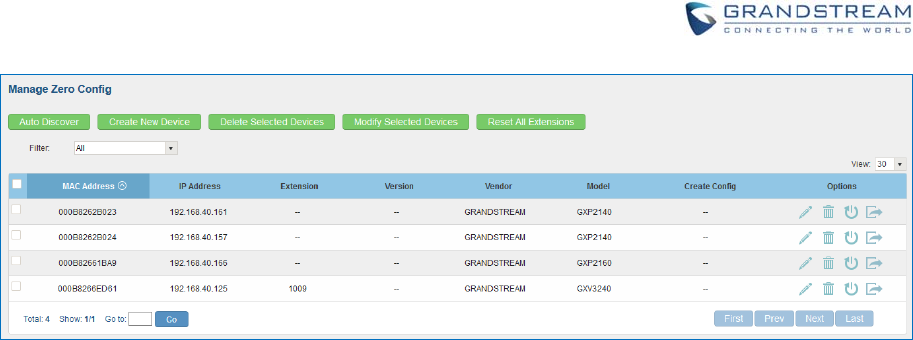
Firmware Version 1.0.0.1 UCM6200 Series IP PBX User Manual Page 112 of 320
Figure 78: Device List in Zero Config
In this web page, users can also click on “Reset All Extensions” to reset the extensions of all the devices.
SAMPLEAPPLICATION
Assuming in a small business office where there are 8 GXP2140 phones used by customer support and 1
GXV3275 phone used by customer support supervisor. 3 of the 8 customer support members speak
Spanish and the rest speak English. We could deploy the following configurations to provisioning the office
phones for the customer support team.
1. Go to web GUI->PBX->Zero Config->Zero Config Settings, select “Enable Zero Config”.
2. Go to web GUI->PBX->Zero Config->Global Policy, configure Date Format, Time Format and
Firmware Source as follows.
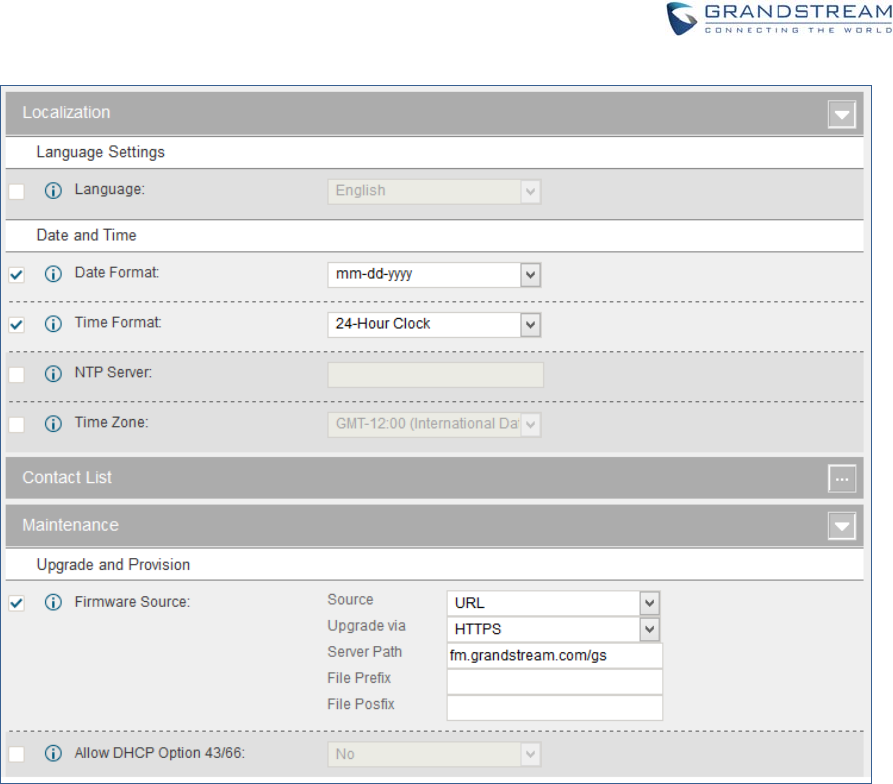
Firmware Version 1.0.0.1 UCM6200 Series IP PBX User Manual Page 113 of 320
Figure 79: Zero Config Sample - Global Policy
3. Go to web GUI->PBX->Zero Config->Model Templates, create a new model template “English
Support Template” for GXP2140. Add option “Language” and set it to “English”. Then select the option
“Default Model Template” to make it the default model template.
4. Go to web GUI->PBX->Zero Config->Model Templates, create another model template “Spanish
Support Template” for GXP2140. Add option “Language” and set it to “Español”.
5. After 9 devices are powered up and connected to the LAN network, use “Auto Discover” function or
“Create New Device” function to add the devices to the device list on web UI->PBX->Zero
Config->Zero Config.
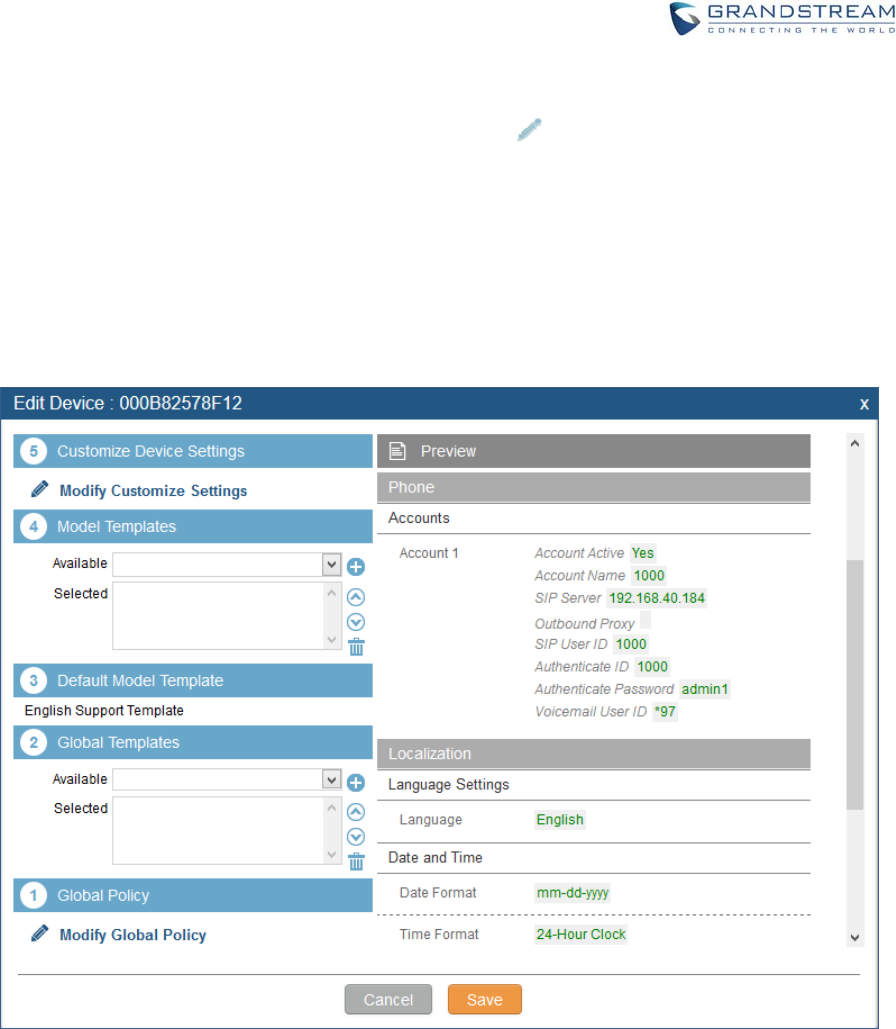
Firmware Version 1.0.0.1 UCM6200 Series IP PBX User Manual Page 114 of 320
6. On web GUI->PBX->Zero Config->Zero Config page, users could identify the devices by their MAC
addresses or IP addresses displayed on the list. Click on to edit the device settings.
7. For each of the 5 phones used by English speaking customer support, in “Basic” settings select an
available extension for account 1 and click on “Save”. Then click on “Advanced” settings tab to bring
up the following dialog. Users will see the English support template is applied since this is the default
model template. A preview of the device settings will be listed on the right side.
Figure 80: Zero Config Sample - Device Preview 1
8. For the 3 phones used by Spanish support, in “Basic” settings select an available extension for
account 1 and click on “Save”. Then click on “Advanced” settings tab to bring up the following dialog.
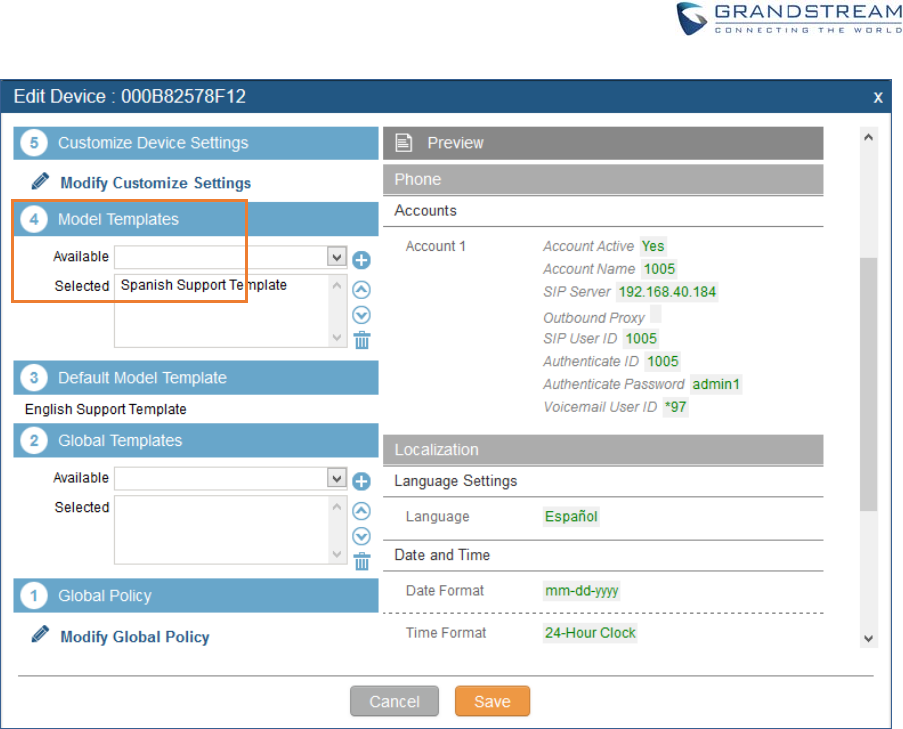
Firmware Version 1.0.0.1 UCM6200 Series IP PBX User Manual Page 115 of 320
Figure 81: Zero Config Sample - Device Preview 2
Select “Spanish Support Template” in ○
4 “Model Template”. The preview of the device settings is
displayed on the right side and we can see the language is set to “Español” since Model Template has
the higher priority for the option “Language”, which overrides the value configured in default model
template.
9. For the GXV3275 used by the customer support supervisor, select an available extension for account
1 on “Basic” settings and click on “Save”. Users can see the preview of the device configuration in
“Advanced” settings. There is no model template configured for GXV3275.
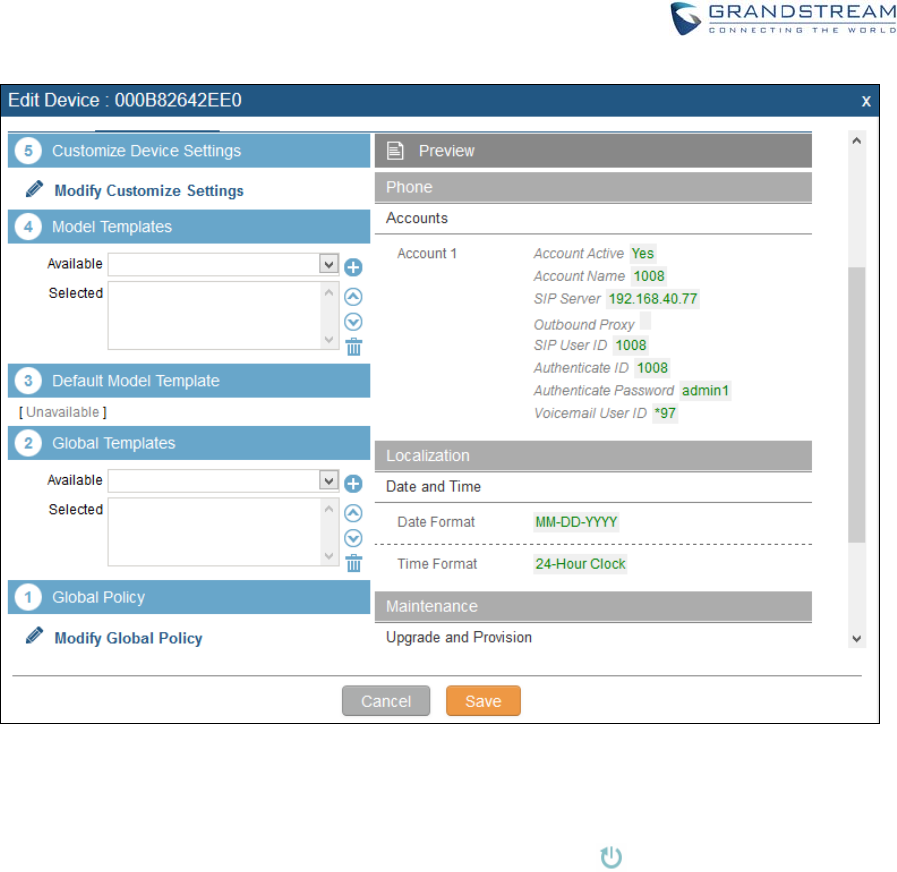
Firmware Version 1.0.0.1 UCM6200 Series IP PBX User Manual Page 116 of 320
Figure 82: Zero Config Sample - Device Preview 3
10. Click on “Apply Changes” to apply saved changes.
11. On the web UI->PBX->Zero Config->Zero Config page, click on to send NOTIFY to trigger the
device to download config file from UCM6200.
Now all the 9 phones in the network will be provisioned with an unique extension registered on the
UCM6200. 3 of the phones will be provisioned to display Spanish on LCD and the other 5 will be
provisioned to display English on LCD. The GXV3275 used by the supervisor will be provisioned to use the
default language on LCD display since it’s not specified in the global policy.

Firmware Version 1.0.0.1 UCM6200 Series IP PBX User Manual Page 117 of 320
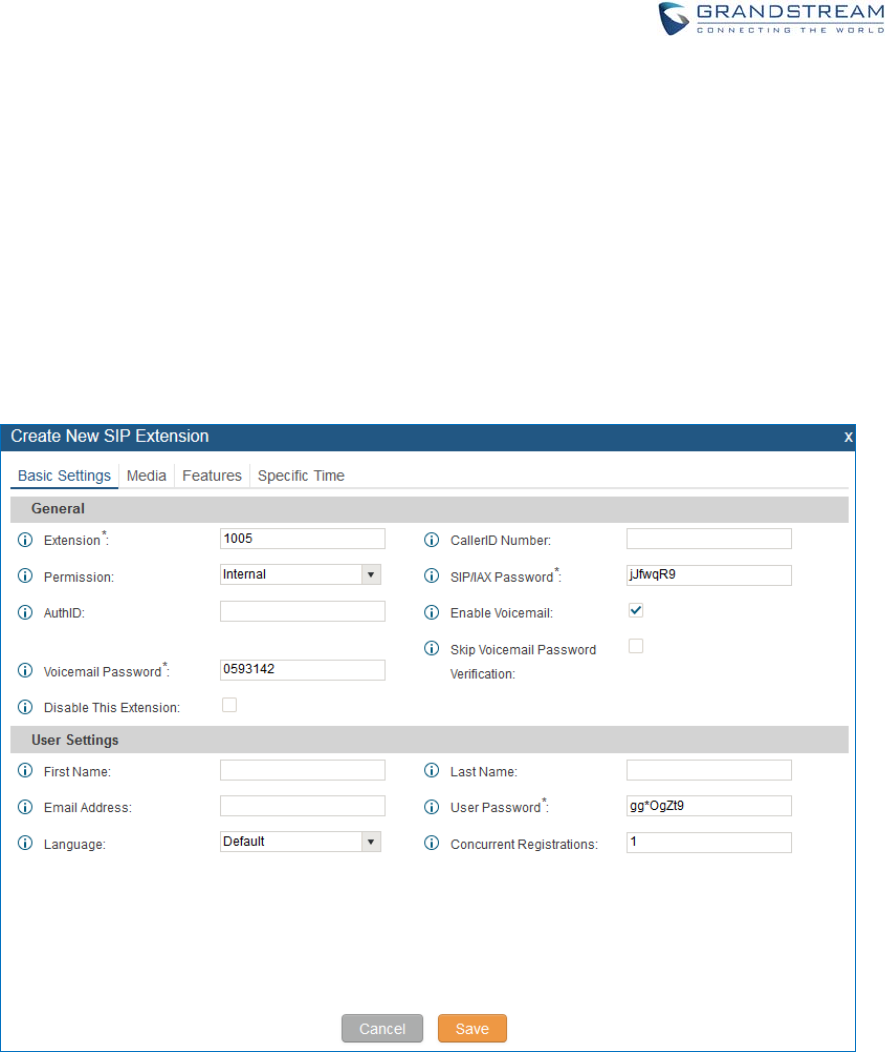
Firmware Version 1.0.0.1 UCM6200 Series IP PBX User Manual Page 118 of 320
EXTENSIONS
CREATENEWUSER
CREATENEWSIPEXTENSION
To manually create new SIP user, go to Web GUI->PBX->Basic/Call Routes->Extensions. Click on
"Create New User"->"Create New SIP Extension" and a new dialog window will show for users to fill in the
extension information.
Figure 83: Create New Device
SIP extension options are divided into four categories:
Basic Settings
Media
Features
Specific Time
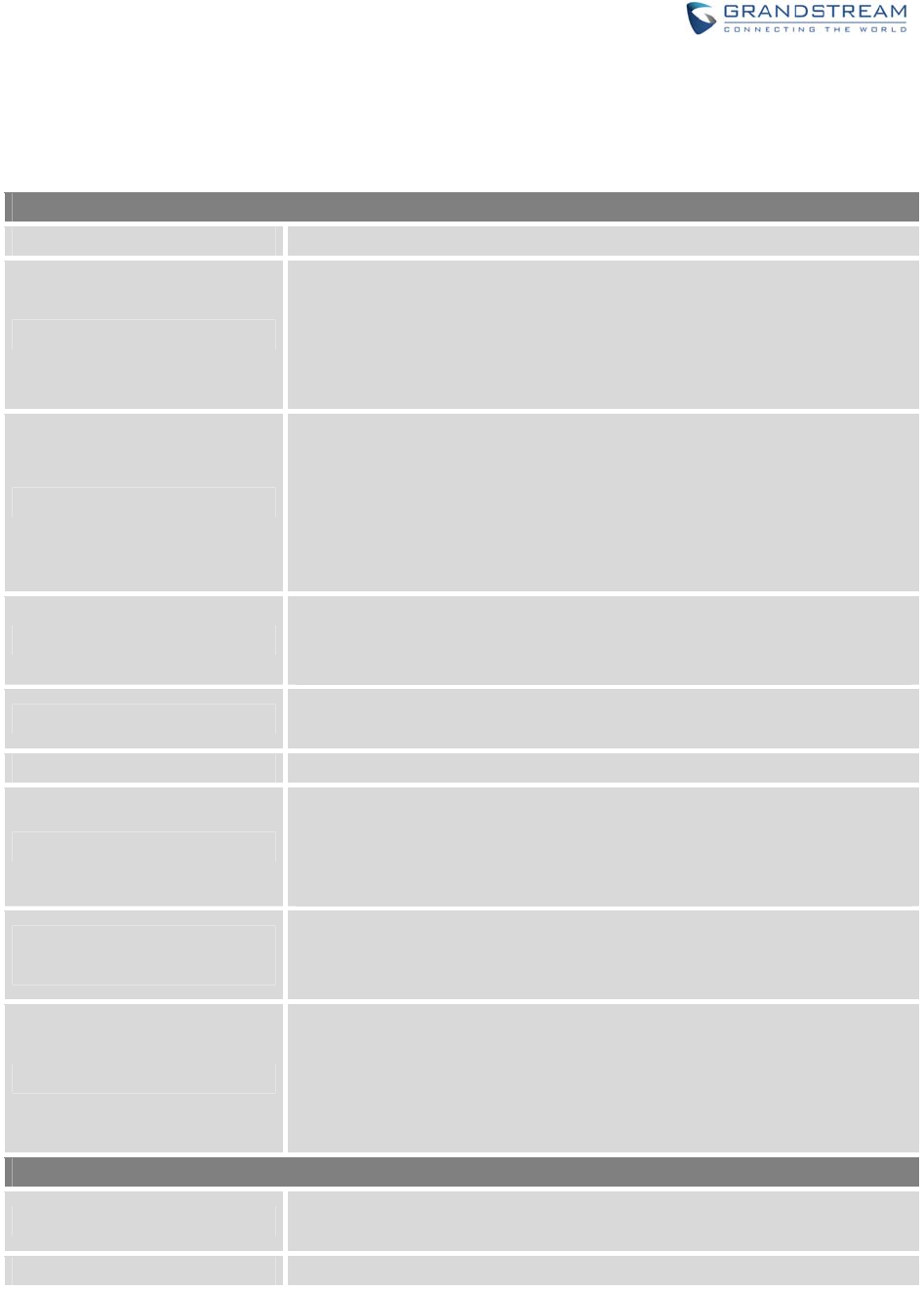
Firmware Version 1.0.0.1 UCM6200 Series IP PBX User Manual Page 119 of 320
Click on the tag to view or edit options belonging to that category.
The configuration parameters are as follows.
Table 33: SIP Extension Configuration Parameters->Basic Settings
General
Extension The extension number associated with the user.
CallerID Number
Configure the CallerID Number that would be applied for outbound calls
from this user.
Note:
The ability to manipulate your outbound Caller ID may be limited by your
VoIP provider.
Permission
Assign permission level to the user. The available permissions are
"Internal", "Local", "National" and "International" from the lowest level to
the highest level. The default setting is "Internal".
Note:
Users need to have the same level as or higher level than an outbound
rule's privilege in order to make outbound calls using this rule.
SIP/IAX Password
Configure the password for the user. A random secure password will be
automatically generated. It is recommended to use this password for
security purpose.
Auth ID Configure the authentication ID for the user. If not configured, the
extension number will be used for authentication.
Enable Voicemail Enable voicemail for the user. The default setting is "Yes".
Voicemail Password
Configure voicemail password (digits only) for the user to access the
voicemail box. A random numeric password is automatically generated. It
is recommended to use the random generated password for security
purpose.
Skip Voicemail Password
Verification
When user dials voicemail code, the password verification IVR is skipped.
If enabled, this would allow one-button voicemail access. By default this
option is disabled.
Disable This Extension
If selected, this extension will be disabled on the UCM6200.
Note:
The disabled extension still exists on the PBX but can’t be used on the
end device.
User Settings
First Name Configure the first name of the user. The first name can contain
characters, letters, digits and _.
Last Name Configure the last name of the user. The last name can contain
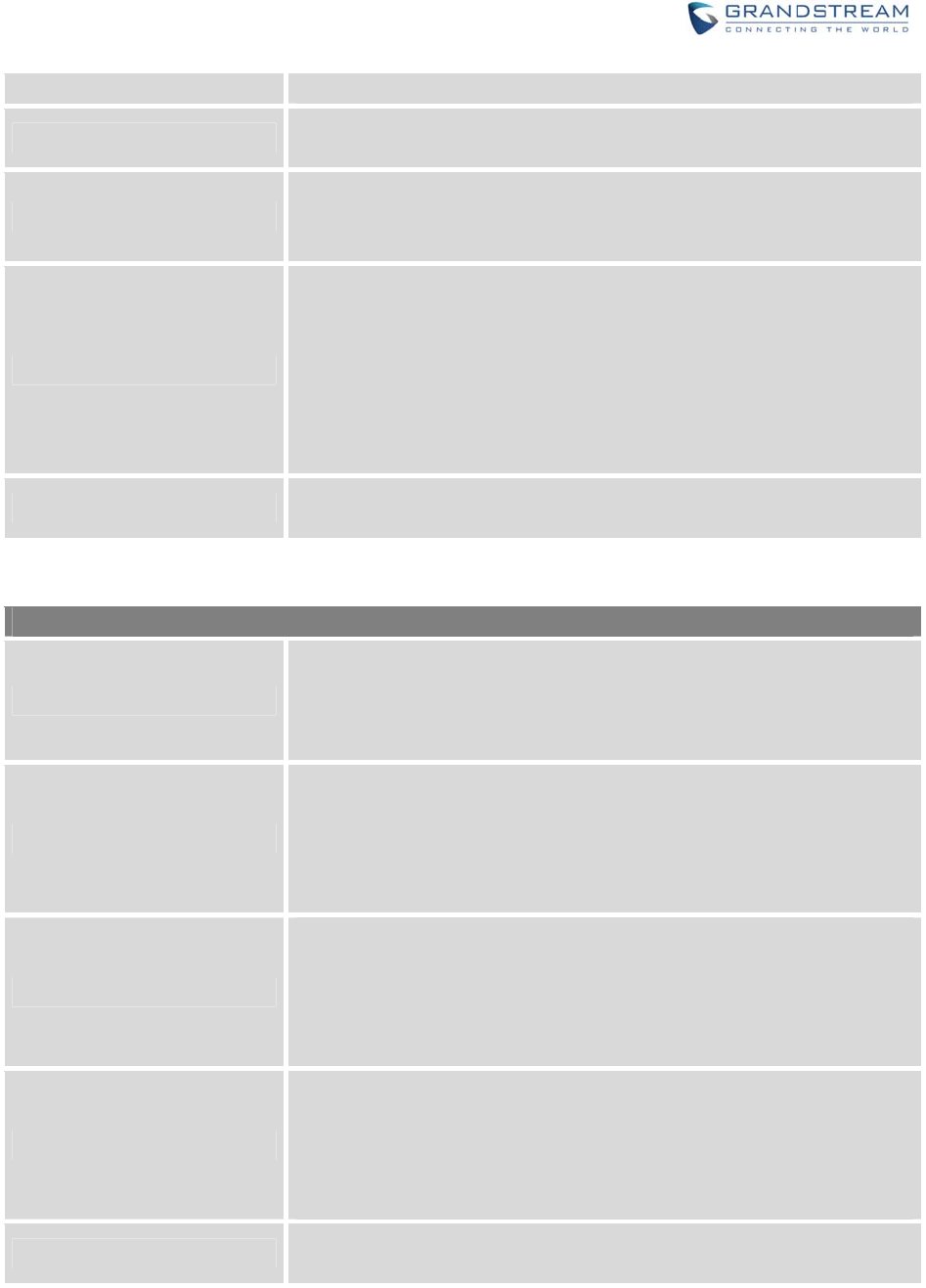
Firmware Version 1.0.0.1 UCM6200 Series IP PBX User Manual Page 120 of 320
characters, letters, digits and _.
Email Address Fill in the Email address for the user. Voicemail will be sent to this Email
address.
User Password
Configure the password for user portal access. A random numeric
password is automatically generated. It is recommended to use the
randomly generated password for security purpose.
Language
Select the voice prompt language to be used for this extension. The
default setting is "Default" which is the selected voice prompt language
under web GUI->PBX->Internal Options->Language. The dropdown list
shows all the current available voice prompt languages on the UCM6200.
To add more languages in the list, please download voice prompt
package by selecting "Check Prompt List" under web UI->PBX->Internal
Options->Language.
Concurrent Registrations The maximum endpoints which can be registered into this extension. For
security concerns, the default value is 1.
Table 34: SIP Extension Configuration Parameters->Media
SIP Settings
NAT
Use NAT when the UCM6200 is on a public IP communicating with
devices hidden behind NAT (e.g., broadband router). If there is one-way
audio issue, usually it's related to NAT configuration or Firewall's support
of SIP and RTP ports. The default setting is enabled.
Can Direct Media
By default, the UCM6200 will route the media steams from SIP endpoints
through itself. If enabled, the PBX will attempt to negotiate with the
endpoints to route the media stream directly. It is not always possible for
the UCM6200 to negotiate endpoint-to-endpoint media routing. The
default setting is "No".
DTMF Mode
Select DTMF mode for the user to send DTMF. The default setting is
"RFC2833". If "Info" is selected, SIP INFO message will be used. If
"Inband" is selected, 64-kbit PCMU and PCMA are required. When "Auto"
is selected, RFC2833 will be used if offered, otherwise "Inband" will be
used.
TEL URI
If the phone has an assigned PSTN telephone number, this field should
be set to “User=Phone”. “User=Phone” parameter will be attached to the
Request-Line and “TO” header in the SIP request to indicate the E.164
number. If set to “Enable”, “Tel” will be used instead of “SIP” in the SIP
request.
Enable Keep-alive If enabled, empty SDP packet will be sent to the SIP server periodically to
keep the NAT port open. The default setting is "Yes".
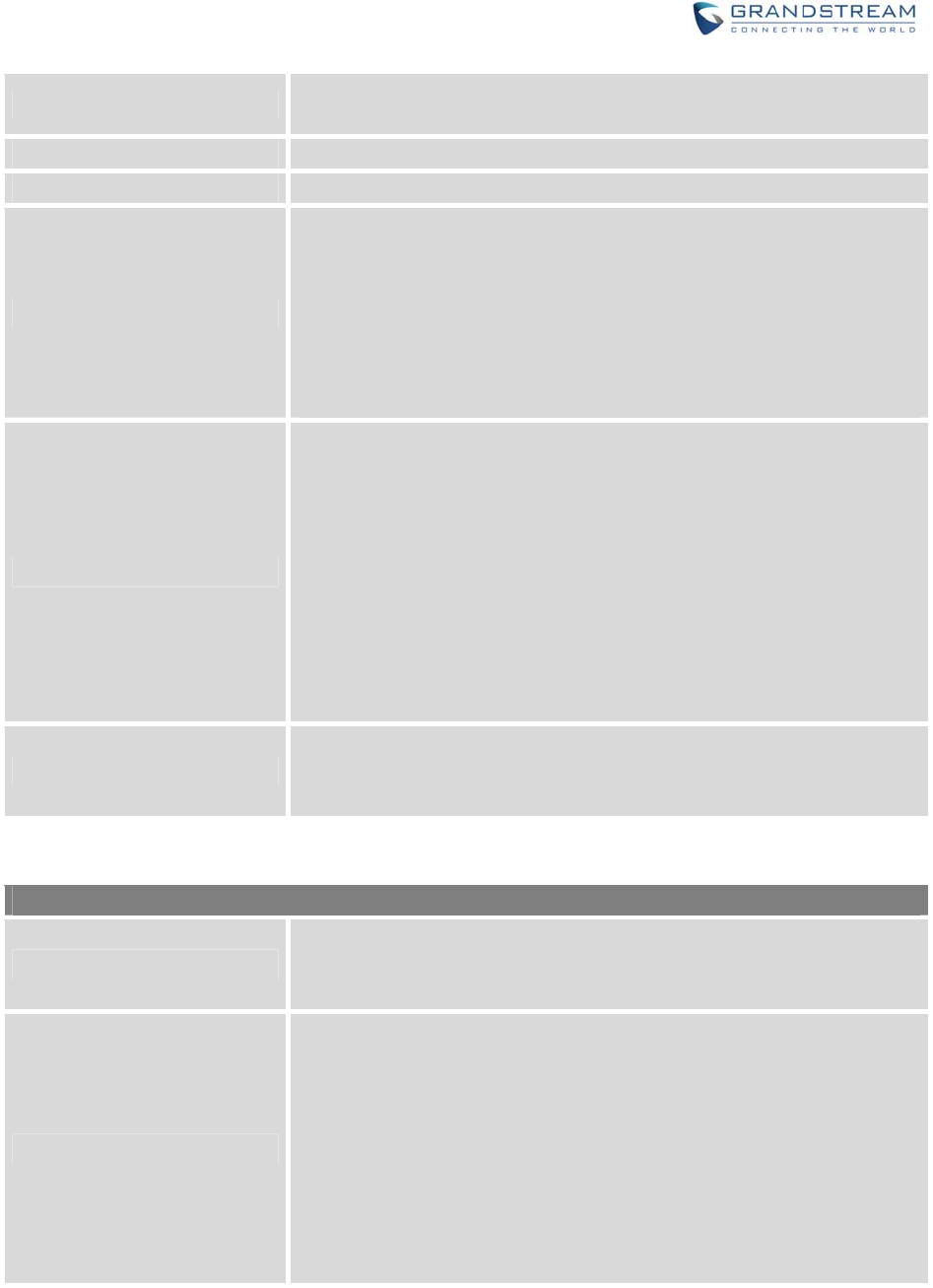
Firmware Version 1.0.0.1 UCM6200 Series IP PBX User Manual Page 121 of 320
Keep-alive Frequency Configure the Keep-alive interval (in seconds) to check if the host is up.
The default setting is 60 seconds.
Enable T.38 UDPTL Enable or disable T.38 UDPTL support.
SRTP Enable SRTP for the call. The default setting is disabled.
Fax Mode
Select Fax mode. The default setting is “None”.
None: Disable Fax.
Fax Detect: Fax signal from the user/trunk during the call can be
detected and the received Fax will be sent to the Email address
configured for this extension. If no Email address can be found for the
user, the Fax will be sent to the default Email address configured in
Fax setting page under web UI->PBX->Internal Options->Fax/T.38.
Strategy
This option controls how the extension can be used on devices within
different types of network.
Allow All
Device in any network can register this extension.
Local Subnet Only
Only the user in specific subnet can register this extension. Up to
three subnet addresses can be specified.
A Specific IP Address
Only the device on the specific IP address can register this extension.
The default setting is "Allow All".
Codec Preference
Select audio and video codec for the extension. The available codecs are:
PCMU, PCMA, GSM, AAL2-G.726-32, G,726, G.722, G.729, G.723, iLBC,
ADPCM, H.264, H.263, H.263p and VP8.
Table 35: SIP Extension Configuration Parameters->Features
Call Transfer
Call Forward Unconditional
Configure the Call Forward Unconditional target number. If not
configured, the Call Forward Unconditional feature is deactivated. The
default setting is deactivated.
CFU Time Condition
Select time condition for Call Forward Unconditional. CFU takes effect
only during the selected time condition. The available time condition are
“Office Time”, “Out of Office Time”, “Holiday”, “Out of Holiday”, “Out of
Office Time or Holiday” and “Specific”.
Note:
“Specific” has higher priority to “Office Times” if there is a conflict in
terms of time period.
Specific time can be configured on the bottom of the extension
configuration dialog. Scroll down the add Time Condition for specific

Firmware Version 1.0.0.1 UCM6200 Series IP PBX User Manual Page 122 of 320
time.
Office Time and Holiday could be configured on page Settings->Time
Settings->Office Time/Holiday page.
Call Forward No Answer
Configure the Call Forward No Answer target number. If not configured,
the Call Forward No Answer feature is deactivated. The default setting is
deactivated.
CFN Time Condition
Select time condition for Call Forward No Answer. The available time
condition are “Office Time”, “Out of Office Time”, “Holiday”, “Out of
Holiday”, “Out of Office Time or Holiday” and “Specific”.
Note:
“Specific” has higher priority to “Office Times” if there is a conflict in
terms of time period.
Specific time can be configured on the bottom of the extension
configuration dialog. Scroll down the add Time Condition for specific
time.
Office Time and Holiday could be configured on page Settings->Time
Settings->Office Time/Holiday page.
Call Forward Busy Configure the Call Forward Busy target number. If not configured, the Call
Forward Busy feature is deactivated. The default setting is deactivated.
CFB Time Condition
Select time condition for Call Forward Busy. The available time condition
are “Office Time”, “Out of Office Time”, “Holiday”, “Out of Holiday”, “Out of
Office Time or Holiday” and “Specific”.
Note:
“Specific” has higher priority to “Office Times” if there is a conflict in
terms of time period.
Specific time can be configured on the bottom of the extension
configuration dialog. Scroll down the add Time Condition for specific
time.
Office Time and Holiday could be configured on page Settings->Time
Settings->Office Time/Holiday page.
CC Settings
Enable CC
If enabled, UCM6200 will automatically alert this extension when a called
party is available, given that a previous call to that party failed for some
reason. By default it’s disabled.
CC Mode
Two modes for Call Completion are supported:
Normal: This extension is used as ordinary extension.
For Trunk: This extension is registered from a PBX.
The default setting is “Normal”.
CC Max Agents Configure the maximum number of CCSS agents which may be allocated
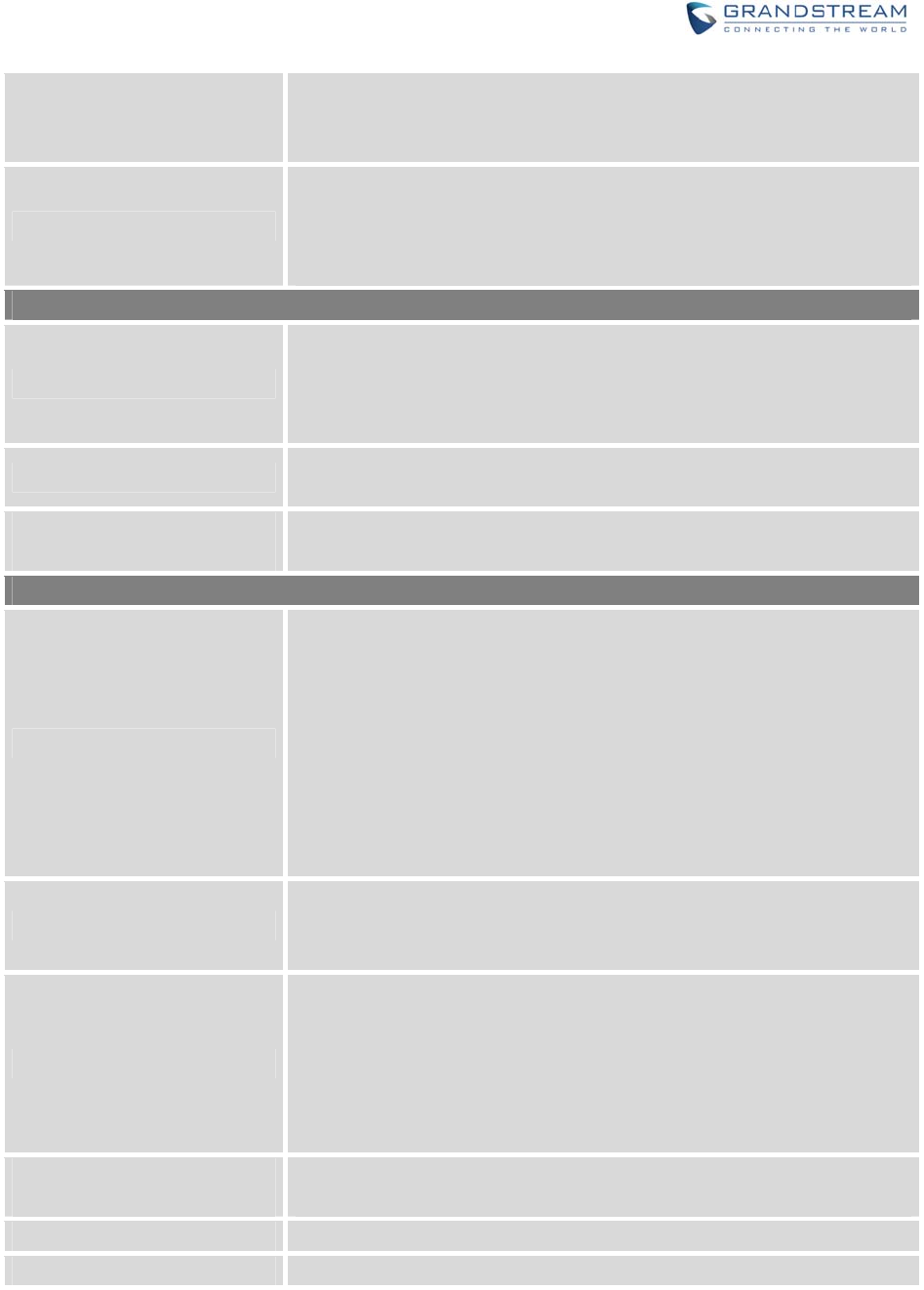
Firmware Version 1.0.0.1 UCM6200 Series IP PBX User Manual Page 123 of 320
for this channel. In other words, this number serves as the maximum
number of CC requests this channel is allowed to make. The minimum
value is 1.
CC Max Monitors
Configure the maximum number of monitor structures which may be
created for this device. In other words, this number tells how many callers
may request CC services for a specific device at one time. The minimum
value is 1.
Ring Simultaneously
Ring Simultaneously
Enable this option to have an external number ring simultaneously along
with the extension. If a register trunk is used for outbound, the register
number will be used to be displayed for the external number as caller ID
number.
External Number Set the external number to be rang simultaneously. ‘-’ is the connection
character which will be ignored.
Time Condition for Ring
Simultaneously
Ring the external number simultaneously along with the extension on the
basis of this time condition.
Other Settings
Ring Timeout
Configure the number of seconds to ring the user before the call is
forwarded to voicemail (voicemail is enabled) or hang up (voicemail is
disabled). If not specified, the default ring timeout is 60 seconds on the
UCM6200, which can be configured in the global ring timeout setting
under web GUI->Internal Options->IVR Prompt: General Preference. The
valid range is between 5 seconds and 600 seconds.
Note:
If the end point also has a ring timeout configured, the actual ring timeout
used is the shortest time set by either device.
Auto Record
Enable automatic recording for the calls using this extension. The default
setting is disabled. The recording files can be accessed under web
GUI->CDR->Recording Files.
Skip Trunk Auth
If set to “yes”, users can skip entering the password when making
outbound calls.
If set to “By Time”, users can skip entering the password when
making outbound calls during the selected time condition.
If set to “No”, users will be asked to enter the password when making
outbound calls.
Time Condition for Skip
Trunk Auth
If ‘Skip Trunk Auth’ is set to ‘By Time’, select a time condition during which
users can skip entering password when making outbound calls.
Dial Trunk Password Configure personal password when making outbound calls via trunk.
Support Hot-Desking Mode If enabled, SIP Password will accept only alphabet characters and digits.
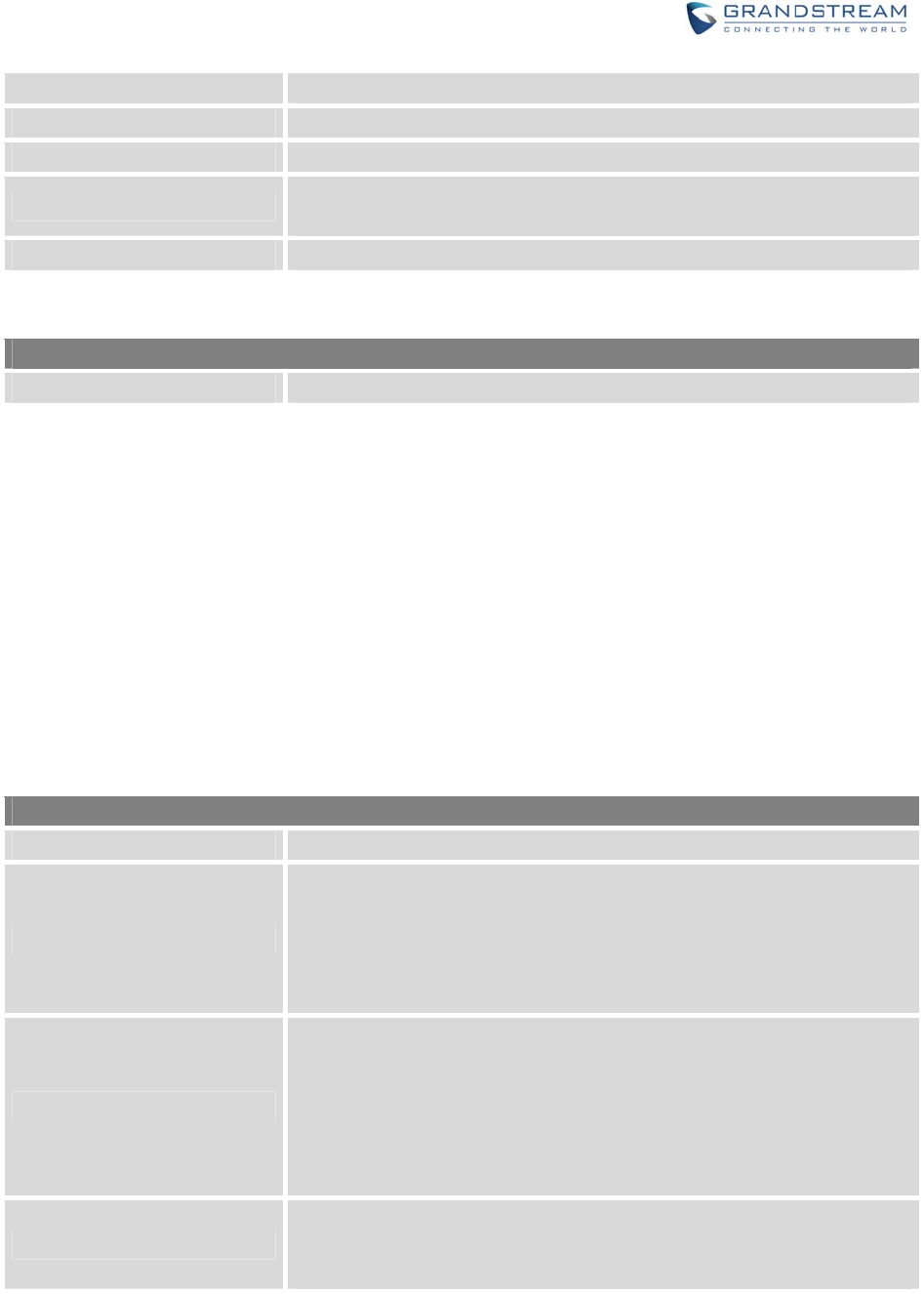
Firmware Version 1.0.0.1 UCM6200 Series IP PBX User Manual Page 124 of 320
Auth ID will be changed to the same as Extension.
Enable LDAP If enabled, the extension will be added to LDAP Phonebook PBX list.
Enable WebRTC Support Enable registration and call from WebRTC.
Music On Hold Specify which Music On Hold class to suggest to the bridged channel
when putting them on hold.
Call Duration Limit The maximum duration of call-blocking.
Table 36: SIP Extension Configuration Parameters->Specific Time
Specific Time
Time Condition Click to add Time Condition to configure specific time for this extension.
CREATENEWIAXEXTENSION
The UCM6200 supports Inter-Asterisk eXchange (IAX) protocol. IAX is used for transporting VoIP
telephony sessions between servers and terminal devices. IAX is similar to SIP but also has its own
characteristic. For more information, please refer to RFC 5465.
To manually create new IAX user, go to Web GUI->PBX->Basic/Call Routes->Extensions. Click on
"Create New User"->"Create New IAX Extension" and a new dialog window will show for users to fill in the
extension information. The configuration parameters are as follows.
Table 37: IAX Extension Configuration Parameters->Basic Settings
General
Extension The extension number associated with the user.
CallerID Number
Configure the CallerID Number that would be applied for outbound calls
from this user.
Note:
The ability to manipulate your outbound Caller ID may be limited by your
VoIP provider.
Permission
Assign permission level to the user. The available permissions are
"Internal", "Local", "National" and "International" from the lowest level to
the highest level. The default setting is "Internal".
Note:
Users need to have the same level as or higher level than an outbound
rule's privilege in order to make outbound calls using this rule.
SIP/IAX Password
Configure the password for the user. A random secure password will be
automatically generated. It is recommended to use this password for
security purpose.
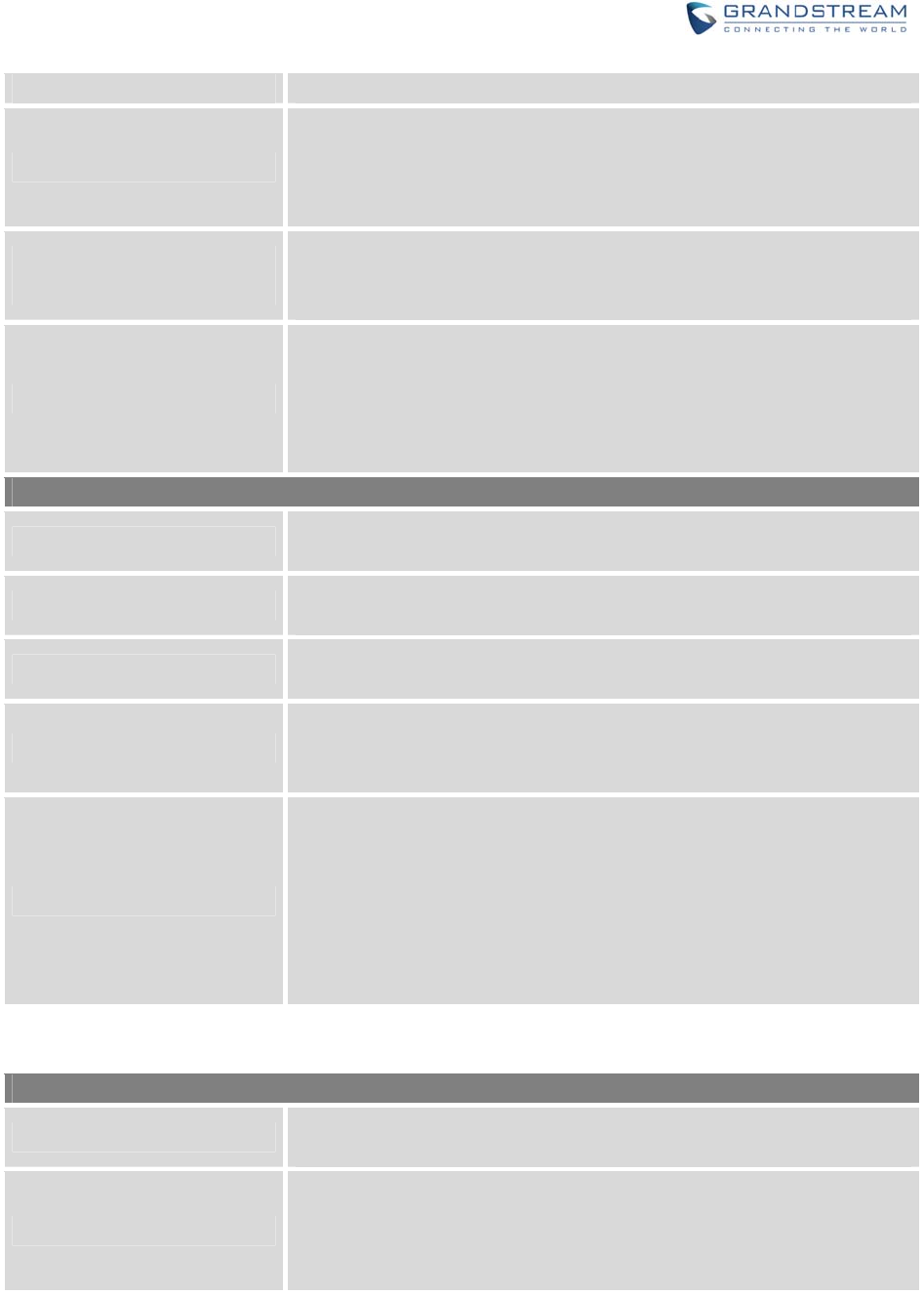
Firmware Version 1.0.0.1 UCM6200 Series IP PBX User Manual Page 125 of 320
Enable Voicemail Enable voicemail for the user. The default setting is "Yes".
Voicemail Password
Configure voicemail password (digits only) for the user to access the
voicemail box. A random numeric password is automatically generated. It
is recommended to use the random generated password for security
purpose.
Skip Voicemail Password
Verification
When user dials voicemail code, the password verification IVR is skipped.
If enabled, this would allow one-button voicemail access. By default this
option is disabled.
Disable This Extension
If selected, this extension will be disabled on the UCM6200.
Note:
The disabled extension still exists on the PBX but can’t be used on the
end device.
User Settings
First Name Configure the first name of the user. The first name can contain
characters, letters, digits and _.
Last Name Configure the last name of the user. The last name can contain
characters, letters, digits and _.
Email Address Fill in the Email address for the user. Voicemail will be sent to this Email
address.
User Password
Configure the password for user portal access. A random numeric
password is automatically generated. It is recommended to use the
randomly generated password for security purpose.
Language
Select the voice prompt language to be used for this extension. The
default setting is "Default" which is the selected voice prompt language
under web GUI->PBX->Internal Options->Language. The dropdown list
shows all the current available voice prompt languages on the UCM6200.
To add more languages in the list, please download voice prompt
package by selecting "Check Prompt List" under web UI->PBX->Internal
Options->Language.
Table 38: IAX Extension Configuration Parameters->Media
SIP Settings
Max Number of Calls Configure the maximum number of calls allowed for each remote IP
address.
Require Call Token
Configure to enable/disable requiring call token. If set to "Auto", it might
lock out users who depend on backward compatibility when peer
authentication credentials are shared between physical endpoints. The
default setting is "Yes".

Firmware Version 1.0.0.1 UCM6200 Series IP PBX User Manual Page 126 of 320
SRTP Enable SRTP for the call. The default setting is disabled.
Fax Mode
Select Fax Mode. The default setting is “None”.
None: Disable Fax. This is the default setting.
Fax Detect: Fax signal from the user/trunk during the call can be
detected and the received Fax will be sent to the Email address
configured for this extension. If no Email address can be found for the
user, the Fax will be sent to the default Email address configured in
Fax setting page under web UI->PBX->Internal Options->Fax/T.38.
Strategy
This option controls how the extension can be used on devices within
different types of network.
Allow All
Device in any network can register this extension.
Local Subnet Only
Only the user in specific subnet can register this extension. Up to
three subnet addresses can be specified.
A Specific IP Address
Only the device on the specific IP address can register this extension.
The default setting is "Allow All".
Codec Preference
Select audio and video codec for the extension. The available codecs are:
PCMU, PCMA, GSM, AAL2-G.726-32, G,726, G.722, G.729, G.723, iLBC,
ADPCM, H.264, H.263, H.263p and VP8.
Table 39: IAX Extension Configuration Parameters->Features
Call Transfer
Call Forward Unconditional
Configure the Call Forward Unconditional target number. If not
configured, the Call Forward Unconditional feature is deactivated. The
default setting is deactivated.
CFU Time Condition
Select time condition for Call Forward Unconditional. CFU takes effect
only during the selected time condition. The available time condition are
“Office Time”, “Out of Office Time”, “Holiday”, “Out of Holiday”, “Out of
Office Time or Holiday” and “Specific”.
Note:
“Specific” has higher priority to “Office Times” if there is a conflict in
terms of time period.
Specific time can be configured on the bottom of the extension
configuration dialog. Scroll down the add Time Condition for specific
time.
Office Time and Holiday could be configured on page Settings->Time

Firmware Version 1.0.0.1 UCM6200 Series IP PBX User Manual Page 127 of 320
Settings->Office Time/Holiday page.
Call Forward No Answer
Configure the Call Forward No Answer target number. If not configured,
the Call Forward No Answer feature is deactivated. The default setting is
deactivated.
CFN Time Condition
Select time condition for Call Forward No Answer. The available time
condition are “Office Time”, “Out of Office Time”, “Holiday”, “Out of
Holiday”, “Out of Office Time or Holiday” and “Specific”.
Note:
“Specific” has higher priority to “Office Times” if there is a conflict in
terms of time period.
Specific time can be configured on the bottom of the extension
configuration dialog. Scroll down the add Time Condition for specific
time.
Office Time and Holiday could be configured on page Settings->Time
Settings->Office Time/Holiday page.
Call Forward Busy Configure the Call Forward Busy target number. If not configured, the Call
Forward Busy feature is deactivated. The default setting is deactivated.
CFB Time Condition
Select time condition for Call Forward Busy. The available time condition
are “Office Time”, “Out of Office Time”, “Holiday”, “Out of Holiday”, “Out of
Office Time or Holiday” and “Specific”.
Note:
“Specific” has higher priority to “Office Times” if there is a conflict in
terms of time period.
Specific time can be configured on the bottom of the extension
configuration dialog. Scroll down the add Time Condition for specific
time.
Office Time and Holiday could be configured on page Settings->Time
Settings->Office Time/Holiday page.
Ring Simultaneously
Ring Simultaneously
Enable this option to have an external number ring simultaneously along
with the extension. If a register trunk is used for outbound, the register
number will be used to be displayed for the external number as caller ID
number.
External Number Set the external number to be rang simultaneously. ‘-’ is the connection
character which will be ignored.
Time Condition for Ring
Simultaneously
Ring the external number simultaneously along with the extension on the
basis of this time condition.
Other Settings
Ring Timeout Configure the number of seconds to ring the user before the call is
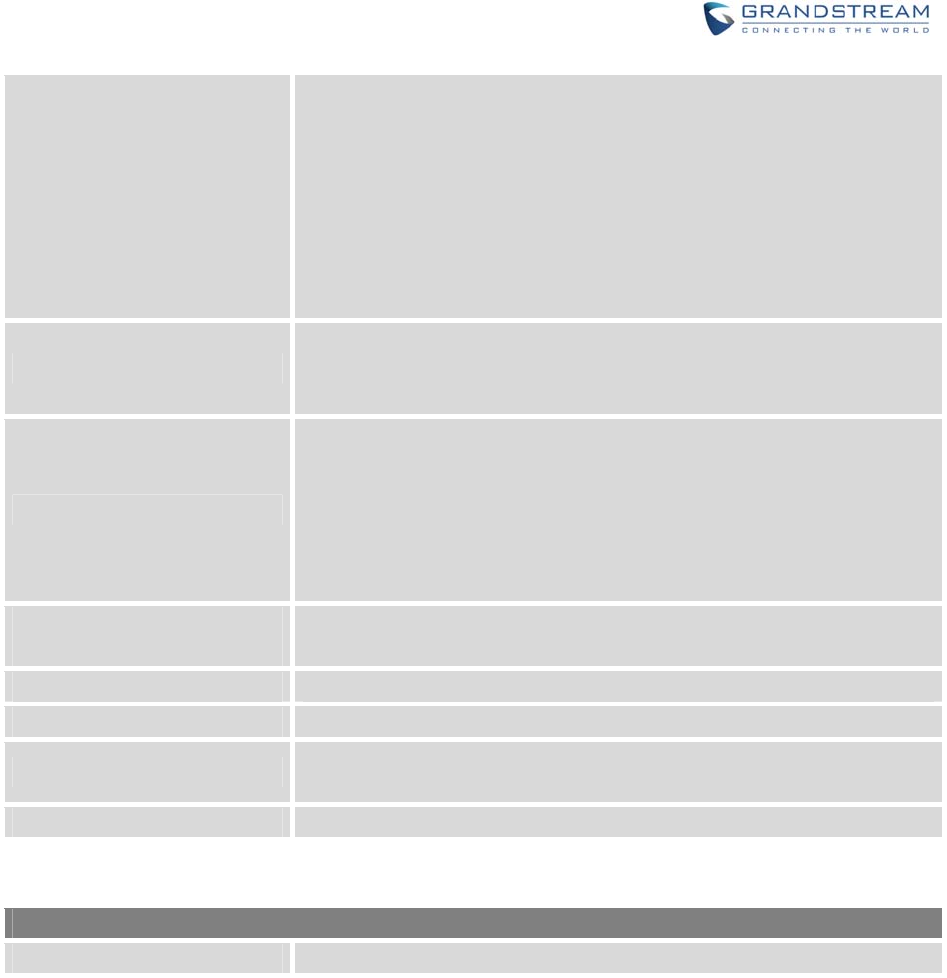
Firmware Version 1.0.0.1 UCM6200 Series IP PBX User Manual Page 128 of 320
forwarded to voicemail (voicemail is enabled) or hang up (voicemail is
disabled). If not specified, the default ring timeout is 60 seconds on the
UCM6200, which can be configured in the global ring timeout setting
under web GUI->Internal Options->IVR Prompt: General Preference. The
valid range is between 5 seconds and 600 seconds.
Note:
If the end point also has a ring timeout configured, the actual ring timeout
used is the shortest time set by either device.
Auto Record
Enable automatic recording for the calls using this extension. The default
setting is disabled. The recording files can be accessed under web
GUI->CDR->Recording Files.
Skip Trunk Auth
If set to “Yes”, users can skip entering the password when making
outbound calls.
If set to “By Time”, users can skip entering the password when
making outbound calls during the selected time condition.
If set to “No”, users will be asked to enter the password when making
outbound calls.
Time Condition for Skip
Trunk Auth
If “Skip Trunk Auth” is set to “By Time”, select a time condition during
which users can skip entering password when making outbound calls.
Dial Trunk Password Configure personal password when making outbound calls via trunk.
Enable LDAP If enabled, the extension will be added to LDAP Phonebook PBX lists.
Music On Hold Configure the Music On Hold class to suggest to the bridged channel
when putting them on hold.
Call Duration Limit The maximum duration of call-blocking.
Table 40: IAX Extension Configuration Parameters->Specific Time
Specific Time
Time Condition Click to add Time Condition to configure specific time for this extension.
CREATENEWFXSEXTENSION
The UCM6200 supports Foreign eXchange Subscriber (FXS) interface. FXS is used when user needs to
connect analog phone lines or FAX machines to the UCM6200.
To manually create new FXS user, go to Web GUI->PBX->Basic/Call Routes->Extensions. Click on
"Create New User"->"Create New FXS Extension" and a new dialog window will show for users to fill in the
extension information. The configuration parameters are as follows.
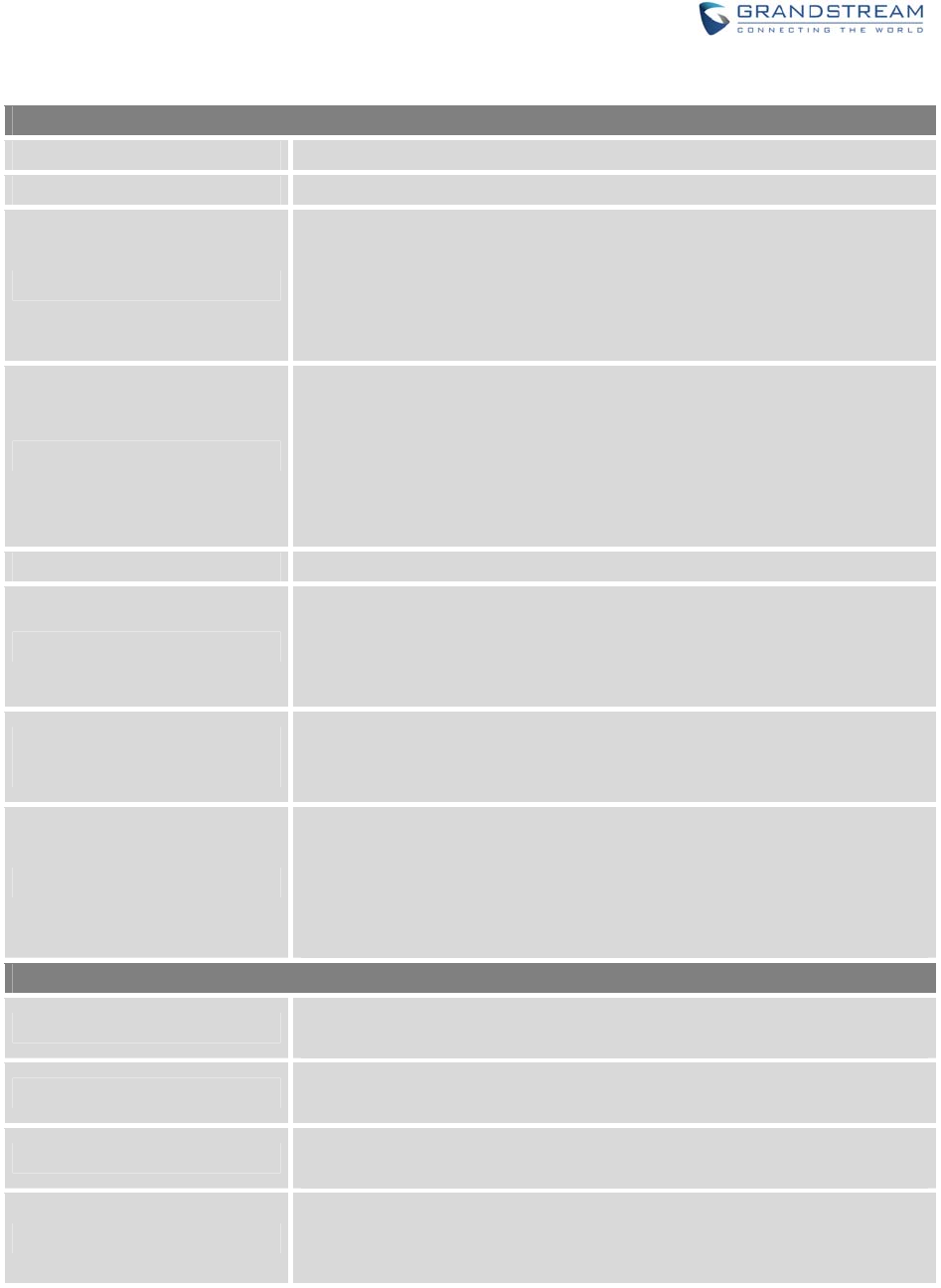
Firmware Version 1.0.0.1 UCM6200 Series IP PBX User Manual Page 129 of 320
Table 41: FXS Extension Configuration Parameters->Basic Settings
General
Extension The extension number associated with the user.
Analog Station Select the FXS port to be assigned for this extension.
CallerID Number
Configure the CallerID Number that would be applied for outbound calls
from this user.
Note:
The ability to manipulate your outbound Caller ID may be limited by your
VoIP provider.
Permission
Assign permission level to the user. The available permissions are
"Internal", "Local", "National" and "International" from the lowest level to
the highest level. The default setting is "Internal".
Note:
Users need to have the same level as or higher level than an outbound
rule's privilege in order to make outbound calls using this rule.
Enable Voicemail Enable voicemail for the user. The default setting is "Yes".
Voicemail Password
Configure voicemail password (digits only) for the user to access the
voicemail box. A random numeric password is automatically generated. It
is recommended to use the random generated password for security
purpose.
Skip Voicemail Password
Verification
When user dials voicemail code, the password verification IVR is skipped.
If enabled, this would allow one-button voicemail access. By default this
option is disabled.
Disable This Extension
If selected, this extension will be disabled on the UCM6200.
Note:
The disabled extension still exists on the PBX but can’t be used on the
end device.
User Settings
First Name Configure the first name of the user. The first name can contain
characters, letters, digits and _.
Last Name Configure the last name of the user. The last name can contain
characters, letters, digits and _.
Email Address Fill in the Email address for the user. Voicemail will be sent to this Email
address.
User Password
Configure the password for user portal access. A random numeric
password is automatically generated. It is recommended to use the
randomly generated password for security purpose.
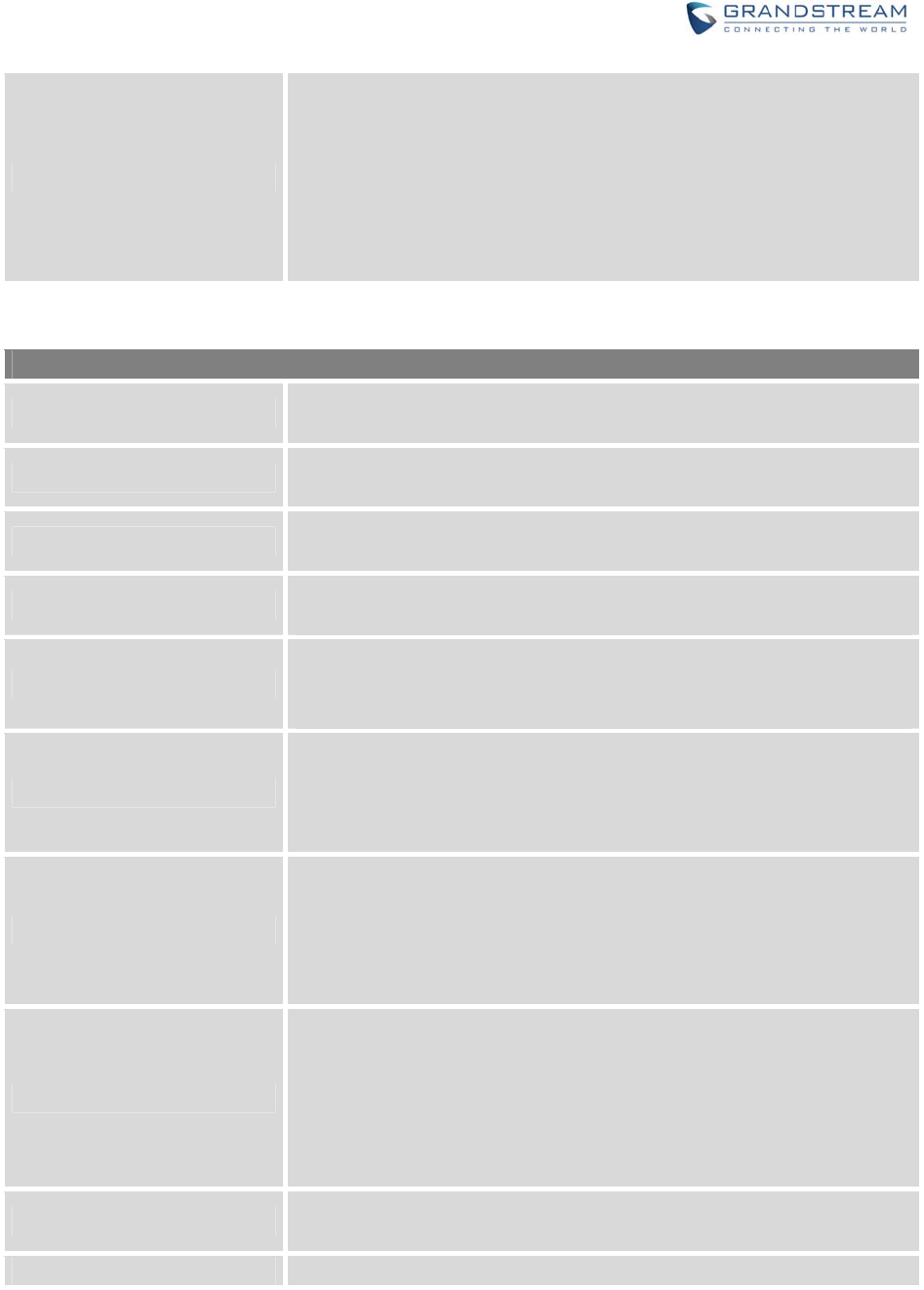
Firmware Version 1.0.0.1 UCM6200 Series IP PBX User Manual Page 130 of 320
Language
Select the voice prompt language to be used for this extension. The
default setting is "Default" which is the selected voice prompt language
under web GUI->PBX->Internal Options->Language. The dropdown list
shows all the current available voice prompt languages on the UCM6200.
To add more languages in the list, please download voice prompt
package by selecting "Check Prompt List" under web UI->PBX->Internal
Options->Language.
Table 42: FXS Extension Configuration Parameters->Media
Analog Settings
Call Waiting Configure to enable/disable call waiting feature. The default setting is
"No".
User ‘#’ as SEND If configured, the # key can be used as SNED key after dialing the
number on the analog phone. The default setting is "Yes".
RX Gain Configure the RX gain for the receiving channel of analog FXS port. The
valid range is -30dB to +6dB. The default setting is 0.
TX Gain Configure the TX gain for the transmitting channel of analog FXS port.
The valid range is -30dB to +6dB. The default setting is 0.
MIN RX Flash
Configure the minimum period of time (in milliseconds) that the hook-flash
must remain unpressed for the PBX to consider the event as a valid flash
event. The valid range is 30ms to 1000ms. The default setting is 200ms.
MAX RX Flash
Configure the maximum period of time (in milliseconds) that the
hook-flash must remain unpressed for the PBX to consider the event as a
valid flash event. The minimum period of time is 256ms and it can't be
modified. The default setting is 1250ms.
Enable Polarity Reversal
If enabled, a polarity reversal will be marked as received when an
outgoing call is answered by the remote party. For some countries, a
polarity reversal is used for signaling the disconnection of a phone line
and the call will be considered as hangup on a polarity reversal. The
default setting is "Yes".
Echo Cancellation
Specify "ON", "OFF" or a value (the power of 2) from 32 to 1024 as the
number of taps of cancellation.
Note:
When configuring the number of taps, the number 256 is not translated
into 256ms of echo cancellation. Instead, 256 taps means 256/8 = 32 ms.
The default setting is "ON", which is 128 taps.
3-Way Calling Configure to enable/disable 3-way calling feature on the user. The default
setting is enabled.
Send CallerID After Configure the number of rings before sending CID. Default setting is 1.

Firmware Version 1.0.0.1 UCM6200 Series IP PBX User Manual Page 131 of 320
Fax Mode
For FXS extension, there are three options available in Fax Mode. The
default setting is “None”.
None: Disable Fax.
Fax Detect: Fax signal from the user/trunk during the call can be
detected and the received Fax will be sent to the Email address
configured for this extension. If no Email address can be found for the
user, the Fax will be sent to the default Email address configured in
Fax setting page under web UI->PBX->Internal Options->Fax/T.38.
Fax Gateway: If selected, the UCM6200 can support conversation
and processing of Fax data from T.30 to T.38 or T.38 to T.30. This
feature is only available for FXS or FXO port.
Table 43: FXS Extension Configuration Parameters->Features
Call Transfer
Call Forward Unconditional
Configure the Call Forward Unconditional target number. If not
configured, the Call Forward Unconditional feature is deactivated. The
default setting is deactivated.
CFU Time Condition
Select time condition for Call Forward Unconditional. CFU takes effect
only during the selected time condition. The available time condition are
“Office Time”, “Out of Office Time”, “Holiday”, “Out of Holiday”, “Out of
Office Time or Holiday” and “Specific”.
Note:
“Specific” has higher priority to “Office Times” if there is a conflict in
terms of time period.
Specific time can be configured on the bottom of the extension
configuration dialog. Scroll down the add Time Condition for specific
time.
Office Time and Holiday could be configured on page Settings->Time
Settings->Office Time/Holiday page.
Call Forward No Answer
Configure the Call Forward No Answer target number. If not configured,
the Call Forward No Answer feature is deactivated. The default setting is
deactivated.
CFN Time Condition
Select time condition for Call Forward No Answer. The available time
condition are “Office Time”, “Out of Office Time”, “Holiday”, “Out of
Holiday”, “Out of Office Time or Holiday” and “Specific”.
Note:
“Specific” has higher priority to “Office Times” if there is a conflict in
terms of time period.
Specific time can be configured on the bottom of the extension
configuration dialog. Scroll down the add Time Condition for specific
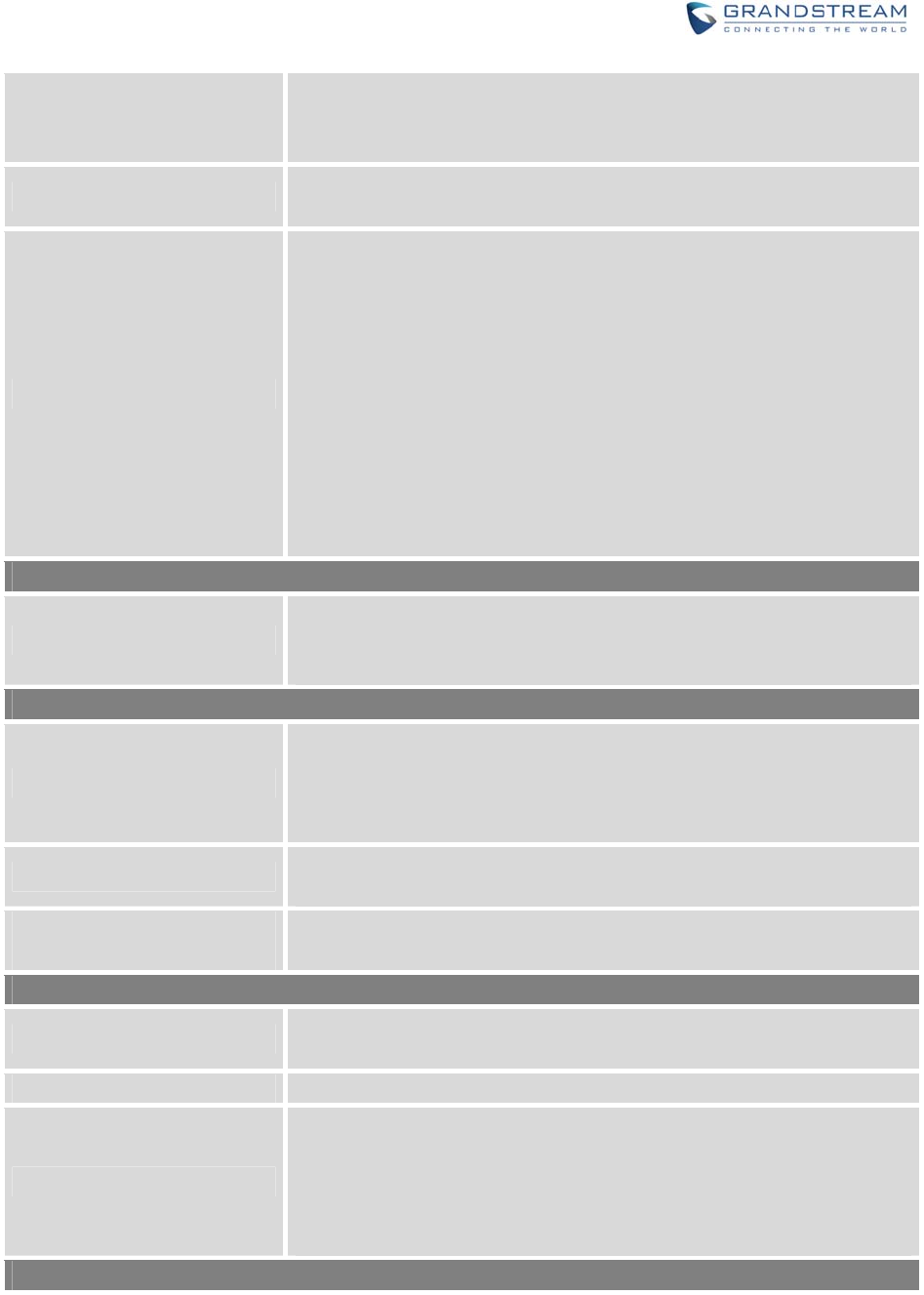
Firmware Version 1.0.0.1 UCM6200 Series IP PBX User Manual Page 132 of 320
time.
Office Time and Holiday could be configured on page Settings->Time
Settings->Office Time/Holiday page.
Call Forward Busy Configure the Call Forward Busy target number. If not configured, the Call
Forward Busy feature is deactivated. The default setting is deactivated.
CFB Time Condition
Select time condition for Call Forward Busy. The available time condition
are “Office Time”, “Out of Office Time”, “Holiday”, “Out of Holiday”, “Out of
Office Time or Holiday” and “Specific”.
Note:
“Specific” has higher priority to “Office Times” if there is a conflict in
terms of time period.
Specific time can be configured on the bottom of the extension
configuration dialog. Scroll down the add Time Condition for specific
time.
Office Time and Holiday could be configured on page Settings->Time
Settings->Office Time/Holiday page.
CC Settings
Enable CC
If enabled, UCM6200 will automatically alert this extension when a called
party is available, given that a previous call to that party failed for some
reason.
Ring Simultaneously
Ring Simultaneously
Enable this option to have an external number ring simultaneously along
with the extension.
If a register trunk is used for outbound, the register number will be used to
be displayed for the external number as caller ID number.
External Number Set the external number to be rang simultaneously. ‘-’ is the connection
character which will be ignored.
Time Condition for Ring
Simultaneously
Ring the external number simultaneously along with the extension on the
basis of this time condition.
Hotline
Enable Hotline If enabled, hotline dialing plan will be activated, a pre-configured number
will be used according to the selected Hotline Type.
Hotline Number Configure the Hotline Number
Hotline Type
Configure the Hotline Type:
Immediate Hotline: When the phone is off-hook, UCM6200 will
immediately dial the preset number
Delay Hotline: When the phone is off-hook, if there is no dialing
within 5 seconds, UCM6200 will dial the preset number.
Other Settings
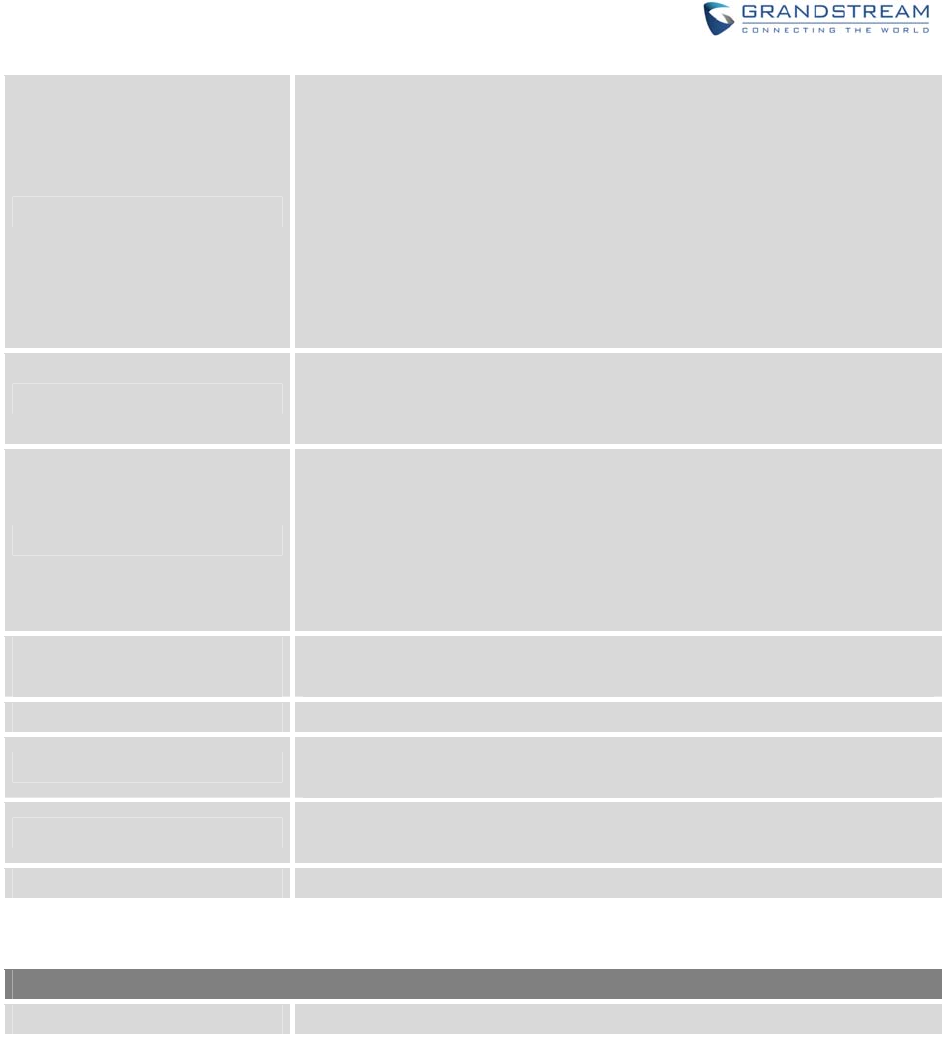
Firmware Version 1.0.0.1 UCM6200 Series IP PBX User Manual Page 133 of 320
Ring Timeout
Configure the number of seconds to ring the user before the call is
forwarded to voicemail (voicemail is enabled) or hang up (voicemail is
disabled). If not specified, the default ring timeout is 60 seconds on the
UCM6200, which can be configured in the global ring timeout setting
under web GUI->Internal Options->IVR Prompt: General Preference. The
valid range is between 5 seconds and 600 seconds.
Note:
If the end point also has a ring timeout configured, the actual ring timeout
used is the shortest time set by either device.
Auto Record
Enable automatic recording for the calls using this extension. The default
setting is disabled. The recording files can be accessed under web
GUI->CDR->Recording Files.
Skip Trunk Auth
If set to “Yes”, users can skip entering the password when making
outbound calls.
If set to “By Time”, users can skip entering the password when
making outbound calls during the selected time condition.
If set to “No”, users will be asked to enter the password when making
outbound calls.
Time Condition for Skip
Trunk Auth
If “Skip Trunk Auth” is set to “By Time”, select a time condition during
which users can skip entering password when making outbound calls.
Dial Trunk Password Configure personal password when making outbound calls via trunk.
Enable LDAP If enabled, this extension will be added to LDAP Phonebook PBX list; if
disabled, this extension will be skipped when creating LDAP Phonebook.
Music On Hold Select which Music On Hold class to suggest to extension when putting
the active call on hold.
Call Duration Limit Configure the maximum duration of call-blocking.
Table 44: FXS Extension Configuration Parameters->Specific Time
Specific Time
Time Condition Click to add Time Condition to configure specific time for this extension.
BATCHADDEXTENSIONS
BATCHADDSIPEXTENSIONS
In order to add multiple SIP extensions, BATCH add can be used to create standardized SIP extension
accounts. However, unique extension user name can’t be set using BATCH add.
Under Web GUI->PBX->Basic/Call Routes->Extensions, click on "Batch Add Extensions"->"Batch Add
SIP Extensions".
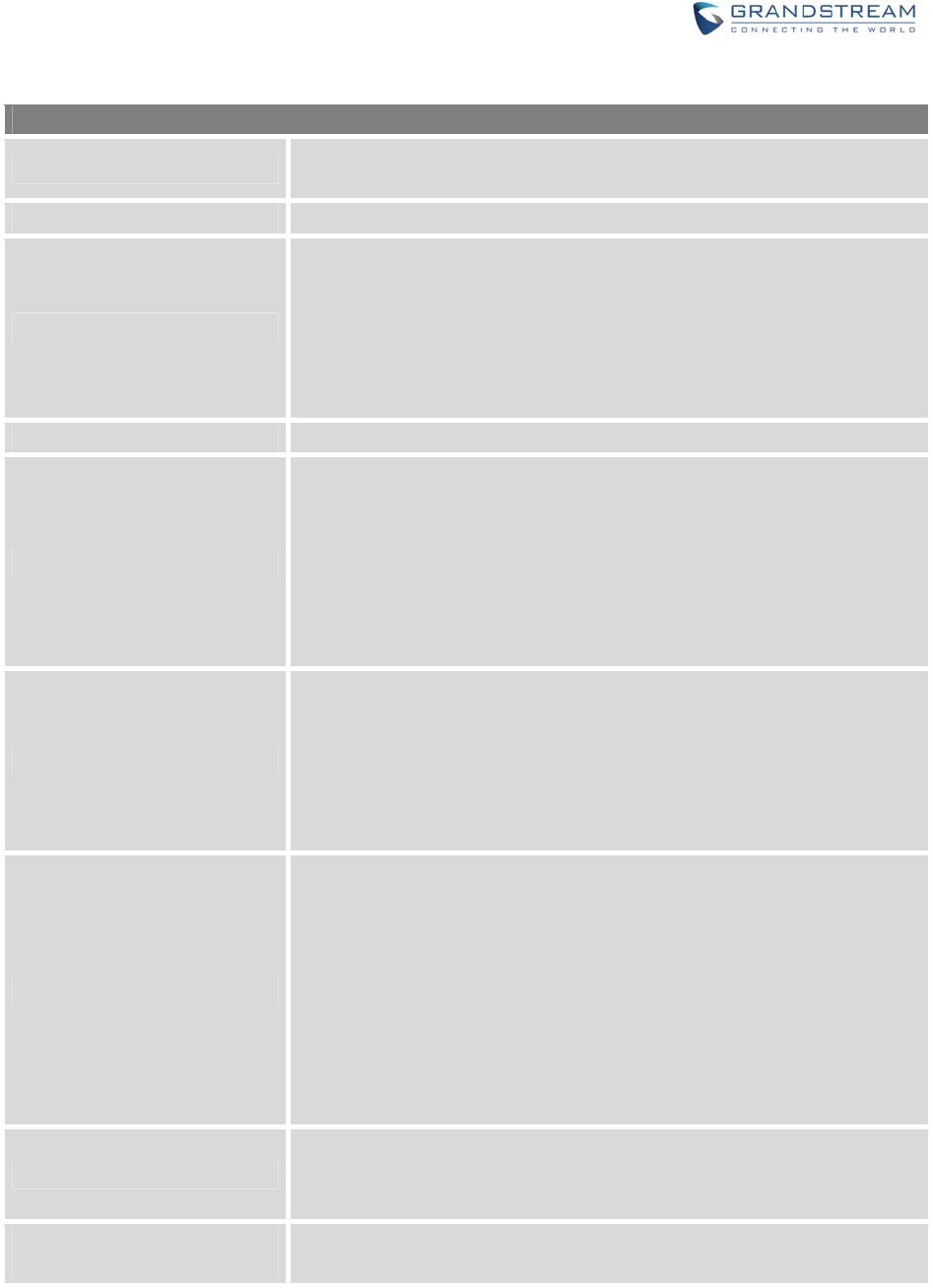
Firmware Version 1.0.0.1 UCM6200 Series IP PBX User Manual Page 134 of 320
Table 45: Batch Add SIP Extension Parameters
General
Start Extension Configure the starting extension number of the batch of extensions to be
added.
Create Number Specify the number of extensions to be added. The default setting is 5.
Permission
Assign permission level to the user. The available permissions are
"Internal", "Local", "National" and "International" from the lowest level to
the highest level. The default setting is "Internal".
Note:
Users need to have the same level as or higher level than an outbound
rule's privilege in order to make outbound calls from this rule.
Enable Voicemail Enable Voicemail for the user. The default setting is "Yes".
SIP/IAX Password
Configure the SIP/IAX password for the users. Three options are
available to create password for the batch of extensions.
User Random Password.
A random secure password will be automatically generated. It is
recommended to use this password for security purpose.
Use Extension as Password.
Enter a password to be used on all the extensions in the batch.
Voicemail Password
Configure Voicemail password (digits only) for the users.
User Random Password.
A random password in digits will be automatically generated. It is
recommended to use this password for security purpose.
Use Extension as Password.
Enter a password to be used on all the extensions in the batch.
Ring Timeout
Configure the number of seconds to ring the user before the call is
forwarded to voicemail (voicemail is enabled) or hang up (voicemail is
disabled). If not specified, the default ring timeout is 60 seconds on the
UCM6200, which can be configured in the global ring timeout setting
under web GUI->Internal Options->IVR Prompt: General Preference.
The valid range is between 5 seconds and 600 seconds.
Note:
If the end point also has a ring timeout configured, the actual ring timeout
used is the shortest time set by either device.
Auto Record
Enable automatic recording for the calls using this extension. The default
setting is disabled. The recording files can be accessed under web
GUI->CDR->Recording Files.
Skip Voicemail Password
Verification
When user dials voicemail code, the password verification IVR is skipped.
If enabled, this would allow one-button voicemail access. By default this
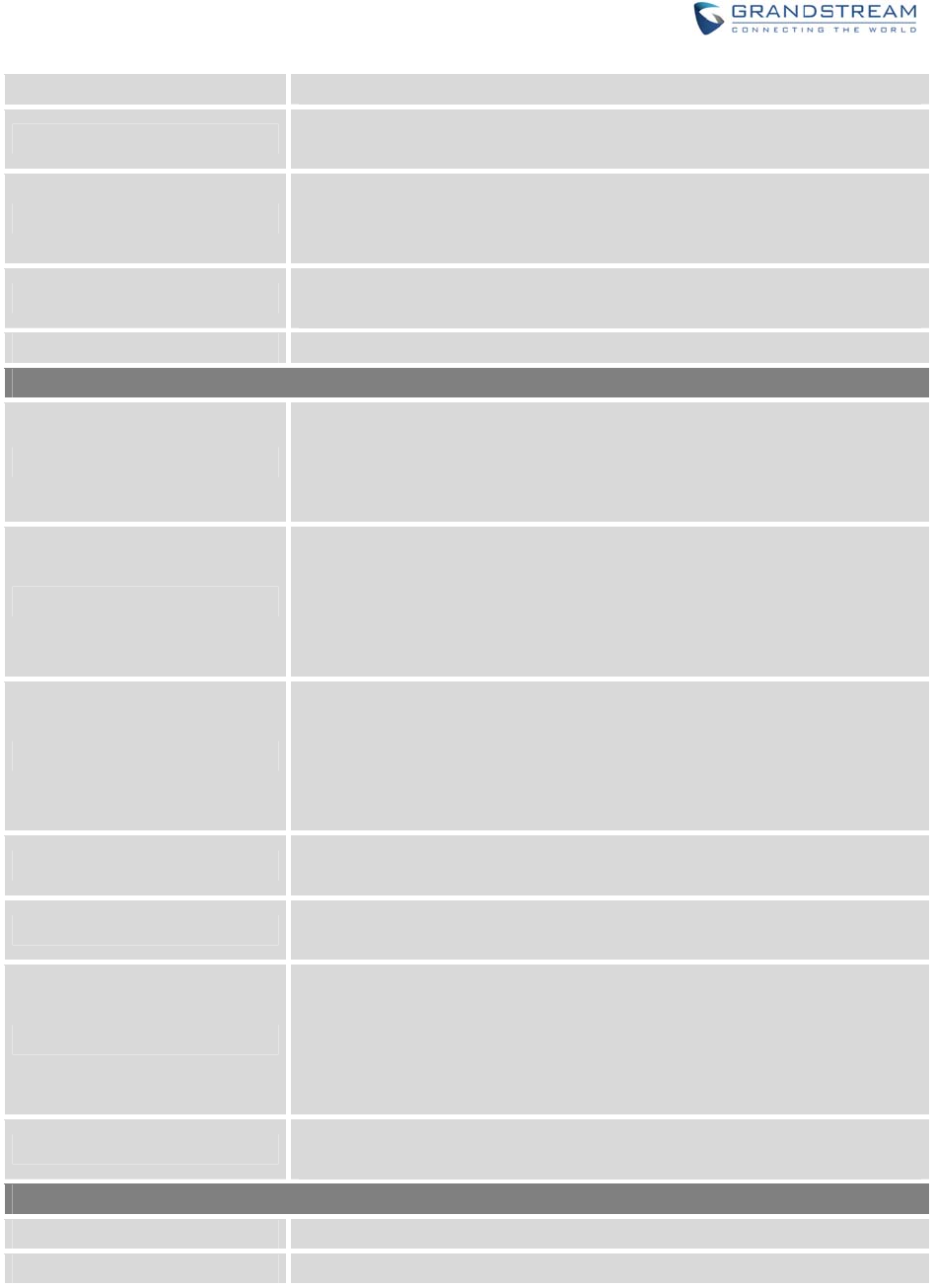
Firmware Version 1.0.0.1 UCM6200 Series IP PBX User Manual Page 135 of 320
option is disabled.
Music On Hold Select which Music On Hold class to suggest to extensions when putting
them on hold.
Enable LDAP
If enabled, the batch added extensions will be added to LDAP Phonebook
PBX list; if disabled, the batch added extensions will be skipped when
creating LDAP Phonebook.
Enable WebRTC Support If enabled, extensions will be able to login to user portal and use Web
RTC features.
Call Duration Limit Configure the maximum duration of call-blocking.
SIP Settings
NAT
Use NAT when the PBX is on a public IP communicating with devices
hidden behind NAT (e.g., broadband router). If there is one-way audio
issue, usually it's related to NAT configuration or Firewall's support of SIP
and RTP ports. The default setting is enabled.
Can Direct Media
By default, the PBX will route the media steams from SIP endpoints
through itself. If enabled, the PBX will attempt to negotiate with the
endpoints to route the media stream directly. It is not always possible for
the PBX to negotiate endpoint-to-endpoint media routing. The default
setting is "No".
DTMF Mode
Select DTMF mode for the user to send DTMF. The default setting is
"RFC2833". If "Info" is selected, SIP INFO message will be used. If
"Inband" is selected, 64-kbit codec PCMU and PCMA are required. When
"Auto" is selected, RFC2833 will be used if offered, otherwise "Inband"
will be used.
Enable Keep-alive If enabled, empty SDP packet will be sent to the SIP server periodically to
keep the NAT port open. The default setting is "Yes".
Keep-alive Frequency Configure the number of seconds for the host to be up for Keep-alive. The
default setting is 60 seconds.
TEL URI
If the end device/phone has an assigned PSTN telephone number, this
field should be set to "User=Phone". Then a "User=Phone" parameter will
be attached to the Request-Line and TO header in the SIP request to
indicate the E.164 number. If set to "Enable", "Tel:" will be used instead of
"SIP:" in the SIP request. The default setting is disabled.
Concurrent Registrations The maximum endpoints which can be registered into this extension. For
security concerns, the default value is 1.
Other Settings
SRTP Enable SRTP for the call. The default setting is "No".
Fax Mode Select Fax mode for this user. The default setting is “None”.

Firmware Version 1.0.0.1 UCM6200 Series IP PBX User Manual Page 136 of 320
None: Disable Fax.
Fax Detect: Fax signal from the user/trunk during the call can be
detected and the received Fax will be sent to the Email address
configured for this extension. If no Email address can be found for the
user, the Fax will be sent to the default Email address configured in
Fax setting page under web UI->PBX->Internal Options->Fax/T.38.
Strategy
This option controls how the extension can be used on devices within
different types of network.
Allow All
Device in any network can register this extension.
Local Subnet Only
Only the user in specific subnet can register this extension. Up to
three subnet addresses can be specified.
A Specific IP Address.
Only the device on the specific IP address can register this extension.
The default setting is "Allow All".
Enable T.38 UDPTL Enable or disable T.38 UDPTL Support.
Skip Trunk Auth
If enable “All”, users do not need to enter password when making an
outbound call. If enable “Follow Me”, the user can dial out via follow me
without password.
Codec Preference
Select audio and video codec for the extension. The available codecs are:
PCMU, PCMA, GSM, AAL2-G.726-32, G.722, G.729, G.723, Ilbc, ADPCM,
LPC10, H.264, H.263, H.263p and VP8.
BATCHADDIAXEXTENSIONS
Under Web GUI->PBX->Basic/Call Routes->Extensions, click on “Batch Add Extensions”->”Batch Add
IAX Extensions”.
Table 46: Batch Add IAX Extension Parameters
General
Start Extension Configure the starting extension number of the batch of extensions to be
added.
Create Number Specify the number of extensions to be added. The default setting is 5.
Permission
Assign permission level to the user. The available permissions are
“Internal”, “Local”, “National” and “International” from the lowest level to
the highest level. The default setting is “Internal”.
Note:
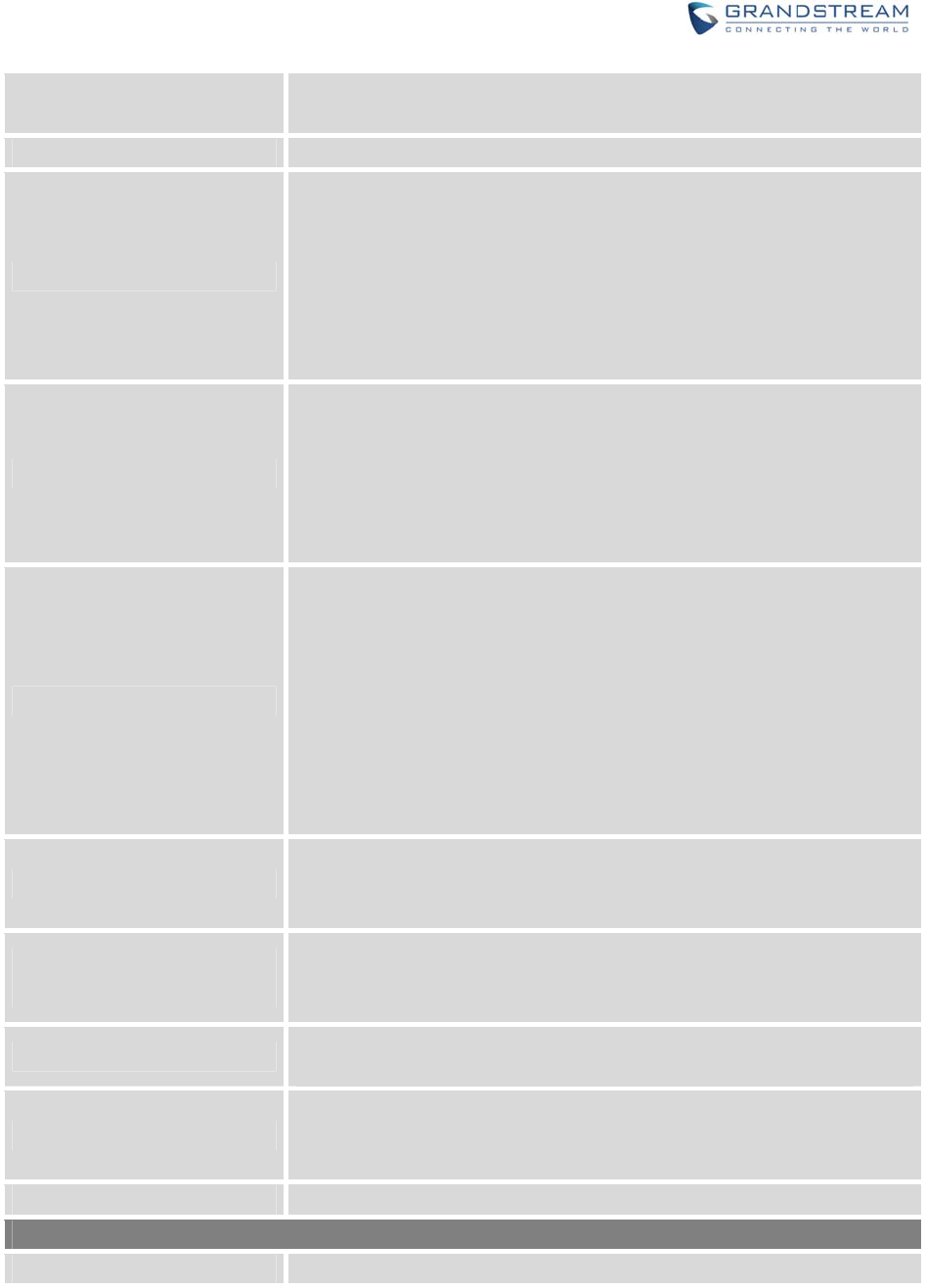
Firmware Version 1.0.0.1 UCM6200 Series IP PBX User Manual Page 137 of 320
Users need to have the same level as or higher level than an outbound
rule’s privilege in order to make outbound calls from this rule.
Enable Voicemail Enable Voicemail for the user. The default setting is “Yes”.
SIP/IAX Password
Configure the SIP/IAX password for the users. Three options are
available to create password for the batch of extensions.
User Random Password.
A random secure password will be automatically generated. It is
recommended to use this password for security purpose.
Use Extension as Password.
Enter a password to be used on all the extensions in the batch.
Voicemail Password
Configure Voicemail password (digits only) for the users.
User Random Password.
A random password in digits will be automatically generated. It is
recommended to use this password for security purpose.
Use Extension as Password.
Enter a password to be used on all the extensions in the batch.
Ring Timeout
Configure the number of seconds to ring the user before the call is
forwarded to voicemail (voicemail is enabled) or hang up (voicemail is
disabled). If not specified, the default ring timeout is 60 seconds on the
UCM6200, which can be configured in the global ring timeout setting
under web GUI->Internal Options->IVR Prompt: General Preference.
The valid range is between 5 seconds and 600 seconds.
Note:
If the end point also has a ring timeout configured, the actual ring timeout
used is the shortest time set by either device.
Auto Record
Enable automatic recording for the calls using this extension. The default
setting is disabled. The recording files can be accessed under web
GUI->CDR->Recording Files.
Skip Voicemail Password
Verification
When user dials voicemail code, the password verification IVR is skipped.
If enabled, this would allow one-button voicemail access. By default this
option is disabled.
Music On Hold Select which Music On Hold class to suggest to extensions when putting
them on hold.
Enable LDAP
If enabled, the batch added extensions will be added to LDAP Phonebook
PBX list; if disabled, the batch added extensions will be skipped when
creating LDAP Phonebook.
Call Duration Limit Configure the maximum duration of call-blocking.
IAX Settings
Max Number of Calls Configure the maximum number of calls allowed for each remote IP
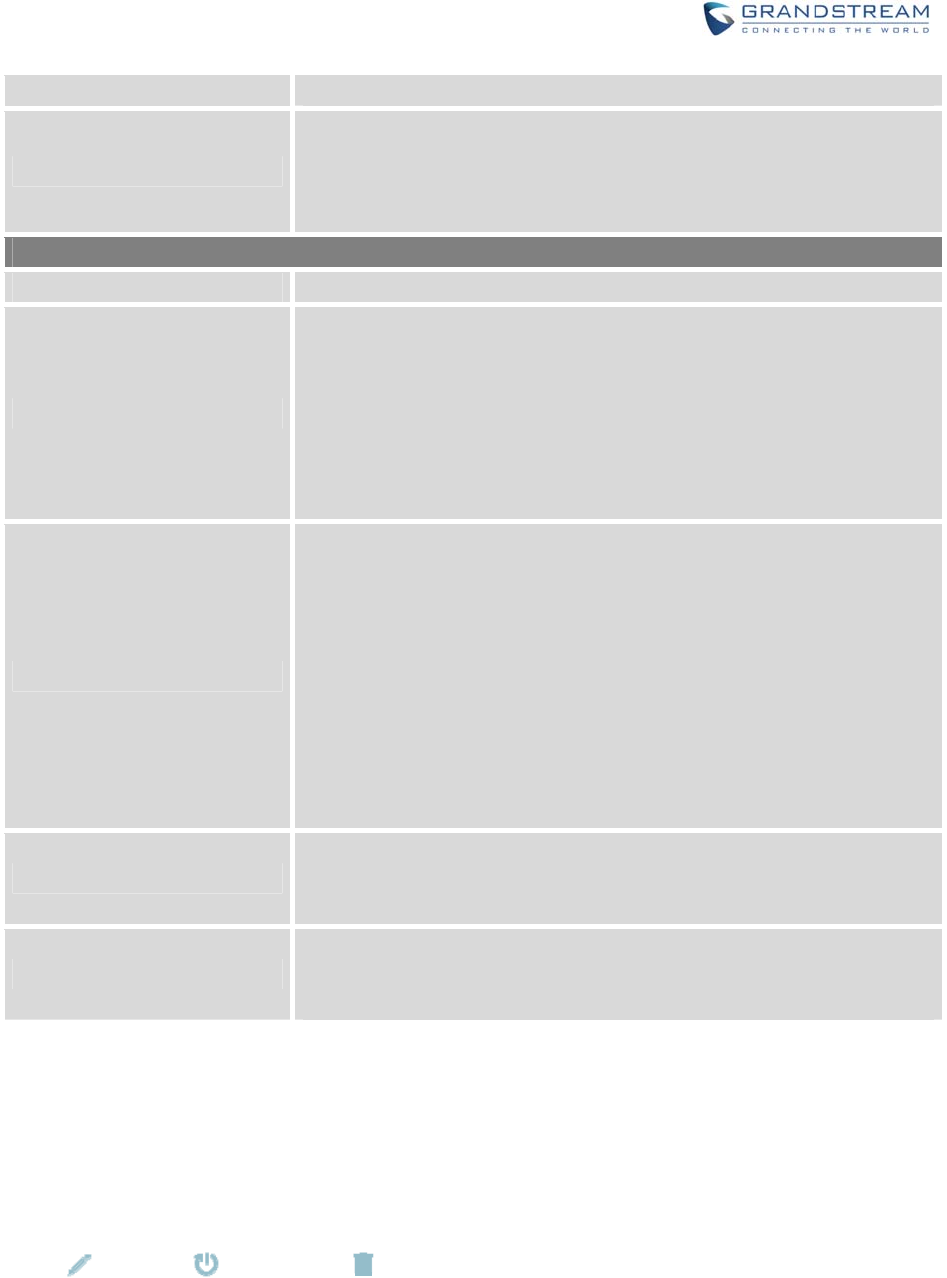
Firmware Version 1.0.0.1 UCM6200 Series IP PBX User Manual Page 138 of 320
address.
Require Call Token
Configure to enable/disable requiring call token. If set to "Auto", it might
lock out users who depend on backward compatibility when peer
authentication credentials are shared between physical endpoints. The
default setting is "Yes".
Other Settings
SRTP Enable SRTP for the call. The default setting is "No".
Fax Mode
Select Fax Mode for this user. The default setting is “None”.
None: Disable Fax.
Fax Detect: Fax signal from the user/trunk during the call can be
detected and the received Fax will be sent to the Email address
configured for this extension. If no Email address can be found for the
user, the Fax will be sent to the default Email address configured in
Fax setting page under web UI->PBX->Internal Options->Fax/T.38.
Strategy
This option controls how the extension can be used on devices within
different types of network.
Allow All
Device in any network can register this extension.
Local Subnet Only
Only the user in specific subnet can register this extension. Up to
three subnet addresses can be specified.
A Specific IP Address.
Only the device on the specific IP address can register this extension.
The default setting is "Allow All".
Skip Trunk Auth
If enable “All”, users do not need to enter password when making an
outbound call. If enable “Follow Me”, the call can dial out via follow me
without password.
Codec Preference
Select audio and video codec for the extension. The available codecs are:
PCMU, PCMA, GSM, AAL2-G.726-32, G.722, G.729, G.723, iLBC,
ADPCM, LPC10, H.264, H.263, H.263p and VP8.
SEARCHANDEDITEXTENSION
All the UCM6200 extensions are listed under Web GUI->PBX->Basic/Call Routes->Extensions, with
status, Extension, CallerID Name, Technology (SIP, IAX and FXS), IP and Port. Each extension has a
checkbox for users to "Modify Selected Extensions" or "Delete Selected Extensions". Also, options
"Edit” , "Reboot" and "Delete" are available per extension. User can search an extension by
specifying the extension number to find an extension quickly.
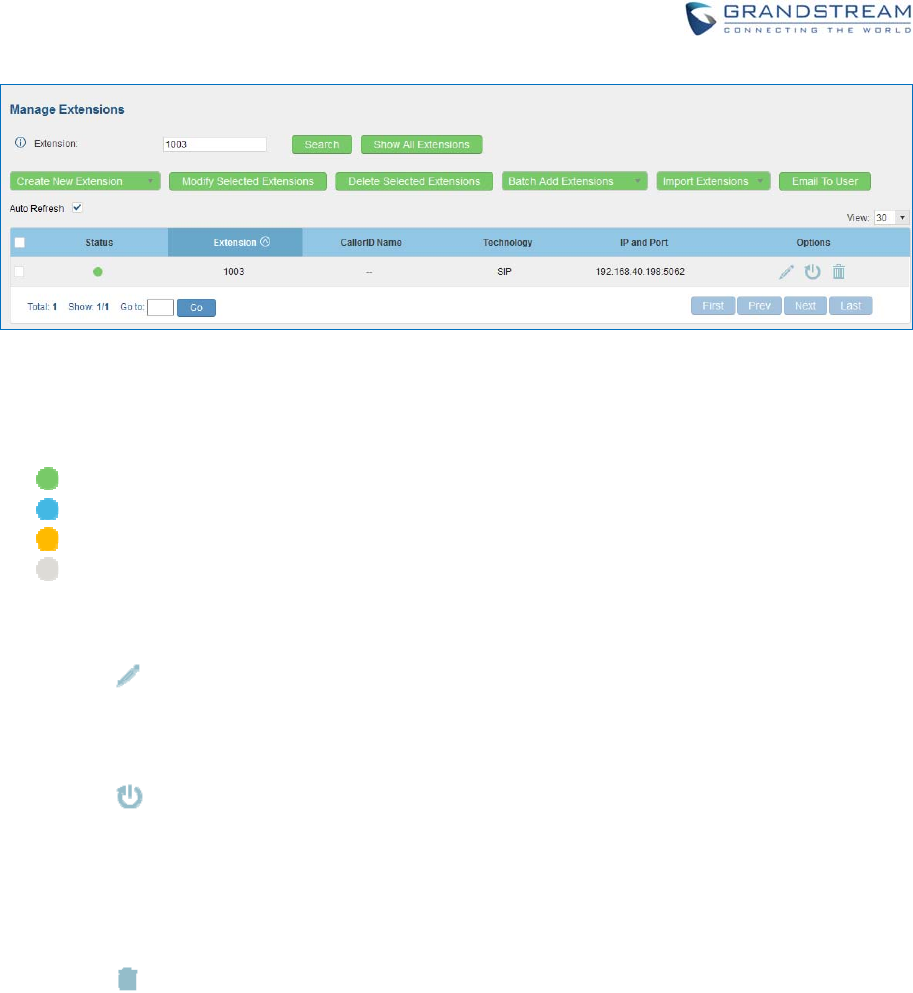
Firmware Version 1.0.0.1 UCM6200 Series IP PBX User Manual Page 139 of 320
Figure 84: Manage Extensions
Status
Users can see the following icon for each extension to indicate the SIP status.
Green: Free
Blue: Ringing
Yellow: In Use
Grey: Unavailable (the extension is not registered or disabled on the PBX)
Edit single extension
Click on to start editing the extension parameters.
Reboot the user
Click on to send NOTIFY reboot event to the device which has an UCM6200 extension already
registered. To successfully reboot the user, "Zero Config" needs to be enabled on the UCM6200 web
GUI->PBX->Zero Config->Auto Provisioning Settings.
Delete single extension
Click on to delete the extension. Or select the checkbox of the extension and then click on "Delete
Selected Extensions".
Modify selected extensions
Select the checkbox for the extension(s). Then click on "Modify Selected Extensions" to edit the
extensions in a batch.
Delete selected extensions
Select the checkbox for the extension(s). Then click on "Delete Selected Extensions" to delete the
extension(s).
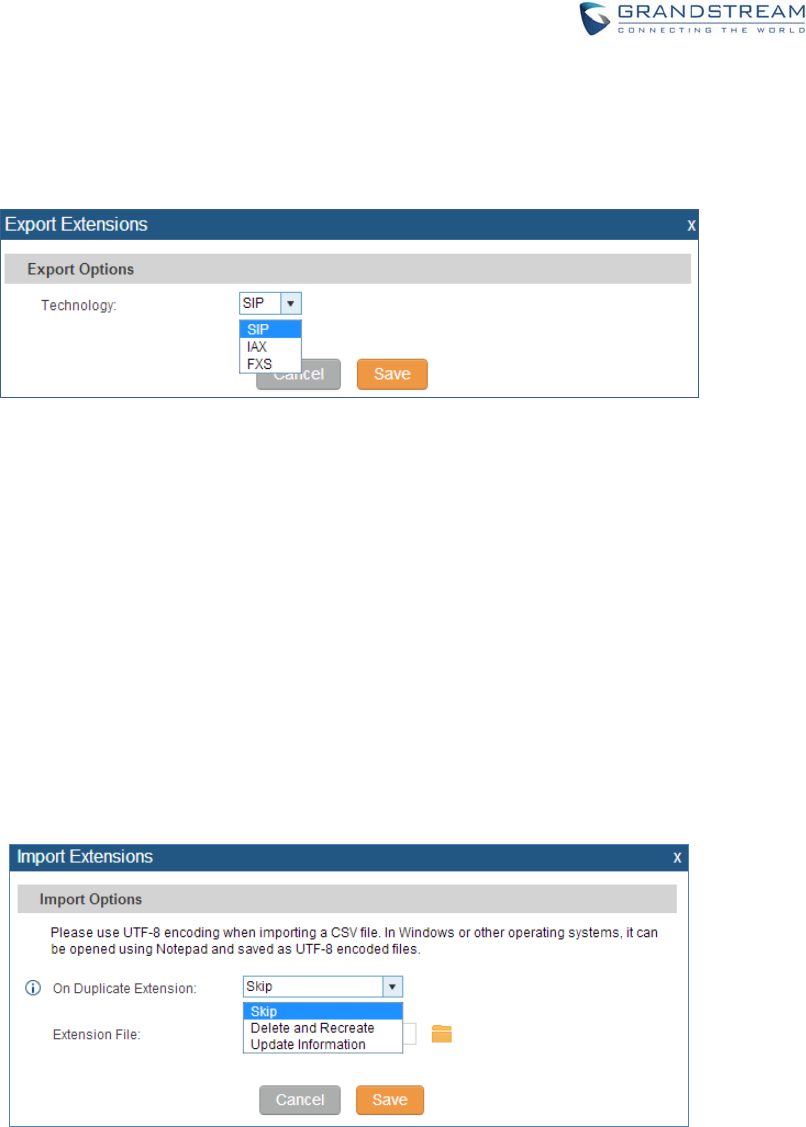
Firmware Version 1.0.0.1 UCM6200 Series IP PBX User Manual Page 140 of 320
EXPORTEXTENSIONS
The extensions configured on the UCM6200 can be exported to csv format file with selected technology
"SIP", "IAX" or "FXS". Click on "Export Extensions" button and select technology in the prompt below.
Figure 85: Export Extensions
The exported csv file can be serve as a template for users to fill in desired extension information to be
imported to the UCM6200.
IMPORTEXTENSIONS
The capability to import extensions to the UCM6200 provides users flexibility to batch add extensions with
similar or different configuration quickly into the PBX system.
1. Export extension csv file from the UCM6200 by clicking on "Export Extensions" button.
2. Fill up the extension information you would like in the exported csv template.
3. Click on "Import Extensions" button. The following dialog will be prompted.
Figure 86: Import Extensions
4. Select the option in "On Duplicate Extension" to define how the duplicate extension(s) in the imported
csv file should be treated by the PBX.
Skip: Duplicate extensions in the csv file will be skipped. The PBX will keep the current extension
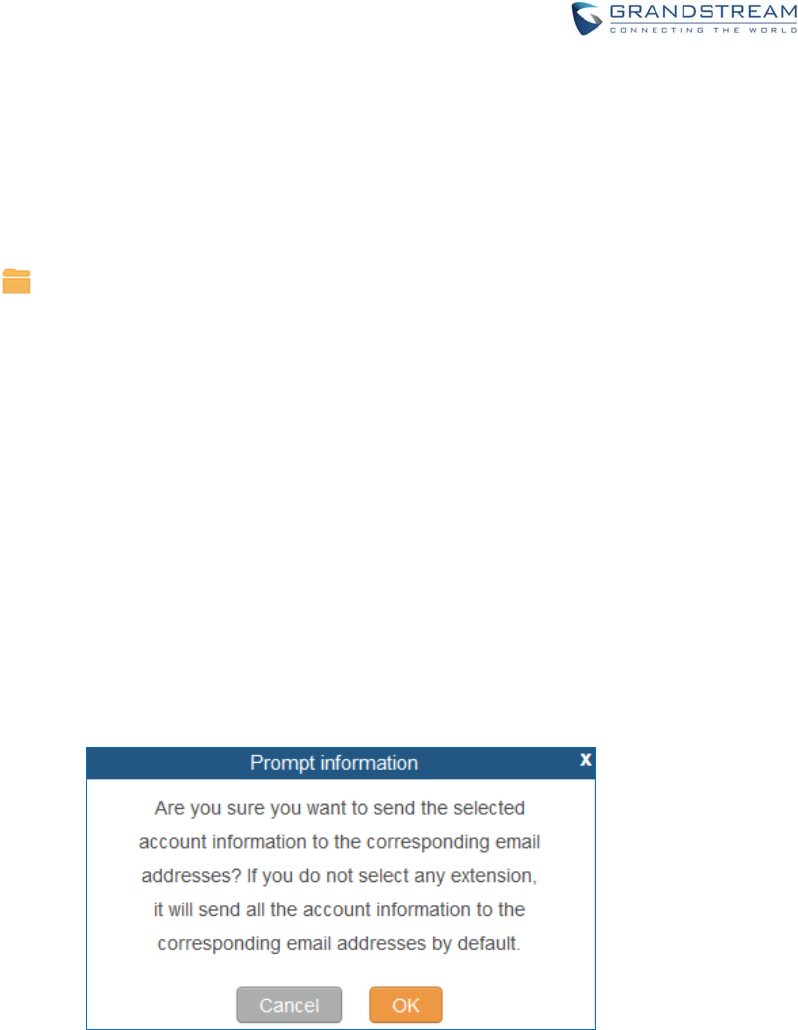
Firmware Version 1.0.0.1 UCM6200 Series IP PBX User Manual Page 141 of 320
information as previously configured without change.
Delete and Recreate: The current extension previously configured will be deleted and the
duplicate extension in the csv file will be loaded to the PBX.
Update Information: The current extension previously configured in the PBX will be kept. However,
if the duplicate extension in the csv file has different configuration for any options, it will override
the configuration for those options in the extension.
5. Click on to select csv file from local directory in the PC.
6. Click on "Save" to import the csv file.
7. Click on "Apply Changes" to apply the imported file on the UCM6200.
EMAILTOUSER
Once the extensions are created with Email address, the PBX administrator can click on button “Email To
User” to send the account registration and configuration information to the user. Please make sure Email
setting under web UI->Settings->Email Settings is properly configured and tested on the UCM6200
before using “Email To User”.
When click on “Email To User” button, the following message will be prompted in the web page. Click on
OK to confirm sending the account information to all users’ Email addresses.
Figure 87: Email To User - Prompt Information
The user will receive Email including account registration information and LDAP configuration. A QR code
is also generated for Mobile applications to scan it and get automatically provisioned. QR code
provisioning is supported on Grandstream Softphone GS Wave AndroidTM application and iOS application.
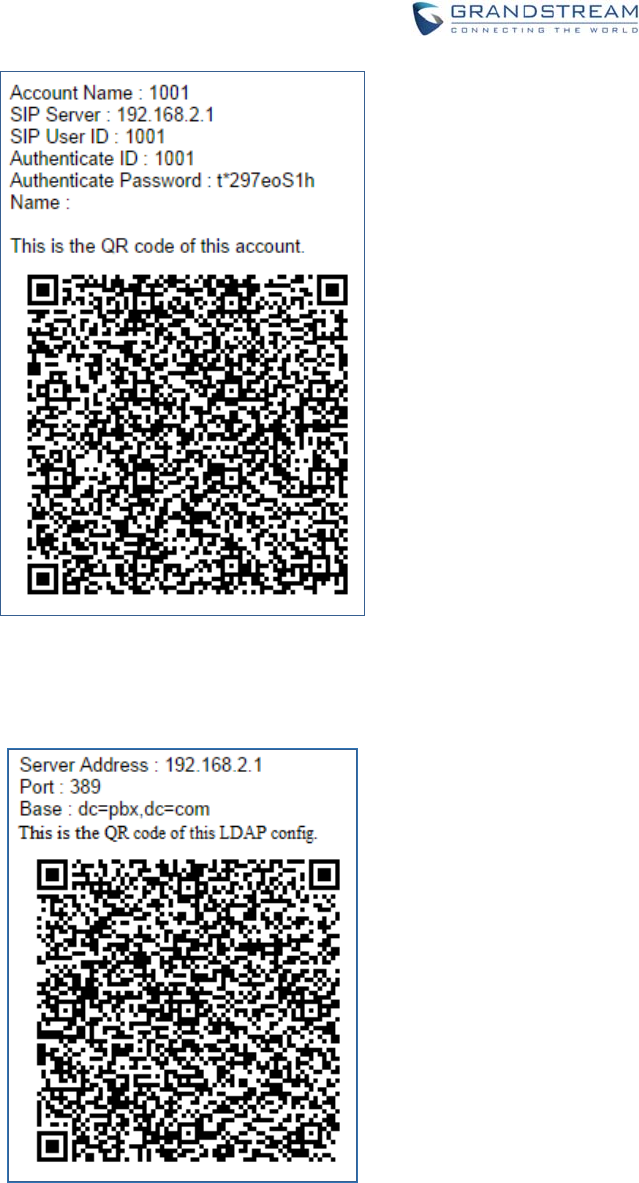
Firmware Version 1.0.0.1 UCM6200 Series IP PBX User Manual Page 142 of 320
Figure 88: Account Registration Information and QR Code
Figure 89: LDAP Client Information and QR Code
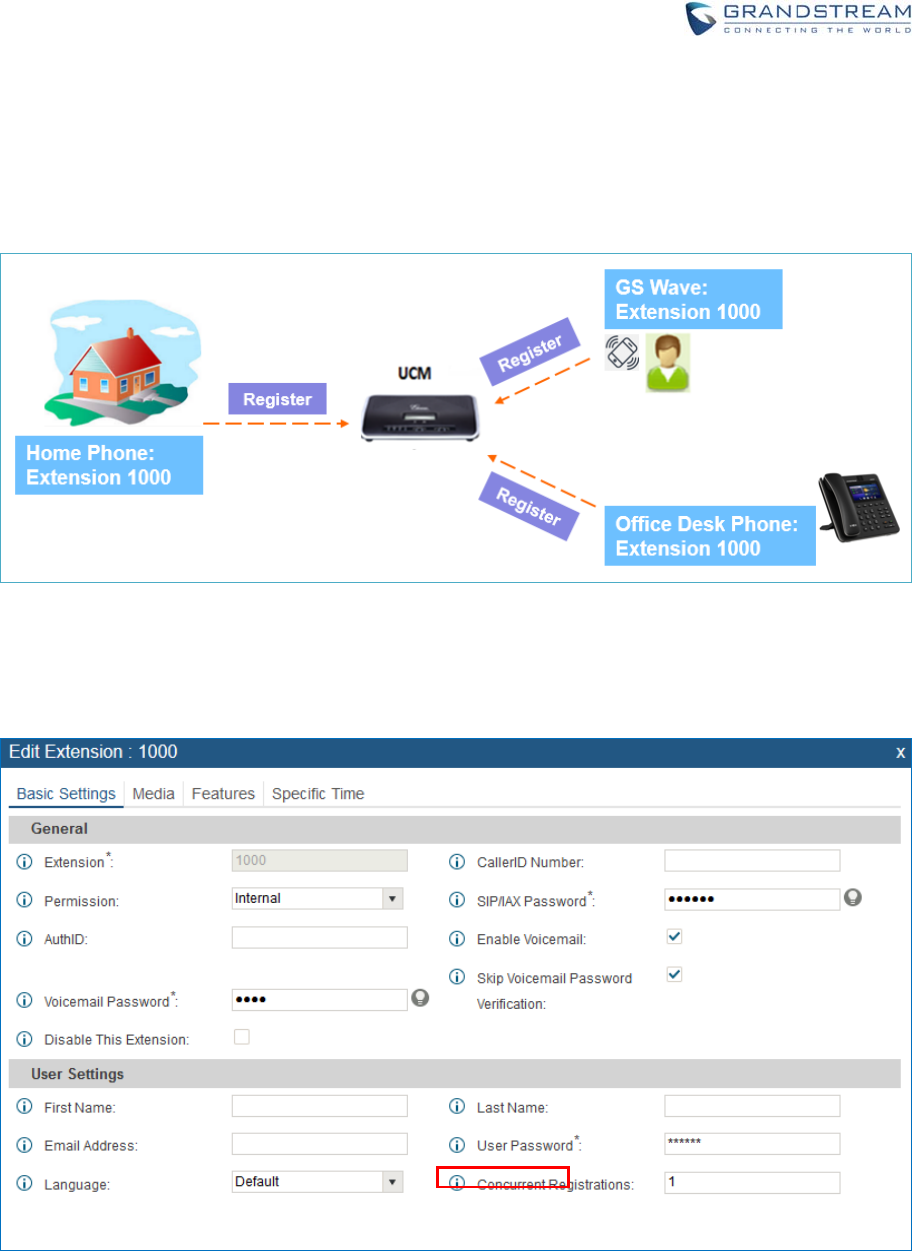
Firmware Version 1.0.0.1 UCM6200 Series IP PBX User Manual Page 143 of 320
MULTIPLEREGISTRATIONSPEREXTENSION
UCM6200 supports multiple registrations per extension so that users can use the same extension on
devices in different locations.
Figure 90: Multiple Registrations per Extension
This feature can be enabled by configuring option “Concurrent Registrations” under web
UI->PBX->Basic/Call Routes->Edit Extension. The default value is set to 1 for security purpose.
Figure 91: Extension - Concurrent Registration
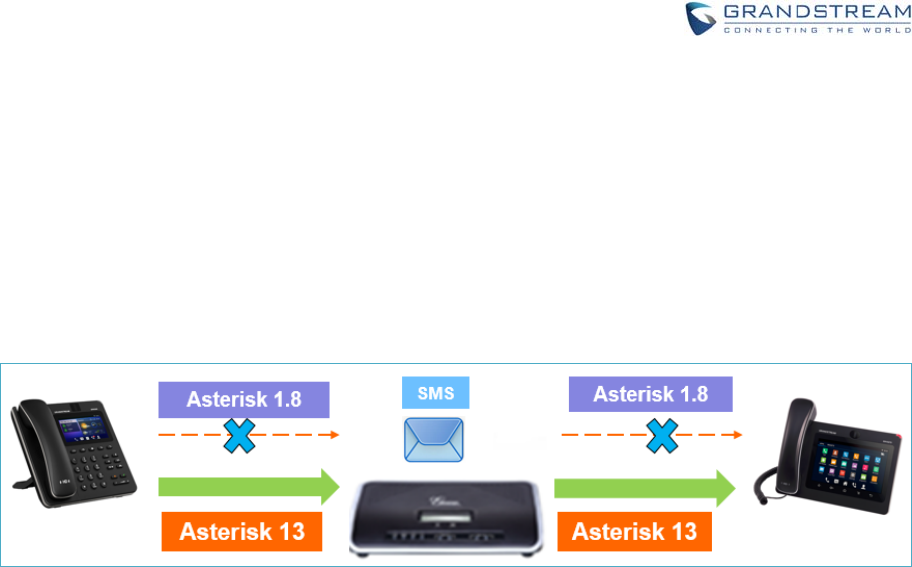
Firmware Version 1.0.0.1 UCM6200 Series IP PBX User Manual Page 144 of 320
SMSMESSAGESUPPORT
The UCM6200 provides built-in SIP SMS message support. For SIP end devices such as Grandstream GXP or
GXV phones that supports SIP message, after an UCM6200 account is registered on the end device, the user
can send and receive SMS message. Please refer to the end device documentation on how to send and receive
SMS message.
SMS Message support is a new feature added since firmware 1.0.10.x.
Figure 92: SMS Message Support

Firmware Version 1.0.0.1 UCM6200 Series IP PBX User Manual Page 145 of 320
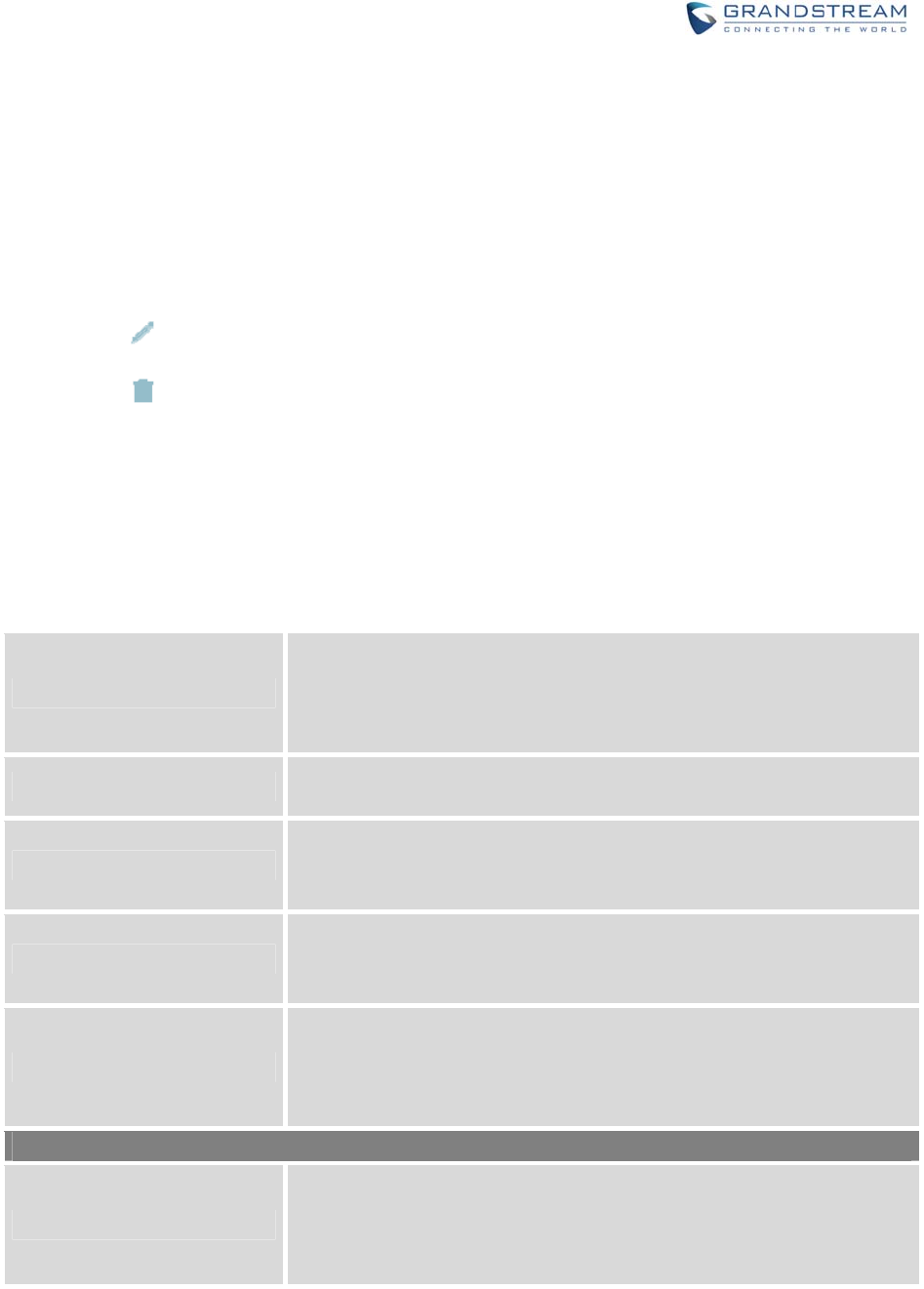
Firmware Version 1.0.0.1 UCM6200 Series IP PBX User Manual Page 146 of 320
TRUNKS
ANALOGTRUNKS
Go to Web GUI->PBX->Basic/Call Routes->Analog Trunks to add and edit analog trunks.
Click on "Create New Analog Trunk" to add a new analog trunk.
Click on to edit the analog trunk.
Click on to delete the analog trunk.
ANALOGTRUNKCONFIGURATION
The analog trunk options are listed in the table below.
Table 47: Analog Trunk Configuration Parameters
Channels
Select the channel for the analog trunk.
UCM6202: 2 channels
UCM6204: 4 channels
UCM6208: 8 channels
Trunk Name Specify a unique label to identify the trunk when listed in outbound rules,
incoming rules and etc.
SLA Mode
Enable this option to satisfy two primary use cases, which include
emulating a simple key system and creating shared extensions on a PBX.
Enable SLA Mode will disable polarity reversal.
Barge Allowed
The barge option specifies whether or not other stations are allowed to
join a call in progress on this trunk. If enabled, the other stations can
press the line button to join the call. The default setting is Yes.
Hold Access
The hold option specifies hold permissions for this trunk. If set to “Open”,
any station can place this trunk on hold and any other station is allowed to
retrieve the call. If set to “Private”, only the station that places the call on
hold can retrieve the call. The default setting is Yes.
Advanced Options
Enable Polarity Reversal
If enabled, a polarity reversal will be marked as received when an
outgoing call is answered by the remote party. For some countries, a
polarity reversal is used for signaling the disconnection of a phone line
and the call will be considered as “hangup” on a polarity reversal. The
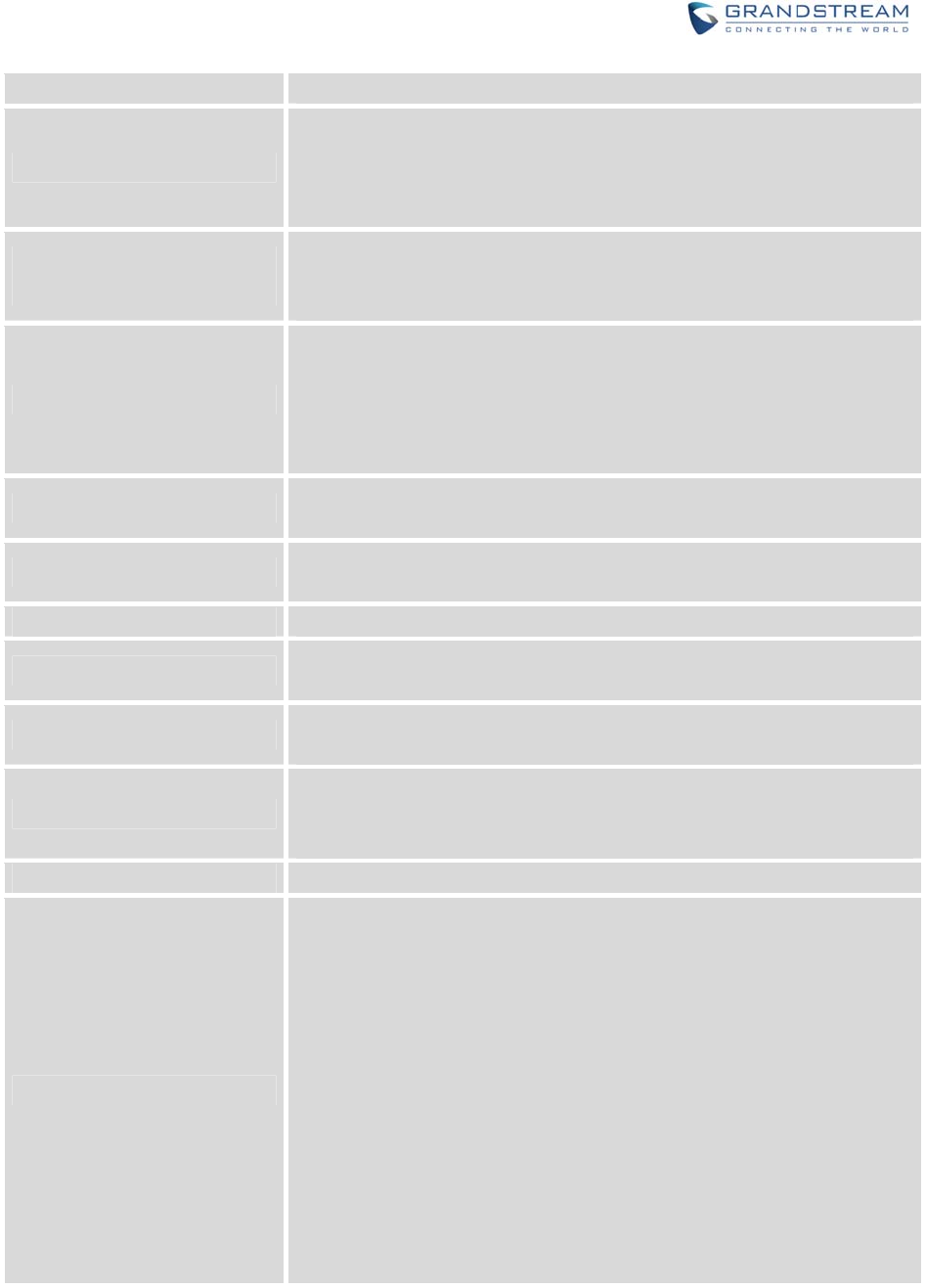
Firmware Version 1.0.0.1 UCM6200 Series IP PBX User Manual Page 147 of 320
default setting is “No”.
Polarity on Answer Delay
When FXO port answers the call, FXS may send a Polarity Reversal. If
this interval is shorter than the value of “Polarity on Answer Delay”, the
Polarity Reversal will be ignored. Otherwise, the FXO will onhook to
disconnect the call. The default setting is 600ms.
Current Disconnect
Threshold (ms)
This is the periodic time (in ms) that the UCM6200 will use to check on a
voltage drop in the line. The default setting is 200. The valid range is 50 to
3000.
Ring Timeout
Configure the ring timeout (in ms). Trunk (FXO) devices must have a
timeout to determine if there was a hangup before the line is answered.
This value can be used to configure how long it takes before the
UCM6200 considers a non-ringing line with hangup activity. The default
setting is 8000.
RX Gain Configure the RX gain for the receiving channel of analog FXO port. The
valid range is from -13.5 (dB) to + 12.0 (dB). The default setting is 0.
TX Gain Configure the TX gain for the transmitting channel of analog FXO port.
The valid range is from -13.5 (dB) to + 12.0 (dB). The default setting is 0.
Use CallerID Configure to enable CallerID detection. The default setting is “Yes”.
Caller ID Scheme Select the Caller ID scheme for this trunk. The default setting is
“Bellcore/Telcordia”.
FXO Dial Delay(ms) Configure the time interval between off-hook and first dialed digit for
outbound calls.
Auto Record
Enable automatic recording for the calls using this trunk. The default
setting is disabled. The recording files can be accessed under web
GUI->CDR->Recording Files.
Disable This Trunk If selected, the trunk will be disabled.
DAHDI Out Line Selection
This is to implement analog trunk outbound line selection strategy. Three
options are available:
Ascend
When the call goes out from this analog trunk, it will always try to use
the first idle FXO port. The port order that the call will use to go out
would be port 1->port 2->port 10->port 16. Every time it will start with
port 1 (if it's idle).
Poll
When the call goes out from this analog trunk, it will use the port that
is not used last time. And it will always use the port in the order of port
1->2->10->16->1->2->10->16->1->2->10->16..., following the last
port being used.
Descend
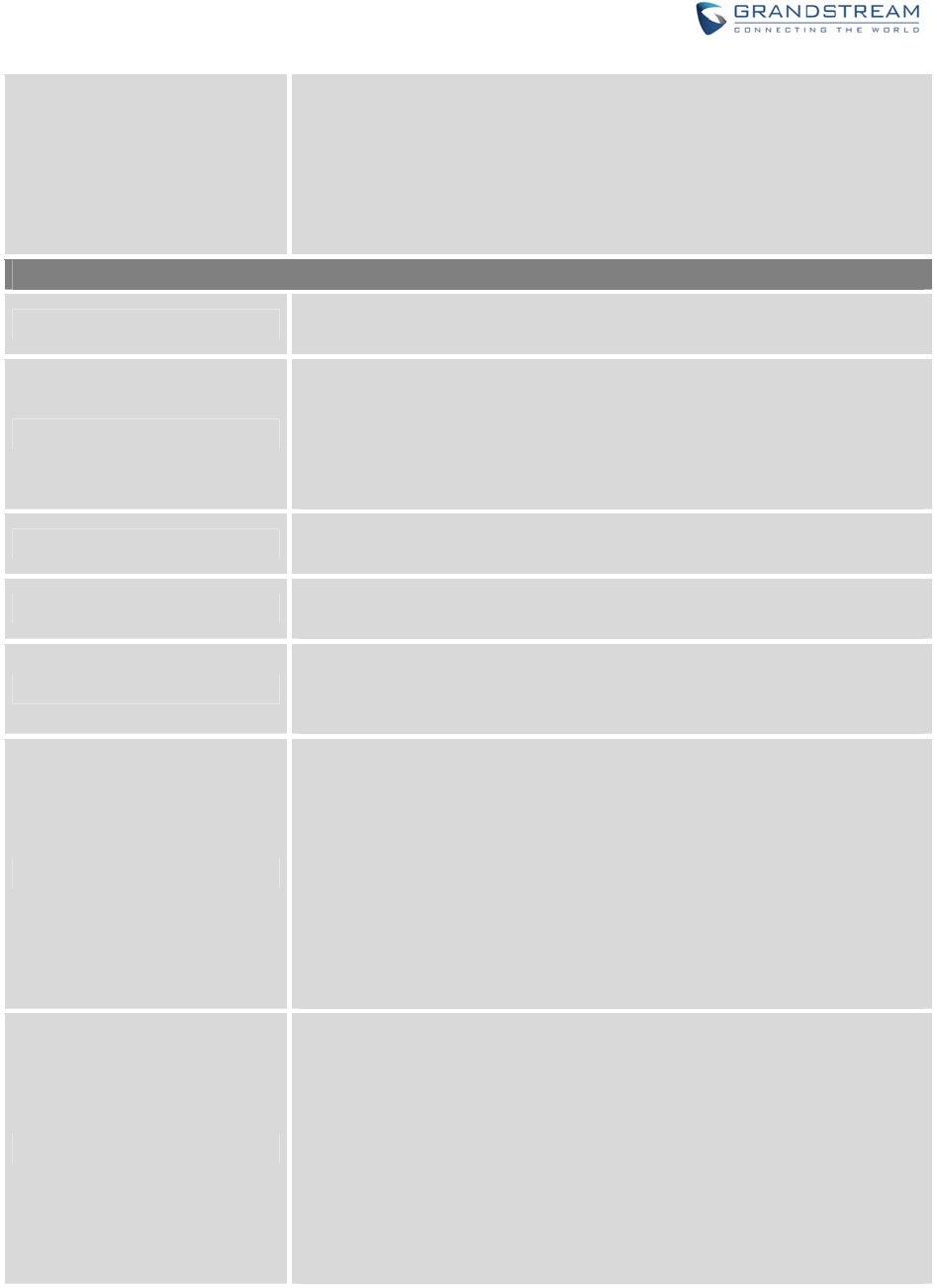
Firmware Version 1.0.0.1 UCM6200 Series IP PBX User Manual Page 148 of 320
When the call goes out from this analog trunk, it will always try to use
the last idle FXO port. The port order that the call will use to go out
would be port 16->port 10->port 2->port 1. Every time it will start with
port 16 (if it's idle).
The default setting is “Ascend” mode.
Tone Settings
Busy Detection Busy Detection is used to detect far end hangup or for detecting busy
signal. The default setting is "Yes".
Busy Tone Count
If "Busy Detection" is enabled, users can specify the number of busy
tones to be played before hanging up. The default setting is 2. Better
results might be achieved if set to 4, 6 or even 8. Please note that the
higher the number is, the more time is needed to hangup the channel.
However, this might lower the probability to get random hangup.
Congestion Detection Congestion detection is used to detect far end congestion signal. The
default setting is "Yes".
Congestion Count If "Congestion Detection" is enabled, users can specify the number of
congestion tones to wait for. The default setting is 2.
Tone Country
Select the country for tone settings. If "Custom" is selected, users could
manually configure the values for Busy Tone and Congestion Tone. The
default setting is "United States of America (USA)".
Busy Tone
Syntax:
f1=val[@level][,f2=val[@level]],c=on1/off1[-on2/off2[-on3/off3]];
Frequencies are in Hz and cadence on and off are in ms.
Frequencies Range: [0, 4000)
Busy Level Range: (-300, 0)
Cadence Range: [0, 16383].
Select Tone Country "Custom" to manually configure Busy Tone value.
Default value:
f1=480@-50,f2=620@-50,c=500/500
Congestion Tone
Syntax:
f1=val[@level][,f2=val[@level]],c=on1/off1[-on2/off2[-on3/off3]];
Frequencies are in Hz and cadence on and off are in ms.
Frequencies Range: [0, 4000)
Busy Level Range: (-300, 0)
Cadence Range: [0, 16383].
Select Tone Country "Custom" to manually configure Busy Tone value.
Default value:
f1=480@-50,f2=620@-50,c=250/250
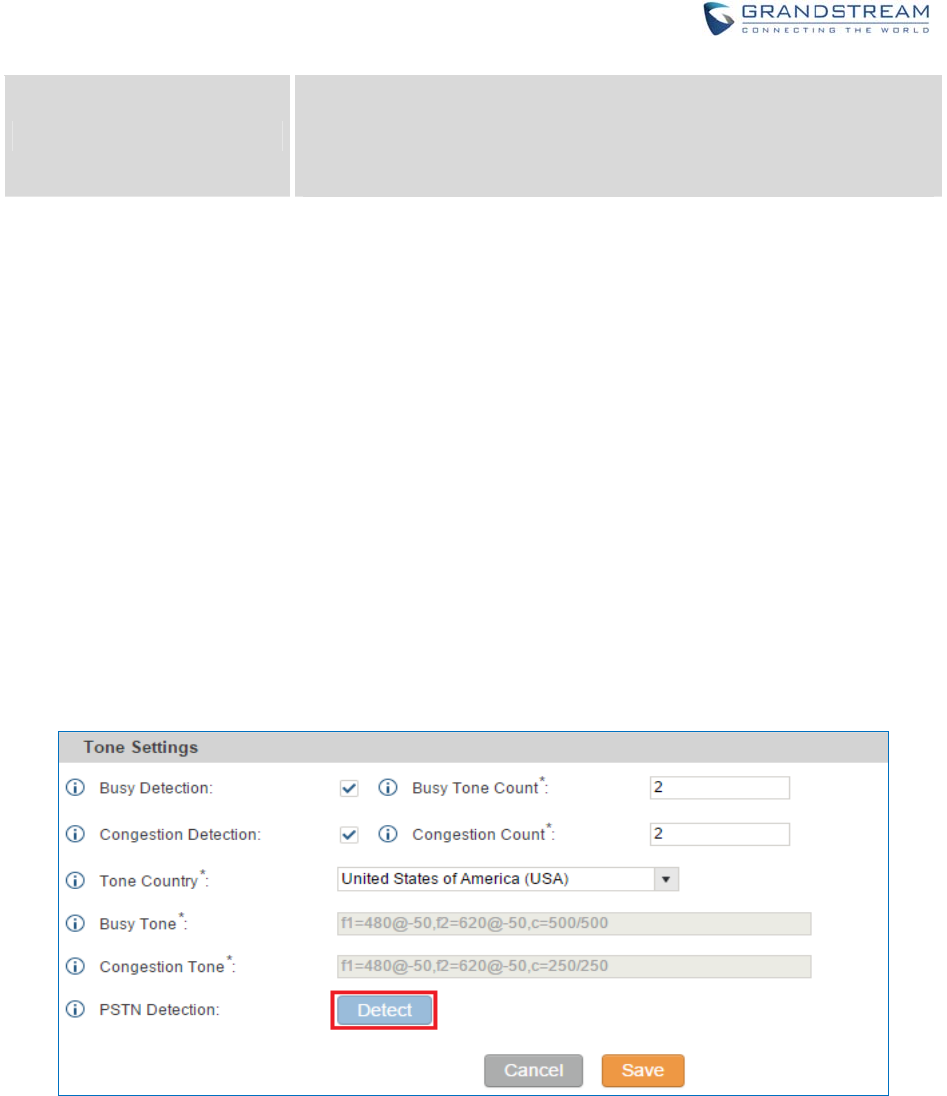
Firmware Version 1.0.0.1 UCM6200 Series IP PBX User Manual Page 149 of 320
PSTN Detection
Click on "Detect" to detect the busy tone, Polarity Reversal and Current
Disconnect by PSTN. Before the detecting, please make sure there are
more than one channel configured and working properly. If the detection
has busy tone, the "Tone Country" option will be set as "Custom".
PSTNDETECTION
The UCM6200 provides PSTN detection function to help users detect the busy tone, Polarity Reversal and
Current Disconnect by making a call from the PSTN line to another destination. The detecting call will be
answered and up for about 1 minute. Once done, the detecting result will show and can be used for the
UCM6200 settings.
1. Go to UCM6200 web GUI->PBX->Basic/Call Routes->Analog Trunks page.
2. Click to edit the analog trunk created for the FXO port.
3. In the dialog window to edit the analog trunk, go to "Tone Settings" section and there are two methods
to set the busy tone.
Tone Country. The default setting is "United States of America (USA)".
PSTN Detection.
Figure 93: UCM6200 FXO Tone Settings
4. Click on "Detect" to start PSTN detection.
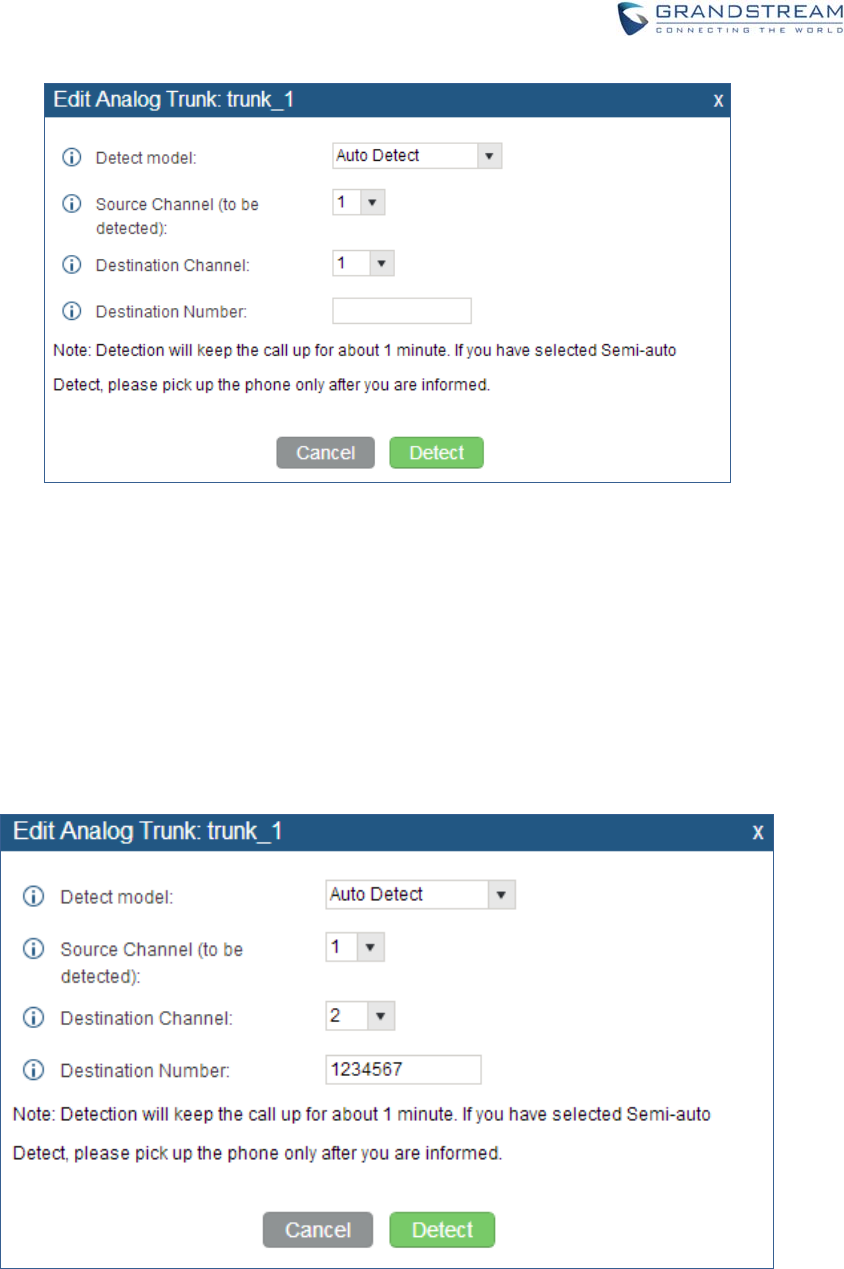
Firmware Version 1.0.0.1 UCM6200 Series IP PBX User Manual Page 150 of 320
Figure 94: UCM6200 PSTN Detection
If there are two FXO ports connected to PSTN lines, use the following settings for auto-detection.
Detect Model: Auto Detect.
Source Channel: The source channel to be detected.
Destination Channel: The channel to help detecting. For example, the second FXO port.
Destination Number: The number to be dialed for detecting. This number must be the actual
PSTN number for the FXO port used as the destination channel.
Figure 95: UCM6200 PSTN Detection: Auto Detect
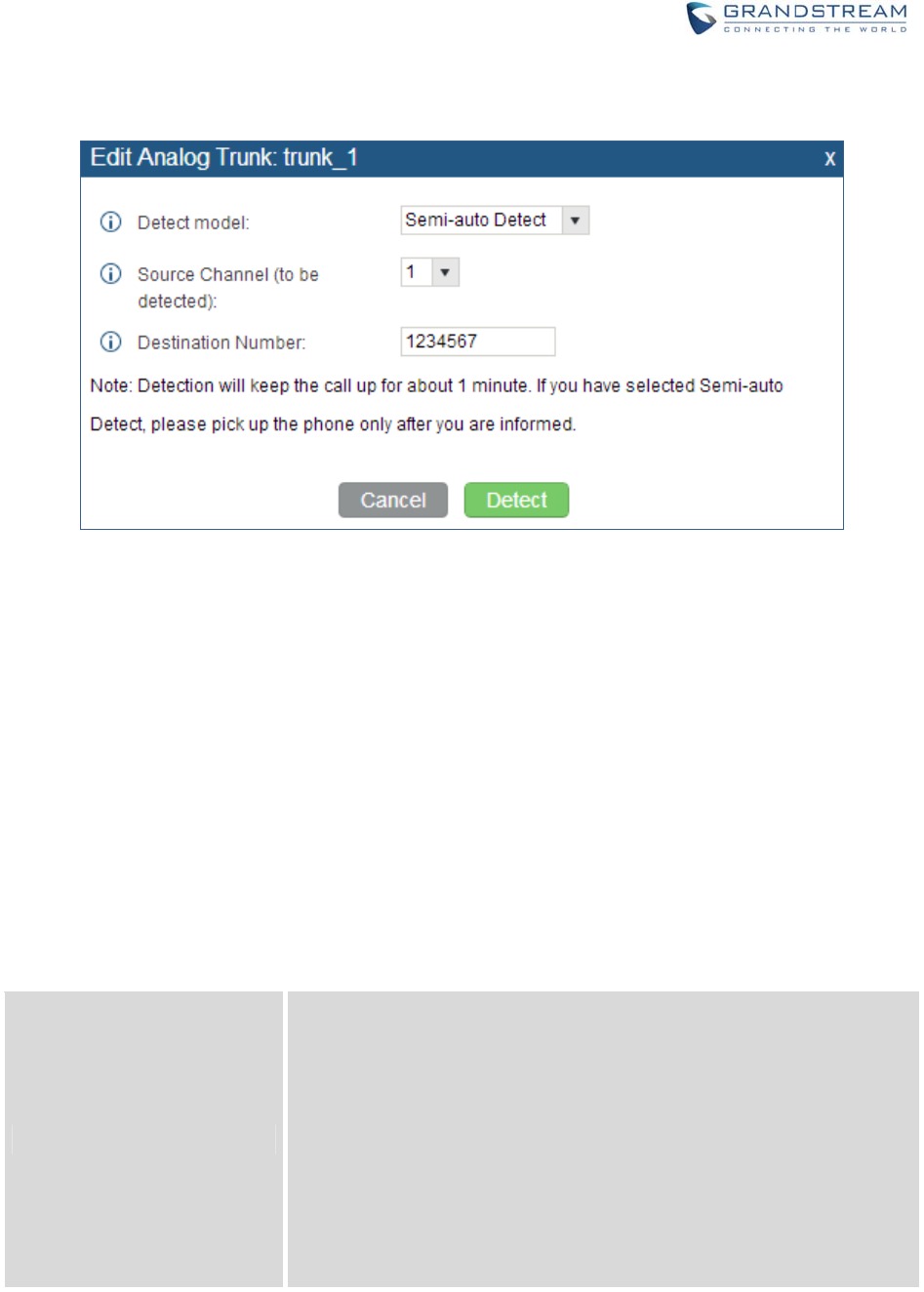
Firmware Version 1.0.0.1 UCM6200 Series IP PBX User Manual Page 151 of 320
If there is only one FXO port connected to PSTN line, use the following settings for auto-detection.
Figure 96: UCM6200 PSTN Detection: Semi-Auto Detect
Detect Model: Semi-auto Detect.
Source Channel: The source channel to be detected.
Destination Number: The number to be dialed for detecting. This number could be a cell phone
number or other PSTN number that can be reached from the source channel PSTN number.
5. Click "Detect" to start detecting. The source channel will initiate a call to the destination number. For
"Auto Detect", the call will be automatically answered. For "Semi-auto Detect", the UCM6200 web GUI
will display prompt to notify the user to answer or hang up the call to finish the detecting process.
6. Once done, the detected result will show. Users could save the detecting result as the current
UCM6200 settings.
Table 48: PSTN Detection for Analog Trunk
Detect Model
Select "Auto Detect" or "Semi-auto Detect" for PSTN detection.
Auto Detect
Please make sure two or more channels are connected to the
UCM6200 and in idle status before starting the detection. During the
detection, one channel will be used as caller (Source Channel) and
another channel will be used as callee (Destination Channel). The
UCM6200 will control the call to be established and hang up between
caller and callee to finish the detection.
Semi-auto Detect
Semi-auto detection requires answering or hanging up the call
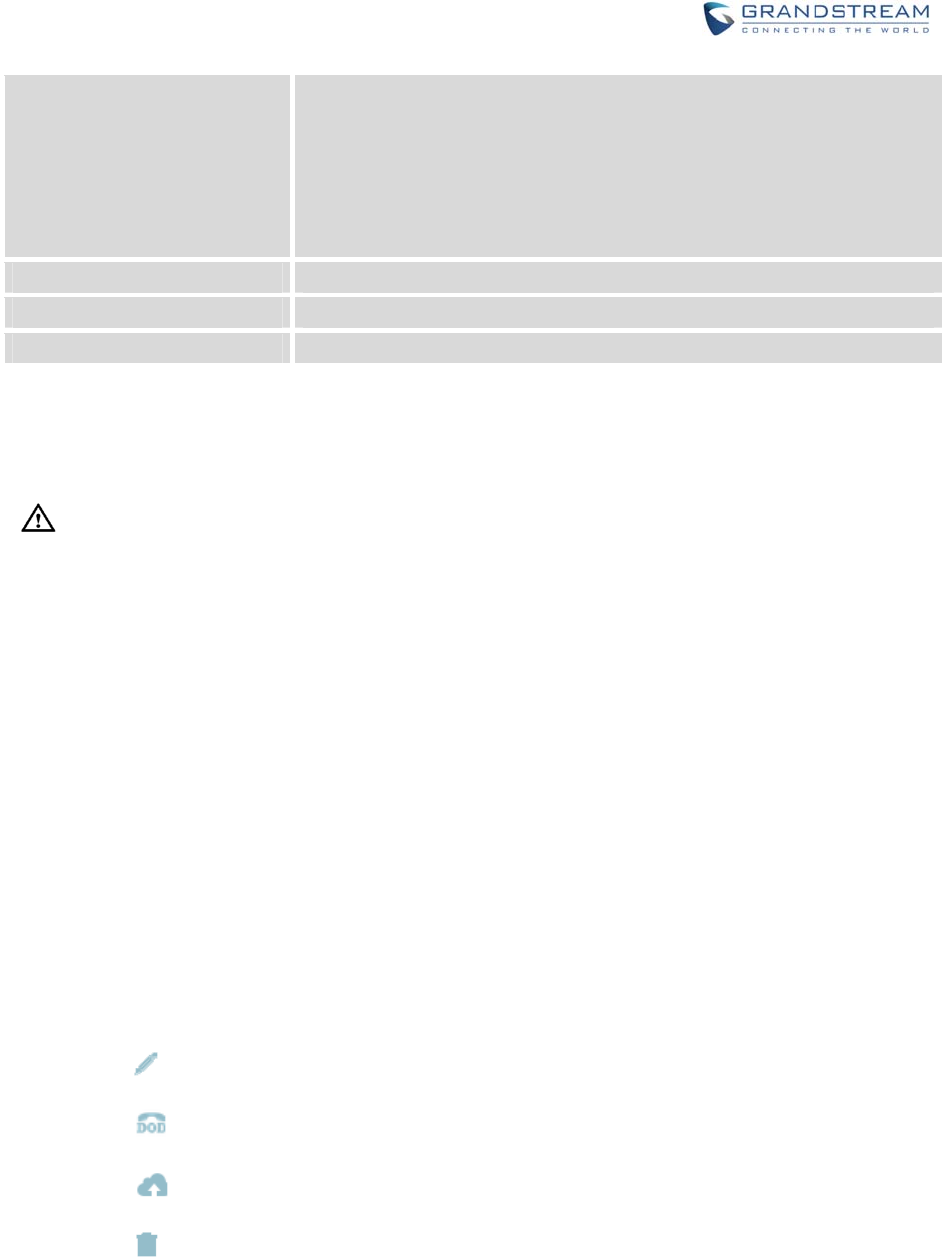
Firmware Version 1.0.0.1 UCM6200 Series IP PBX User Manual Page 152 of 320
manually. Please make sure one channel is connected to the
UCM6200 and in idle status before starting the detection. During the
detection, source channel will be used as caller and send the call to
the configured Destination Number. Users will then need follow the
prompts in web GUI to help finish the detection.
The default setting is "Auto Detect".
Source Channel Select the channel to be detected.
Destination Channel Select the channel to help detect when "Auto Detect" is used.
Destination Number Configure the number to be called to help the detection.
--------------------------------------------------------------------------------------------------------------------------------------------
Note:
The PSTN detection process will keep the call up for about 1 minute.
If "Semi-auto Detect' is used, please pick up the call only after informed from the web GUI prompt.
Once the detection is successful, the detected parameters "Busy Tone", "Polarity Reversal" and
"Current Disconnect by PSTN" will be filled into the corresponding fields in the analog trunk
configuration.
--------------------------------------------------------------------------------------------------------------------------------------------
VOIPTRUNKS
VoIP trunks can be configured in UCM6200 under Web GUI->PBX->Basic/Call Routes->VoIP Trunks.
Once created, the VoIP trunks will be listed with Provider Name, Type, Hostname/IP, Username and
Options to edit/detect the trunk.
Click on "Create New SIP Trunk" or "Create New IAX Trunk" to add a new VoIP trunk.
Click on to configure detailed parameters for the VoIP trunk.
Click on to configure Direct Outward Dialing (DOD) for the SIP Trunk.
Click on to start LDAP Sync.
Click on to delete the VoIP trunk.
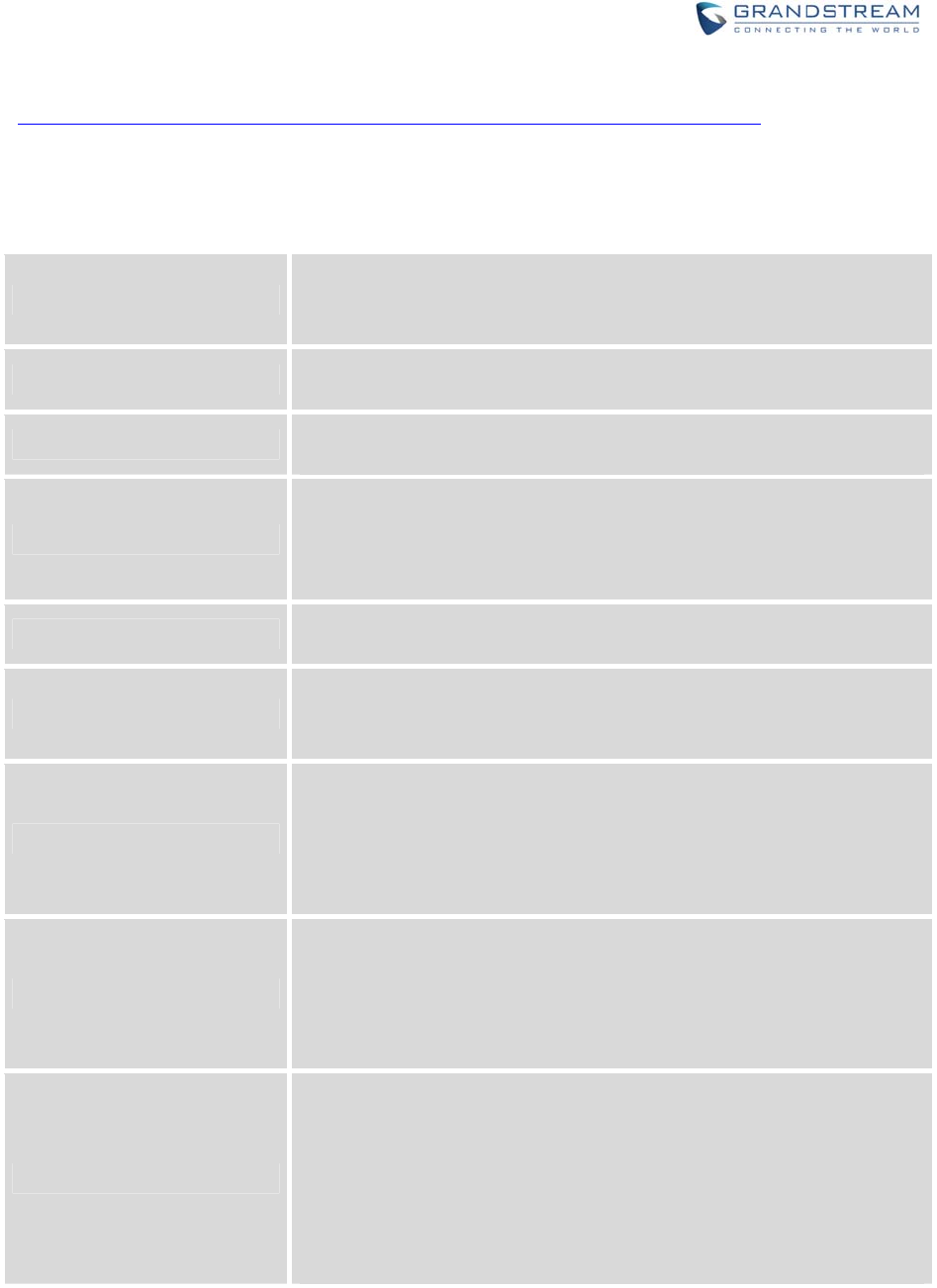
Firmware Version 1.0.0.1 UCM6200 Series IP PBX User Manual Page 153 of 320
For VoIP trunk example, please refer to the document in the following link:
http://www.grandstream.com/sites/default/files/Resources/ucm_to_ucm_peer_guide.pdf
The VoIP trunk options are listed in the table below.
Table 49: Create New SIP Trunk
Type
Select the VoIP trunk type.
Peer SIP Trunk
Register SIP Trunk
Provider Name Configure a unique label to identify this trunk when listed in outbound
rules, inbound rules and etc.
Host Name Configure the IP address or URL for the VoIP provider’s server of the
trunk.
Keep Original CID
Keep the CID from the inbound call when dialing out. This setting will
override “Keep Trunk CID” option. Please make sure that the peer PBX at
the other side supports to match user entry using “username” field from
authentication line.
Keep Trunk CID If enabled, the trunk CID will not be overridden by extension’s CID when
the extension has CID configured. The default setting is “No”.
NAT
Turn on this setting when the PBX is using public IP and communicating
with devices behind NAT. If there is one-way audio issue, usually it is
related to NAT configuration or SIP/RTP port support on the firewall.
Disable This Trunk
If checked, the trunk will be disabled.
Note:
If a current SIP trunk is disabled, UCM will send UNREGISTER message
(REGISTER message with expires=0) to the SIP provider.
TEL URI
If the trunk has an assigned PSTN telephone number, this field should be
set to "User=Phone". Then a "User=Phone" parameter will be attached to
the Request-Line and TO header in the SIP request to indicate the E.164
number. If set to "Enable", "Tel:" will be used instead of "SIP:" in the SIP
request. The default setting is disabled.
Caller ID
Configure the Caller ID. This is the number that the trunk will try to use
when making outbound calls. For some providers, it might not be possible
to set the CallerID with this option and this option will be ignored.
When making outgoing calls, the following rules are used to determine
which CallerID will be used if they exist:
The CallerID configured for the extension will be looked up first.
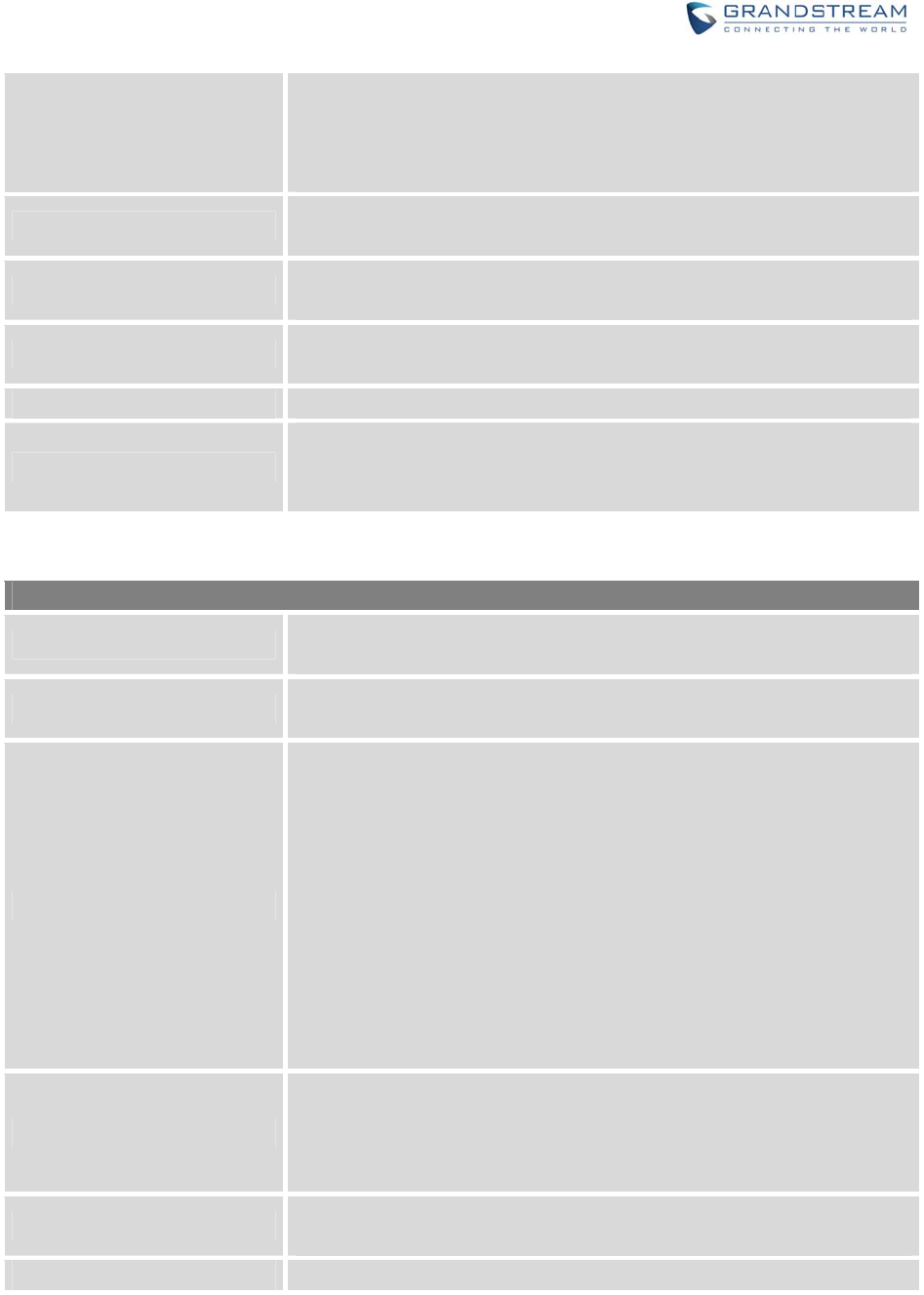
Firmware Version 1.0.0.1 UCM6200 Series IP PBX User Manual Page 154 of 320
If no CallerID is configured for the extension, the CallerID configured
for the trunk will be used.
If the above two are missing, the "Global Outbound CID" defined in
Web GUI->PBX->Internal Options->General will be used.
Need Registration Select whether the trunk needs to register on the external server or not
when "Register SIP Trunk" type is selected. The default setting is No.
Username Enter the username to register to the trunk from the provider when
"Register SIP Trunk" type is selected.
Password Enter the password to register to the trunk from the provider when
"Register SIP Trunk" is selected.
Auth ID Enter the Authentication ID for "Register SIP Trunk" type.
Auto Record
Enable automatic recording for the calls using this trunk (for SIP trunk
only). The default setting is disabled. The recording files can be accessed
under web GUI->CDR->Recording Files.
Table 50: SIP Register Trunk Configuration Parameters
Basic Settings
Provider Name Configure a unique label to identify this trunk when listed in outbound
rules, inbound rules and etc.
Host Name Configure the IP address or URL for the VoIP provider’s server of the
trunk.
Transport
Configure the SIP transport protocol to be used in this trunk. The default
setting is "All - UDP Primary".
UDP Only
TCP Only
TLS Only
All - UDP Primary: UDP is the primary transport protocol when all the
other SIP transport methods are available too.
All - TCP Primary: TCP is the primary transport protocol when all the
other SIP transport methods are available too.
All – TLS Primary: TLS is the primary transport protocol when all the
other SIP transport methods are available too.
Keep Original CID
Keep the CID from the inbound call when dialing out. This setting will
override “Keep Trunk CID” option. Please make sure that the peer PBX at
the other side supports to match user entry using “username” field from
authentication line.
Keep Trunk CID If enabled, the trunk CID will not be overridden by extension’s CID when
the extension has CID configured. The default setting is “No”.
NAT Turn on this option when the PBX is using public IP and communicating
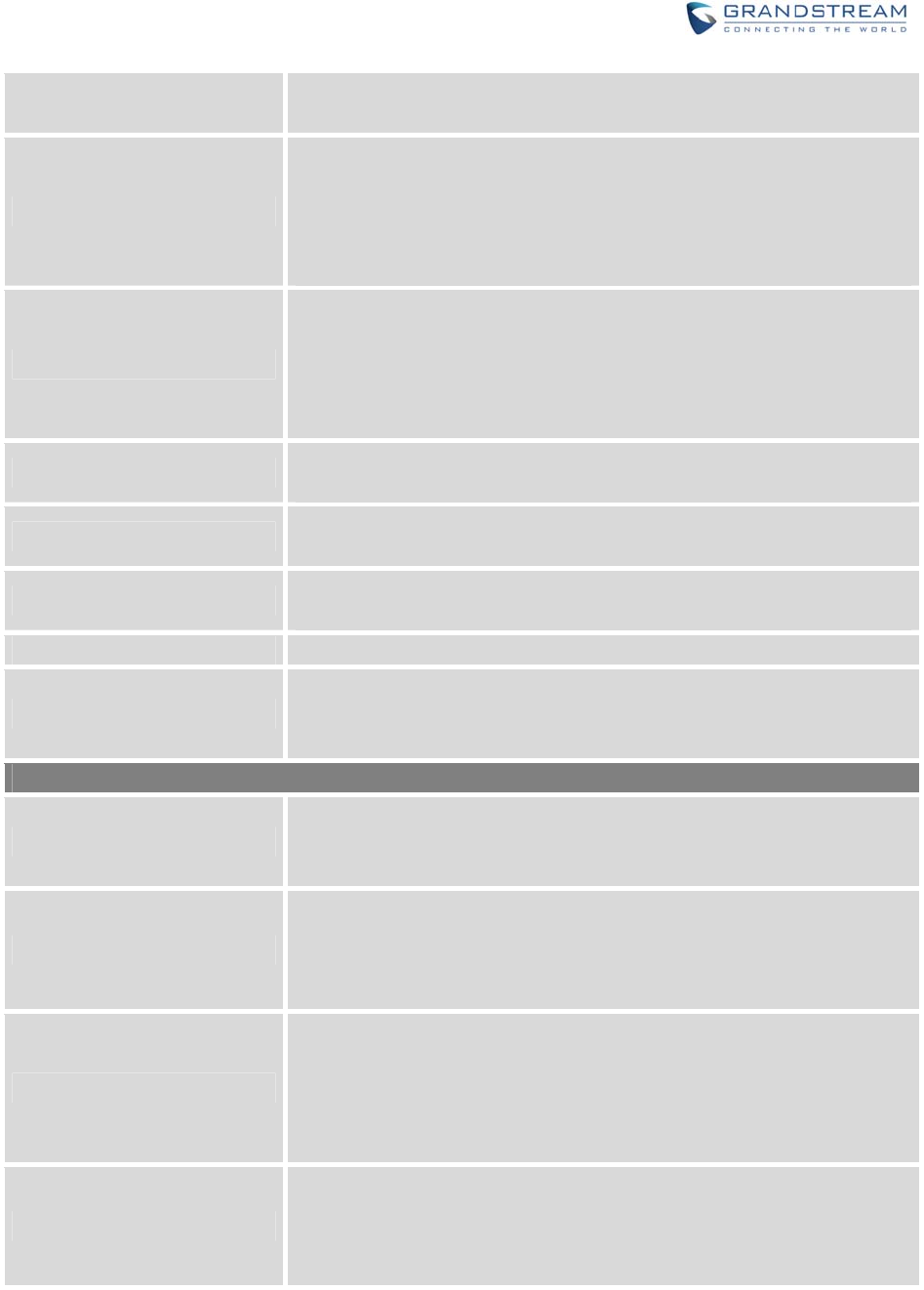
Firmware Version 1.0.0.1 UCM6200 Series IP PBX User Manual Page 155 of 320
with devices behind NAT. If there is one-way audio issue, usually it’s
related to NAT configuration or SIP/RTP port configuration on the firewall.
Disable This Trunk
If selected, the trunk will be disabled.
Note:
If a current SIP trunk is disabled, UCM will send UNREGISTER message
(REGISTER message with expires=0) to the SIP provider.
TEL URI
If the trunk has an assigned PSTN telephone number, this field should be
set to "User=Phone". Then a "User=Phone" parameter will be attached to
the Request-Line and TO header in the SIP request to indicate the E.164
number. If set to "Enable", "Tel:" will be used instead of "SIP:" in the SIP
request. The default setting is disabled.
Need Registration Select whether the trunk needs to register on the external server or not
when "Register SIP Trunk" type is selected. The default setting is No.
Username Enter the username to register to the trunk from the provider when
"Register SIP Trunk" type is selected.
Password Enter the password to register to the trunk from the provider when
"Register SIP Trunk" is selected.
Auth ID Enter the Authentication ID for "Register SIP Trunk" type.
Auto Record
Enable automatic recording for the calls using this trunk (for SIP trunk
only). The default setting is disabled. The recording files can be accessed
under web GUI->CDR->Recording Files.
Advanced Settings
Codec Preference
Select audio and video codec for the VoIP trunk. The available codecs
are: PCMU, PCMA, GSM, AAL2-G.726-32, G.726, G.722, G.729, G.723,
iLBC, ADPCM, H.264, H.263, H.263p and VP8.
From Domain
Configure the actual domain name where the extension comes from. This
can be used to override the From Header.
For example, "trunk.UCM6200.provider.com" is the From Domain in From
Header: sip:1234567@trunk.UCM6200.provider.com.
From User
Configure the actual user name of the extension. This can be used to
override the From Header. There are cases where there is a single ID for
registration (single trunk) with multiple DIDs.
For example, "1234567" is the From User in From Header:
sip:1234567@trunk.UCM6200.provider.com.
Send PPI Header
If enabled, the SIP INVITE message sent to the trunk will contain PPI
(P-Preferred-Identity) header. The default setting is “No”.
Note:
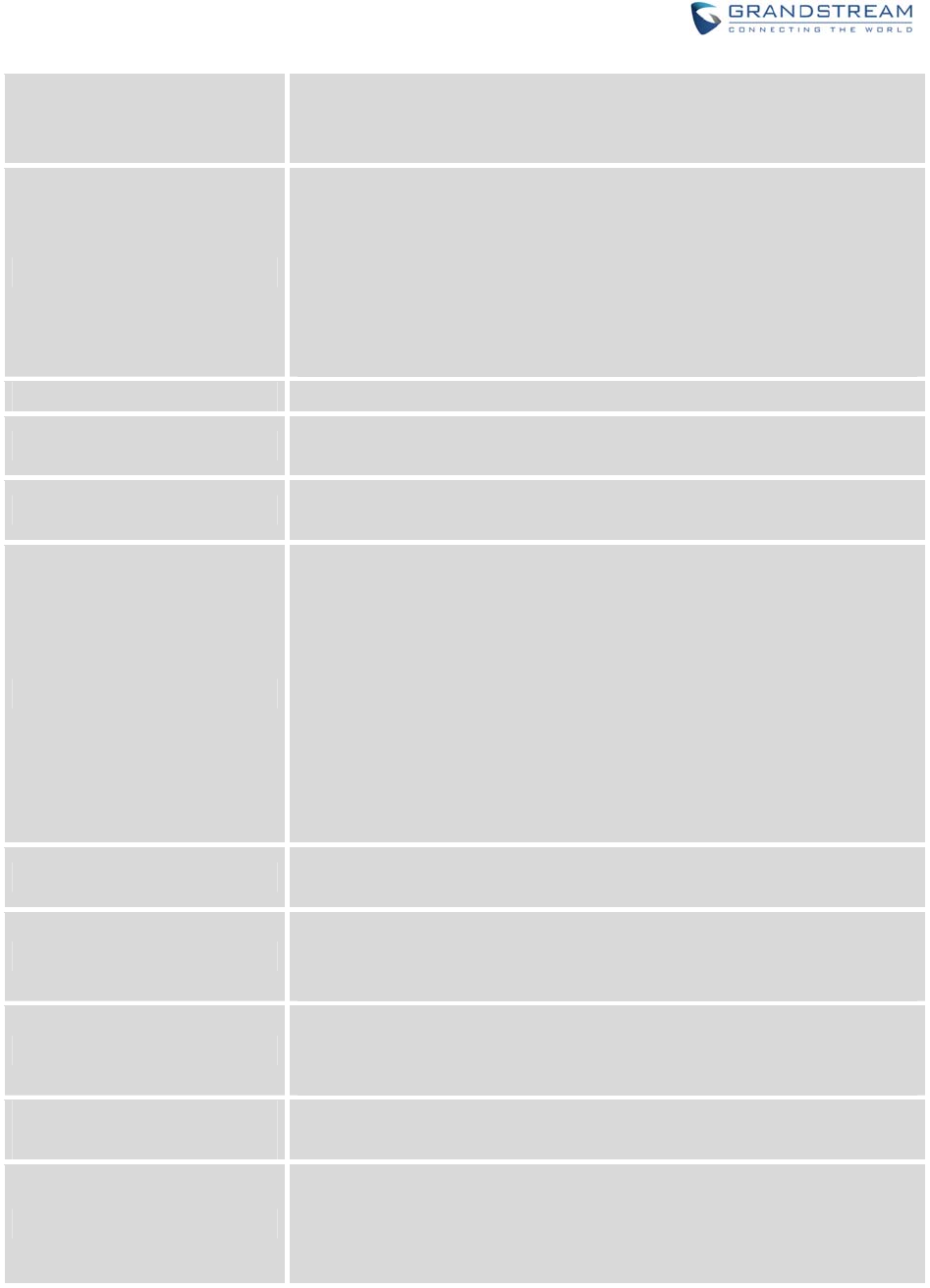
Firmware Version 1.0.0.1 UCM6200 Series IP PBX User Manual Page 156 of 320
“Send PPI Header” and “Send PAI Header” cannot be enabled at the
same time. Only one of the two headers is allowed to be contained in the
SIP INVITE message.
Send PAI Header
If enabled, the SIP INVITE message sent to the trunk will contain PAI
(P-Asserted-Identity) header. The default setting is “No”.
Note:
“Send PPI Header” and “Send PAI Header” cannot be enabled at the
same time. Only one of the two headers is allowed to be contained in the
SIP INVITE message.
Outbound Proxy Support Select to enable outbound proxy in this trunk. The default setting is "No".
Outbound Proxy When outbound proxy support is enabled, enter the IP address or URL of
the outbound proxy.
DID Mode Configure where to get the destination ID of an incoming SIP call, from
SIP Request-line or To-header. The default is set to "Request-line".
DTMF Mode
Configure the default DTMF mode when sending DTMF on this trunk.
Default: The global setting of DTMF mode will be used. The global
setting for DTMF Mode setting is under web UI->PBX->SIP
Settings->ToS.
RFC2833: Send DTMF using RFC2833.
Info: Send DTMF using SIP INFO message.
Inband: Send DTMF using inband audio. This requires 64 bit codec,
i.e., PCMU and PCMA.
Auto: Send DTMF using RFC2833 if offered. Otherwise, inband will
be used.
Enable Qualify If enabled, the UCM6200 will regularly send SIP OPTIONS to the device
to check if the device is still online. The default setting is "No".
Qualify Timeout
When "Enable Qualify" option is set to "Yes", configure the timeout (in ms)
for the Qualify SIP message. If no response is received within the timeout,
the device is considered offline. The default setting is 1000ms.
Qualify Frequency
When "Enable Qualify" option is set to "Yes", configure the interval (in
seconds) of the SIP OPTIONS message sent to the device to check if the
device is still online. The default setting is 60 seconds.
Maximum Number of Call
Lines
The maximum number of concurrent calls using the trunk. The default
settings 0, which means no limit.
Fax Mode
Select Fax mode. The default setting is “None”.
None: Disable Fax.
Fax Detect: Fax signal from the user/trunk during the call can be
detected and the received Fax will be sent to the Email address
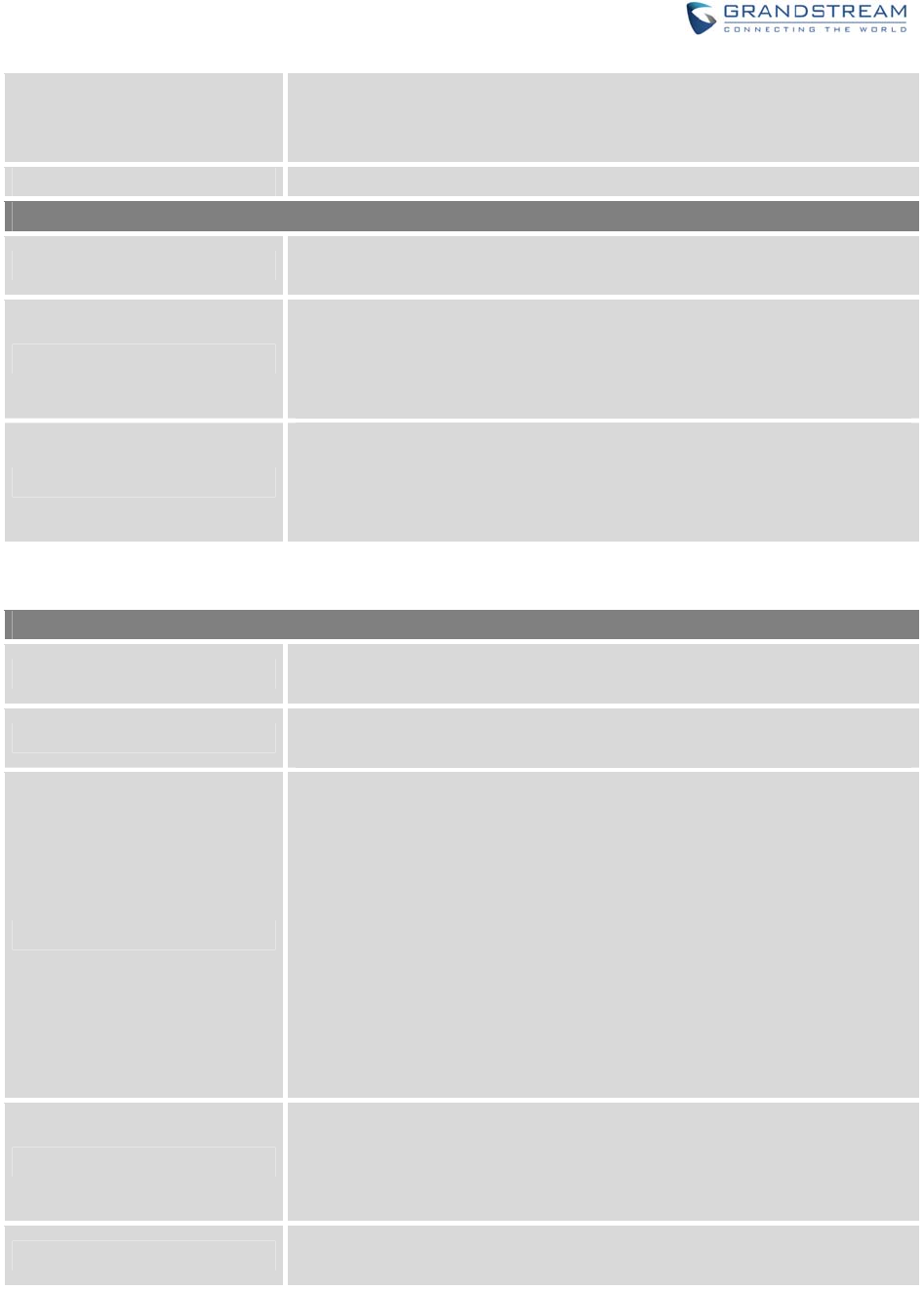
Firmware Version 1.0.0.1 UCM6200 Series IP PBX User Manual Page 157 of 320
configured for this extension. If no Email address can be found for the
user, the Fax will be sent to the default Email address configured in
Fax setting page under web UI->PBX->Internal Options->Fax/T.38.
SRTP Enable SRTP for the VoIP trunk. The default setting is "No".
CC Settings
Enable CC If enabled, the system will automatically alert the user when a called party
is available, given that a previous call to that party failed for some reason.
CC Max Agents
Configure the maximum number of CCSS agents which may be allocated
for this channel. In other words, this number serves as the maximum
number of CC requests this channel is allowed to make. The minimum
value is 1.
CC Max Monitors
Configure the maximum number of monitor structures which may be
created for this device. In other words, this number tells how many callers
may request CC services for a specific device at one time. The minimum
value is 1.
Table 51: SIP Peer Trunk Configuration Parameters
Basic Settings
Provider Name Configure a unique label to identify this trunk when listed in outbound
rules, inbound rules and etc.
Host Name Configure the IP address or URL for the VoIP provider’s server of the
trunk.
Transport
Configure the SIP transport protocol to be used in this trunk. The default
setting is "All - UDP Primary".
UDP Only
TCP Only
TLS Only
All - UDP Primary: UDP is the primary transport protocol when all the
other SIP transport methods are available too.
All - TCP Primary: TCP is the primary transport protocol when all the
other SIP transport methods are available too.
All – TLS Primary: TLS is the primary transport protocol when all the
other SIP transport methods are available too.
Keep Original CID
Keep the CID from the inbound call when dialing out, this setting will
override “Keep Trunk CID” option. Please make sure that the peer PBX at
the other side supports to match user entry using “username” field from
authentication line.
Keep Trunk CID If enabled, the trunk CID will not be overridden by extension’s CID when
the extension has CID configured. The default setting is “No”.
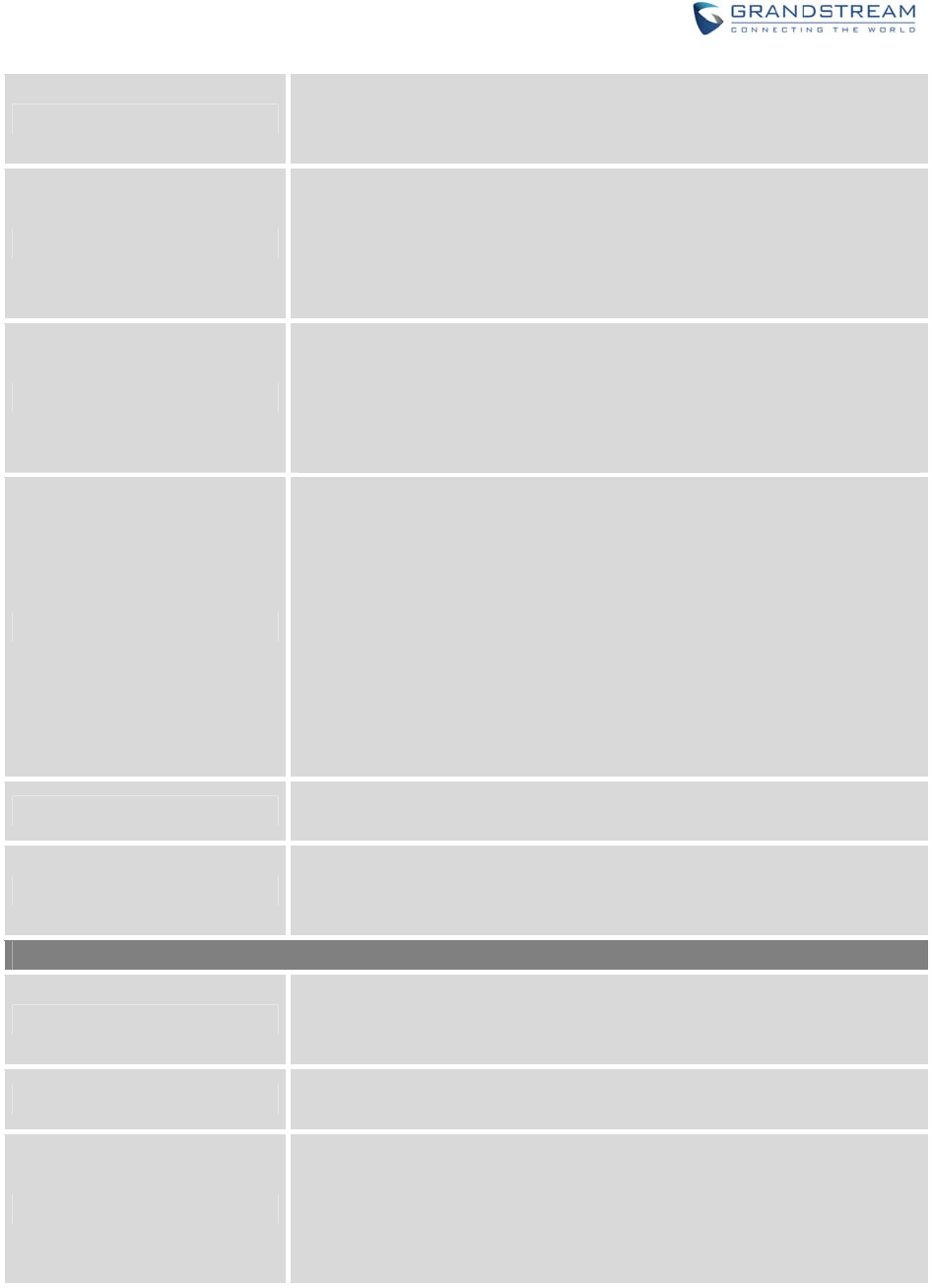
Firmware Version 1.0.0.1 UCM6200 Series IP PBX User Manual Page 158 of 320
NAT
Turn on this option when the PBX is using public IP and communicating
awith devices behind NAT. If there is one-way audio issue, usually it’s
related to NAT configuration or SIP/RTP port configuration on the firewall.
Disable This Trunk
If selected, the trunk will be disabled.
Note:
If a current SIP trunk is disabled, UCM will send UNREGISTER message
(REGISTER message with expires=0) to the SIP provider.
TEL URI
If the trunk has an assigned PSTN telephone number, this field should be
set to "User=Phone". Then a "User=Phone" parameter will be attached to
the Request-Line and TO header in the SIP request to indicate the E.164
number. If set to "Enable", "Tel:" will be used instead of "SIP:" in the SIP
request. The default setting is disabled.
Caller ID
Configure the Caller ID. This is the number that the trunk will try to use
when making outbound calls. For some providers, it might not be possible
to set the CallerID with this option and this option will be ignored.
When making outgoing calls, the following rules are used to determine
which CallerID will be used if they exist:
The CallerID configured for the extension will be looked up first.
If no CallerID configured for the extension, the CallerID configured for
the trunk will be used.
If the above two are missing, the "Global Outbound CID" defined in
Web GUI->PBX->Internal Options->General will be used.
CallerID Name Configure the name of the caller to be displayed when the extension has
no CallerID Name configured.
Auto Record
Enable automatic recording for the calls using this trunk (for SIP trunk
only). The default setting is disabled. The recording files can be accessed
under web GUI->CDR->Recording Files.
Advanced Settings
Codec Preference
Select audio and video codec for the VoIP trunk. The available codecs
are: PCMU, PCMA, GSM, AAL2-G.726-32, G.726, G.722, G.729, G.723,
iLBC, ADPCM, H.264, H.263, H.263p and VP8.
DID Mode Configure where to get the destination ID of an incoming SIP call, from
SIP Request-line or To-header. The default is set to "Request-line".
DTMF Mode
Configure the default DTMF mode when sending DTMF on this trunk.
Default: The global setting of DTMF mode will be used. The global
setting for DTMF Mode setting is under web UI->PBX->SIP
Settings->ToS.
RFC2833: Send DTMF using RFC2833.
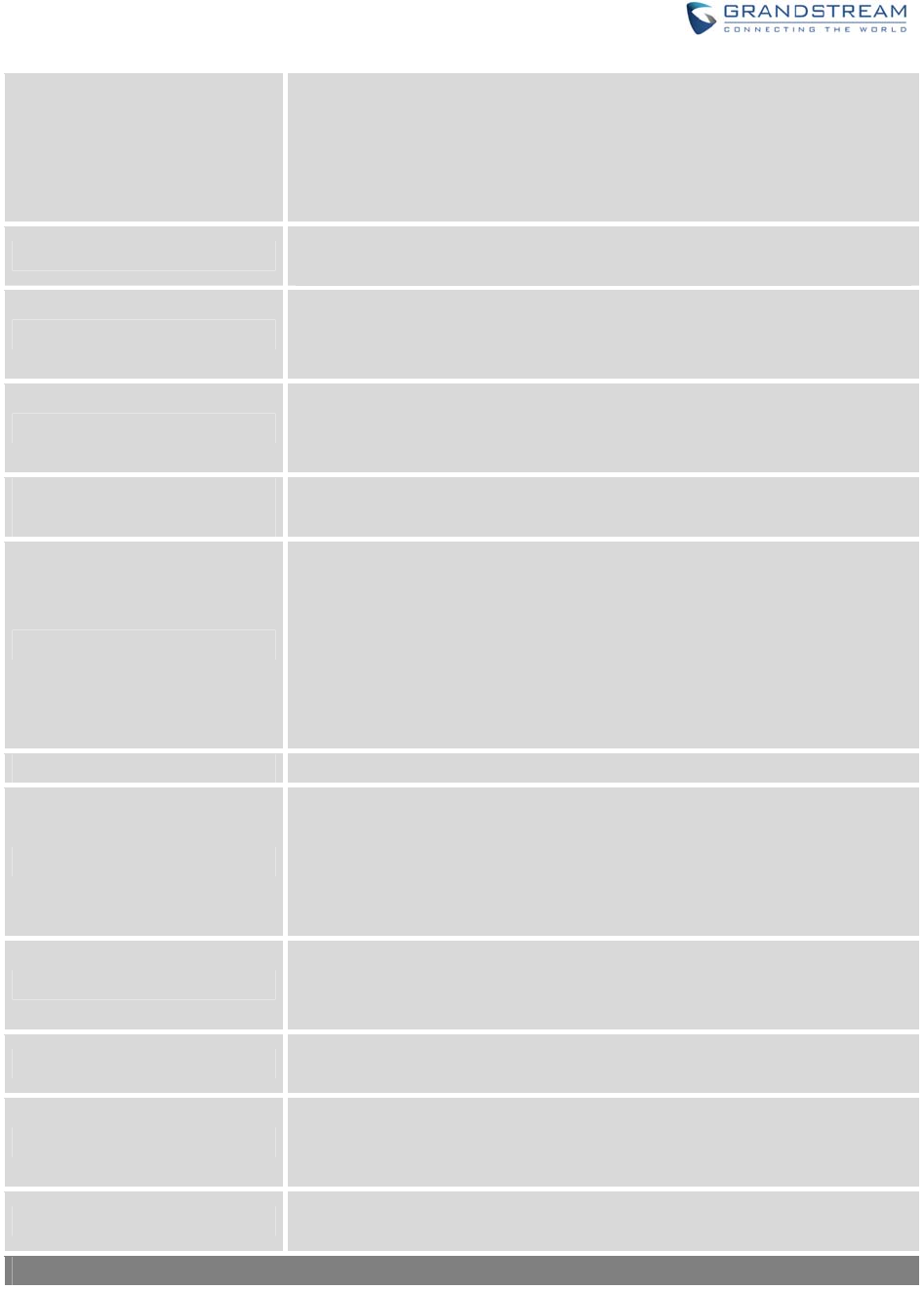
Firmware Version 1.0.0.1 UCM6200 Series IP PBX User Manual Page 159 of 320
Info: Send DTMF using SIP INFO message.
Inband: Send DTMF using inband audio. This requires 64 bit codec,
i.e., PCMU and PCMA.
Auto: Send DTMF using RFC2833 if offered. Otherwise, inband will
be used.
Enable Qualify If enabled, the UCM6200 will regularly send SIP OPTIONS to the device
to check if the device is still online. The default setting is "No".
Qualify Timeout
When "Enable Qualify" option is set to "Yes", configure the timeout (in ms)
for the Qualify SIP message. If no response is received within the timeout,
the device is considered offline. The default setting is 1000ms.
Qualify Frequency
When "Enable Qualify" option is set to "Yes", configure the interval (in
seconds) of the SIP OPTIONS message sent to the device to check if the
device is still online. The default setting is 60 seconds.
Maximum Number of Call
Lines
The maximum number of concurrent calls using the trunk. The default
settings 0, which means no limite.
Fax Mode
Select Fax mode. The default setting is “None”.
None: Disable Fax.
Fax Detect: Fax signal from the user/trunk during the call can be
detected and the received Fax will be sent to the Email address
configured for this extension. If no Email address can be found for the
user, the Fax will be sent to the default Email address configured in
Fax setting page under web UI->PBX->Internal Options->Fax/T.38.
SRTP Enable SRTP for the VoIP trunk. The default setting is "No".
Sync LDAP Enable
If enabled, the local UCM6200 will automatically provide and update the
local LDAP contacts to the remote UCM6200 SIP peer trunk. In order to
ensure successful synchronization, the remote UCM6200 peer also
needs to enable this option on the SIP peer trunk. The default setting is
"No".
Sync LDAP Password
This is the password used for LDAP contact file encryption and decryption
during the LDAP sync process. The password must be the same on both
UCM6200 peers o ensure successful synchronization.
Sync LDAP Port Configure the TCP port used LDAP sync feature between two peer
UCM6200.
LDAP Outbound Rule
Specify an outbound rule for LDAP sync feature. The UCM6200 will
automatically modify the remote contacts by adding prefix parsed from
this rule.
LDAP Dialed Prefix Specify the prefix for LDAP sync feature. The UCM6200 will automatically
modify the remote contacts by adding this prefix.
CC Settings
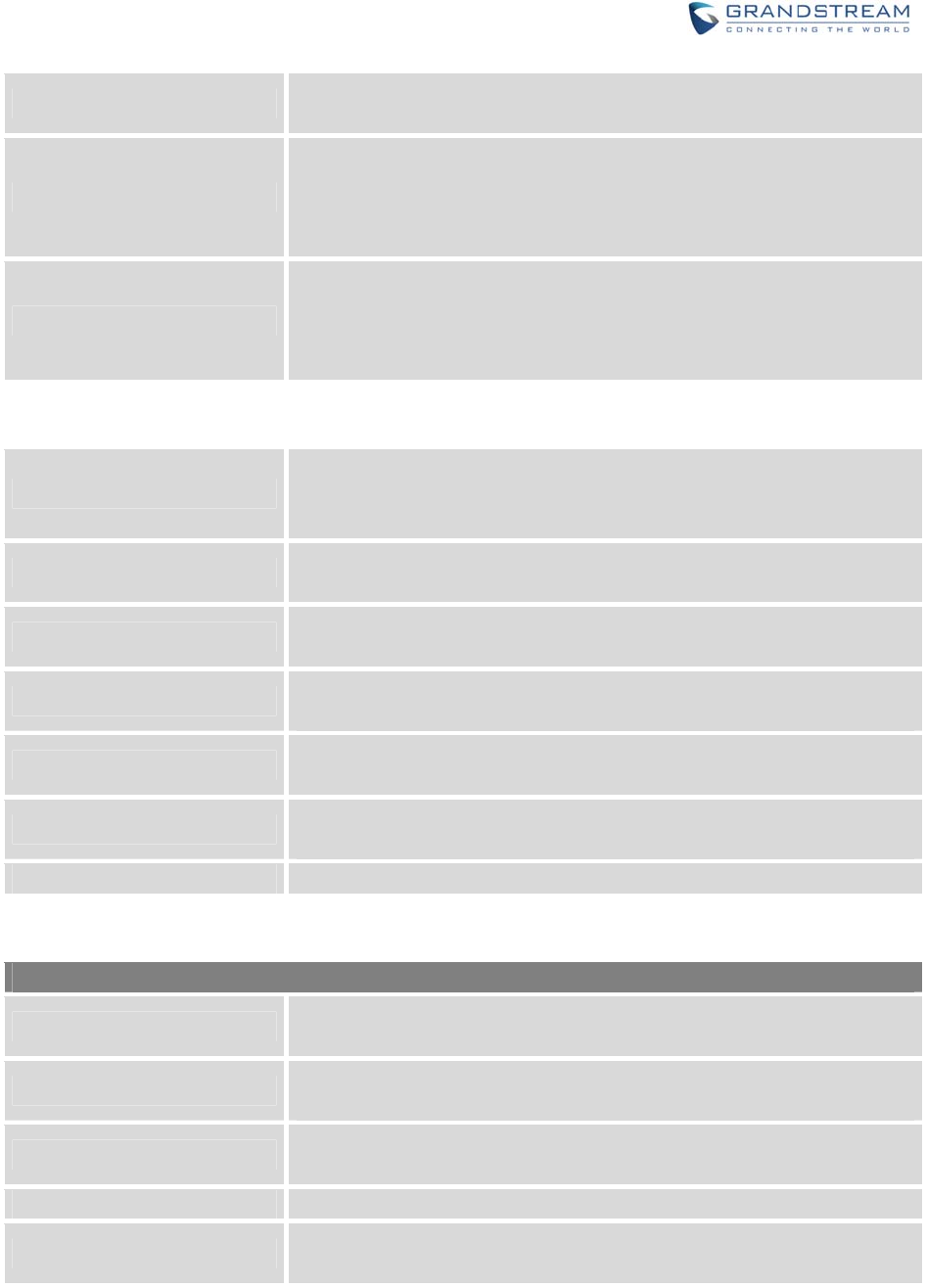
Firmware Version 1.0.0.1 UCM6200 Series IP PBX User Manual Page 160 of 320
Enable CC If enabled, the system will automatically alert the user when a called party
is available, given that a previous call to that party failed for some reason.
CC Max Agents
Configure the maximum number of CCSS agents which may be allocated
for this channel. In other words, this number serves as the maximum
number of CC requests this channel is allowed to make. The minimum
value is 1.
CC Max Monitors
Configure the maximum number of monitor structures which may be
created for this device. In other words, this number tells how many callers
may request CC services for a specific device at one time. The minimum
value is 1.
Table 52: Create New IAX Trunk
Type
Select the VoIP trunk type.
Peer IAX Trunk
Register IAX Trunk
Provider Name Configure a unique label to identify this trunk when listed in outbound
rules, inbound rules and etc.
Host Name Configure the IP address or URL for the VoIP provider’s server of the
trunk.
Keep Trunk CID If enabled, the trunk CID will not be overridden by extension's CID when
the extension has CID configured. The default setting is "No".
Username Enter the username to register to the trunk from the provider when
"Register IAX Trunk" type is selected.
Password Enter the password to register to the trunk from the provider when
"Register IAX Trunk" type is selected.
Disable This Trunk If selected, the trunk will be disabled.
Table 53: IAX Register Trunk Configuration Parameters
Basic Settings
Provider Name Configure a unique label to identify this trunk when listed in outbound
rules, inbound rules and etc.
Host Name Configure the IP address or URL for the VoIP provider’s server of the
trunk.
Keep Trunk CID If enabled, the trunk CID will not be overridden by extension's CID when
the extension has CID configured. The default setting is "No".
Disable This Trunk If selected, the trunk will be disabled.
Caller ID Configure the Caller ID. This is the number that the trunk will try to use
when making outbound calls. For some providers, it might not be possible
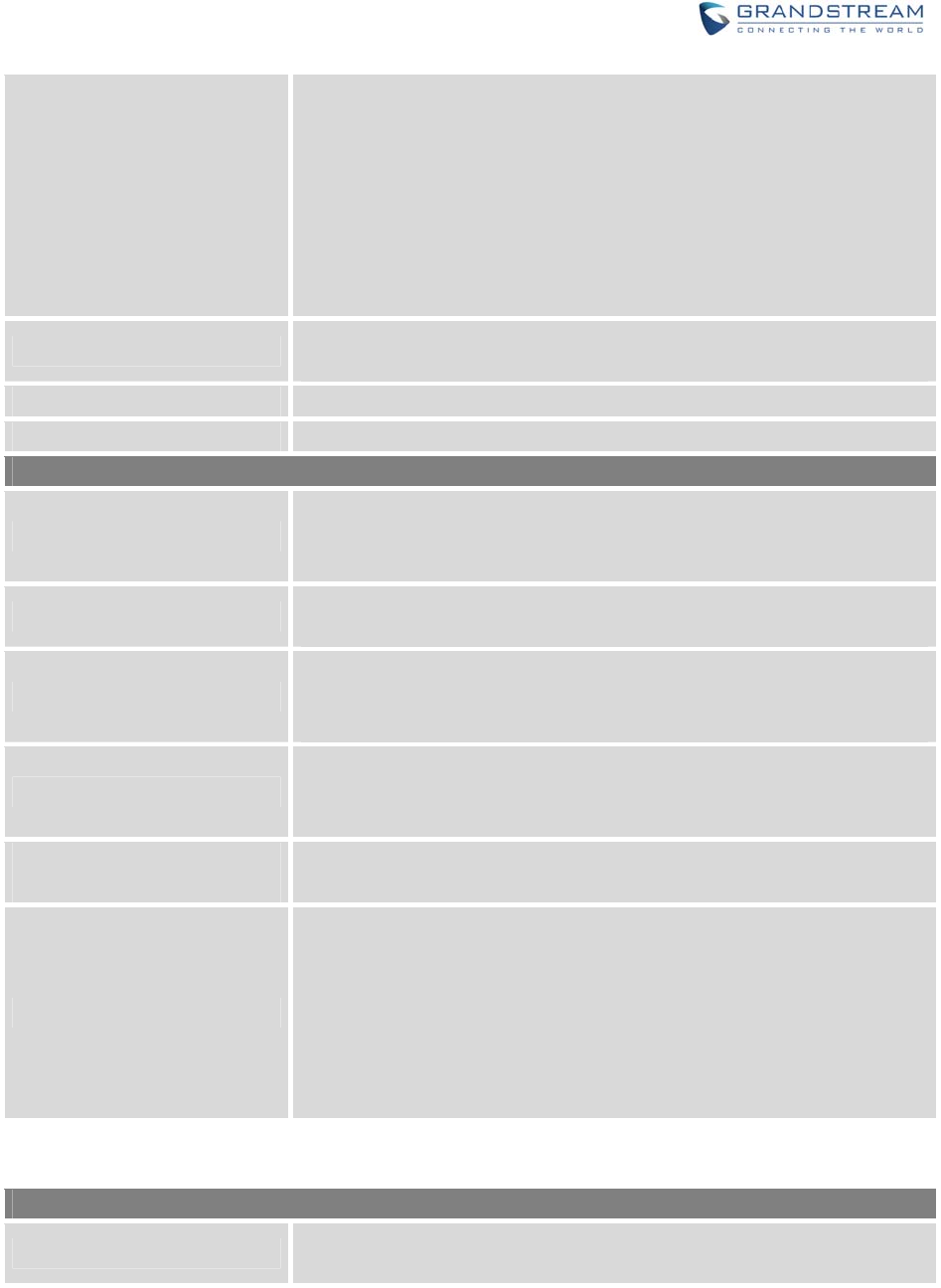
Firmware Version 1.0.0.1 UCM6200 Series IP PBX User Manual Page 161 of 320
to set the CallerID with this option and this option will be ignored.
When making outgoing calls, the following rules are used to determine
which CallerID will be used if they exist:
The CallerID configured for the extension will be looked up first.
If no CallerID configured for the extension, the CallerID configured for
the trunk will be used.
If the above two are missing, the "Global Outbound CID" defined in
Web GUI->PBX->Internal Options->General will be used.
CallerID Name Configure the name of the caller to be displayed when the extension has
no CallerID Name configured.
Username Enter the username to register to the trunk from the provider.
Password Enter the password to register to the trunk from the provider.
Advanced Settings
Codec Preference
Select audio and video codec for the VoIP trunk. The available codecs
are: PCMU, PCMA, GSM, AAL2-G.726-32, G.726, G.722, G.729, G.723,
iLBC, ADPCM, H.264, H.263, H.263p and VP8.
Enable Qualify If enabled, the UCM6200 will regularly send SIP OPTIONS to the device
to check if the device is still online. The default setting is "No".
Qualify Timeout
When "Enable Qualify" option is set to "Yes", configure the timeout (in ms)
for the Qualify SIP message. If no response is received within the timeout,
the device is considered offline. The default setting is 1000ms.
Qualify Frequency
When "Enable Qualify" option is set to "Yes", configure the interval (in
seconds) of the SIP OPTIONS message sent to the device to check if the
device is still online. The default setting is 60 seconds.
Maximum Number of Call
Lines
The maximum number of concurrent calls using the trunk. The default
settings 0, which means no limited.
Fax Mode
Select Fax mode. The default setting is “None”.
None: Disable Fax.
Fax Detect: Fax signal from the user/trunk during the call can be
detected and the received Fax will be sent to the Email address
configured for this extension. If no Email address can be found for the
user, the Fax will be sent to the default Email address configured in
Fax setting page under web UI->PBX->Internal Options->Fax/T.38.
Table 54: IAX Peer Trunk Configuration Parameters
Basic Settings
Provider Name Configure a unique label to identify this trunk when listed in outbound
rules, inbound rules and etc.
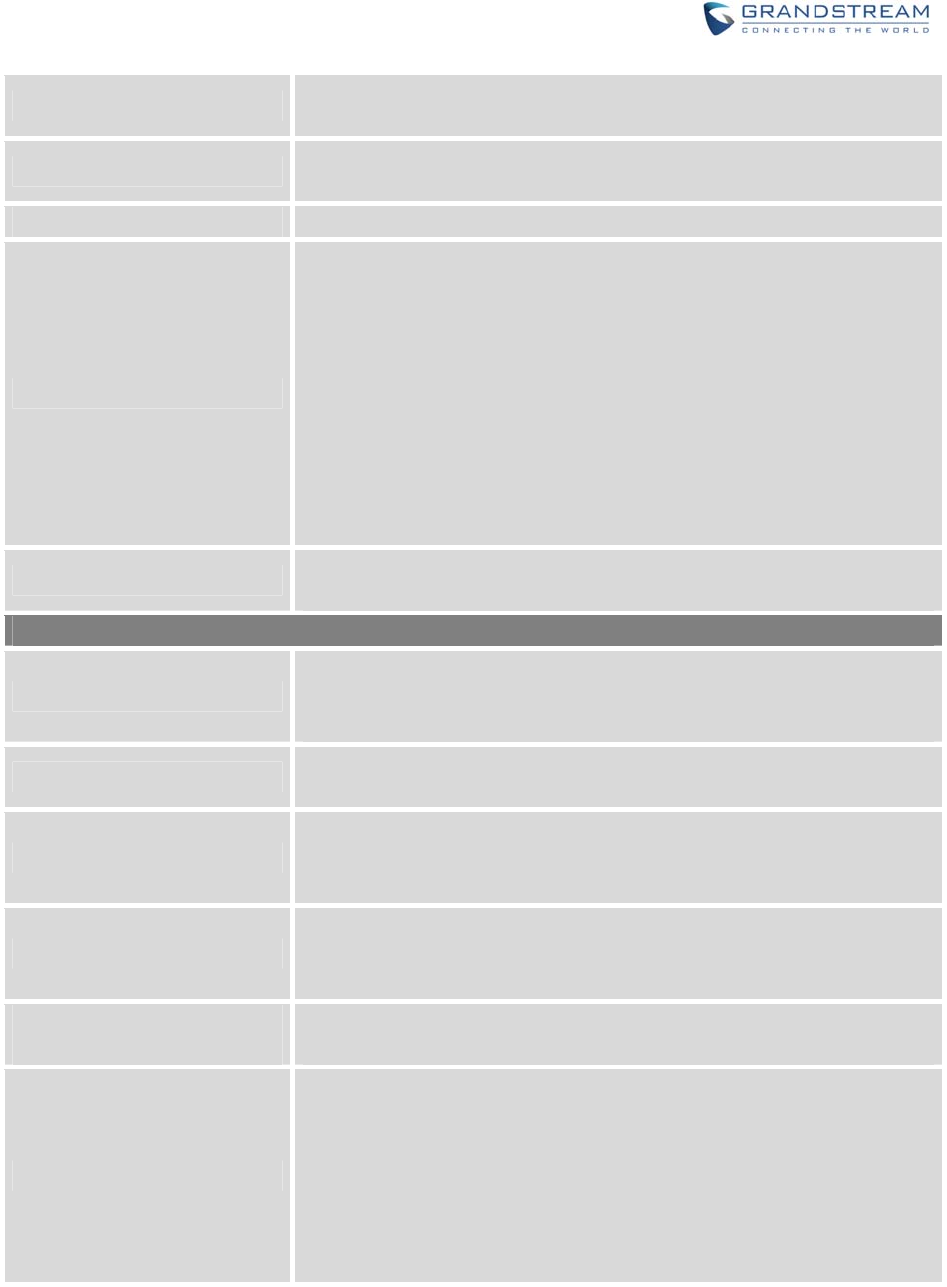
Firmware Version 1.0.0.1 UCM6200 Series IP PBX User Manual Page 162 of 320
Host Name Configure the IP address or URL for the VoIP provider’s server of the
trunk.
Keep Trunk CID If enabled, the trunk CID will not be overridden by extension's CID when
the extension has CID configured. The default setting is "No".
Disable This Trunk If selected, the trunk will be disabled.
Caller ID
Configure the Caller ID. This is the number that the trunk will try to use
when making outbound calls. For some providers, it might not be possible
to set the CallerID with this option and this option will be ignored.
When making outgoing calls, the following rules are used to determine
which CallerID will be used if they exist:
The CallerID configured for the extension will be looked up first.
If no CallerID configured for the extension, the CallerID configured for
the trunk will be used.
If the above two are missing, the "Global Outbound CID" defined in
Web GUI->PBX->Internal Options->General will be used.
CallerID Name Configure the name of the caller to be displayed when the extension has
no CallerID Name configured.
Advanced Settings
Codec Preference
Select audio and video codec for the VoIP trunk. The available codecs
are: PCMU, PCMA, GSM, AAL2-G.726-32, G.726, G.722, G.729, G.723,
iLBC, ADPCM, H.264, H.263, H.263p and VP8.
Enable Qualify If enabled, the UCM6200 will regularly send SIP OPTIONS to the device
to check if the device is still online. The default setting is "No".
Qualify Timeout
When "Enable Qualify" option is set to "Yes", configure the timeout (in ms)
for the Qualify SIP message. If no response is received within the timeout,
the device is considered offline. The default setting is 1000ms.
Qualify Frequency
When "Enable Qualify" option is set to "Yes", configure the interval (in
seconds) of the SIP OPTIONS message sent to the device to check if the
device is still online. The default setting is 60 seconds.
Maximum Number of Call
Lines
The maximum number of concurrent calls using the trunk. The default
settings 0, which means no limited.
Fax Mode
Select Fax mode. The default setting is “None”.
None: Disable Fax.
Fax Detect: Fax signal from the user/trunk during the call can be
detected and the received Fax will be sent to the Email address
configured for this extension. If no Email address can be found for the
user, the Fax will be sent to the default Email address configured in
Fax setting page under web UI->PBX->Internal Options->Fax/T.38.
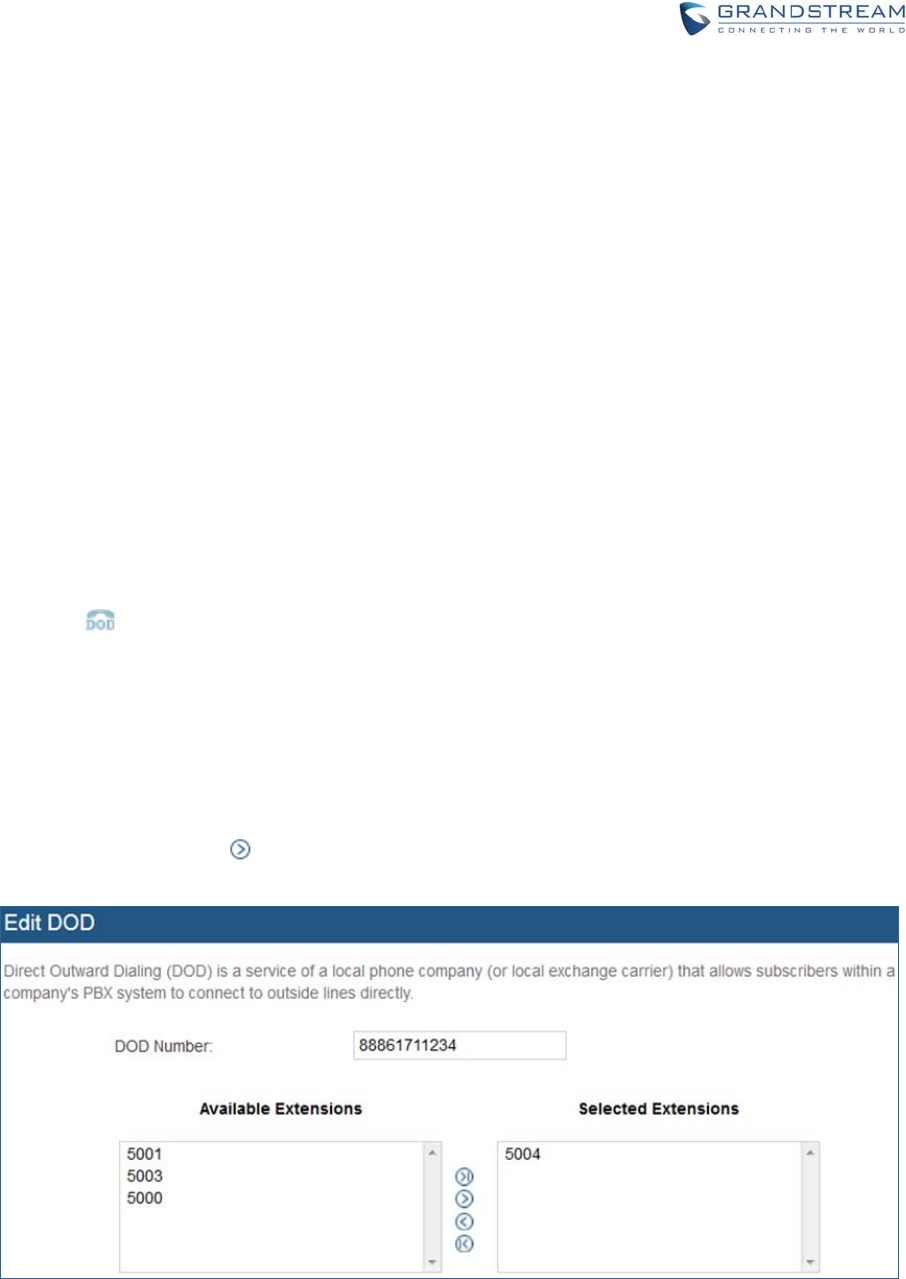
Firmware Version 1.0.0.1 UCM6200 Series IP PBX User Manual Page 163 of 320
DIRECTOUTWARDDIALING(DOD)
The UCM6200 provides Direct Outward Dialing (DOD) which is a service of a local phone company (or
local exchange carrier) that allows subscribers within a company's PBX system to connect to outside lines
directly.
Example of how DOD is used:
Company ABC has a SIP trunk. This SIP trunk has 4 DIDs associated to it. The main number of the office
is routed to an auto attendant. The other three numbers are direct lines to specific users of the company.
At the moment when a user makes an outbound call their caller ID shows up as the main office number.
This poses a problem as the CEO would like their calls to come from their direct line. This can be
accomplished by configuring DOD for the CEO’s extension.
Steps on how to configure DOD on the UCM6200:
1. To setup DOD go to UCM6200 web GUI->PBX->Basic/Call Routes->VoIP Trunks page.
2. Click to access the DOD options for the selected SIP Trunk.
3. Click "Create a new DOD" to begin your DOD setup
4. For "DOD Number" enter one of the numbers (DIDs) from your SIP trunk provider. In the example
above Company ABC received 4 DIDs from their provider. ABC will enter in the number for the CEO's
direct line.
5. Select an extension from the "Available Extensions" list. Users have the option of selecting more than
one extension. In this case, Company ABC would select the CEO's extension. After making the
selection, click on the button to move the extension(s) to the "Selected Extensions" list.
Figure 97: DOD extension selection
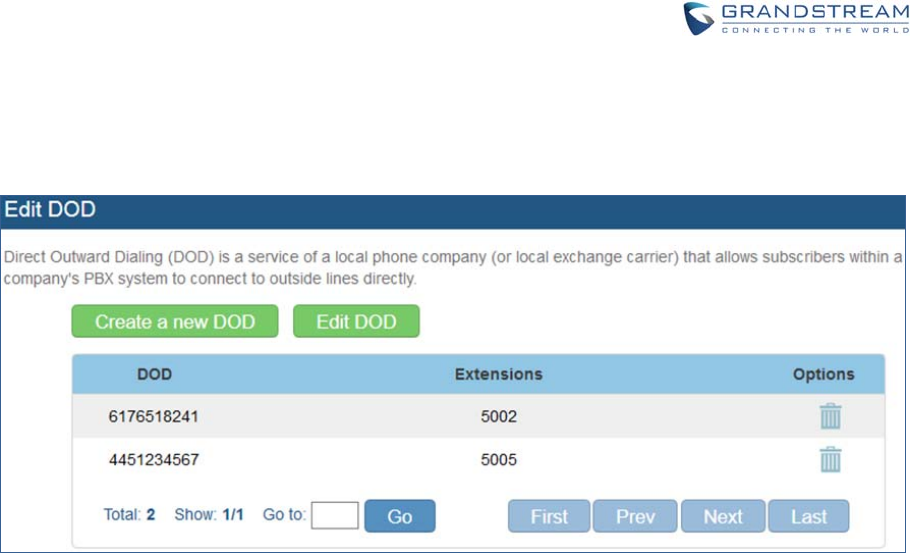
Firmware Version 1.0.0.1 UCM6200 Series IP PBX User Manual Page 164 of 320
6. Click "Save" at the bottom.
Once completed, the user will return to the EDIT DOD page that shows all the extensions that are
associated to a particular DOD.
Figure 98: Edit DOD

Firmware Version 1.0.0.1 UCM6200 Series IP PBX User Manual Page 165 of 320
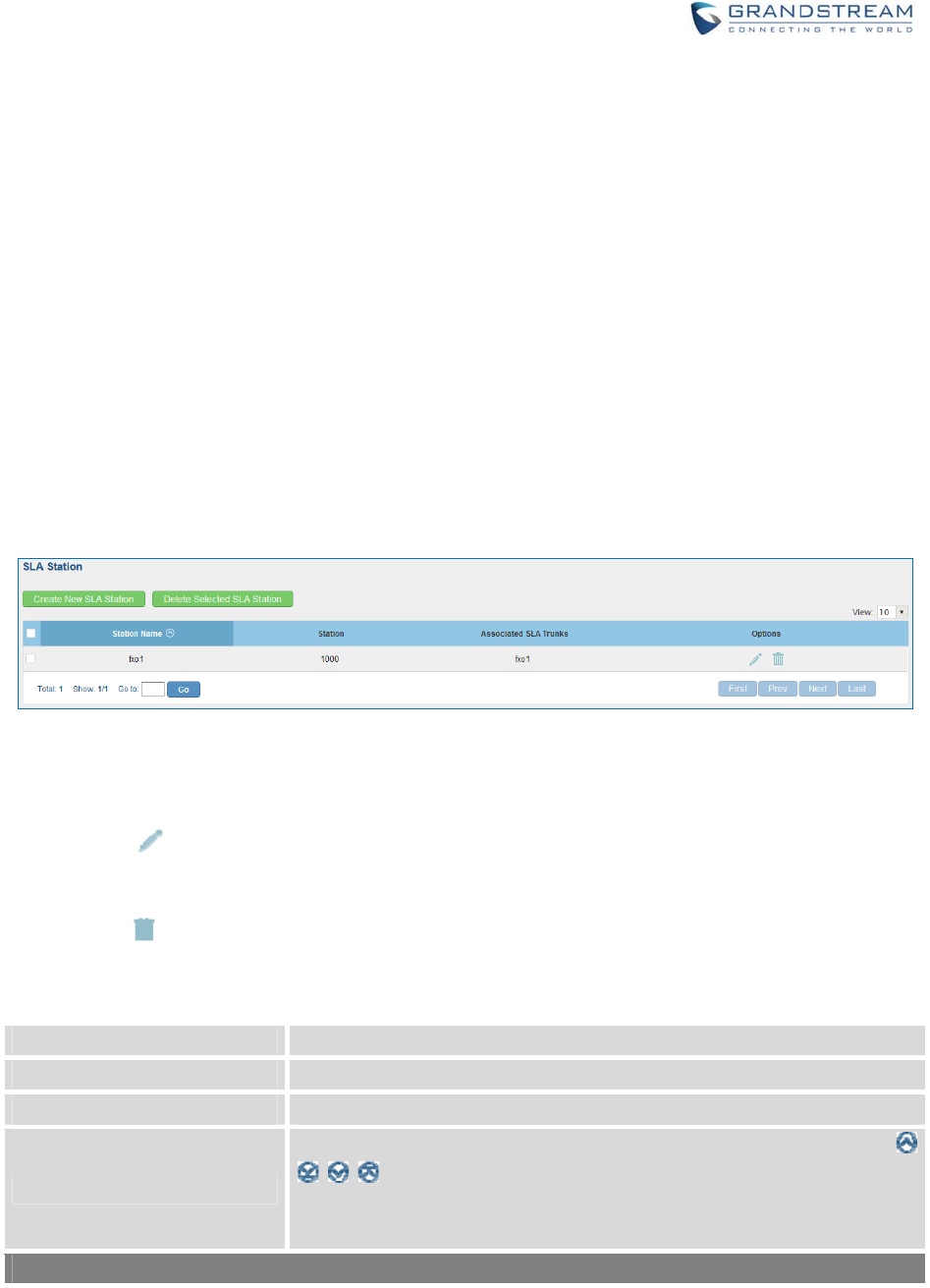
Firmware Version 1.0.0.1 UCM6200 Series IP PBX User Manual Page 166 of 320
SLASTATION
The UCM6200 supports SLA that allows mapping the key with LED on a multi-line phone to different
external lines. When there is an incoming call and the phone starts to ring, the LED on the key will flash in
red and the call can be picked up by pressing this key. This allows users to know if the line is occupied or
not. The SLA function on the UCM6200 is similar to BLF but SLA is used to monitor external line i.e.,
analog trunk on the UCM6200. Users could configure the phone with BLF mode on the MPK to monitor the
analog trunk status or press the line key pick up call from the analog trunk on the UCM6200.
CREATE/EDITSLASTATION
SLA Station can be configured on web GUI->PBX->Basic/Call Routes->SLA Station.
Figure 99: SLA Station
Click on “Create New SLA Station” to add a SLA Station.
Click on to edit the SLA Station. The following table shows the SLA Station configuration
parameters.
Click on to delete the SLA Station.
Table 55: SLA Station Configuration Parameters
Station Name Configure a name to identify the SLA Station.
Station Specify a SIP extension as a station that will be using SLA.
Available SLA Trunks Existing Analog Trunks with SLA Mode enabled will be listed here.
Selected SLA Trunks
Select a trunk for this SLA from the Available SLA Trunks list. Click on
to arrange the order. If there are multiple trunks selected, when
there are calls on those trunks at the same time, pressing the LINE key on
the phone will pick up the call on the first trunk here.
SLA Station Options
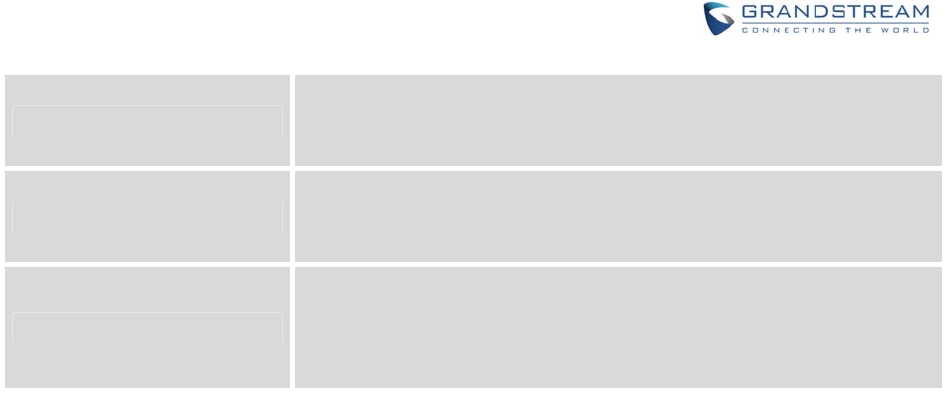
Firmware Version 1.0.0.1 UCM6200 Series IP PBX User Manual Page 167 of 320
Ring Timeout
Configure the time (in seconds) to ring the station before the call is
considered unanswered. No timeout is set by default. If set to 0, there will
be no timeout.
Ring Delay
Configure the time (in seconds) for delay before ringing the station when
a call first coming in on the shared line. No delay is set by default. If set to
0, there will be no delay.
Hold Access
This option defines the competence of the hold action for one particular
trunk. If set to “open”, any station could hold a call on that trunk or resume
one held session; if set to “private”, only the station that places the trunk
call on hold could resume the session. The default setting is “open”.
SAMPLECONFIGURATION
1. On the UCM6200, go to web UI->Basic/Call Routes->Analog Trunks page. Create analog trunk or
edit the existing analog trunk. Make sure “SLA Mode” is enabled for the analog trunk. Once enabled,
this analog trunk will be only available for the SLA stations created under web UI->Basic/Call
Routes->SLA Station page.
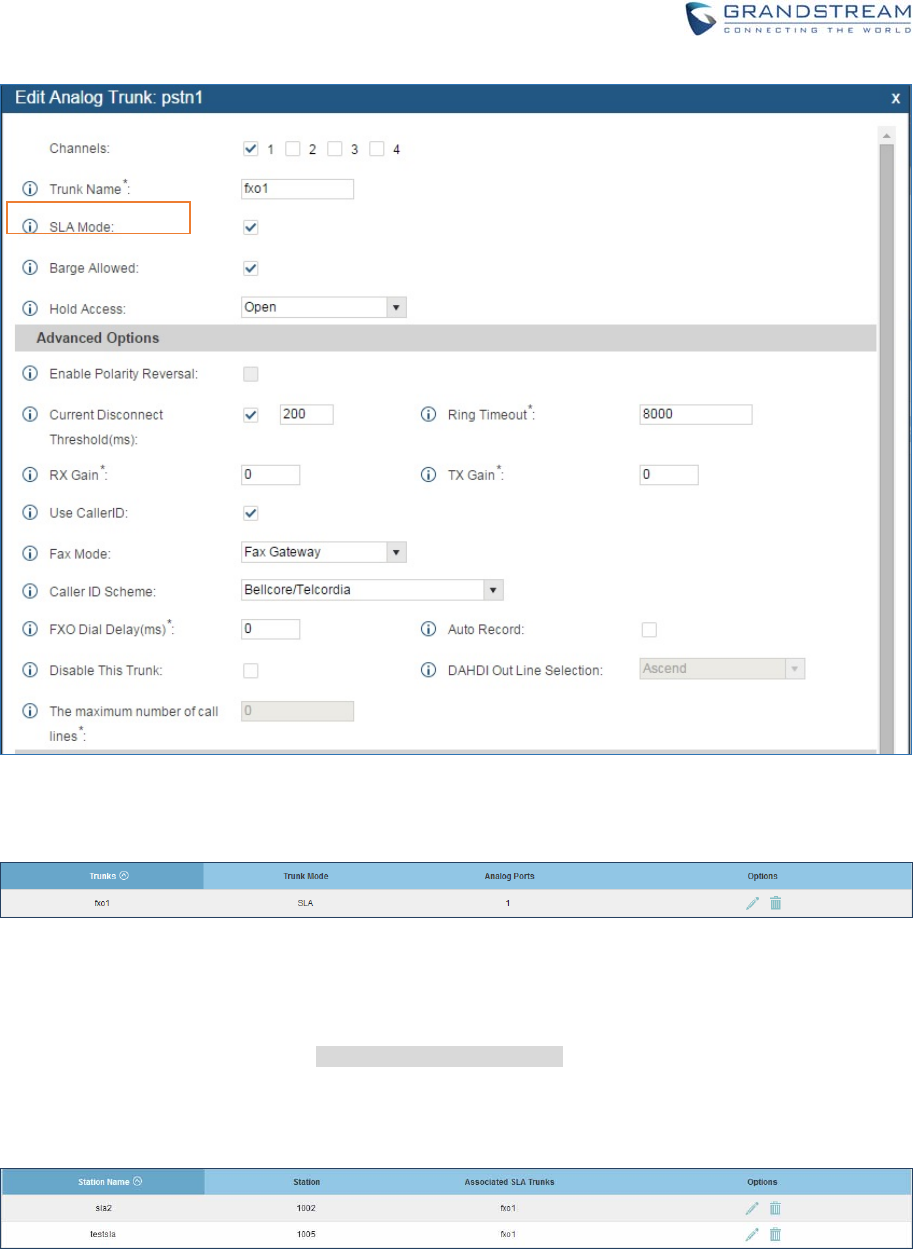
Firmware Version 1.0.0.1 UCM6200 Series IP PBX User Manual Page 168 of 320
Figure 100: Enable SLA Mode for Analog Trunk
Click on “Save”. The analog trunk will be listed with trunk mode “SLA”.
Figure 101: Analog Trunk with SLA Mode Enabled
2. On the UCM6200, go to web UI->Basic/Call Routes->SLA Station page, click on “Create New SLA
Station”. Please refer to section [CREATE/EDIT SLA STATION] for the configuration parameters. Users
can create one or more SLA stations to monitor the analog trunk. The following figure shows two
stations, 1002 and 1005, are configured to be associated with SLA trunk “fxo1”.
Figure 102: SLA Example - SLA Station
3. On the SIP phone 1, configure to register UCM6200 extension 1002. Configure the MPK as BLF mode

Firmware Version 1.0.0.1 UCM6200 Series IP PBX User Manual Page 169 of 320
and the value must be set to “extension_trunkname”, which is 1002_fxo1 in this case.
4. On the SIP phone 2, configure to register UCM6200 extension 1005. Configure the MPK as BLF mode
and value must be set to “extension_trunkname”, which is 1005_fxo1 in this case.
Figure 103: SLA Example - MPK Configuration
Now the SLA station is ready to use. The following functions can be achieved by this configuration.
Making an outbound call from the station/extension, using LINE key
When the extension is in idle state, pressing the line key for this extension on the phone to off hook.
Then dial the station’s extension number, for example, dial 1002 on phone 1 (or dial 1005 on phone 2),
to hear the dial tone. Then the users could dial external number for the outbound call.
Making an outbound call from the station/extension, using BLF key
When the extension is in idle state, pressing the MPK and users could dial external numbers directly.
Answering call using LINE key
When the station is ringing, pressing the LINE key to answer the incoming call.
Barging-in active call using BLF key
When there is an active call between an SLA station and an external number using the SLA trunk,
other SLA stations monitoring the same trunk could join the call by pressing the BLF key if “Barge
Allowed” is enabled for the analog trunk.
Hold/Unhold using BLF key
If the external line is previously put on hold by an SLA station, another station that monitors the same
SLA trunk could unhold the call by pressing the BLF key if “Hold Access” is set to “open” on the analog
trunk and the SLA station.